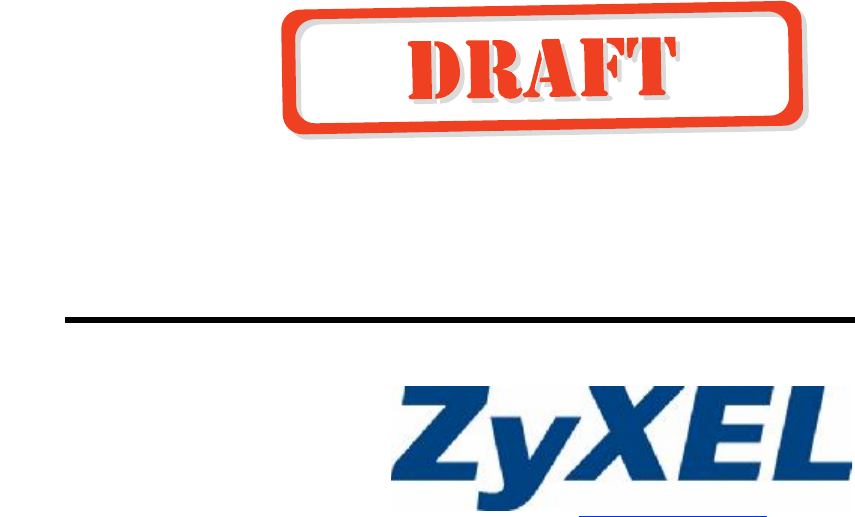ZyXEL Communications NBG410W3G 3G Wireless Router User Manual NBG41xW3G UG V4 03 Ed1 2008 08 15 DRAFT
ZyXEL Communications Corporation 3G Wireless Router NBG41xW3G UG V4 03 Ed1 2008 08 15 DRAFT
Contents
- 1. User manual 1 rev2
- 2. User manual 2 rev2
User manual 1 rev2

About This User's Guide
NBG410W3G Series User s Guide 3
About This User's Guide
Intended Audience
This manual is intended for people who want to configure the ZyXEL Device using the web
configurator. You should have at least a basic knowledge of TCP/IP networking concepts and
topology.
Related Documentation
Quick Start Guide
The Quick Start Guide is designed to help you get up and running right away. It contains
information on setting up your network and configuring for Internet access.
Web Configurator Online Help
Embedded web help for descriptions of individual screens and supplementary
information.
Supporting Disk
Refer to the included CD for support documents.
ZyXEL Web Site
Please refer to www.zyxel.com for additional support documentation and product
certifications.
User Guide Feedback
Help us help you. Send all User Guide-related comments, questions or suggestions for
improvement to the following address, or use e-mail instead. Thank you!
The Technical Writing Team,
ZyXEL Communications Corp.,
6 Innovation Road II,
Science-Based Industrial Park,
Hsinchu, 300, Taiwan.
E-mail: techwriters@zyxel.com.tw

Document Conventions
NBG410W3G Series User s Guide
4
Document Conventions
Warnings and Notes
These are how warnings and notes are shown in this User!s Guide.
Warnings tell you about things that could harm you or your device.
Notes tell you other important information (for example, other things you may
need to configure or helpful tips) or recommendations.
Syntax Conventions
The NBG410W3G and NBG412W3G may be referred to as the "ZyXEL Device#, the
"device#, the "system#, or the "NBG410W3G Series# in this User!s Guide.
Product labels, screen names, field labels and field choices are all in bold font.
A key stroke is denoted by square brackets and uppercase text, for example, [ENTER]
means the "enter# or "return# key on your keyboard.
"Enter# means for you to type one or more characters and then press the [ENTER] key.
"Select# or "choose# means for you to use one of the predefined choices.
A right angle bracket ( > ) within a screen name denotes a mouse click. For example,
Maintenance > Log > Log Setting means you first click Maintenance in the navigation
panel, then the Log sub menu and finally the Log Setting tab to get to that screen.
Units of measurement may denote the "metric# value or the "scientific# value. For
example, "k# for kilo may denote "1000# or "1024#, "M# for mega may denote "1000000#
or "1048576# and so on.
"e.g.,# is a shorthand for "for instance#, and "i.e.,# means "that is# or "in other words#.
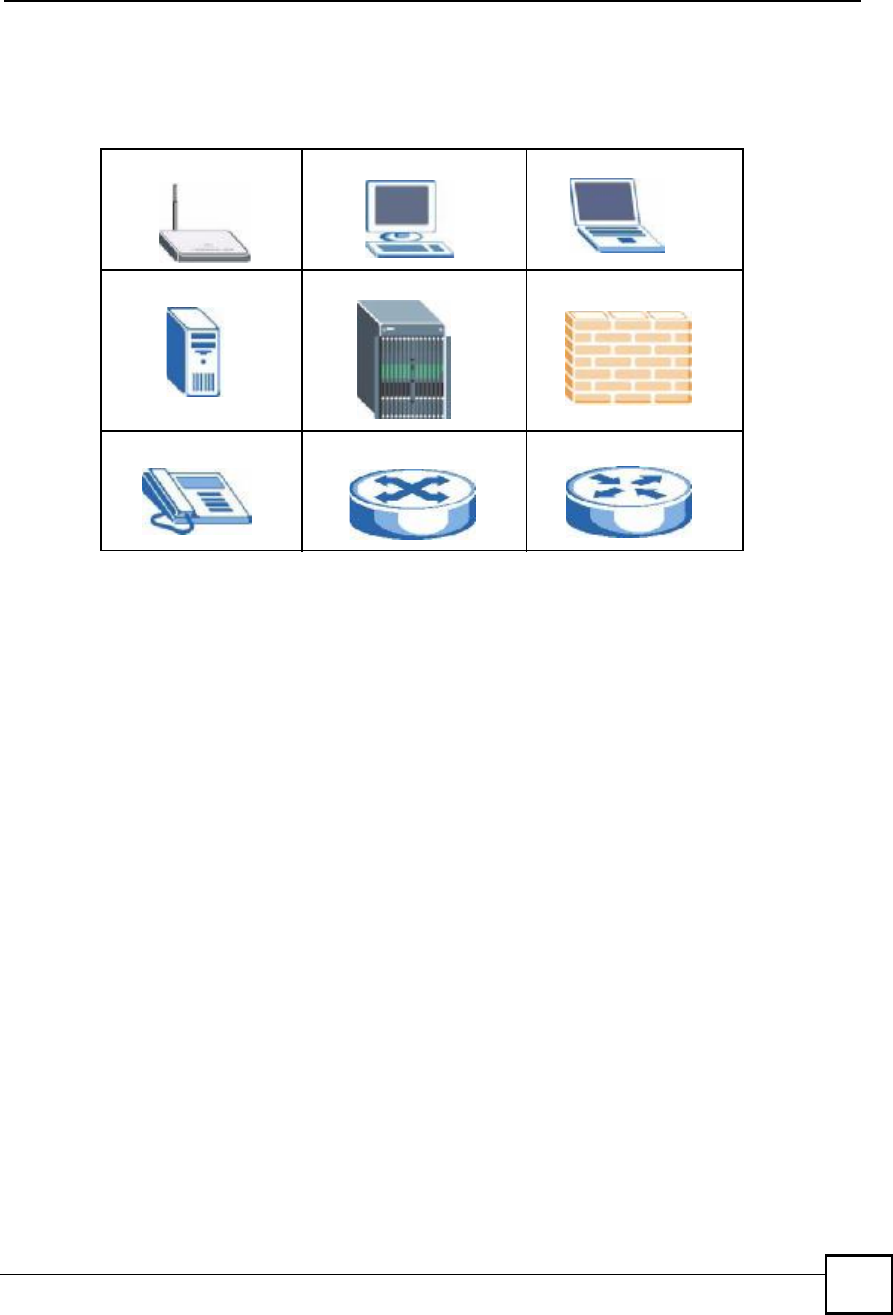
Document Conventions
NBG410W3G Series User s Guide 5
Icons Used in Figures
Figures in this User!s Guide may use the following generic icons. The ZyXEL Device icon is
not an exact representation of your device.
ZyXEL Device Computer Notebook computer
Server DSLAM Firewall
Telephone Switch Router

Safety Warnings
NBG410W3G Series User s Guide
6
Safety Warnings
For your safety, be sure to read and follow all warning notices and instructions.
Do NOT use this product near water, for example, in a wet basement or near a swimming
pool.
Do NOT expose your device to dampness, dust or corrosive liquids.
Do NOT store things on the device.
Do NOT install, use, or service this device during a thunderstorm. There is a remote risk
of electric shock from lightning.
Connect ONLY suitable accessories to the device.
Do NOT open the device or unit. Opening or removing covers can expose you to
dangerous high voltage points or other risks. ONLY qualified service personnel should
service or disassemble this device. Please contact your vendor for further information.
Make sure to connect the cables to the correct ports.
Place connecting cables carefully so that no one will step on them or stumble over them.
Always disconnect all cables from this device before servicing or disassembling.
Use ONLY an appropriate power adaptor or cord for your device.
Connect the power adaptor or cord to the right supply voltage (for example, 110V AC in
North America or 230V AC in Europe).
Do NOT remove the plug and connect it to a power outlet by itself; always attach the plug
to the power adaptor first before connecting it to a power outlet.
Do NOT allow anything to rest on the power adaptor or cord and do NOT place the
product where anyone can walk on the power adaptor or cord.
Do NOT use the device if the power adaptor or cord is damaged as it might cause
electrocution.
If the power adaptor or cord is damaged, remove it from the power outlet.
Do NOT attempt to repair the power adaptor or cord. Contact your local vendor to order a
new one.
Do not use the device outside, and make sure all the connections are indoors. There is a
remote risk of electric shock from lightning.
Do NOT obstruct the device ventilation slots, as insufficient airflow may harm your
device.
Antenna Warning! This device meets ETSI and FCC certification requirements when
using the included antenna(s). Only use the included antenna(s).
If you wall mount your device, make sure that no electrical lines, gas or water pipes will
be damaged.
This product is recyclable. Dispose of it properly.

Safety Warnings
NBG410W3G Series User s Guide 7

Safety Warnings
NBG410W3G Series User s Guide
8

Contents Overview
NBG410W3G Series User s Guide 9
Contents Overview
Introduction ............................................................................................................................33
Getting to Know Your ZyXEL Device .........................................................................................35
Introducing the Web Configurator ..............................................................................................43
Wizard Setup .............................................................................................................................59
Tutorials .....................................................................................................................................65
Network ...................................................................................................................................99
LAN Screens ...........................................................................................................................101
WAN Screens ...........................................................................................................................111
DMZ Screens ...........................................................................................................................135
Wireless ................................................................................................................................145
Wi-Fi ........................................................................................................................................147
Security .................................................................................................................................165
Firewall ....................................................................................................................................167
Authentication Server ..............................................................................................................191
Certificates ...............................................................................................................................195
Advanced ..............................................................................................................................223
Network Address Translation (NAT) ........................................................................................225
Static Route .............................................................................................................................243
DNS .........................................................................................................................................247
Remote Management ..............................................................................................................259
UPnP .......................................................................................................................................281
Custom Application ..................................................................................................................291
ALG Screen .............................................................................................................................293
Logs and Maintenance ........................................................................................................299
Logs Screens ...........................................................................................................................301
Maintenance ............................................................................................................................325
Troubleshooting and Specifications ..................................................................................337
Troubleshooting .......................................................................................................................339
Product Specifications .............................................................................................................345
Appendices and Index .........................................................................................................351

Contents Overview
NBG410W3G Series User s Guide
10

Table of Contents
NBG410W3G Series User s Guide 11
Table of Contents
About This User's Guide..........................................................................................................3
Document Conventions............................................................................................................4
Safety Warnings........................................................................................................................6
Contents Overview...................................................................................................................9
Table of Contents....................................................................................................................11
List of Figures.........................................................................................................................21
List of Tables...........................................................................................................................29
Part I: Introduction.................................................................................33
Chapter 1
Getting to Know Your ZyXEL Device....................................................................................35
1.1 Overview ..............................................................................................................................35
1.2 Applications for the ZyXEL Device ......................................................................................35
1.2.1 3G WAN Application ...................................................................................................35
1.2.2 Secure Broadband Internet Access via Cable or DSL Modem ..................................36
1.3 Ways to Manage the ZyXEL Device ....................................................................................36
1.4 Configuring Your ZyXEL Device s Security Features ..........................................................37
1.4.1 Control Access to Your Device ...................................................................................37
1.4.2 Wireless Security .......................................................................................................37
1.4.3 Firewall ......................................................................................................................37
1.4.4 NAT ............................................................................................................................38
1.4.5 UPnP ..........................................................................................................................38
1.5 Maintaining Your ZyXEL Device ..........................................................................................38
1.5.1 Front Panel Lights ......................................................................................................39
Chapter 2
Introducing the Web Configurator........................................................................................43
2.1 Web Configurator Overview .................................................................................................43
2.2 Accessing the ZyXEL Device Web Configurator .................................................................43
2.3 Resetting the ZyXEL Device ................................................................................................45
2.3.1 Procedure To Use The Reset Button .........................................................................45
2.3.2 Uploading a Configuration File Via Console Port .......................................................45

Table of Contents
NBG410W3G Series User s Guide
12
2.4 Navigating the ZyXEL Device Web Configurator .................................................................46
2.4.1 Title Bar ......................................................................................................................46
2.4.2 Main Window ..............................................................................................................47
2.4.3 HOME Screen ...........................................................................................................47
2.4.4 Navigation Panel ........................................................................................................52
2.4.5 Port Statistics ...........................................................................................................54
2.4.6 Show Statistics: Line Chart ........................................................................................55
2.4.7 DHCP Table Screen ................................................................................................56
Chapter 3
Wizard Setup...........................................................................................................................59
3.1 Wizard Setup Overview ......................................................................................................59
3.2 Internet Access ...................................................................................................................59
3.2.1 ISP Parameters ..........................................................................................................59
3.2.2 Internet Access Wizard Setup Complete ...................................................................64
Chapter 4
Tutorials...................................................................................................................................65
4.1 DMZ Overview .....................................................................................................................65
4.2 DMZ Setup Example ...........................................................................................................66
4.2.1 Basic Setup ................................................................................................................66
4.2.2 Advanced Setup .........................................................................................................68
4.3 Firewall Rule Setup .............................................................................................................69
4.4 Setting Up a VoIP Phone with H.323 ...................................................................................72
4.5 Using NAT with Multiple Public IP Addresses ......................................................................77
4.5.1 Example Parameters and Scenario ...........................................................................77
4.5.2 Configuring the WAN Connection with a Static IP Address ........................................78
4.5.3 Public IP Address Mapping ........................................................................................82
4.5.4 Forwarding Traffic from the WAN to a Local Computer ..............................................87
4.5.5 Allow WAN-to-LAN Traffic through the Firewall ..........................................................89
4.5.6 Testing the Connections .............................................................................................96
4.6 Using NAT with Multiple Game Players ...............................................................................96
Part II: Network.......................................................................................99
Chapter 5
LAN Screens..........................................................................................................................101
5.1 LAN, WAN and the ZyXEL Device .....................................................................................101
5.2 IP Address and Subnet Mask ............................................................................................101
5.2.1 Private IP Addresses ................................................................................................102
5.3 DHCP ................................................................................................................................102

Table of Contents
NBG410W3G Series User s Guide 13
5.3.1 IP Pool Setup ...........................................................................................................103
5.4 RIP Setup ..........................................................................................................................103
5.5 Multicast ............................................................................................................................103
5.6 WINS .................................................................................................................................104
5.7 LAN ....................................................................................................................................104
5.8 LAN Static DHCP ...............................................................................................................106
5.9 LAN IP Alias ....................................................................................................................107
5.10 LAN Port Roles ................................................................................................................109
Chapter 6
WAN Screens.........................................................................................................................111
6.1 WAN Overview ...................................................................................................................111
6.2 Multiple WAN ......................................................................................................................111
6.3 TCP/IP Priority (Metric) .......................................................................................................112
6.4 WAN General ......................................................................................................................112
6.5 WAN IP Address Assignment .............................................................................................115
6.6 DNS Server Address Assignment ......................................................................................116
6.7 WAN MAC Address ............................................................................................................116
6.8 WAN 1 ...............................................................................................................................117
6.8.1 WAN Ethernet Encapsulation ....................................................................................117
6.8.2 PPPoE Encapsulation ..............................................................................................120
6.8.3 PPTP Encapsulation ................................................................................................123
6.9 3G (WAN 2) ......................................................................................................................126
6.10 Traffic Redirect ...............................................................................................................132
6.11 Configuring Traffic Redirect .............................................................................................133
Chapter 7
DMZ Screens.........................................................................................................................135
7.1 DMZ ..................................................................................................................................135
7.2 Configuring DMZ ...............................................................................................................135
7.3 DMZ Static DHCP ............................................................................................................138
7.4 DMZ IP Alias ....................................................................................................................139
7.5 DMZ Public IP Address Example ......................................................................................141
7.6 DMZ Private and Public IP Address Example ...................................................................141
7.7 DMZ Port Roles ...............................................................................................................142
Part III: Wireless...................................................................................145
Chapter 8
Wi-Fi.......................................................................................................................................147
8.1 Wi-Fi Introduction ..............................................................................................................147

Table of Contents
NBG410W3G Series User s Guide
14
8.2 Wireless Security Overview ...............................................................................................148
8.2.1 SSID .........................................................................................................................148
8.2.2 MAC Address Filter ..................................................................................................148
8.2.3 User Authentication ..................................................................................................149
8.2.4 Encryption ................................................................................................................149
8.2.5 Additional Installation Requirements for Using 802.1x .............................................151
8.3 Wireless Card ...................................................................................................................151
8.3.1 SSID Profile .............................................................................................................153
8.4 Configuring Wireless Security ...........................................................................................154
8.4.1 No Security ...............................................................................................................156
8.4.2 Static WEP ...............................................................................................................156
8.4.3 IEEE 802.1x Only .....................................................................................................157
8.4.4 IEEE 802.1x + Static WEP .......................................................................................158
8.4.5 WPA, WPA2, WPA2-MIX ..........................................................................................160
8.4.6 WPA-PSK, WPA2-PSK, WPA2-PSK-MIX .................................................................161
8.5 MAC Filter .........................................................................................................................162
Part IV: Security...................................................................................165
Chapter 9
Firewall...................................................................................................................................167
9.1 Firewall Overview .............................................................................................................167
9.2 Packet Direction Matrix ......................................................................................................168
9.3 Packet Direction Examples ................................................................................................169
9.4 Security Considerations .....................................................................................................170
9.5 Firewall Rules Example .....................................................................................................171
9.6 Asymmetrical Routes .........................................................................................................173
9.6.1 Asymmetrical Routes and IP Alias ...........................................................................173
9.7 Firewall Default Rule .........................................................................................................173
9.8 Firewall Rule Summary ....................................................................................................175
9.8.1 Firewall Edit Rule .................................................................................................177
9.9 Anti-Probing ....................................................................................................................180
9.10 Firewall Thresholds ......................................................................................................181
9.10.1 Threshold Values ...................................................................................................182
9.11 Threshold Screen .............................................................................................................182
9.12 Service ............................................................................................................................184
9.12.1 Firewall Edit Custom Service ................................................................................185
9.13 My Service Firewall Rule Example ..................................................................................186
Chapter 10
Authentication Server...........................................................................................................191

Table of Contents
NBG410W3G Series User s Guide 15
10.1 Authentication Server Overview ......................................................................................191
10.2 Local User Database .....................................................................................................191
10.3 RADIUS .........................................................................................................................193
Chapter 11
Certificates............................................................................................................................195
11.1 Certificates Overview .......................................................................................................195
11.1.1 Advantages of Certificates .....................................................................................196
11.2 Self-signed Certificates ....................................................................................................196
11.3 Verifying a Certificate .......................................................................................................196
11.3.1 Checking the Fingerprint of a Certificate on Your Computer ..................................196
11.4 Configuration Summary ...................................................................................................197
11.5 My Certificates ................................................................................................................198
11.6 My Certificate Details .....................................................................................................200
11.7 My Certificate Export .......................................................................................................202
11.7.1 Certificate File Export Formats ...............................................................................202
11.8 My Certificate Import ......................................................................................................203
11.8.1 Certificate File Formats ..........................................................................................203
11.9 My Certificate Create .....................................................................................................205
11.10 Trusted CAs .................................................................................................................209
11.11 Trusted CA Details .........................................................................................................211
11.12 Trusted CA Import ........................................................................................................214
11.13 Trusted Remote Hosts .................................................................................................215
11.14 Trusted Remote Hosts Import ......................................................................................217
11.15 Trusted Remote Host Certificate Details ......................................................................218
11.16 Directory Servers ..........................................................................................................220
11.17 Directory Server Add or Edit ........................................................................................221
Part V: Advanced.................................................................................223
Chapter 12
Network Address Translation (NAT)....................................................................................225
12.1 NAT Overview ................................................................................................................225
12.1.1 NAT Definitions ......................................................................................................225
12.1.2 What NAT Does .....................................................................................................226
12.1.3 How NAT Works .....................................................................................................226
12.1.4 NAT Application ......................................................................................................227
12.1.5 Port Restricted Cone NAT ......................................................................................228
12.1.6 NAT Mapping Types ...............................................................................................229
12.2 Using NAT ........................................................................................................................230
12.2.1 SUA (Single User Account) Versus NAT ................................................................230

Table of Contents
NBG410W3G Series User s Guide
16
12.3 NAT Overview Screen .....................................................................................................230
12.4 NAT Address Mapping ...................................................................................................232
12.4.1 What NAT Does .....................................................................................................232
12.4.2 NAT Address Mapping Edit ...................................................................................234
12.5 Port Forwarding ..............................................................................................................235
12.5.1 Default Server IP Address ......................................................................................235
12.5.2 Port Forwarding: Services and Port Numbers ........................................................236
12.5.3 Configuring Servers Behind Port Forwarding (Example) .......................................236
12.5.4 NAT and Multiple WAN ...........................................................................................237
12.5.5 Port Translation ......................................................................................................237
12.6 Port Forwarding Screen ...................................................................................................238
12.7 Port Triggering ...............................................................................................................240
Chapter 13
Static Route...........................................................................................................................243
13.1 IP Static Route ..............................................................................................................243
13.2 IP Static Route .................................................................................................................244
13.2.1 IP Static Route Edit ..............................................................................................245
Chapter 14
DNS........................................................................................................................................247
14.1 DNS Overview ................................................................................................................247
14.2 DNS Server Address Assignment ...................................................................................247
14.3 DNS Servers ....................................................................................................................247
14.4 Address Record ...............................................................................................................248
14.4.1 DNS Wildcard .........................................................................................................248
14.5 Name Server Record .......................................................................................................248
14.5.1 Private DNS Server ................................................................................................248
14.6 System Screen ................................................................................................................248
14.6.1 Adding an Address Record ..................................................................................250
14.6.2 Inserting a Name Server Record ..........................................................................251
14.7 DNS Cache ....................................................................................................................252
14.8 Configure DNS Cache .....................................................................................................252
14.9 Configuring DNS DHCP .................................................................................................254
14.10 Dynamic DNS ..............................................................................................................255
14.10.1 DYNDNS Wildcard ...............................................................................................255
14.10.2 High Availability ....................................................................................................256
14.11 Configuring Dynamic DNS .............................................................................................256
Chapter 15
Remote Management............................................................................................................259
15.1 Remote Management Overview ......................................................................................259
15.1.1 Remote Management Limitations ..........................................................................260

Table of Contents
NBG410W3G Series User s Guide 17
15.1.2 System Timeout .....................................................................................................260
15.2 WWW (HTTP and HTTPS) .............................................................................................260
15.3 WWW ..............................................................................................................................261
15.4 HTTPS Example ..............................................................................................................263
15.4.1 Internet Explorer Warning Messages .....................................................................263
15.4.2 Netscape Navigator Warning Messages ................................................................263
15.4.3 Avoiding the Browser Warning Messages ..............................................................264
15.4.4 Login Screen ..........................................................................................................265
15.5 SSH ...............................................................................................................................267
15.6 How SSH Works ..............................................................................................................267
15.7 SSH Implementation on the ZyXEL Device .....................................................................268
15.7.1 Requirements for Using SSH .................................................................................268
15.8 Configuring SSH ..............................................................................................................269
15.9 Secure Telnet Using SSH Examples ...............................................................................270
15.9.1 Example 1: Microsoft Windows ..............................................................................270
15.9.2 Example 2: Linux ....................................................................................................270
15.10 Secure FTP Using SSH Example ..................................................................................271
15.11 Telnet ............................................................................................................................272
15.12 Configuring TELNET .....................................................................................................272
15.13 FTP ..............................................................................................................................273
15.14 SNMP ..........................................................................................................................274
15.14.1 Supported MIBs ..................................................................................................275
15.14.2 SNMP Traps .........................................................................................................276
15.14.3 REMOTE MANAGEMENT: SNMP .......................................................................276
15.15 DNS .............................................................................................................................277
15.16 Introducing Vantage CNM .............................................................................................278
15.17 Configuring CNM ...........................................................................................................278
15.17.1 Additional Configuration for Vantage CNM ..........................................................280
Chapter 16
UPnP......................................................................................................................................281
16.1 Universal Plug and Play Overview .................................................................................281
16.1.1 How Do I Know If I'm Using UPnP? .......................................................................281
16.1.2 NAT Traversal ........................................................................................................281
16.1.3 Cautions with UPnP ...............................................................................................281
16.1.4 UPnP and ZyXEL ...................................................................................................282
16.2 Configuring UPnP ............................................................................................................282
16.3 Displaying UPnP Port Mapping ....................................................................................283
16.4 Installing UPnP in Windows Example ..............................................................................284
16.4.1 Installing UPnP in Windows Me .............................................................................285
16.4.2 Installing UPnP in Windows XP .............................................................................286
16.5 Using UPnP in Windows XP Example .............................................................................286
16.5.1 Auto-discover Your UPnP-enabled Network Device ..............................................287

Table of Contents
NBG410W3G Series User s Guide
18
16.5.2 Web Configurator Easy Access .............................................................................288
Chapter 17
Custom Application..............................................................................................................291
17.1 Custom Application .........................................................................................................291
17.2 Custom Application Configuration ...................................................................................291
Chapter 18
ALG Screen...........................................................................................................................293
18.1 ALG Introduction .............................................................................................................293
18.1.1 ALG and NAT .........................................................................................................293
18.1.2 ALG and the Firewall ..............................................................................................293
18.1.3 ALG and Multiple WAN ..........................................................................................294
18.2 FTP ..................................................................................................................................294
18.3 H.323 ...............................................................................................................................294
18.4 RTP ..................................................................................................................................294
18.4.1 H.323 ALG Details .................................................................................................294
18.5 SIP ...................................................................................................................................295
18.5.1 STUN .....................................................................................................................295
18.5.2 SIP ALG Details .....................................................................................................296
18.5.3 SIP Signaling Session Timeout ..............................................................................296
18.5.4 SIP Audio Session Timeout ....................................................................................296
18.6 ALG Screen .....................................................................................................................296
Part VI: Logs and Maintenance...........................................................299
Chapter 19
Logs Screens........................................................................................................................301
19.1 Configuring View Log ......................................................................................................301
19.2 Log Description Example .................................................................................................302
19.2.1 About the Certificate Not Trusted Log ....................................................................303
19.3 Configuring Log Settings ................................................................................................304
19.4 Configuring Reports ........................................................................................................307
19.4.1 Viewing Web Site Hits ............................................................................................309
19.4.2 Viewing Host IP Address ........................................................................................309
19.4.3 Viewing Protocol/Port .............................................................................................310
19.4.4 System Reports Specifications ...............................................................................312
19.5 Log Descriptions ..............................................................................................................312
19.6 Syslog Logs .....................................................................................................................323
Chapter 20
Maintenance..........................................................................................................................325

Table of Contents
NBG410W3G Series User s Guide 19
20.1 Maintenance Overview ....................................................................................................325
20.2 General Setup and System Name ...................................................................................325
20.2.1 General Setup .......................................................................................................325
20.3 Configuring Password ....................................................................................................326
20.4 Time and Date ................................................................................................................327
20.5 Pre-defined NTP Time Server Pools ...............................................................................330
20.5.1 Resetting the Time .................................................................................................330
20.5.2 Time Server Synchronization .................................................................................330
20.6 F/W Upload Screen ........................................................................................................331
20.7 Backup and Restore .......................................................................................................333
20.7.1 Backup Configuration .............................................................................................334
20.7.2 Restore Configuration ............................................................................................334
20.7.3 Back to Factory Defaults ........................................................................................335
20.8 Restart Screen ................................................................................................................336
Part VII: Troubleshooting and Specifications...................................337
Chapter 21
Troubleshooting....................................................................................................................339
21.1 Power, Hardware Connections, and LEDs ......................................................................339
21.2 ZyXEL Device Access and Login ....................................................................................340
21.3 Internet Access ................................................................................................................342
21.4 3G Connection .................................................................................................................343
Chapter 22
Product Specifications.........................................................................................................345
22.1 General ZyXEL Device Specifications .............................................................................345
22.2 Wall-mounting Instructions ..............................................................................................347
22.3 Power Adaptor Specifications ..........................................................................................349
Part VIII: Appendices and Index.........................................................351
Appendix A Pop-up Windows, JavaScripts and Java Permissions......................................353
Appendix B Setting up Your Computer s IP Address............................................................361
Appendix C IP Addresses and Subnetting...........................................................................377
Appendix D Common Services............................................................................................385
Appendix E Wireless LANs..................................................................................................389

Table of Contents
NBG410W3G Series User s Guide
20
Appendix F Importing Certificates........................................................................................403
Appendix G Legal Information..............................................................................................415
Appendix H Customer Support.............................................................................................419
Index.......................................................................................................................................425

List of Figures
NBG410W3G Series User s Guide 21
List of Figures
Figure 1 3G WAN Application .................................................................................................................36
Figure 2 Secure Internet Access via Cable or DSL Modem ...................................................................36
Figure 3 Front Panel ...............................................................................................................................39
Figure 4 Login Screen ............................................................................................................................44
Figure 5 Change Password Screen ........................................................................................................44
Figure 6 Replace Certificate Screen .......................................................................................................44
Figure 7 Example Xmodem Upload ........................................................................................................46
Figure 8 HOME Screen ..........................................................................................................................46
Figure 9 Web Configurator HOME Screen ............................................................................................47
Figure 10 HOME > Show Statistics ........................................................................................................55
Figure 11 HOME > Show Statistics > Line Chart ....................................................................................56
Figure 12 HOME > DHCP Table .............................................................................................................57
Figure 13 Wizard Setup Welcome ..........................................................................................................59
Figure 14 ISP Parameters: Ethernet Encapsulation ...............................................................................60
Figure 15 ISP Parameters: PPPoE Encapsulation .................................................................................61
Figure 16 ISP Parameters: PPTP Encapsulation ...................................................................................63
Figure 17 Internet Access Setup Complete ............................................................................................64
Figure 18 DMZ Overview ........................................................................................................................65
Figure 19 DMZ Tutorial: DMZ Setup .......................................................................................................66
Figure 20 DMZ Tutorial: NETWORK > DMZ > Static DHCP .................................................................67
Figure 21 DMZ Tutorial: NETWORK > DMZ .........................................................................................67
Figure 22 DMZ Tutorial: ADVANCED > NAT Overview ..........................................................................68
Figure 23 DMZ Tutorial: ADVANCED > ALG ..........................................................................................68
Figure 24 DMZ Tutorial: ADVANCED > NAT > Port Forwarding ............................................................69
Figure 25 DMZ Tutorial: SECURITY > Firewall > Rule Summary ..........................................................70
Figure 26 DMZ Tutorial: NETWORK > Firewall > Rule Summary: Firewall - Edit .................................71
Figure 27 DMZ Tutorial: SECURITY > Firewall > Rule Summary Example ...........................................72
Figure 28 Tutorial: H.323 Phone Setup ..................................................................................................72
Figure 29 H.323 Tutorial: NETWORK > LAN > Static DHCP .................................................................73
Figure 30 H.323 Tutorial: ADVANCED > ALG ........................................................................................73
Figure 31 H.323 Tutorial: ADVANCED > NAT > Port Forwarding ...........................................................74
Figure 32 H.323 Tutorial: SECURITY > Firewall > Rule Summary ........................................................74
Figure 33 H.323 Tutorial: SECURITY > Firewall > Rule Summary .......................................................76
Figure 34 H.323 Tutorial: SECURITY > Firewall > Rule Summary ........................................................77
Figure 35 Tutorial Example: Using NAT with Static Public IP Addresses ...............................................78
Figure 36 Tutorial Example: WAN Connection with a Static Public IP Address .....................................79
Figure 37 Tutorial Example: WAN 1 Screen ..........................................................................................79
Figure 38 Tutorial Example: DNS > System ...........................................................................................80

List of Figures
NBG410W3G Series User s Guide
22
Figure 39 Tutorial Example: DNS > System Edit-1 ...............................................................................80
Figure 40 Tutorial Example: DNS > System Edit-2 ...............................................................................81
Figure 41 Tutorial Example: DNS > System: Done ...............................................................................81
Figure 42 Tutorial Example: Status .........................................................................................................82
Figure 43 Tutorial Example: Mapping Multiple Public IP Addresses to Inside Servers ..........................83
Figure 44 Tutorial Example: NAT > NAT Overview ................................................................................84
Figure 45 Tutorial Example: NAT > Address Mapping ............................................................................85
Figure 46 Tutorial Example: NAT Address Mapping Edit: One-to-One (1) ............................................85
Figure 47 Tutorial Example: NAT Address Mapping Edit: One-to-One (2) ............................................86
Figure 48 Tutorial Example: NAT Address Mapping Edit: Many-to-One ...............................................86
Figure 49 Tutorial Example: NAT Address Mapping Done ...................................................................87
Figure 50 Tutorial Example: Forwarding Incoming FTP Traffic to a Local Computer ............................88
Figure 51 Tutorial Example: NAT Address Mapping Edit: Server .........................................................88
Figure 52 Tutorial Example: NAT Port Forwarding .................................................................................89
Figure 53 Tutorial Example: Forwarding Incoming FTP Traffic to a Local Computer ............................89
Figure 54 Tutorial Example: Firewall Default Rule ................................................................................90
Figure 55 Tutorial Example: Firewall Rule: WAN1 to LAN .....................................................................90
Figure 56 Tutorial Example: Firewall Rule: WAN to LAN Address Edit for Web Server ........................91
Figure 57 Tutorial Example: Firewall Rule: WAN to LAN Service Edit for Web Server .........................92
Figure 58 Tutorial Example: Firewall Rule: WAN to LAN Address Edit for Mail Server .........................93
Figure 59 Tutorial Example: Firewall Rule: WAN to LAN Service Edit for Mail Server ..........................93
Figure 60 Tutorial Example: Firewall Rule: WAN to LAN Address Edit for FTP Server .........................94
Figure 61 Tutorial Example: Firewall Rule: WAN to LAN Service Edit for FTP Server ..........................95
Figure 62 Tutorial Example: Firewall Rule Summary .............................................................................95
Figure 63 Tutorial Example: NAT Address Mapping Done: Game Playing ..........................................97
Figure 64 LAN and WAN .....................................................................................................................101
Figure 65 NETWORK > LAN ................................................................................................................104
Figure 66 NETWORK > LAN > Static DHCP ........................................................................................107
Figure 67 Physical Network & Partitioned Logical Networks ................................................................108
Figure 68 NETWORK > LAN > IP Alias ................................................................................................108
Figure 69 NETWORK > LAN > Port Roles ............................................................................................110
Figure 70 Port Roles Change Complete ................................................................................................110
Figure 71 NETWORK > WAN General .................................................................................................113
Figure 72 NETWORK > WAN > WAN 1 (Ethernet Encapsulation) .....................................................117
Figure 73 NETWORK > WAN > WAN 1 (PPPoE Encapsulation) ........................................................121
Figure 74 NETWORK > WAN > WAN 1 (PPTP Encapsulation) ..........................................................124
Figure 75 NETWORK > WAN > 3G (WAN 2) ....................................................................................128
Figure 76 Traffic Redirect WAN Setup ..................................................................................................132
Figure 77 Traffic Redirect LAN Setup ...................................................................................................132
Figure 78 NETWORK > WAN > Traffic Redirect ..................................................................................133
Figure 79 NETWORK > DMZ ..............................................................................................................136
Figure 80 NETWORK > DMZ > Static DHCP ......................................................................................138
Figure 81 NETWORK > DMZ > IP Alias ..............................................................................................140

List of Figures
NBG410W3G Series User s Guide 23
Figure 82 DMZ Public Address Example ..............................................................................................141
Figure 83 DMZ Private and Public Address Example ..........................................................................142
Figure 84 NETWORK > DMZ > Port Roles .........................................................................................143
Figure 85 Example of a Wireless Network ...........................................................................................147
Figure 86 WIRELESS > Wi-Fi > Wireless Card ...................................................................................151
Figure 87 WIRELESS > Wi-Fi > Configuring SSID ..............................................................................154
Figure 88 WIRELESS > Wi-Fi > Security .............................................................................................155
Figure 89 WIRELESS > Wi-Fi > Security: None ...................................................................................156
Figure 90 WIRELESS > Wi-Fi > Security: WEP ...................................................................................157
Figure 91 WIRELESS > Wi-Fi > Security: 802.1x Only .......................................................................158
Figure 92 WIRELESS > Wi-Fi > Security: 802.1x + Static WEP ..........................................................159
Figure 93 WIRELESS > Wi-Fi > Security: WPA, WPA2 or WPA2-MIX ................................................160
Figure 94 WIRELESS > Wi-Fi > Security: WPA(2)-PSK .......................................................................161
Figure 95 WIRELESS > Wi-Fi > MAC Filter .........................................................................................163
Figure 96 Default Firewall Action ..........................................................................................................167
Figure 97 SECURITY > FIREWALL > Default Rule ............................................................................168
Figure 98 Default Block Traffic From WAN1 to DMZ Example .........................................................169
Figure 99 Blocking All LAN to WAN IRC Traffic Example ....................................................................171
Figure 100 Limited LAN to WAN IRC Traffic Example ..........................................................................172
Figure 101 Using IP Alias to Solve the Triangle Route Problem ..........................................................173
Figure 102 SECURITY > FIREWALL > Default Rule ..........................................................................174
Figure 103 SECURITY > FIREWALL > Rule Summary .......................................................................176
Figure 104 SECURITY > FIREWALL > Rule Summary > Edit ............................................................178
Figure 105 SECURITY > FIREWALL > Anti-Probing ...........................................................................180
Figure 106 Three-Way Handshake .......................................................................................................181
Figure 107 SECURITY > FIREWALL > Threshold ............................................................................182
Figure 108 SECURITY > FIREWALL > Service ...................................................................................184
Figure 109 Firewall Edit Custom Service .............................................................................................185
Figure 110 My Service Firewall Rule Example: Service ......................................................................186
Figure 111 My Service Firewall Rule Example: Edit Custom Service ..................................................187
Figure 112 My Service Firewall Rule Example: Rule Summary ...........................................................187
Figure 113 My Service Firewall Rule Example: Rule Edit: Source and Destination Addresses ..........188
Figure 114 My Service Firewall Rule Example: Edit Rule: Service Configuration ................................189
Figure 115 My Service Firewall Rule Example: Rule Summary: Completed ........................................190
Figure 116 SECURITY > AUTH SERVER > Local User Database ......................................................192
Figure 117 SECURITY > AUTH SERVER > RADIUS ..........................................................................193
Figure 118 Certificates on Your Computer ............................................................................................196
Figure 119 Certificate Details ...............................................................................................................197
Figure 120 Certificate Configuration Overview .....................................................................................197
Figure 121 SECURITY > CERTIFICATES > My Certificates ...............................................................198
Figure 122 SECURITY > CERTIFICATES > My Certificates > Details .................................................200
Figure 123 SECURITY > CERTIFICATES > My Certificates > Export .................................................202
Figure 124 SECURITY > CERTIFICATES > My Certificates > Import .................................................204

List of Figures
NBG410W3G Series User s Guide
24
Figure 125 SECURITY > CERTIFICATES > My Certificates > Import: PKCS#12 ...............................204
Figure 126 SECURITY > CERTIFICATES > My Certificates > Create (Basic) ....................................205
Figure 127 SECURITY > CERTIFICATES > My Certificates > Create (Advanced) .............................206
Figure 128 SECURITY > CERTIFICATES > Trusted CAs ...................................................................210
Figure 129 SECURITY > CERTIFICATES > Trusted CAs > Details ....................................................212
Figure 130 SECURITY > CERTIFICATES > Trusted CAs > Import .....................................................215
Figure 131 SECURITY > CERTIFICATES > Trusted Remote Hosts ....................................................216
Figure 132 SECURITY > CERTIFICATES > Trusted Remote Hosts > Import .....................................217
Figure 133 SECURITY > CERTIFICATES > Trusted Remote Hosts > Details .....................................218
Figure 134 SECURITY > CERTIFICATES > Directory Servers ............................................................220
Figure 135 SECURITY > CERTIFICATES > Directory Server > Add ...................................................221
Figure 136 How NAT Works .................................................................................................................227
Figure 137 NAT Application With IP Alias ............................................................................................228
Figure 138 Port Restricted Cone NAT Example ...................................................................................229
Figure 139 ADVANCED > NAT > NAT Overview ..................................................................................231
Figure 140 ADVANCED > NAT > Address Mapping .............................................................................233
Figure 141 ADVANCED > NAT > Address Mapping > Edit ..................................................................234
Figure 142 Multiple Servers Behind NAT Example ..............................................................................237
Figure 143 Port Translation Example ...................................................................................................238
Figure 144 ADVANCED > NAT > Port Forwarding ...............................................................................239
Figure 145 Trigger Port Forwarding Process: Example ........................................................................240
Figure 146 ADVANCED > NAT > Port Triggering .................................................................................241
Figure 147 Example of Static Routing Topology ...................................................................................243
Figure 148 ADVANCED > STATIC ROUTE > IP Static Route ..............................................................244
Figure 149 ADVANCED > STATIC ROUTE > IP Static Route > Edit ....................................................245
Figure 150 ADVANCED > DNS > System DNS ...................................................................................249
Figure 151 ADVANCED > DNS > Add (Address Record) ....................................................................250
Figure 152 ADVANCED > DNS > Insert (Name Server Record) ..........................................................251
Figure 153 ADVANCED > DNS > Cache .............................................................................................253
Figure 154 ADVANCED > DNS > DHCP ..............................................................................................254
Figure 155 ADVANCED > DNS > DDNS ..............................................................................................256
Figure 156 Secure and Insecure Remote Management From the WAN ..............................................259
Figure 157 HTTPS Implementation ......................................................................................................261
Figure 158 ADVANCED > REMOTE MGMT > WWW ..........................................................................262
Figure 159 Security Alert Dialog Box (Internet Explorer) ......................................................................263
Figure 160 Security Certificate 1 (Netscape) ........................................................................................264
Figure 161 Security Certificate 2 (Netscape) ........................................................................................264
Figure 162 Example: Lock Denoting a Secure Connection ..................................................................265
Figure 163 Replace Certificate .............................................................................................................266
Figure 164 Device-specific Certificate ..................................................................................................266
Figure 165 Common ZyXEL Device Certificate ....................................................................................267
Figure 166 SSH Communication Over the WAN Example ..................................................................267
Figure 167 How SSH Works .................................................................................................................268

List of Figures
NBG410W3G Series User s Guide 25
Figure 168 ADVANCED > REMOTE MGMT > SSH .............................................................................269
Figure 169 SSH Example 1: Store Host Key ........................................................................................270
Figure 170 SSH Example 2: Test ........................................................................................................270
Figure 171 SSH Example 2: Log in ......................................................................................................271
Figure 172 Secure FTP: Firmware Upload Example ............................................................................272
Figure 173 ADVANCED > REMOTE MGMT > Telnet ..........................................................................272
Figure 174 ADVANCED > REMOTE MGMT > FTP .............................................................................273
Figure 175 SNMP Management Model ................................................................................................275
Figure 176 ADVANCED > REMOTE MGMT > SNMP ..........................................................................276
Figure 177 ADVANCED > REMOTE MGMT > DNS .............................................................................278
Figure 178 ADVANCED > REMOTE MGMT > CNM ............................................................................279
Figure 179 ADVANCED > UPnP ..........................................................................................................282
Figure 180 ADVANCED > UPnP > Ports ..............................................................................................283
Figure 181 ADVANCED > Custom APP ..............................................................................................292
Figure 182 H.323 ALG Example ..........................................................................................................295
Figure 183 H.323 with Multiple WAN IP Addresses ............................................................................295
Figure 184 SIP ALG Example .............................................................................................................296
Figure 185 ADVANCED > ALG ...........................................................................................................297
Figure 186 LOGS > View Log ...........................................................................................................301
Figure 187 myZyXEL.com: Download Center ......................................................................................303
Figure 188 myZyXEL.com: Certificate Download .................................................................................304
Figure 189 LOGS > Log Settings .........................................................................................................305
Figure 190 LOGS > Reports ................................................................................................................308
Figure 191 LOGS > Reports: Web Site Hits Example ..........................................................................309
Figure 192 LOGS > Reports: Host IP Address Example ......................................................................310
Figure 193 LOGS > Reports: Protocol/Port Example ............................................................................311
Figure 194 MAINTENANCE > General Setup ......................................................................................326
Figure 195 MAINTENANCE > Password ............................................................................................327
Figure 196 MAINTENANCE > Time and Date ......................................................................................328
Figure 197 Synchronization in Process ................................................................................................330
Figure 198 Synchronization is Successful ............................................................................................331
Figure 199 Synchronization Fail ...........................................................................................................331
Figure 200 MAINTENANCE > Firmware Upload ..................................................................................332
Figure 201 Firmware Upload In Process ..............................................................................................332
Figure 202 Network Temporarily Disconnected ....................................................................................333
Figure 203 Firmware Upload Error .......................................................................................................333
Figure 204 MAINTENANCE > Backup and Restore .............................................................................334
Figure 205 Configuration Upload Successful .......................................................................................335
Figure 206 Network Temporarily Disconnected ....................................................................................335
Figure 207 Configuration Upload Error .................................................................................................335
Figure 208 Reset Warning Message ....................................................................................................336
Figure 209 MAINTENANCE > Restart .................................................................................................336
Figure 210 Wall-mounting Example ......................................................................................................348

List of Figures
NBG410W3G Series User s Guide
26
Figure 211 Masonry Plug and M4 Tap Screw .......................................................................................348
Figure 212 Pop-up Blocker ...................................................................................................................353
Figure 213 Internet Options: Privacy ....................................................................................................354
Figure 214 Internet Options: Privacy ....................................................................................................355
Figure 215 Pop-up Blocker Settings .....................................................................................................355
Figure 216 Internet Options: Security ...................................................................................................356
Figure 217 Security Settings - Java Scripting .......................................................................................357
Figure 218 Security Settings - Java ......................................................................................................357
Figure 219 Java (Sun) ..........................................................................................................................358
Figure 220 Mozilla Firefox: Tools > Options .........................................................................................359
Figure 221 Mozilla Firefox Content Security .........................................................................................359
Figure 222 WIndows 95/98/Me: Network: Configuration ......................................................................362
Figure 223 Windows 95/98/Me: TCP/IP Properties: IP Address ..........................................................363
Figure 224 Windows 95/98/Me: TCP/IP Properties: DNS Configuration ..............................................364
Figure 225 Windows XP: Start Menu ....................................................................................................365
Figure 226 Windows XP: Control Panel ...............................................................................................365
Figure 227 Windows XP: Control Panel: Network Connections: Properties .........................................366
Figure 228 Windows XP: Local Area Connection Properties ...............................................................366
Figure 229 Windows XP: Internet Protocol (TCP/IP) Properties ..........................................................367
Figure 230 Windows XP: Advanced TCP/IP Properties .......................................................................368
Figure 231 Windows XP: Internet Protocol (TCP/IP) Properties ..........................................................369
Figure 232 Macintosh OS 8/9: Apple Menu ..........................................................................................370
Figure 233 Macintosh OS 8/9: TCP/IP .................................................................................................370
Figure 234 Macintosh OS X: Apple Menu ............................................................................................371
Figure 235 Macintosh OS X: Network ..................................................................................................372
Figure 236 Red Hat 9.0: KDE: Network Configuration: Devices .........................................................373
Figure 237 Red Hat 9.0: KDE: Ethernet Device: General ..................................................................373
Figure 238 Red Hat 9.0: KDE: Network Configuration: DNS ...............................................................374
Figure 239 Red Hat 9.0: KDE: Network Configuration: Activate ........................................................374
Figure 240 Red Hat 9.0: Dynamic IP Address Setting in ifconfig-eth0 ................................................375
Figure 241 Red Hat 9.0: Static IP Address Setting in ifconfig-eth0 ...................................................375
Figure 242 Red Hat 9.0: DNS Settings in resolv.conf ........................................................................375
Figure 243 Red Hat 9.0: Restart Ethernet Card ..................................................................................375
Figure 244 Red Hat 9.0: Checking TCP/IP Properties .......................................................................376
Figure 245 Network Number and Host ID ............................................................................................378
Figure 246 Subnetting Example: Before Subnetting ............................................................................380
Figure 247 Subnetting Example: After Subnetting ...............................................................................381
Figure 248 Peer-to-Peer Communication in an Ad-hoc Network .........................................................389
Figure 249 Basic Service Set ...............................................................................................................390
Figure 250 Infrastructure WLAN ...........................................................................................................391
Figure 251 RTS/CTS ...........................................................................................................................392
Figure 252 WPA(2) with RADIUS Application Example .......................................................................399
Figure 253 WPA(2)-PSK Authentication ...............................................................................................400

List of Figures
NBG410W3G Series User s Guide 27
Figure 254 Security Certificate .............................................................................................................403
Figure 255 Login Screen ......................................................................................................................404
Figure 256 Certificate General Information before Import ....................................................................404
Figure 257 Certificate Import Wizard 1 .................................................................................................405
Figure 258 Certificate Import Wizard 2 .................................................................................................405
Figure 259 Certificate Import Wizard 3 .................................................................................................406
Figure 260 Root Certificate Store .........................................................................................................406
Figure 261 Certificate General Information after Import .......................................................................407
Figure 262 ZyXEL Device Trusted CA Screen .....................................................................................408
Figure 263 CA Certificate Example ......................................................................................................409
Figure 264 Personal Certificate Import Wizard 1 ..................................................................................409
Figure 265 Personal Certificate Import Wizard 2 ..................................................................................410
Figure 266 Personal Certificate Import Wizard 3 ..................................................................................410
Figure 267 Personal Certificate Import Wizard 4 ...................................................................................411
Figure 268 Personal Certificate Import Wizard 5 ...................................................................................411
Figure 269 Personal Certificate Import Wizard 6 ...................................................................................411
Figure 270 Access the ZyXEL Device Via HTTPS ...............................................................................412
Figure 271 SSL Client Authentication ...................................................................................................412
Figure 272 ZyXEL Device Secure Login Screen ..................................................................................412

List of Figures
NBG410W3G Series User s Guide
28

List of Tables
NBG410W3G Series User s Guide 29
List of Tables
Table 1 NBG410W3G Front Panel Lights ..............................................................................................39
Table 2 NBG412W3G Front Panel Lights ..............................................................................................40
Table 3 Title Bar: Web Configurator Icons .............................................................................................47
Table 4 Web Configurator HOME Screen ..............................................................................................47
Table 5 Screens Summary ....................................................................................................................52
Table 6 HOME > Show Statistics ...........................................................................................................55
Table 7 HOME > Show Statistics > Line Chart ......................................................................................56
Table 8 HOME > DHCP Table ...............................................................................................................57
Table 9 ISP Parameters: Ethernet Encapsulation .................................................................................60
Table 10 ISP Parameters: PPPoE Encapsulation .................................................................................61
Table 11 ISP Parameters: PPTP Encapsulation ....................................................................................63
Table 12 NETWORK > LAN .................................................................................................................105
Table 13 NETWORK > LAN > Static DHCP ........................................................................................107
Table 14 NETWORK > LAN > IP Alias ................................................................................................109
Table 15 NETWORK > LAN > Port Roles .............................................................................................110
Table 16 NETWORK > WAN General ..................................................................................................114
Table 17 Private IP Address Ranges ....................................................................................................115
Table 18 NETWORK > WAN > WAN 1 (Ethernet Encapsulation) ........................................................118
Table 19 NETWORK > WAN > WAN 1 (PPPoE Encapsulation) .........................................................121
Table 20 NETWORK > WAN > WAN 1 (PPTP Encapsulation) ............................................................124
Table 21 2G, 2.5G, 2.75G, 3G and 3.5G Wireless Technologies .........................................................127
Table 22 NETWORK > WAN > 3G (WAN 2) ........................................................................................129
Table 23 NETWORK > WAN > Traffic Redirect ...................................................................................133
Table 24 NETWORK > DMZ ................................................................................................................136
Table 25 NETWORK > DMZ > Static DHCP ........................................................................................138
Table 26 NETWORK > DMZ > IP Alias ...............................................................................................140
Table 27 NETWORK > DMZ > Port Roles ...........................................................................................143
Table 28 Types of Encryption for Each Type of Authentication ...........................................................150
Table 29 WIRELESS > Wi-Fi > Wireless Card ....................................................................................152
Table 30 WIRELESS > Wi-Fi > Configuring SSID ...............................................................................154
Table 31 Security Modes .....................................................................................................................155
Table 32 WIRELESS > Wi-Fi > Security ..............................................................................................155
Table 33 WIRELESS > Wi-Fi > Security: None ...................................................................................156
Table 34 WIRELESS > Wi-Fi > Security: WEP ....................................................................................157
Table 35 WIRELESS > Wi-Fi > Security: 802.1x Only .........................................................................158
Table 36 WIRELESS > Wi-Fi > Security: 802.1x + Static WEP ...........................................................159
Table 37 WIRELESS > Wi-Fi > Security: WPA, WPA2 or WPA2-MIX .................................................160
Table 38 WIRELESS > Wi-Fi > Security: WPA(2)-PSK .......................................................................161

List of Tables
NBG410W3G Series User s Guide
30
Table 39 WIRELESS > Wi-Fi > MAC Filter ..........................................................................................163
Table 40 Blocking All LAN to WAN IRC Traffic Example .....................................................................171
Table 41 Limited LAN to WAN IRC Traffic Example ............................................................................172
Table 42 SECURITY > FIREWALL > Default Rule ..............................................................................174
Table 43 SECURITY > FIREWALL > Rule Summary ..........................................................................176
Table 44 SECURITY > FIREWALL > Rule Summary > Edit ................................................................179
Table 45 SECURITY > FIREWALL > Anti-Probing ..............................................................................181
Table 46 SECURITY > FIREWALL > Threshold ..................................................................................183
Table 47 SECURITY > FIREWALL > Service ......................................................................................185
Table 48 SECURITY > FIREWALL > Service > Add ...........................................................................186
Table 49 SECURITY > AUTH SERVER > Local User Database .........................................................193
Table 50 SECURITY > AUTH SERVER > RADIUS ............................................................................193
Table 51 SECURITY > CERTIFICATES > My Certificates ..................................................................198
Table 52 SECURITY > CERTIFICATES > My Certificates > Details ...................................................200
Table 53 SECURITY > CERTIFICATES > My Certificates > Export ....................................................202
Table 54 SECURITY > CERTIFICATES > My Certificates > Import ....................................................204
Table 55 SECURITY > CERTIFICATES > My Certificates > Import: PKCS#12 ..................................204
Table 56 SECURITY > CERTIFICATES > My Certificates > Create ...................................................206
Table 57 SECURITY > CERTIFICATES > Trusted CAs ......................................................................210
Table 58 SECURITY > CERTIFICATES > Trusted CAs > Details .......................................................212
Table 59 SECURITY > CERTIFICATES > Trusted CAs Import ...........................................................215
Table 60 SECURITY > CERTIFICATES > Trusted Remote Hosts ......................................................216
Table 61 SECURITY > CERTIFICATES > Trusted Remote Hosts > Import ........................................217
Table 62 SECURITY > CERTIFICATES > Trusted Remote Hosts > Details .......................................219
Table 63 SECURITY > CERTIFICATES > Directory Servers ..............................................................221
Table 64 SECURITY > CERTIFICATES > Directory Server > Add .....................................................221
Table 65 NAT Definitions .....................................................................................................................225
Table 66 NAT Mapping Types ..............................................................................................................230
Table 67 ADVANCED > NAT > NAT Overview ....................................................................................231
Table 68 ADVANCED > NAT > Address Mapping ...............................................................................233
Table 69 ADVANCED > NAT > Address Mapping > Edit .....................................................................235
Table 70 Services and Port Numbers ..................................................................................................236
Table 71 ADVANCED > NAT > Port Forwarding ..................................................................................239
Table 72 ADVANCED > NAT > Port Triggering ...................................................................................241
Table 73 ADVANCED > STATIC ROUTE > IP Static Route ................................................................245
Table 74 ADVANCED > STATIC ROUTE > IP Static Route > Edit ......................................................245
Table 75 ADVANCED > DNS > Add (Address Record) .......................................................................251
Table 76 ADVANCED > REMOTE MGMT > WWW .............................................................................262
Table 77 ADVANCED > REMOTE MGMT > SSH ...............................................................................269
Table 78 ADVANCED > REMOTE MGMT > Telnet .............................................................................273
Table 79 ADVANCED > REMOTE MGMT > FTP ................................................................................274
Table 80 SNMP Traps ..........................................................................................................................276
Table 81 ADVANCED > REMOTE MGMT > SNMP ............................................................................277

List of Tables
NBG410W3G Series User s Guide 31
Table 82 ADVANCED > REMOTE MGMT > DNS ...............................................................................278
Table 83 ADVANCED > REMOTE MGMT > CNM ...............................................................................279
Table 84 ADVANCED > UPnP .............................................................................................................282
Table 85 ADVANCED > UPnP > Ports ................................................................................................283
Table 86 ADVANCED > Custom APP ..................................................................................................292
Table 87 ADVANCED > ALG ...............................................................................................................297
Table 88 LOGS > View Log .................................................................................................................302
Table 89 Log Description Example ......................................................................................................302
Table 90 LOGS > Log Settings ............................................................................................................306
Table 91 LOGS > Reports ...................................................................................................................308
Table 92 LOGS > Reports: Web Site Hits Report ................................................................................309
Table 93 LOGS > Reports: Host IP Address .......................................................................................310
Table 94 LOGS > Reports: Protocol/ Port .............................................................................................311
Table 95 Report Specifications ............................................................................................................312
Table 96 System Maintenance Logs ....................................................................................................312
Table 97 System Error Logs ................................................................................................................313
Table 98 Access Control Logs .............................................................................................................314
Table 99 TCP Reset Logs ....................................................................................................................314
Table 100 Packet Filter Logs ...............................................................................................................315
Table 101 ICMP Logs ..........................................................................................................................315
Table 102 Remote Management Logs .................................................................................................315
Table 103 CDR Logs ...........................................................................................................................316
Table 104 PPP Logs ............................................................................................................................316
Table 105 UPnP Logs ..........................................................................................................................316
Table 106 Attack Logs .........................................................................................................................317
Table 107 3G Logs ..............................................................................................................................318
Table 108 PKI Logs .............................................................................................................................319
Table 109 ACL Setting Notes ..............................................................................................................321
Table 110 ICMP Notes .........................................................................................................................321
Table 111 Syslog Logs .........................................................................................................................323
Table 112 RFC-2408 ISAKMP Payload Types ....................................................................................324
Table 113 MAINTENANCE > General Setup .......................................................................................326
Table 114 MAINTENANCE > Password ..............................................................................................327
Table 115 MAINTENANCE > Time and Date .......................................................................................328
Table 116 MAINTENANCE > Firmware Upload ...................................................................................332
Table 117 Restore Configuration .........................................................................................................334
Table 118 Typical 3G transmission speeds .........................................................................................344
Table 119 Hardware Specifications ......................................................................................................345
Table 120 Firmware Specifications ......................................................................................................346
Table 121 Feature Specifications .........................................................................................................347
Table 122 IP Address Network Number and Host ID Example ...........................................................378
Table 123 Subnet Masks .....................................................................................................................379
Table 124 Maximum Host Numbers ....................................................................................................379

List of Tables
NBG410W3G Series User s Guide
32
Table 125 Alternative Subnet Mask Notation .......................................................................................379
Table 126 Subnet 1 ..............................................................................................................................381
Table 127 Subnet 2 ..............................................................................................................................382
Table 128 Subnet 3 ..............................................................................................................................382
Table 129 Subnet 4 ..............................................................................................................................382
Table 130 Eight Subnets ......................................................................................................................382
Table 131 24-bit Network Number Subnet Planning ............................................................................383
Table 132 16-bit Network Number Subnet Planning ............................................................................383
Table 133 Commonly Used Services ...................................................................................................385
Table 134 IEEE 802.11g ......................................................................................................................393
Table 135 Wireless Security Levels .....................................................................................................394
Table 136 Comparison of EAP Authentication Types ..........................................................................397
Table 137 Wireless Security Relational Matrix ....................................................................................400

33
PART I
Introduction
Getting to Know Your ZyXEL Device (35)
Introducing the Web Configurator (43)
Wizard Setup (59)
Tutorials (65)

34

NBG410W3G Series User s Guide 35
CHAPTER 1
Getting to Know Your ZyXEL
Device
This chapter introduces the main features and applications of the ZyXEL Device.
1.1 Overview
The ZyXEL Device is a high-security 3G router with wireless capability.
Access the Internet with the 3G connection from any location with 3G coverage, with the
option of using a wired WAN connection at the same time.
Enhance network security by adding a De-Militarized Zone (DMZ) to your network. This
separates devices that are publicly accessible (and less secure) from your LAN.
Set up a local network with the four LAN ports and set up a wireless network with IEEE
802.11b or IEEE 802.11g compatible wireless devices. The ZyXEL Device provides the
option to easily move devices from your LAN or wireless network to the DMZ.
The ZyXEL Device also provides NAT, port forwarding, DHCP server and many other
powerful features.
The NBG410W3G and NBG412W3G offer similar features. However, the NBG410W3G also
supports an internal 3G interface.
See Chapter 22 on page 345 for a complete list of features for both devices.
1.2 Applications for the ZyXEL Device
Here are some examples of what you can do with your ZyXEL Device.
1.2.1 3G WAN Application
With an activated, correctly inserted 3G SIM card you can use the ZyXEL Device to
wirelessly access the Internet via a 3G base station. See Section 6.9 on page 126 for more
information about 3G.
With both the primary WAN (physical WAN port) and 3G connections enabled, you can set
one of the WAN connections as a backup.
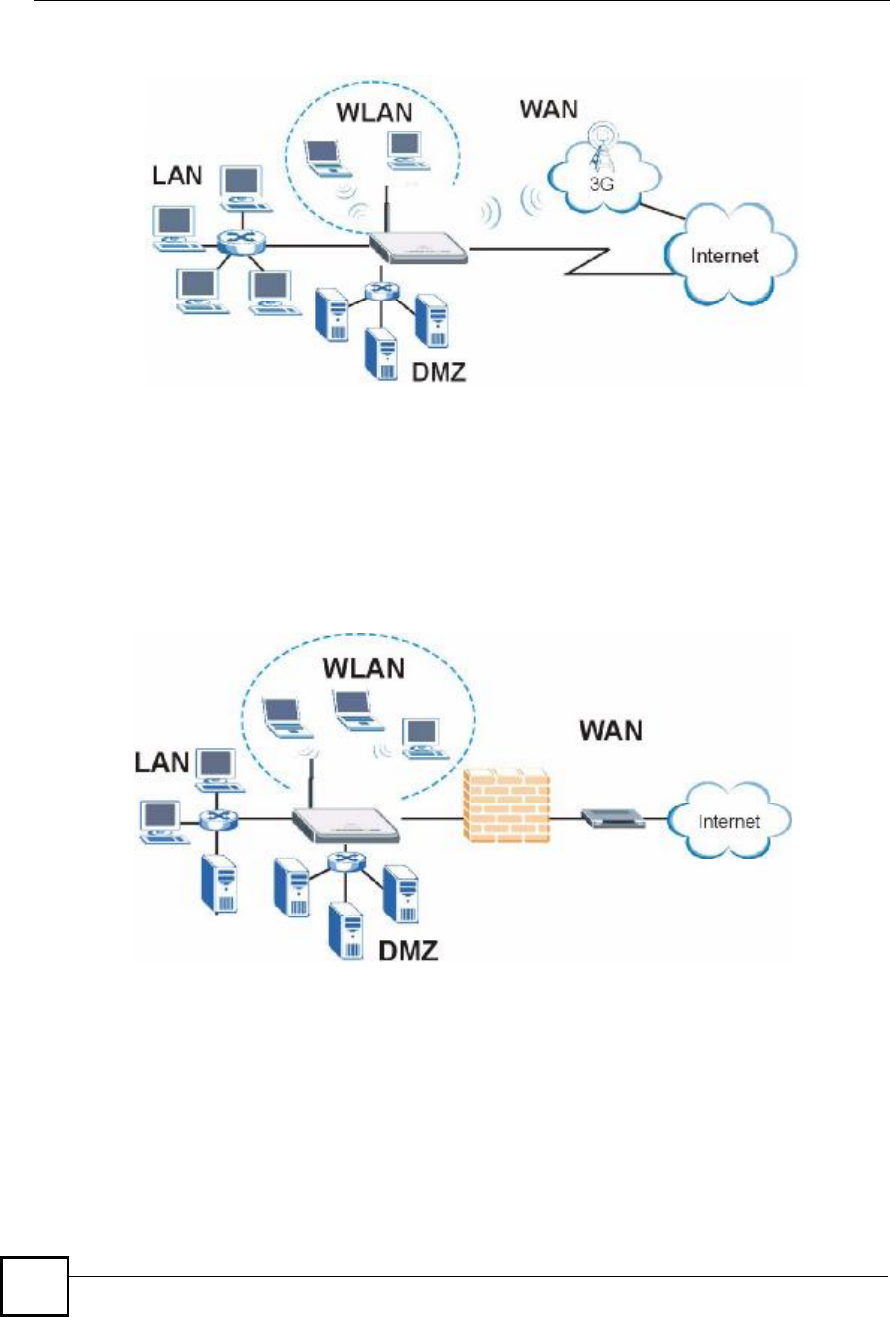
Chapter 1Getting to Know Your ZyXEL Device
NBG410W3G Series User s Guide
36
Figure 1 3G WAN Application
1.2.2 Secure Broadband Internet Access via Cable or DSL Modem
For Internet access, connect the WAN Ethernet port to your existing Internet access gateway
(company network, or your cable or DSL modem for example). Connect computers or servers
to the LAN or DMZ ports for shared Internet access.
The ZyXEL Device guarantees not only high speed Internet access, but secure internal
network protection and traffic management as well.
Figure 2 Secure Internet Access via Cable or DSL Modem
1.3 Ways to Manage the ZyXEL Device
Use any of the following methods to manage the ZyXEL Device.
Web Configurator. This is recommended for everyday management of the ZyXEL Device
using a (supported) web browser.
Command Line Interface. Line commands are mostly used for troubleshooting by service
engineers.
FTP for firmware upgrades and configuration backup/restore.

Chapter 1Getting to Know Your ZyXEL Device
NBG410W3G Series User s Guide 37
1.4 Configuring Your ZyXEL Device s Security Features
Your ZyXEL Device comes with a variety of security features. This section summarizes these
features and provides links to sections in the User!s Guide to configure security settings on
your ZyXEL Device. Follow the suggestions below to improve security on your ZyXEL
Device and network.
1.4.1 Control Access to Your Device
Ensure only people with permission can access your ZyXEL Device.
Control physical access by locating devices in secure areas, such as locked rooms. Most
ZyXEL Devices have a reset button. If an unauthorized person has access to the reset
button, they can then reset the device!s password to its default password, log in and
reconfigure its settings.
Change any default passwords on the ZyXEL Device, such as the password used for
accessing the ZyXEL Device!s web configurator (if it has a web configurator). Use a
password with a combination of letters and numbers and change your password regularly.
Write down the password and put it in a safe place.
Avoid setting a long timeout period before the ZyXEL Device!s web configurator
automatically times out. A short timeout reduces the risk of unauthorized person accessing
the web configurator while it is left idle.
See Chapter 20 on page 325 for instructions on changing your password and setting the
timeout period.
Configure remote management to control who can manage your ZyXEL Device. See
Section 15.1 on page 259 for more information. If you enable remote management, ensure
you have enabled remote management only on the IP addresses, services or interfaces you
intended and that other remote management settings are disabled.
1.4.2 Wireless Security
Wireless devices are especially vulnerable to attack. If your ZyXEL Device has a wireless
function, take the following measures to improve wireless security.
Enable wireless security on your ZyXEL Device. Choose the most secure encryption
method that all devices on your network support. If you have a RADIUS server, enable
IEEE 802.1x or WPA(2) user identification on your network so users must log in. This
method is more common in business environments.
Hide your wireless network name (SSID). The SSID can be regularly broadcast and
unauthorized users may use this information to access your network.
Enable the MAC filter to allow only trusted users to access your wireless network or deny
unwanted users access based on their MAC address.
See Section 8.2 on page 148 for directions on these wireless security measures.
1.4.3 Firewall
See Section 9.1 on page 167 for more information on the following security measures
Ensure the firewall is turned on. Traffic initiated from your WAN is blocked by default.

Chapter 1Getting to Know Your ZyXEL Device
NBG410W3G Series User s Guide
38
Set the firewall to block ICMP requests.
Enable do not respond to requests for unauthorized services.
If you have a backup gateway (for example, backup Internet access) on your network,
disable the Bypass Triangle Routes feature and enable IP Alias to put your backup
gateway on a different subnet.
Avoid raising the maximum number of NAT sessions per host unnecessarily as it increases
the possibility of unauthorized connections, such as connections caused by a computer
virus.
1.4.4 NAT
Enable NAT (Network Address Translation) to make devices on your network "invisible#
to those outside your network (unless you configure port-forwarding rules for them).
Applications such as games or file-sharing can be configured so they are visible from
other networks by using port-forwarding. Ensure only applications you want are
configured to port-forward.
See Section 12.1 on page 225 for instructions on these measures.
1.4.5 UPnP
Disable UPnP (Universal Plug and Play) unless you specifically want applications (for
example, games or file-sharing applications) on your network to pass through your
firewall unchecked.
See Section 16.1 on page 281 for instructions on this measure.
1.5 Maintaining Your ZyXEL Device
Do the following things regularly to keep your ZyXEL Device running.
Check the ZyXEL website (www.zyxel.com.tw) regularly for new firmware for your
ZyXEL Device.
Ensure you download the correct firmware for your model.
Back up the configuration (and make sure you know how to restore it). Restoring an
earlier working configuration may be useful if the device becomes unstable or even
crashes. If you forget your password, you will have to reset the ZyXEL Device to its
factory default settings. If you backed up an earlier configuration file, you would not have
to totally re-configure the ZyXEL Device. You could simply restore your last
configuration.
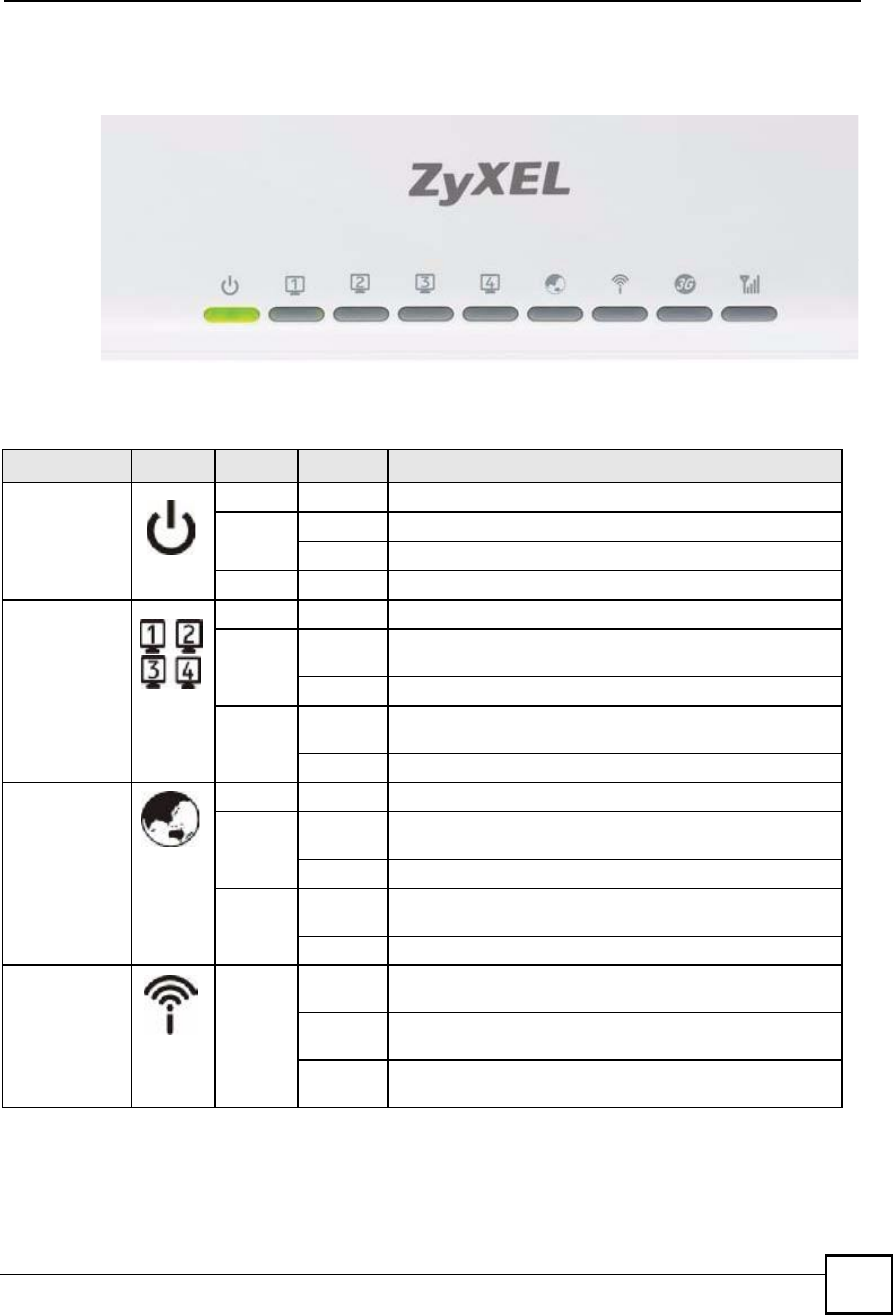
Chapter 1Getting to Know Your ZyXEL Device
NBG410W3G Series User s Guide 39
1.5.1 Front Panel Lights
Figure 3 Front Panel
The following tables describe the lights. Table 1 describes the light features in NBG410W3G,
and Table 2 describes the light features in NBG412W3G.
Table 1 NBG410W3G Front Panel Lights
LED ICONS COLOR STATUS DESCRIPTION
POWER OffThe ZyXEL Device is turned off.
GreenOnThe ZyXEL Device is ready and running.
FlashingThe ZyXEL Device is restarting.
RedOnThe power to the ZyXEL Device is too low.
LAN/DMZ 10/
100
OffThe LAN/DMZ is not connected.
GreenOnThe ZyXEL Device has a successful 10Mbps Ethernet
connection.
FlashingThe 10M LAN is sending or receiving packets.
OrangeOnThe ZyXEL Device has a successful 100Mbps Ethernet
connection.
FlashingThe 100M LAN is sending or receiving packets.
WAN OffThe WAN connection is not ready, or has failed.
GreenOnThe ZyXEL Device has a successful 10Mbps WAN
connection.
FlashingThe 10M WAN is sending or receiving packets.
OrangeOnThe ZyXEL Device has a successful 100Mbps WAN
connection.
FlashingThe 100M WAN is sending or receiving packets.
Wi-Fi GreenOffThe wireless connection through the built-in Wi-Fi card is not
ready, or has failed.
OnThe wireless LAN through the built-in wireless LAN card is
ready.
FlashingThe wireless LAN through the built-in wireless LAN card is
sending or receiving packets.
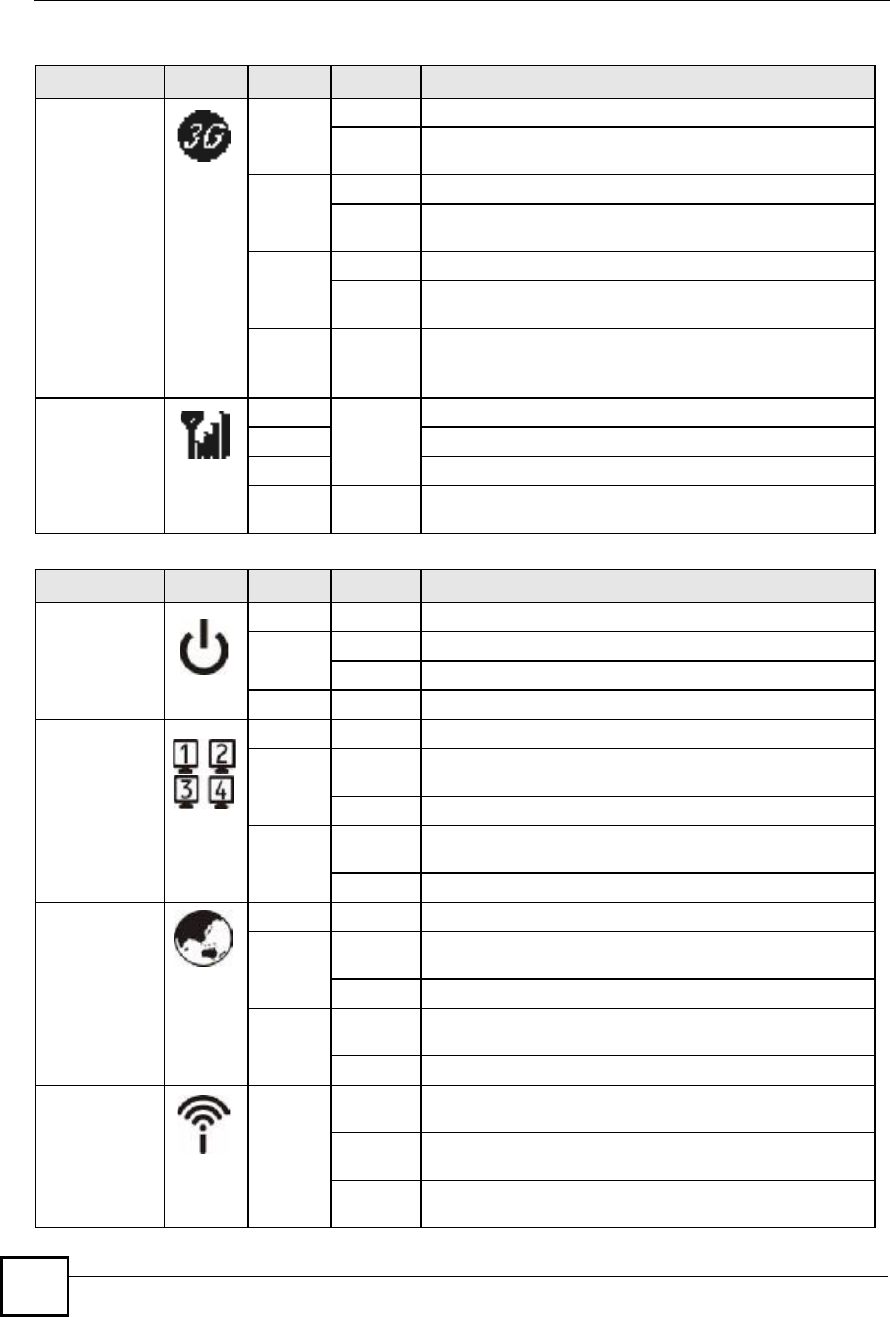
Chapter 1Getting to Know Your ZyXEL Device
NBG410W3G Series User s Guide
40
3G
OPERATION
GreenOnThe ZyXEL Device has a successful 3G connection.
FlashingThe ZyXEL Device has detected an available 3G network,
but has not yet connected to it.
BlueOnThe ZyXEL Device has a successful 3.5G connection
FlashingThe ZyXEL Device has detected an available 3.5G network,
but has not yet connected to it.
OrangeOnThe ZyXEL Device has a successful 2G or 2.5G connection
FlashingThe ZyXEL Device has detected an available 2G or 2.5G
network, but has not yet connected to it.
OffOne (or more) of the following has occurred.
!The 3G function is not activated.
!The ZyXEL Device is not registered with a 3G network.
3G SIGNAL
STRENGTH
GreenOnThe 3G signal is strong.
YellowThe 3G signal is moderate.
RedThe 3G signal is weak.
OffIf the 3G OPERATION LED is not off, no 3G signal is
detected.
Table 2 NBG412W3G Front Panel Lights
LED ICONS COLOR STATUS DESCRIPTION
POWER OffThe ZyXEL Device is turned off.
GreenOnThe ZyXEL Device is ready and running.
FlashingThe ZyXEL Device is restarting.
RedOnThe power to the ZyXEL Device is too low.
LAN/DMZ 10/
100
OffThe LAN/DMZ is not connected.
GreenOnThe ZyXEL Device has a successful 10Mbps Ethernet
connection.
FlashingThe 10M LAN is sending or receiving packets.
OrangeOnThe ZyXEL Device has a successful 100Mbps Ethernet
connection.
FlashingThe 100M LAN is sending or receiving packets.
WAN OffThe WAN connection is not ready, or has failed.
GreenOnThe ZyXEL Device has a successful 10Mbps WAN
connection.
FlashingThe 10M WAN is sending or receiving packets.
OrangeOnThe ZyXEL Device has a successful 100Mbps WAN
connection.
FlashingThe 100M WAN is sending or receiving packets.
Wi-Fi GreenOffThe wireless connection through the built-in Wi-Fi card is not
ready, or has failed.
OnThe wireless LAN through the built-in wireless LAN card is
ready.
FlashingThe wireless LAN through the built-in wireless LAN card is
sending or receiving packets.
Table 1 NBG410W3G Front Panel Lights (continued)
LED ICONS COLOR STATUS DESCRIPTION

Chapter 1Getting to Know Your ZyXEL Device
NBG410W3G Series User s Guide 41
3G MODE GreenOnThe 3G function is activated.
OffThe 3G function is not activated.
3G LINK GreenOnThe ZyXEL Device has a successful 3G connection.
OffThere is no 3G connection
Table 2 NBG412W3G Front Panel Lights (continued)
LED ICONS COLOR STATUS DESCRIPTION

Chapter 1Getting to Know Your ZyXEL Device
NBG410W3G Series User s Guide
42

NBG410W3G Series User s Guide 43
CHAPTER 2
Introducing the Web
Configurator
This chapter describes how to access the ZyXEL Device web configurator and provides an
overview of its screens.
2.1 Web Configurator Overview
The web configurator is an HTML-based management interface that allows easy ZyXEL
Device setup and management via Internet browser. Use Internet Explorer 6.0 and later or
Netscape Navigator 7.0 and later versions. The recommended screen resolution is 1024 by 768
pixels.
In order to use the web configurator you need to allow:
Web browser pop-up windows from your device. Web pop-up blocking is enabled by
default in Windows XP SP (Service Pack) 2.
JavaScripts (enabled by default).
Java permissions (enabled by default).
See Appendix A on page 353 if you want to make sure these functions are allowed in Internet
Explorer or Netscape Navigator.
2.2 Accessing the ZyXEL Device Web Configurator
1Make sure your ZyXEL Device hardware is properly connected and prepare your
computer/computer network to connect to the ZyXEL Device (refer to the Quick Start
Guide).
2Launch your web browser.
3Type "192.168.1.1" as the URL.
4Type "1234" (default) as the password and click Login. In some versions, the default
password appears automatically - if this is the case, click Login.
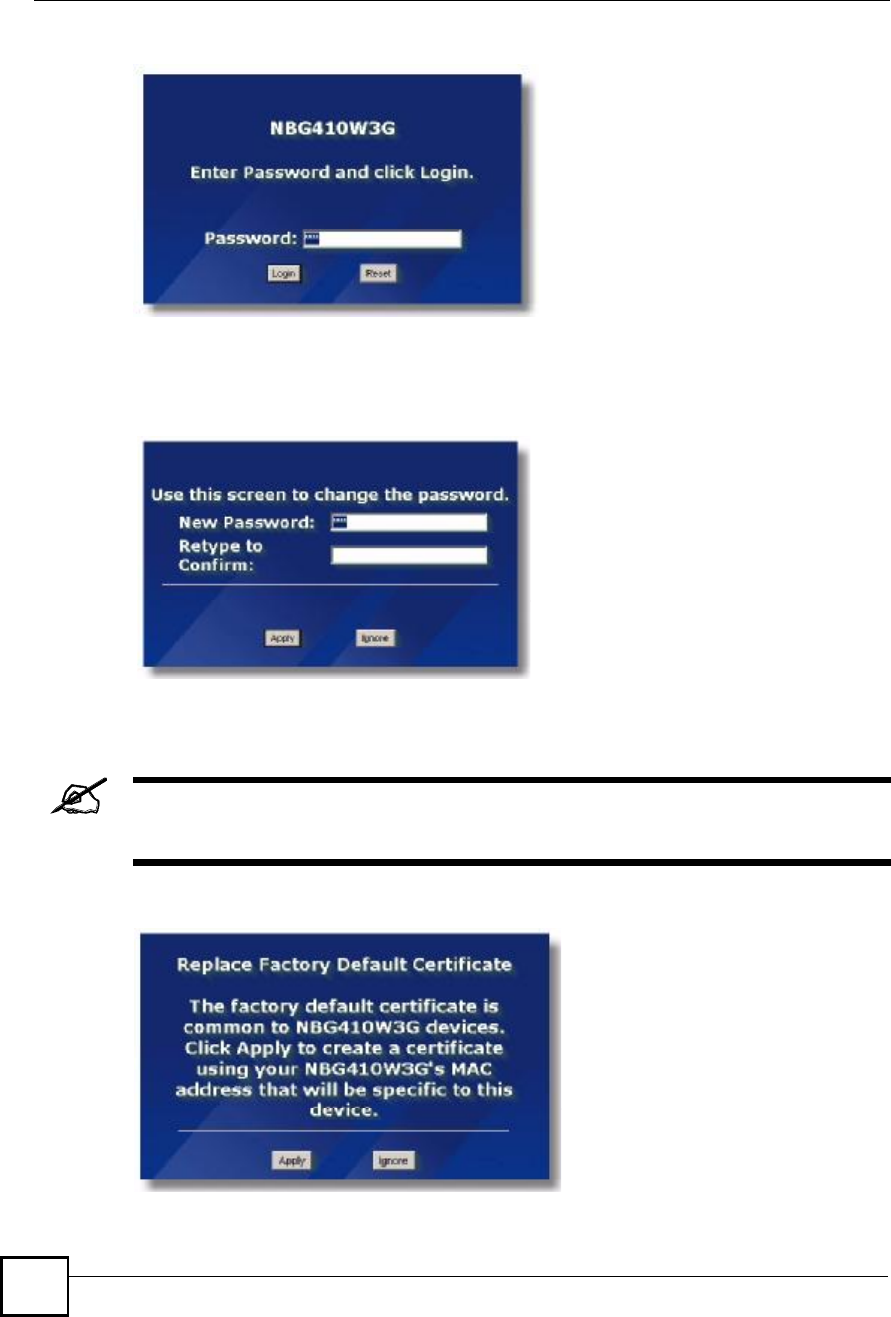
Chapter 2Introducing the Web Configurator
NBG410W3G Series User s Guide
44
Figure 4 Login Screen
5You should see a screen asking you to change your password (highly recommended) as
shown next. Type a new password (and retype it to confirm) and click Apply or click
Ignore.
Figure 5 Change Password Screen
6Click Apply in the Replace Certificate screen to create a certificate using your ZyXEL
Device!s MAC address that will be specific to this device.
If you do not replace the default certificate here or in the CERTIFICATES
screen, this screen displays every time you access the web configurator.
Figure 6 Replace Certificate Screen
7You should now see the HOME screen (see Figure 9 on page 47).

Chapter 2Introducing the Web Configurator
NBG410W3G Series User s Guide 45
The management session automatically times out when the time period set in
the Administrator Inactivity Timer field expires (default five minutes). Simply
log back into the ZyXEL Device if this happens to you.
2.3 Resetting the ZyXEL Device
If you forget your password or cannot access the web configurator, you will need to reload the
factory-default configuration file or use the RESET button on the back of the ZyXEL Device.
Uploading this configuration file replaces the current configuration file with the factory-
default configuration file. This means that you will lose all configurations that you had
previously and the speed of the console port will be reset to the default of 9600bps with 8 data
bit, no parity, one stop bit and flow control set to none. The password will be reset to 1234,
also.
2.3.1 Procedure To Use The Reset Button
Make sure the POWER LED is on (not blinking) before you begin this procedure.
1Press the RESET button for ten seconds, and then release it. If the POWER LED begins
to blink, the defaults have been restored and the ZyXEL Device restarts. Otherwise, go
to step 2.
2Turn the ZyXEL Device off.
3While pressing the RESET button, turn the ZyXEL Device on.
4Continue to hold the RESET button. The POWER LED will begin to blink and flicker
very quickly after about 20 seconds. This indicates that the defaults have been restored
and the ZyXEL Device is now restarting.
5Release the RESET button and wait for the ZyXEL Device to finish restarting.
2.3.2 Uploading a Configuration File Via Console Port
1Download the default configuration file from the ZyXEL FTP site, unzip it and save it in
a folder.
2Turn off the ZyXEL Device, begin a terminal emulation software session and turn on the
ZyXEL Device again. When you see the message "Press Any key to enter Debug Mode
within 3 seconds", press any key to enter debug mode.
3Enter "y" at the prompt below to go into debug mode.
4Enter "atlc" after "Enter Debug Mode" message.
5Wait for "Starting XMODEM upload" message before activating Xmodem upload on
your terminal. This is an example Xmodem configuration upload using HyperTerminal.
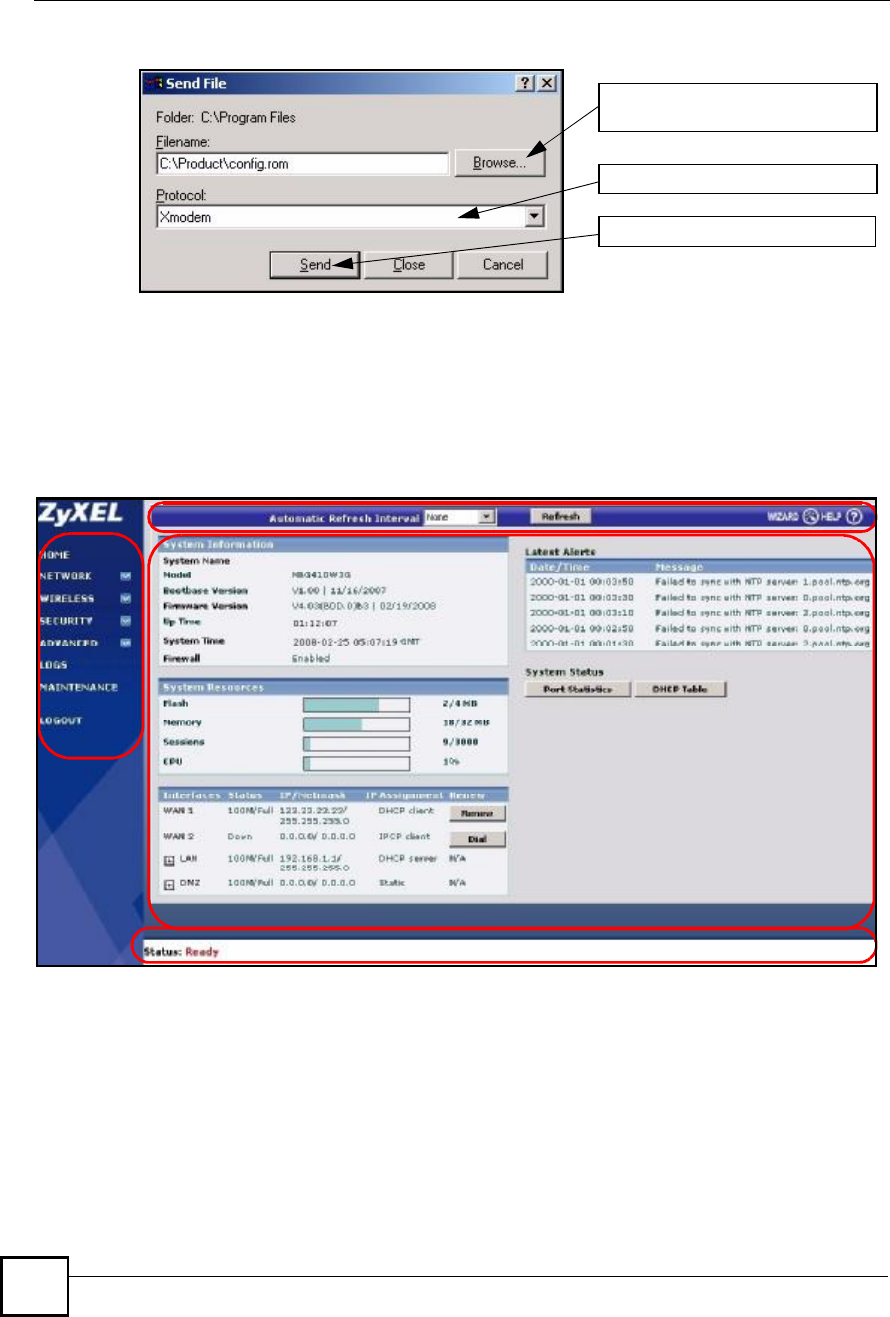
Chapter 2Introducing the Web Configurator
NBG410W3G Series User s Guide
46
Figure 7 Example Xmodem Upload
6After successful firmware upload, enter "atgo" to restart the router.
2.4 Navigating the ZyXEL Device Web Configurator
The following summarizes how to navigate the web configurator from the HOME screen.
Figure 8 HOME Screen
As illustrated above, the main screen is divided into these parts:
A - title bar
B - main window
C - navigation panel
D - status bar
2.4.1 Title Bar
The title bar provides some icons in the upper right corner.
Type the configuration file s location,
or click Browse to search for it.
Choose the Xmodem protocol.
Then click Send.
C
D
B
A
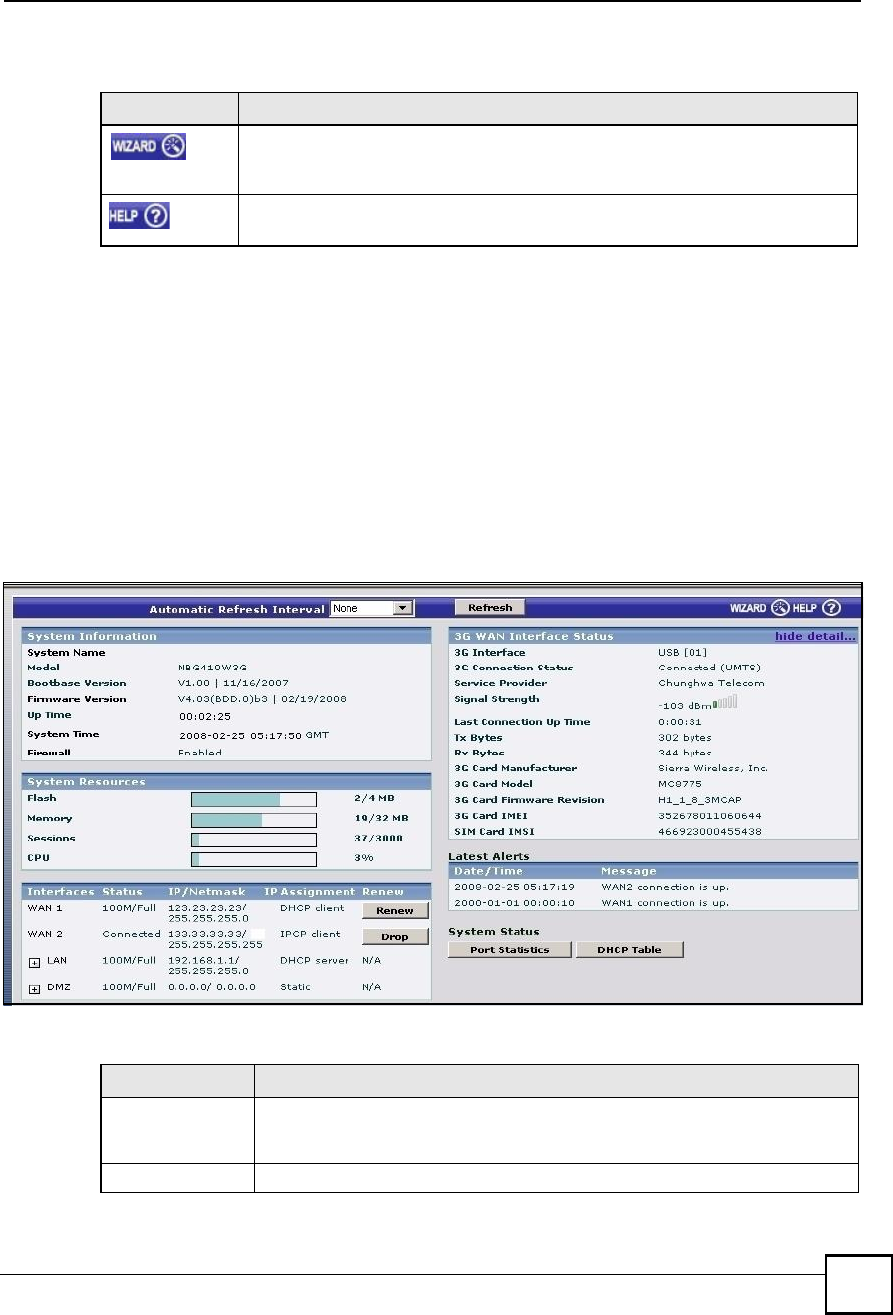
Chapter 2Introducing the Web Configurator
NBG410W3G Series User s Guide 47
The icons provide the following functions.
2.4.2 Main Window
The main window shows the screen you select in the navigation panel. It is discussed in more
detail in the rest of this document.
Right after you log in, the HOME screen is displayed.
2.4.3 HOME Screen
This screen displays general status information about the ZyXEL Device.
WAN 2 refers to the 3G feature on the supported ZyXEL Device.
Figure 9 Web Configurator HOME Screen
The following table describes the labels in this screen.
Table 3 Title Bar: Web Configurator Icons
ICON DESCRIPTION
Wizard
Click this icon to open one of the web configurator wizards. See Chapter 3 on page
59 for more information.
Help
Click this icon to open the help page for the current screen.
Table 4 Web Configurator HOME Screen
LABEL DESCRIPTION
Automatic Refresh
Interval
Select a number of seconds or None from the drop-down list box to update all
screen statistics automatically at the end of every time interval or to not update
the screen statistics.
RefreshClick this button to update the status screen statistics immediately.

Chapter 2Introducing the Web Configurator
NBG410W3G Series User s Guide
48
System
Information
System NameThis is the System Name you enter in the MAINTENANCE > General screen. It
is for identification purposes. Click the field label to go to the screen where you
can specify a name for this ZyXEL Device.
ModelThis is the model name of your ZyXEL Device.
Bootbase VersionThis is the bootbase version and the date created.
Firmware VersionThis is the ZyNOS firmware version and the date created. ZyNOS is ZyXEL's
proprietary Network Operating System design. Click the field label to go to the
screen where you can upload a new firmware file.
Up TimeThis field displays how long the ZyXEL Device has been running since it last
started up. The ZyXEL Device starts up when you turn it on, when you restart it
(MAINTENANCE > Restart), or when you reset it (see Section 2.3 on page 45).
System TimeThis field displays your ZyXEL Device s present date (in yyyy-mm-dd format) and
time (in hh:mm:ss format) along with the difference from the Greenwich Mean
Time (GMT) zone. The difference from GMT is based on the time zone. It is also
adjusted for Daylight Saving Time if you set the ZyXEL Device to use it. Click the
field label to go to the screen where you can modify the ZyXEL Device s date and
time settings.
FirewallThis displays whether or not the ZyXEL Device s firewall is activated. Click the
field label to go to the screen where you can turn the firewall on or off.
System Resources
FlashThe first number shows how many megabytes of the flash the ZyXEL Device is
using.
MemoryThe first number shows how many megabytes of the heap memory the ZyXEL
Device is using. Heap memory refers to the memory that is not used by ZyNOS
(ZyXEL Network Operating System) and is thus available for running processes
like NAT and the firewall.
The second number shows the ZyXEL Device's total heap memory (in
megabytes).
The bar displays what percent of the ZyXEL Device's heap memory is in use. The
bar turns from green to red when the maximum is being approached.
SessionsThe first number shows how many sessions are currently open on the ZyXEL
Device. This includes all sessions that are currently traversing the ZyXEL Device,
terminating at the ZyXEL Device or Initiated from the ZyXEL Device
The second number is the maximum number of sessions that can be open at one
time.
The bar displays what percent of the maximum number of sessions is in use. The
bar turns from green to red when the maximum is being approached.
CPUThis field displays what percentage of the ZyXEL Device s processing ability is
currently used. When this percentage is close to 100%, the ZyXEL Device is
running at full load, and the throughput is not going to improve anymore. If you
want some applications to have more throughput, you should turn off other
applications.
InterfacesThis is the port type.
Click "+" to expand or "-" to collapse the IP alias drop-down lists.
Hold your cursor over an interface s label to display the interface s MAC address.
Click an interface s label to go to the screen where you can configure settings for
that interface.
Table 4 Web Configurator HOME Screen (continued)
LABEL DESCRIPTION

Chapter 2Introducing the Web Configurator
NBG410W3G Series User s Guide 49
StatusFor the LAN and DMZ ports, this displays the port speed and duplex setting.
Ethernet port connections can be in half-duplex or full-duplex mode. Full-duplex
refers to a device's ability to send and receive simultaneously, while half-duplex
indicates that traffic can flow in only one direction at a time. The Ethernet port
must use the same speed or duplex mode setting as the peer Ethernet port in
order to connect.
For the WAN 1 port, it displays the port speed and duplex setting if you re using
Ethernet encapsulation or the remote node name for a PPP connection and
Down (line is down or not connected), Idle (line (ppp) idle), Dial (starting to
trigger a call) or Drop (dropping a call) if you re using PPPoE encapsulation.
For the WAN 2 interface, it displays Connected when the 3G connection is up,
Connecting when the 3G card is trying to connect to a network but has not
received a response from the base station, Ready to Connect when the 3G
connection is idle, Initializing when the ZyXEL Device is configuring the 3G card
with AT commands, Disconnecting when the ZyXEL Device is dropping the 3G
connection or Down when the 3G connection is down.
IP/NetmaskThis shows the port s IP address and subnet mask.
IP Assignment For the WAN, if the ZyXEL Device gets its IP address automatically from an ISP,
this displays DHCP client when you re using Ethernet encapsulation and IPCP
Client when you re using PPPoE or PPTP encapsulation. Static displays if the
WAN port is using a manually entered static (fixed) IP address.
For the LAN or DMZ, DHCP server displays when the ZyXEL Device is set to
automatically give IP address information to the computers connected to the LAN.
DHCP relay displays when the ZyXEL Device is set to forward IP address
assignment requests to another DHCP server. Static displays if the LAN port is
using a manually entered static (fixed) IP address. In this case, you must have
another DHCP server on your LAN, or else the computers must be manually
configured.
RenewIf you are using Ethernet encapsulation and the WAN port is configured to get the
IP address automatically from the ISP, click Renew to release the WAN port s
dynamically assigned IP address and get the IP address afresh. Click Dial to dial
up the PPTP, PPPoE or 3G WAN connection. Click Drop to disconnect the PPTP,
PPPoE or 3G WAN connection.
3G WAN Interface
Status
The fields below display when a 3G card is inserted and WAN 2 is enabled.
show detail.../hide
detail...
Click show detail... to see more information about the 3G connection and 3G
card. Click hide detail... to display less information about the 3G connection and
3G card.
3G Connection
Status
This displays Down when the 3G connection is down or not activated.
This displays Initializing when the ZyXEL Device is configuring the 3G card with
AT commands.
This displays Ready to Connect when the 3G connection is idle before the
ZyXEL Device triggers a call.
This displays Connecting when the 3G card is trying to connect to a network but
has not received a response from the base station.
This displays Connected when the 3G connection is up.
This displays Disconnecting when the ZyXEL Device is dropping the 3G
connection.
This field also displays the type of the network to which the ZyXEL Device is
connected. The network type varies depending on the 3G card you inserted and
could be UMTS, HSDPA, GPRS or EDGE when you insert a GSM 3G card, or
1xRTT, EVDO Rev.0 or EVDO Rev.A when you insert a CDMA 3G card.
Service ProviderThis displays the name of your network service provider or Limited Service when
the signal strength is too low or the ISP is limiting your access.
Table 4 Web Configurator HOME Screen (continued)
LABEL DESCRIPTION

Chapter 2Introducing the Web Configurator
NBG410W3G Series User s Guide
50
Roaming NetworkThis field is available only when you insert a 3G card that supports the roaming
feature.
This displays whether the card is able to connect to other ISPs base stations.
Dormant StateThis field is available only when you insert a 3G card that supports the dormant
state.
This displays whether the card is in dormant state. When there is no data
transmitting, a card does not send a radio signal and is in dormant state to reduce
bandwidth usage.
Signal StrengthThis displays the signal strength of the wireless network in dBm. The status bar
shows the strength of the signal. The signal strength mainly depends on the
antenna output power and the distance between your ZyXEL Device and the
service provider s base station. You can see a signal strength indication even
when the ZyXEL Device does not have a 3G connection (because the signal is
still there even when the ZyXEL Device is not using it).
Last Connection
Up Time
This displays how long the 3G connection has been up.
Tx BytesThis displays the total number of data frames transmitted.
Rx BytesThis displays the total number of data frames received.
3G Card
Manufacturer
This displays the manufacturer of your 3G card.
3G Card ModelThis displays the model name of your 3G card.
3G Card Firmware
Revision
This displays the version of the firmware currently used in the 3G card.
3G Card IMEIThis field is available only when you insert a GSM (Global System for Mobile
Communications) or UMTS (Universal Mobile Telecommunications System) 3G
card.
This displays the International Mobile Equipment Identity (IMEI) which is the
serial number of the GSM or UMTS 3G wireless card. The IMEI is a unique 15-
digit number used to identify a mobile device.
SIM Card IMSIThis field is available only when you insert a GSM or UMTS 3G card.
This displays the International Mobile Subscriber Identity (IMSI) stored in the SIM
(Subscriber Identity Module) card. The SIM card is installed in a mobile device
and used for authenticating a customer to the carrier network. The IMSI is a
unique 15-digit number used to identify a user on a network.
3G Card ESNThis field is available only when you insert a CDMA (Code Division Multiple
Access) 3G card.
This shows the ESN (Electronic Serial Number) of the inserted CDMA 3G card.
The ESN is the serial number of a CDMA 3G card and is similar to the IMEI on a
GSM or UMTS 3G card.
Enter PIN code
again
If the PIN code you specified in the 3G (WAN 2) screen is not the right one for the
card you inserted, this field displays allowing you to enter the correct PIN code.
Enter the PIN code (four to eight digits) for the inserted 3G card.
ApplyClick Apply to save the correct PIN code and replace the one you specified in the
3G (WAN 2) screen.
PUK CodeIf you enter the PIN code incorrectly three times, the SIM card will be blocked by
your ISP and you cannot use the account to access the Internet. You should get
the PUK (Personal Unblocking Key) code (four to eight digits) from your ISP.
Enter the PUK code to enable the SIM card. If an incorrect PUK code is entered
10 times, the SIM card will be disabled permanently. You then need to contact
your ISP for a new SIM card.
Table 4 Web Configurator HOME Screen (continued)
LABEL DESCRIPTION

Chapter 2Introducing the Web Configurator
NBG410W3G Series User s Guide 51
New PIN CodeConfigure a PIN code for the SIM card. You can specify any four to eight digits to
have a new PIN code or enter the previous PIN code.
Confirm New PIN
Code
Enter the PIN code again for confirmation.
ApplyClick Apply to save your changes in this section.
Reset budget
counters, resume
budget control
This field displays if you have enabled budget control but insert a 3G card with a
different user account from the one for which you configured budget control.
Select this option to have the ZyXEL Device do budget calculation starting from 0
but use the previous settings.
Resume budget
control
This field displays if you have enabled budget control but insert a 3G card with a
different user account from the one for which you configured budget control.
Select this option to have the ZyXEL Device keep the existing statistics and
continue counting.
Disable budget
control
This field displays if you have enabled budget control but insert a 3G card with a
different user account from the one for which you configured budget control.
Select this option to disable budget control.
If you want to enable and configure new budget control settings for the new user
account, go to the 3G (WAN 2) screen.
The ZyXEL Device keeps the existing statistics if you do not change the budget
control settings. You could reinsert the original card and enable budget control to
have the ZyXEL Device continue counting the budget control statistics.
ApplyClick Apply to save your changes in this section.
Enter modem
unlock code
This field only displays when you insert a 3G card and the internal modem on the
3G card is blocked.
Enter a key to enable the internal modem on your 3G card. By default, the key is
the last four digits of your phone number used to dial up the 3G connection.
Otherwise, you need to get the key from your service provider.
ApplyClick Apply to save your changes in this section.
Remaining Time
Budget
This field is available only when you enable budget control in the 3G (WAN 2)
screen.
This shows the amount of time (in hours and minutes) the 3G connection can still
be used before the ZyXEL Device takes the actions you specified in the 3G (WAN
2) screen.
Remaining Data
Budget
This field is available only when you enable budget control in the Network > WAN
> 3G (WAN 2) screen.
This shows how much data (in bytes) can still be transmitted through the 3G
connection before the ZyXEL Device takes the actions you specified in the 3G
(WAN 2) screen.
Note: The budget counters will not be reset when you restore the
factory defaults. The budget counters are saved to the flash
every hour or when the 3G connection is dropped. If you
restart the ZyXEL Device within one hour, any change in the
counters will not be saved.
Reset time and
data budget
counters
This button is available only when you enable budget control in the 3G (WAN 2)
screen.
Click this button to reset the time and data budgets. The count starts over with the
3G connection s full configured monthly time and data budgets. This does not
affect the normal monthly budget restart.
Table 4 Web Configurator HOME Screen (continued)
LABEL DESCRIPTION

Chapter 2Introducing the Web Configurator
NBG410W3G Series User s Guide
52
2.4.4 Navigation Panel
After you enter the password, use the sub-menus on the navigation panel to configure ZyXEL
Device features.
The following table describes the sub-menus.
Latest Alerts This table displays the five most recent alerts recorded by the ZyXEL Device. You
can see more information in the View Log screen, such as the source and
destination IP addresses and port numbers of the incoming packets.
Date/TimeThis is the date and time the alert was recorded.
MessageThis is the reason for the alert.
System Status
Port StatisticsClick Port Statistics to see router performance statistics such as the number of
packets sent and number of packets received for each port.
DHCP TableClick DHCP Table to show current DHCP client information.
BandwidthClick Bandwidth to view the ZyXEL Device s bandwidth usage and allotments.
Table 4 Web Configurator HOME Screen (continued)
LABEL DESCRIPTION
Table 5 Screens Summary
LINK TAB FUNCTION
HOME This screen shows the ZyXEL Device s general device and
network status information. Use this screen to access the wizards,
statistics and DHCP table.
NETWORK
LAN LAN Use this screen to configure LAN DHCP and TCP/IP settings.
Static DHCP Use this screen to assign fixed IP addresses on the LAN.
IP Alias Use this screen to partition your LAN interface into subnets.
Port Roles Use this screen to change the LAN/DMZ port roles.
WAN General This screen allows you to configure operation mode, route priority
and connection test.
WAN1 Use this screen to configure the WAN1 connection for Internet
access.
3G (WAN2) Use this screen to configure the WAN2 connection for Internet
access.
Traffic
Redirect
Use this screen to configure your traffic redirect properties and
parameters.
DMZ DMZ Use this screen to configure your DMZ connection.
Static DHCP Use this screen to assign fixed IP addresses on the DMZ.
IP Alias Use this screen to partition your DMZ interface into subnets.
Port Roles Use this screen to change the LAN/DMZ port roles on the ZyXEL
Device.
WIRELESS
3G (WAN2) 3G (WAN2) Use this screen to configure the WAN2 connection for Internet
access.

Chapter 2Introducing the Web Configurator
NBG410W3G Series User s Guide 53
Wi-Fi Wireless Card Use this screen to configure the wireless LAN settings.
Security Use this screen to configure the Wi-Fi security settings.
MAC Filter Use this screen to change MAC filter settings on the ZyXEL
Device
SECURITY
FIREWALL Default Rule Use this screen to activate/deactivate the firewall and the direction
of network traffic to which to apply the rule
Rule Summary This screen shows a summary of the firewall rules, and allows you
to edit/add a firewall rule.
Anti-Probing Use this screen to change your anti-probing settings.
Threshold Use this screen to configure the threshold for DoS attacks.
Service Use this screen to configure custom services.
CERTIFICATES My Certificates Use this screen to view a summary list of certificates and manage
certificates and certification requests.
Trusted CAs Use this screen to view and manage the list of the trusted CAs.
Trusted
Remote Hosts
Use this screen to view and manage the certificates belonging to
the trusted remote hosts.
Directory
Servers
Use this screen to view and manage the list of the directory
servers.
AUTH SERVER Local User
Database
Use this screen to configure the local user account(s) on the
ZyXEL Device.
RADIUS Configure this screen to use an external server to authenticate
wireless users.
ADVANCED
NAT NAT Overview Use this screen to enable NAT.
Address
Mapping
Use this screen to configure network address translation mapping
rules.
Port
Forwarding
Use this screen to configure servers behind the ZyXEL Device.
Port
Triggering
Use this screen to change your ZyXEL Device s port triggering
settings.
STATIC ROUTE IP Static Route Use this screen to configure IP static routes.
DNS System Use this screen to configure the address and name server
records.
Cache Use this screen to configure the DNS resolution cache.
DHCP Use this screen to configure LAN/DMZ DNS information.
DDNS Use this screen to set up dynamic DNS.
Table 5 Screens Summary (continued)
LINK TAB FUNCTION

Chapter 2Introducing the Web Configurator
NBG410W3G Series User s Guide
54
2.4.5 Port Statistics
Click Port Statistics in the HOME screen. Read-only information here includes port status
and packet specific statistics. The Automatic Refresh Interval field is configurable.
REMOTE
MGMT
WWW Use this screen to configure through which interface(s) and from
which IP address(es) users can use HTTPS or HTTP to manage
the ZyXEL Device.
SSH Use this screen to configure through which interface(s) and from
which IP address(es) users can use Secure Shell to manage the
ZyXEL Device.
TELNET Use this screen to configure through which interface(s) and from
which IP address(es) users can use Telnet to manage the ZyXEL
Device.
FTP Use this screen to configure through which interface(s) and from
which IP address(es) users can use FTP to access the ZyXEL
Device.
SNMP Use this screen to configure your ZyXEL Device s settings for
Simple Network Management Protocol management.
DNS Use this screen to configure through which interface(s) and from
which IP address(es) users can send DNS queries to the ZyXEL
Device.
CNM Use this screen to configure and allow your ZyXEL Device to be
managed by the Vantage CNM server.
UPnP UPnP Use this screen to enable UPnP on the ZyXEL Device.
Ports Use this screen to view the NAT port mapping rules that UPnP
creates on the ZyXEL Device.
Custom APP Custom APP Use this screen to specify port numbers for the ZyXEL Device to
monitor for FTP, HTTP, SMTP, POP3, H323, and SIP traffic.
ALG ALG Use this screen to allow certain applications to pass through the
ZyXEL Device.
LOGS View Log Use this screen to view the logs for the categories that you
selected.
Log Settings Use this screen to change your ZyXEL Device s log settings.
Reports Use this screen to have the ZyXEL Device record and display the
network usage reports.
MAINTENANCE General This screen contains administrative.
Password Use this screen to change your password.
Time and Date Use this screen to change your ZyXEL Device s time and date.
F/W Upload Use this screen to upload firmware to your ZyXEL Device
Backup &
Restore
Use this screen to backup and restore the configuration or reset
the factory defaults to your ZyXEL Device.
Restart This screen allows you to reboot the ZyXEL Device without turning
the power off.
LOGOUT Click this label to exit the web configurator.
Table 5 Screens Summary (continued)
LINK TAB FUNCTION
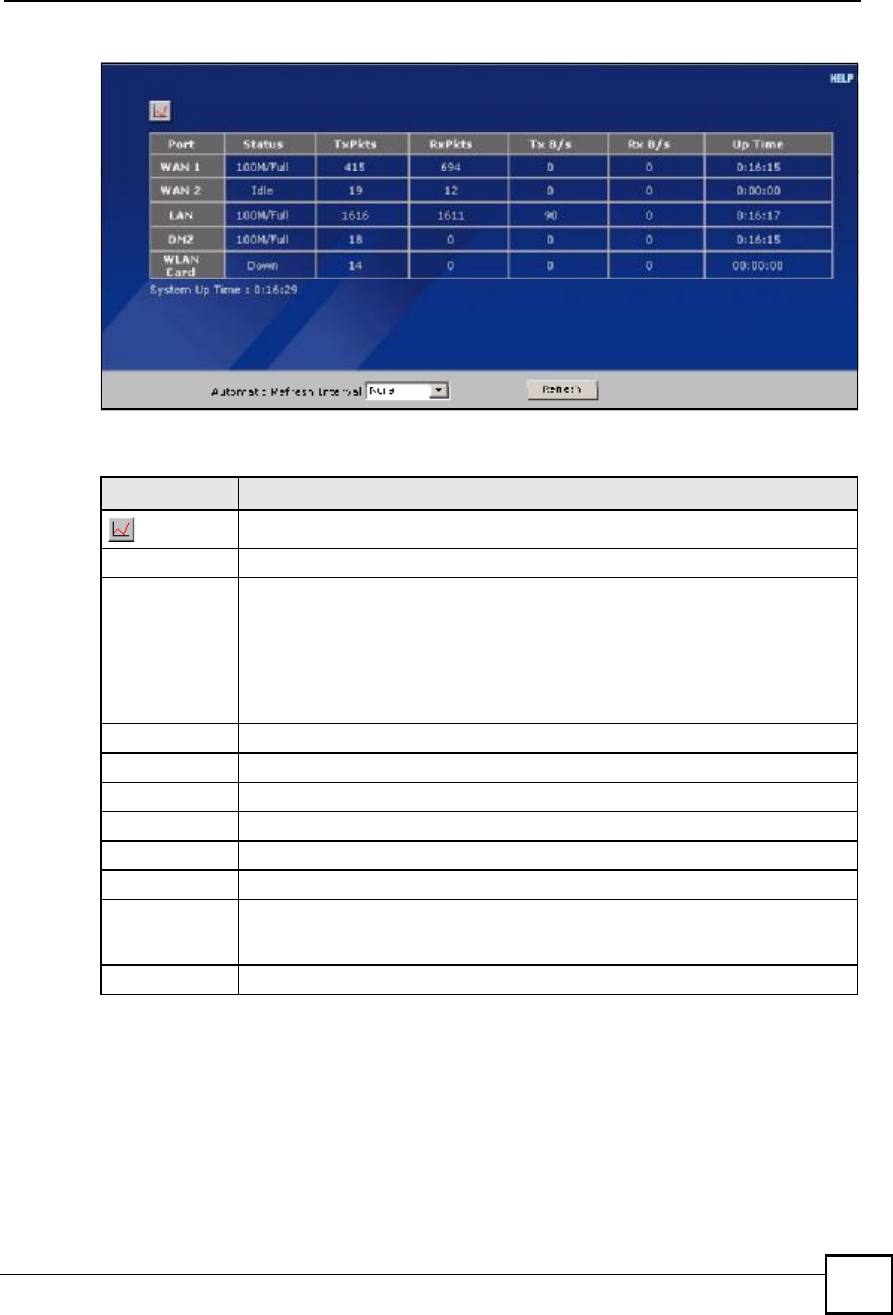
Chapter 2Introducing the Web Configurator
NBG410W3G Series User s Guide 55
Figure 10 HOME > Show Statistics
The following table describes the labels in this screen.
2.4.6 Show Statistics: Line Chart
Click the icon in the Show Statistics screen. This screen shows you a line chart of each port!s
throughput statistics.
Table 6 HOME > Show Statistics
LABEL DESCRIPTION
Click the icon to display the chart of throughput statistics.
PortThese are the ZyXEL Device s interfaces.
StatusFor the WAN interface(s), this displays the port speed and duplex setting if you re
using Ethernet encapsulation or the remote node name for a PPP connection and
Down (line is down or not connected), Idle (line (ppp) idle), Dial (starting to trigger a
call) or Drop (dropping a call) if you re using PPPoE encapsulation.
For the LAN or DMZ ports, this displays the port speed and duplex setting.
For the Wi-Fi card, this displays the transmission rate when Wi-Fi is enabled or
Down when Wi-Fi is disabled.
TxPktsThis is the number of transmitted packets on this port.
RxPktsThis is the number of received packets on this port.
Tx B/sThis displays the transmission speed in bytes per second on this port.
Rx B/sThis displays the reception speed in bytes per second on this port.
Up TimeThis is the total amount of time the line has been up.
System Up TimeThis is the total time the ZyXEL Device has been on.
Automatic
Refresh Interval
Select a number of seconds or None from the drop-down list box to update all
screen statistics automatically at the end of every time interval or to not update the
screen statistics.
RefreshClick this button to update the screen s statistics immediately.
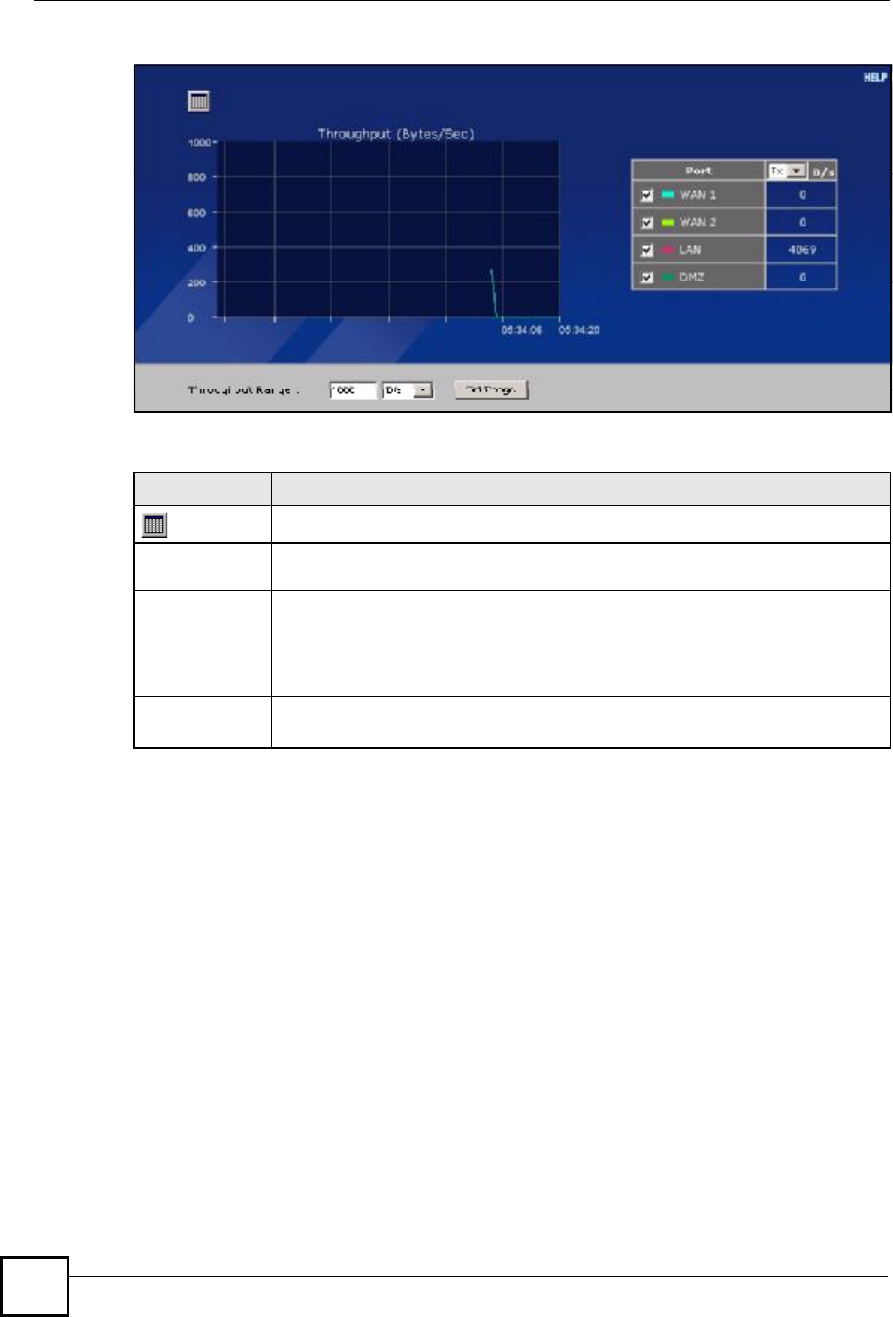
Chapter 2Introducing the Web Configurator
NBG410W3G Series User s Guide
56
Figure 11 HOME > Show Statistics > Line Chart
The following table describes the labels in this screen.
2.4.7 DHCP Table Screen
DHCP (Dynamic Host Configuration Protocol, RFC 2131 and RFC 2132) allows individual
clients to obtain TCP/IP configuration at start-up from a server. You can configure the ZyXEL
Device as a DHCP server or disable it. When configured as a server, the ZyXEL Device
provides the TCP/IP configuration for the clients. If DHCP service is disabled, you must have
another DHCP server on your LAN, or else the computer must be manually configured.
Click Show DHCP Table in the HOME screen. Read-only information here relates to your
DHCP status. The DHCP table shows current DHCP client information (including IP
Address, Host Name and MAC Address) of all network clients using the ZyXEL Device!s
DHCP server.
Table 7 HOME > Show Statistics > Line Chart
LABEL DESCRIPTION
Click the icon to go back to the Show Statistics screen.
PortSelect the check box(es) to display the throughput statistics of the corresponding
interface(s).
B/sSpecify the direction of the traffic for which you want to show throughput statistics in
this table.
Select Tx to display transmitted traffic throughput statistics and the amount of traffic
(in bytes). Select Rx to display received traffic throughput statistics and the amount
of traffic (in bytes).
Throughput
Range
Set the range of the throughput (in B/s, KB/s or MB/s) to display.
Click Set Range to save this setting back to the ZyXEL Device.
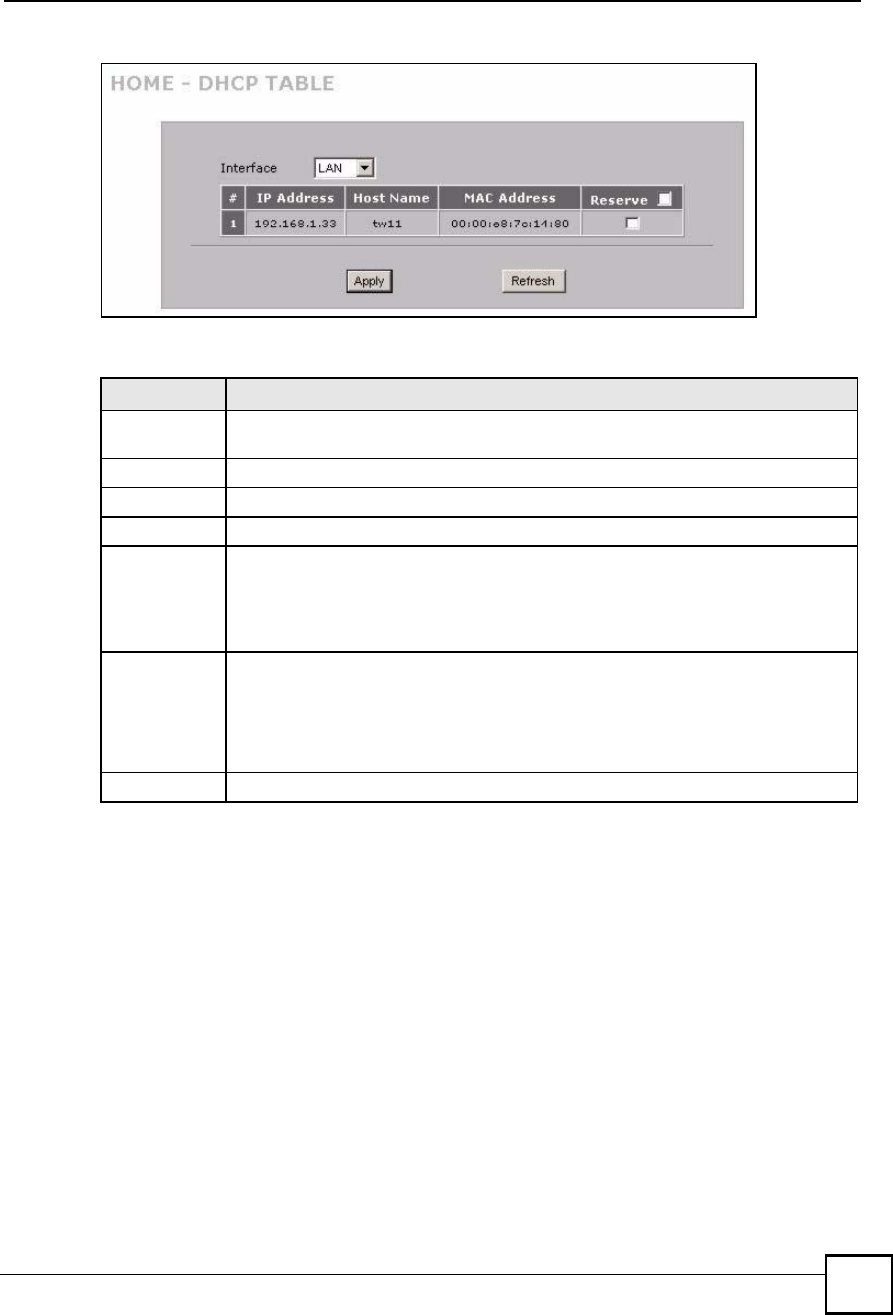
Chapter 2Introducing the Web Configurator
NBG410W3G Series User s Guide 57
Figure 12 HOME > DHCP Table
The following table describes the labels in this screen.
Table 8 HOME > DHCP Table
LABEL DESCRIPTION
InterfaceSelect LAN or DMZ to show the current DHCP client information for the specified
interface.
# This is the index number of the host computer.
IP AddressThis field displays the IP address relative to the # field listed above.
Host Name This field displays the computer host name.
MAC AddressThe MAC (Media Access Control) or Ethernet address on a LAN (Local Area
Network) is unique to your computer (six pairs of hexadecimal notation).
A network interface card such as an Ethernet adapter has a hardwired address that is
assigned at the factory. This address follows an industry standard that ensures no
other adapter has a similar address.
ReserveSelect the check box in the heading row to automatically select all check boxes or
select the check box(es) in each entry to have the ZyXEL Device always assign the
selected entry(ies) s IP address(es) to the corresponding MAC address(es) (and host
name(s)). You can select up to 128 entries in this table. After you click Apply, the
MAC address and IP address also display in the corresponding LAN or DMZ Static
DHCP screen (where you can edit them).
RefreshClick Refresh to reload the DHCP table.

Chapter 2Introducing the Web Configurator
NBG410W3G Series User s Guide
58
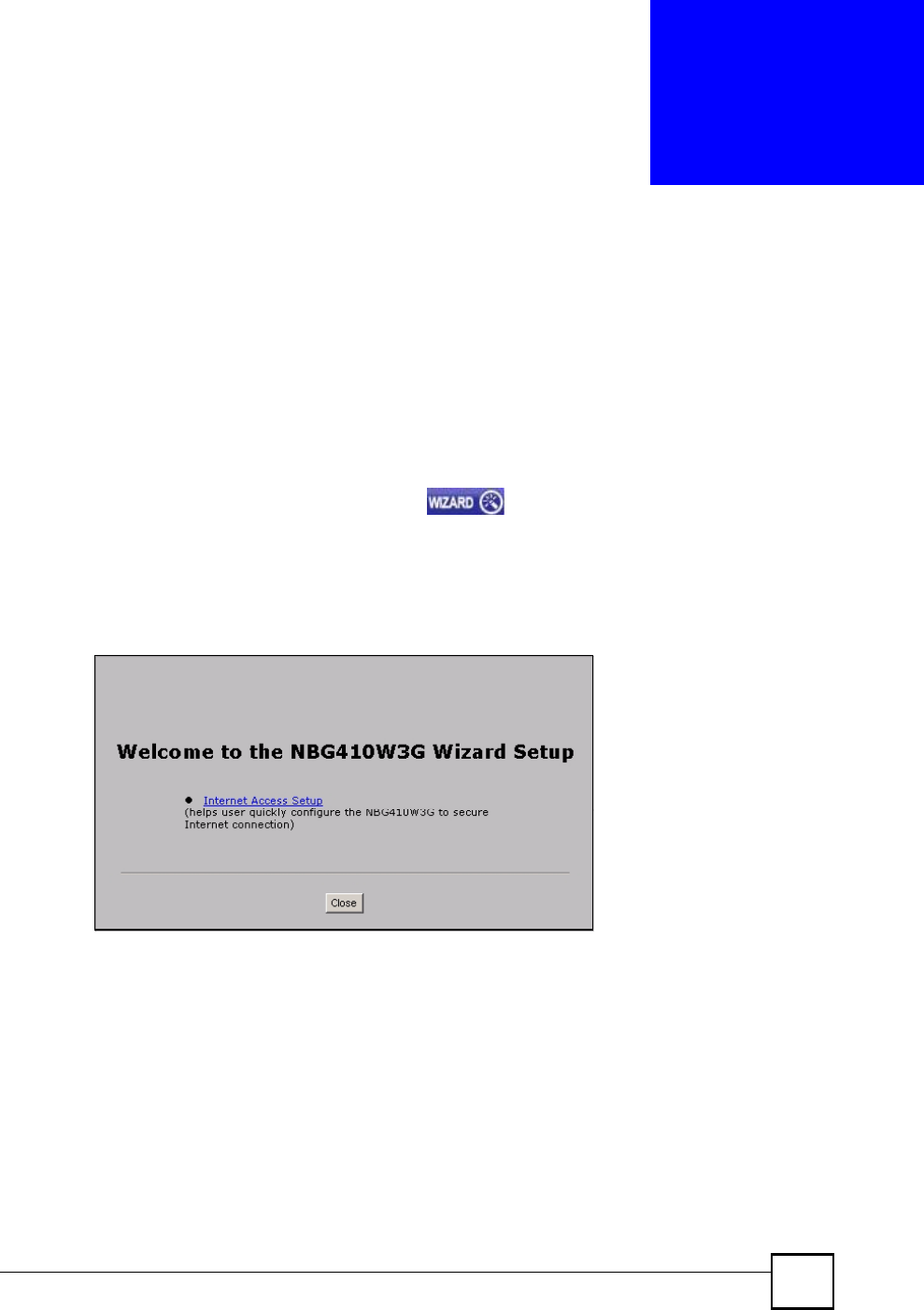
NBG410W3G Series User s Guide 59
CHAPTER 3
Wizard Setup
This chapter provides information on the Wizard Setup screens in the web configurator.
3.1 Wizard Setup Overview
The web configurator's setup wizards help you configure Internet connection settings.
In the HOME screen, click the wizard icon to open the Wizard Setup Welcome
screen. The following summarizes the wizards you can select:
Internet Access Setup
Click this link to open a wizard to set up an Internet connection for WAN 1 (the WAN
port) on the ZyXEL Device.
Figure 13 Wizard Setup Welcome
3.2 Internet Access
The Internet access wizard screen has three variations depending on what encapsulation type
you use. Refer to information provided by your ISP to know what to enter in each field. Leave
a field blank if you don!t have that information.
3.2.1 ISP Parameters
The ZyXEL Device offers three choices of encapsulation. They are Ethernet, PPTP or
PPPoE.
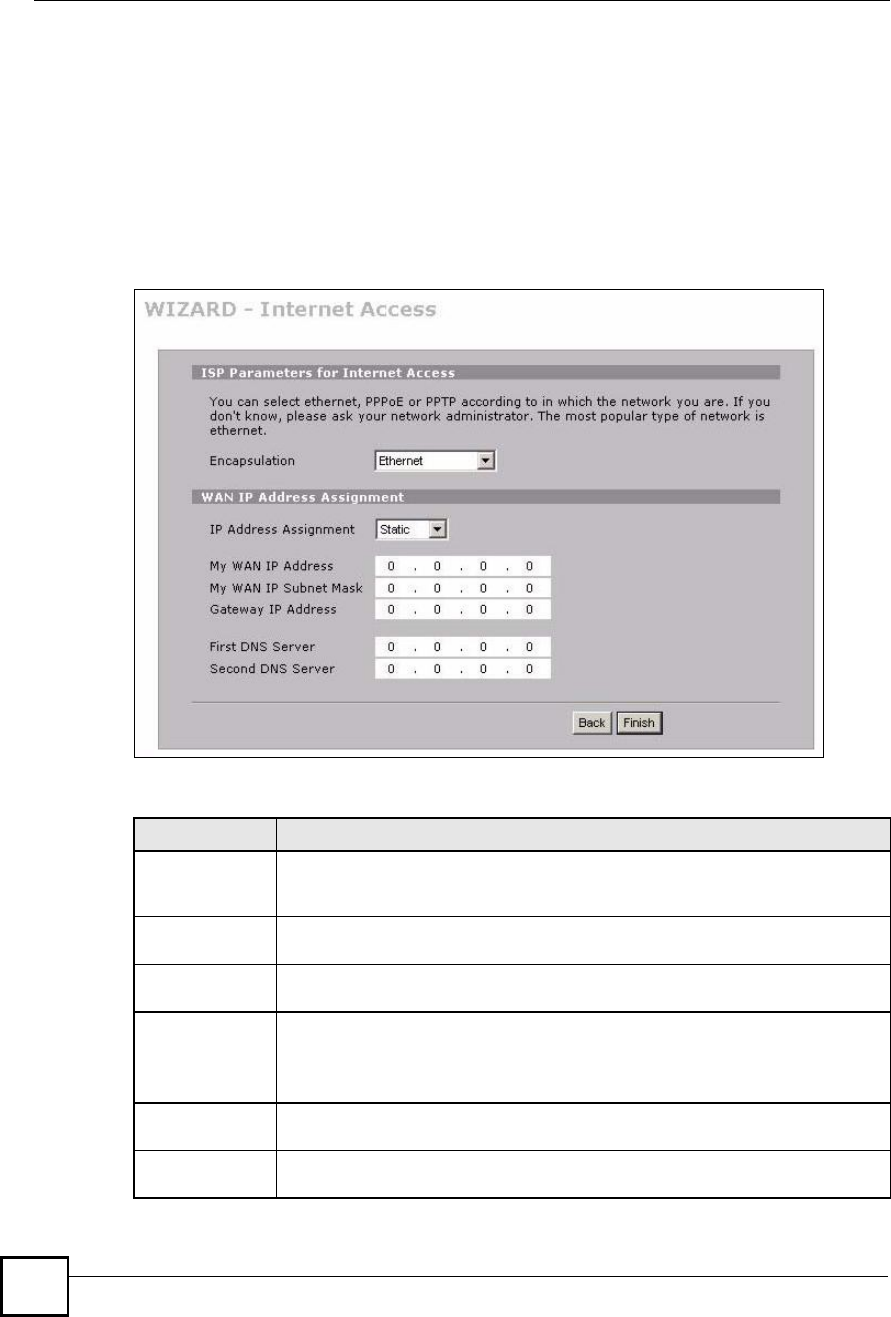
Chapter 3Wizard Setup
NBG410W3G Series User s Guide
60
The wizard screen varies according to the type of encapsulation that you select in the
Encapsulation field.
3.2.1.1 Ethernet
For ISPs (such as Telstra) that send UDP heartbeat packets to verify that the customer is still
online, please create a WAN-to-WAN/ZyXEL Device firewall rule for those packets. Contact
your ISP to find the correct port number.
Choose Ethernet when the WAN port is used as a regular Ethernet port.
Figure 14 ISP Parameters: Ethernet Encapsulation
The following table describes the labels in this screen.
Table 9 ISP Parameters: Ethernet Encapsulation
LABEL DESCRIPTION
ISP Parameters
for Internet
Access
EncapsulationYou must choose the Ethernet option when the WAN port is used as a regular
Ethernet. Otherwise, choose PPPoE or PPTP for a dial-up connection.
WAN IP Address
Assignment
IP Address
Assignment
Select Dynamic If your ISP did not assign you a fixed IP address. This is the
default selection.
Select Static If the ISP assigned a fixed IP address.
The fields below are available only when you select Static.
My WAN IP
Address
Enter your WAN IP address in this field.
My WAN IP
Subnet Mask
Enter the IP subnet mask in this field.
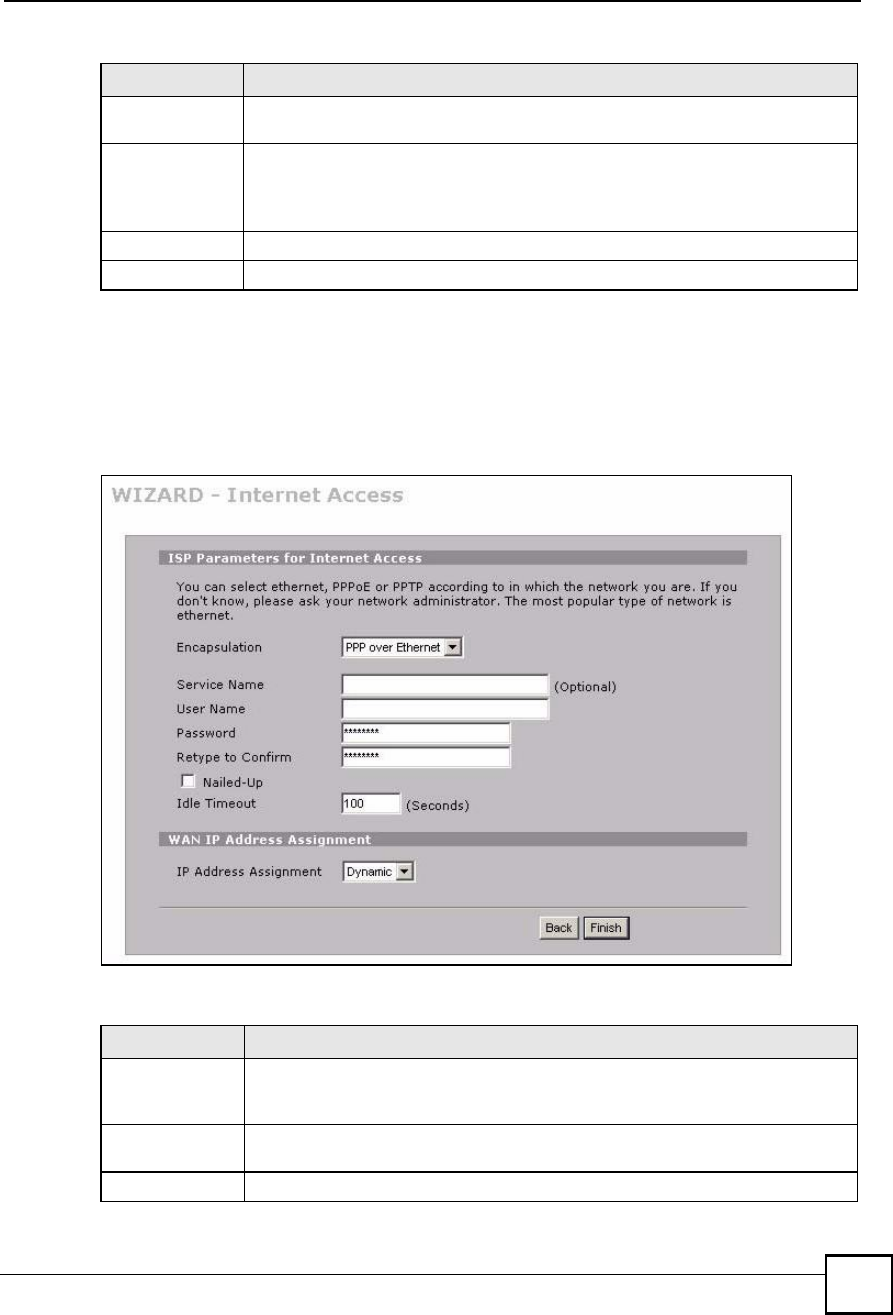
Chapter 3Wizard Setup
NBG410W3G Series User s Guide 61
3.2.1.2 PPPoE Encapsulation
Point-to-Point Protocol over Ethernet (PPPoE) functions as a dial-up connection. PPPoE is an
IETF (Internet Engineering Task Force) standard specifying how a host personal computer
interacts with a broadband modem (for example DSL, cable, wireless, etc.) to achieve access
to high-speed data networks.
Figure 15 ISP Parameters: PPPoE Encapsulation
The following table describes the labels in this screen.
Gateway IP
Address
Enter the gateway IP address in this field.
First DNS Server
Second DNS
Server
Enter the DNS server's IP address(es) in the field(s) to the right.
Leave the field as 0.0.0.0 if you do not want to configure DNS servers. If you do not
configure a DNS server, you must know the IP address of a machine in order to
access it.
BackClick Back to return to the previous wizard screen.
FinishClick Finish to save your changes and go to the next screen.
Table 9 ISP Parameters: Ethernet Encapsulation
LABEL DESCRIPTION
Table 10 ISP Parameters: PPPoE Encapsulation
LABEL DESCRIPTION
ISP Parameter
for Internet
Access
EncapsulationChoose an encapsulation method from the pull-down list box. PPP over Ethernet
forms a dial-up connection.
Service Name Type the name of your service provider.

Chapter 3Wizard Setup
NBG410W3G Series User s Guide
62
3.2.1.3 PPTP Encapsulation
Point-to-Point Tunneling Protocol (PPTP) is a network protocol that enables transfers of data
from a remote client to a private server, creating a Virtual Private Network (VPN) using TCP/
IP-based networks.
PPTP supports on-demand, multi-protocol, and virtual private networking over public
networks, such as the Internet.
The ZyXEL Device supports one PPTP server connection at any given time.
User NameType the user name given to you by your ISP.
Password Type the password associated with the user name above.
Retype to
Confirm
Type your password again for confirmation.
Nailed-Up Select Nailed-Up if you do not want the connection to time out.
Idle TimeoutType the time in seconds that elapses before the router automatically disconnects
from the PPPoE server. The default time is 100 seconds.
WAN IP Address
Assignment
IP Address
Assignment
Select Dynamic If your ISP did not assign you a fixed IP address. This is the
default selection.
Select Static If the ISP assigned a fixed IP address.
The fields below are available only when you select Static.
My WAN IP
Address
Enter your WAN IP address in this field.
First DNS Server
Second DNS
Server
Enter the DNS server's IP address(es) in the field(s) to the right.
Leave the field as 0.0.0.0 if you do not want to configure DNS servers. If you do not
configure a DNS server, you must know the IP address of a machine in order to
access it.
BackClick Back to return to the previous wizard screen.
FinishClick Finish to save your changes and go to the next screen.
Table 10 ISP Parameters: PPPoE Encapsulation (continued)
LABEL DESCRIPTION
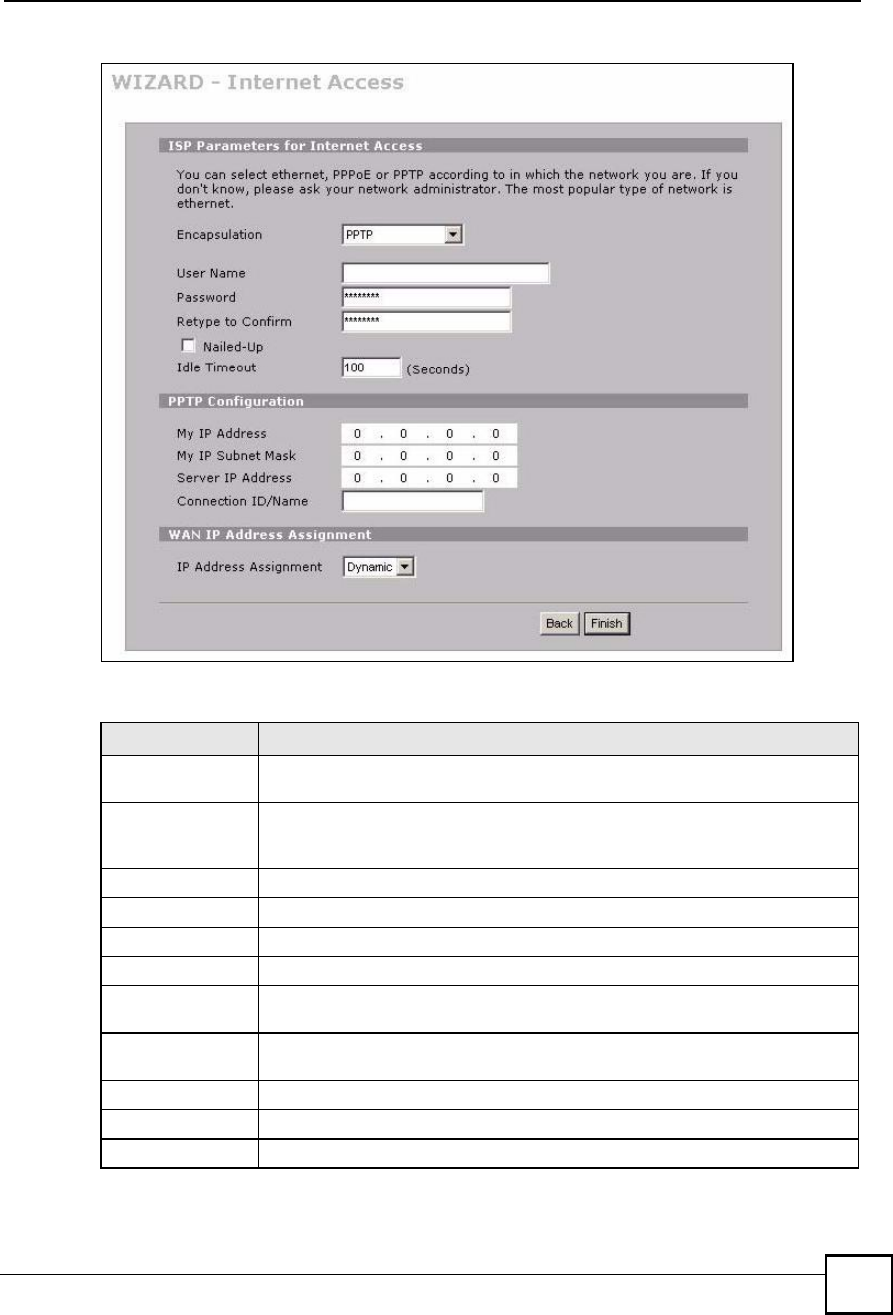
Chapter 3Wizard Setup
NBG410W3G Series User s Guide 63
Figure 16 ISP Parameters: PPTP Encapsulation
The following table describes the labels in this screen.
Table 11 ISP Parameters: PPTP Encapsulation
LABEL DESCRIPTION
ISP Parameters for
Internet Access
EncapsulationSelect PPTP from the drop-down list box. To configure a PPTP client, you must
configure the User Name and Password fields for a PPP connection and the
PPTP parameters for a PPTP connection.
User NameType the user name given to you by your ISP.
PasswordType the password associated with the User Name above.
Retype to ConfirmType your password again for confirmation.
Nailed-Up Select Nailed-Up if you do not want the connection to time out.
Idle TimeoutType the time in seconds that elapses before the router automatically
disconnects from the PPTP server.
PPTP
Configuration
My IP AddressType the (static) IP address assigned to you by your ISP.
My IP Subnet MaskType the subnet mask assigned to you by your ISP (if given).
Server IP AddressType the IP address of the PPTP server.
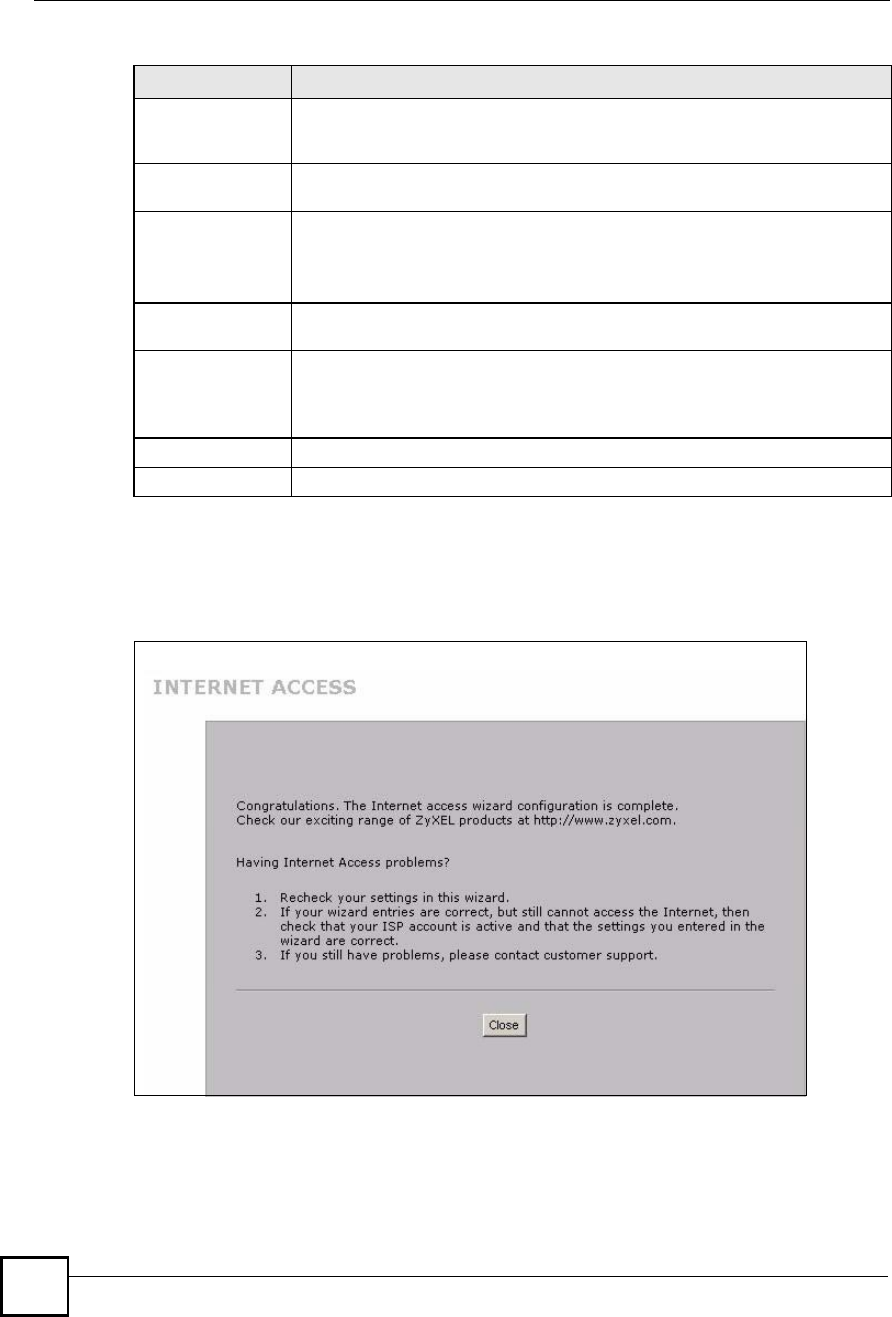
Chapter 3Wizard Setup
NBG410W3G Series User s Guide
64
3.2.2 Internet Access Wizard Setup Complete
The congratulations screen displays. Click Close to complete the Internet access setup.
Figure 17 Internet Access Setup Complete
Connection ID/
Name
Enter the connection ID or connection name in this field. It must follow the "c:id"
and "n:name" format. For example, C:12 or N:My ISP.
This field is optional and depends on the requirements of your xDSL modem.
WAN IP Address
Assignment
IP Address
Assignment
Select Dynamic If your ISP did not assign you a fixed IP address. This is the
default selection.
Select Static If the ISP assigned a fixed IP address.
The fields below are available only when you select Static.
My WAN IP
Address
Enter your WAN IP address in this field.
First DNS Server
Second DNS
Server
Enter the DNS server's IP address(es) in the field(s) to the right.
Leave the field as 0.0.0.0 if you do not want to configure DNS servers. If you do
not configure a DNS server, you must know the IP address of a machine in order
to access it.
BackClick Back to return to the previous wizard screen.
FinishClick Finish to save your changes and go to the next screen.
Table 11 ISP Parameters: PPTP Encapsulation
LABEL DESCRIPTION
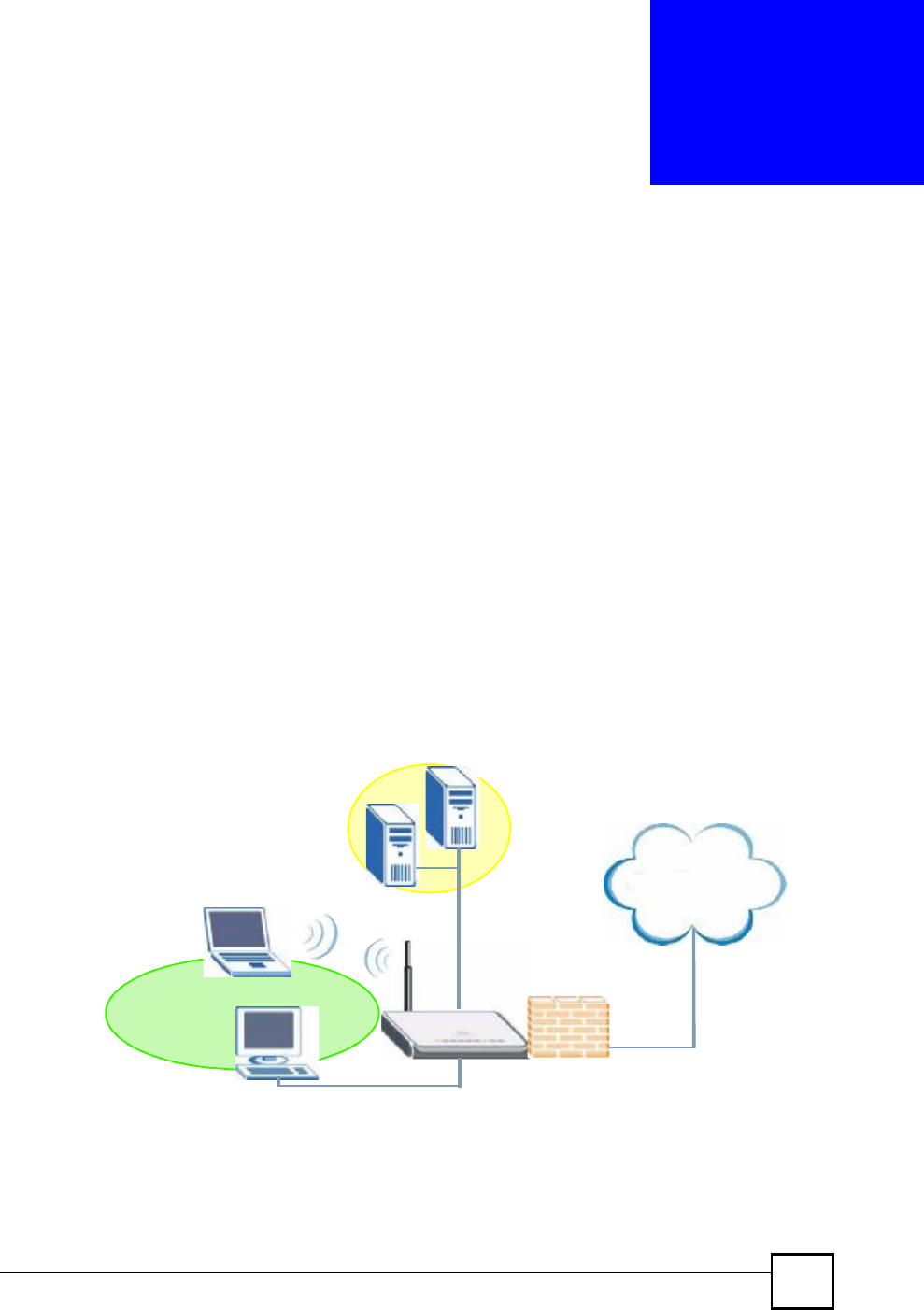
NBG410W3G Series User s Guide 65
CHAPTER 4
Tutorials
This section describes how to do the following.
1Set up a DMZ (De-Militarized Zone).
2Use an H.323 VoIP phone on your LAN.
3Use NAT (Network Address Translation) with multiple public IP addresses.
4Allow multiple game players to connect to the same server.
4.1 DMZ Overview
The DMZ is a separate network for devices that provide services to users on the Internet.
Devices such as a web or e-mail server are more prone to security threats as they are more
visible from the Internet and more frequently accessed than devices on your LAN. By placing
such devices on a DMZ, you can better restrict access to the devices on your LAN.
The diagram shows servers on the DMZ which are open to public access but protected by the
ZyXEL Device!s firewall. Devices which require greater security are located on the LAN.
Figure 18 DMZ Overview
In this situation a file server is located in the DMZ. The file server is available for public
access from the Internet and also from computers located on the LAN.
You can use either public or private IP addresses for your DMZ, however the DMZ must be on
a different subnet or network from the LAN.
Internet
DMZ
LAN
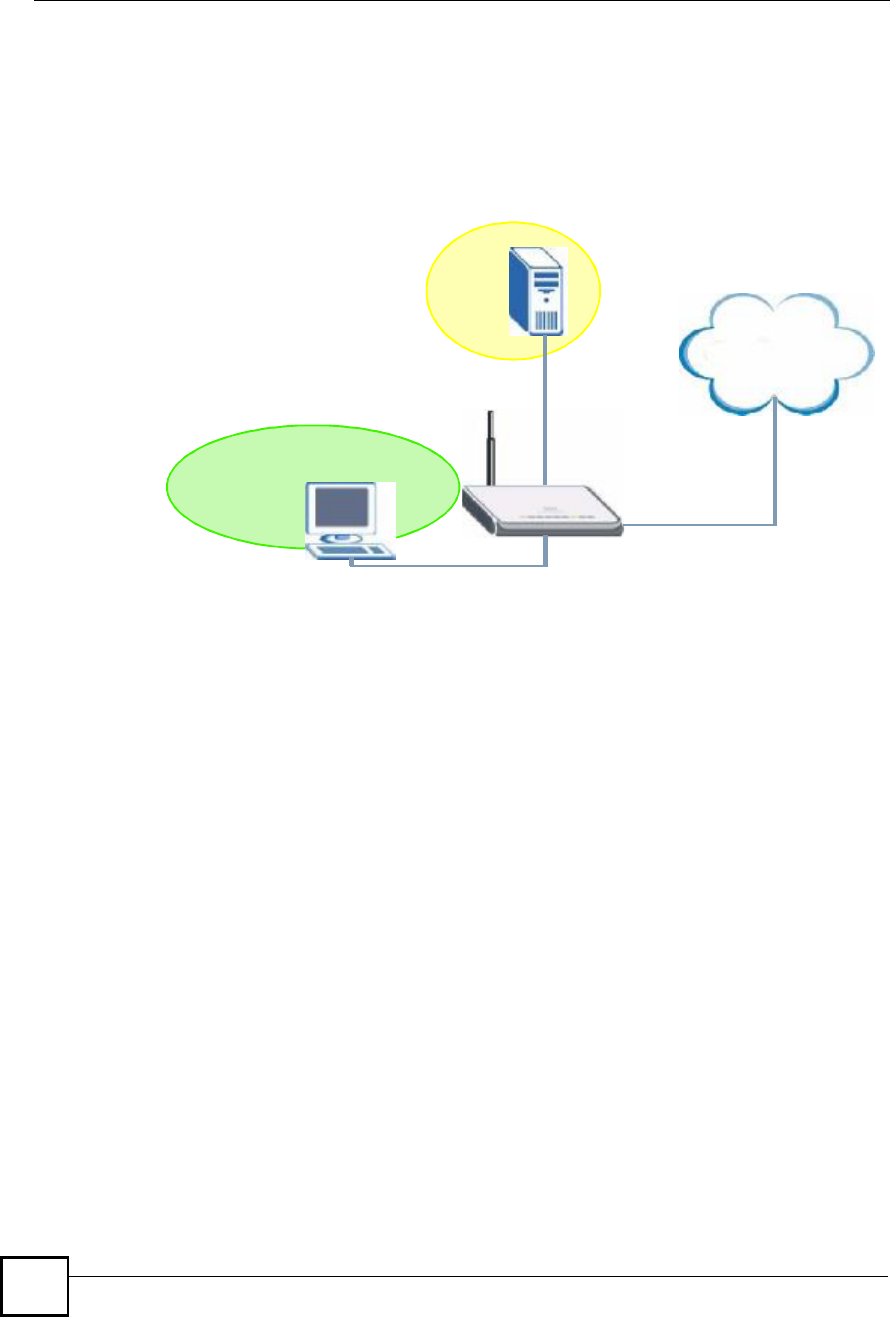
Chapter 4Tutorials
NBG410W3G Series User s Guide
66
4.2 DMZ Setup Example
In this example the DMZ uses private IP addresses and the default subnet mask of
255.255.255.0. (See Appendix C on page 377 for information on subnetting.) You can also use
a static public IP address for your file server.
Figure 19 DMZ Tutorial: DMZ Setup
4.2.1 Basic Setup
Follow these steps to set up your DMZ with a private or a public IP address.
4.2.1.1 Private IP Address
1Click NETWORK > DMZ to open the DMZ screen. In the DMZ TCP/IP field type
your DMZ IP address in the IP address field. In the IP Subnet Mask field type the same
subnet mask as that used on the LAN.
2Select Server from the drop-down list in the DHCP field to have the ZyXEL Device
dynamically assign IP addresses to devices on the DMZ. In the IP Pool Starting
Address field type the first available IP address for the DMZ subnetwork. In this
example 192.168.2.33 is used. Skip to Section 4.2.1.3 on page 67.
4.2.1.2 Public IP Address
Either configure a static IP address on the server directly using the server!s operating system,
or follow these steps to set up static DHCP on the ZyXEL Device.
1Click NETWORK > DMZ > Static DHCP to open the Static DHCP screen.
2Type the MAC address of the file server in the MAC Address field and a valid IP
address on your DMZ in the IP Address field. In this example the MAC address is
00:A0:C5:00:00:02 and the IP address is 192.168.2.33.
3Click Apply. That completes setup of static DHCP on the ZyXEL Device.
Internet
File server
WAN1: 123.11.11.11
DMZ
LAN
192.168.2.33
192.168.2.0
192.168.1.0
192.168.1.33
Host
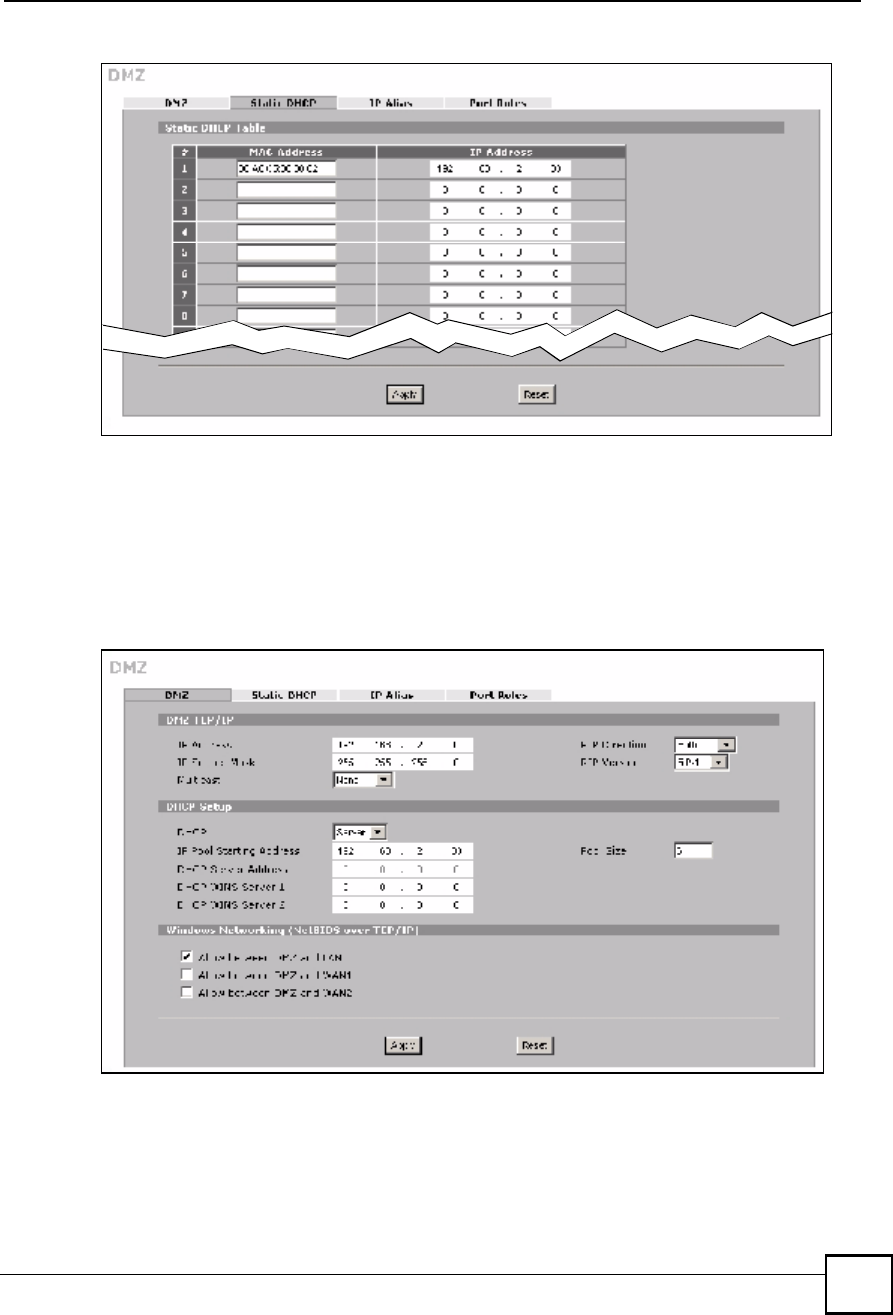
Chapter 4Tutorials
NBG410W3G Series User s Guide 67
Figure 20 DMZ Tutorial: NETWORK > DMZ > Static DHCP
4.2.1.3 Public and Private IP Addresses
1In Windows Networking (NetBIOS over TCP/IP) select Allow between DMZ and
LAN. In this example, both the file server on the DMZ and a computer on the LAN use a
Windows OS. Enable NetBIOS to allow LAN computers to use Windows programs such
as Windows Explorer to access the server on the DMZ.
2Click Apply.
Figure 21 DMZ Tutorial: NETWORK > DMZ
3Ensure NAT (Network Address Translation) is enabled on your WAN to allow the
ZyXEL Device to manage the IP addresses of traffic it routes between networks. Click
ADVANCED > NAT. For your WAN connection select . In this example NAT is enabled
in the Enable NAT field on WAN1 and SUA is selected. For more information on this
screen see Chapter 12 on page 225.
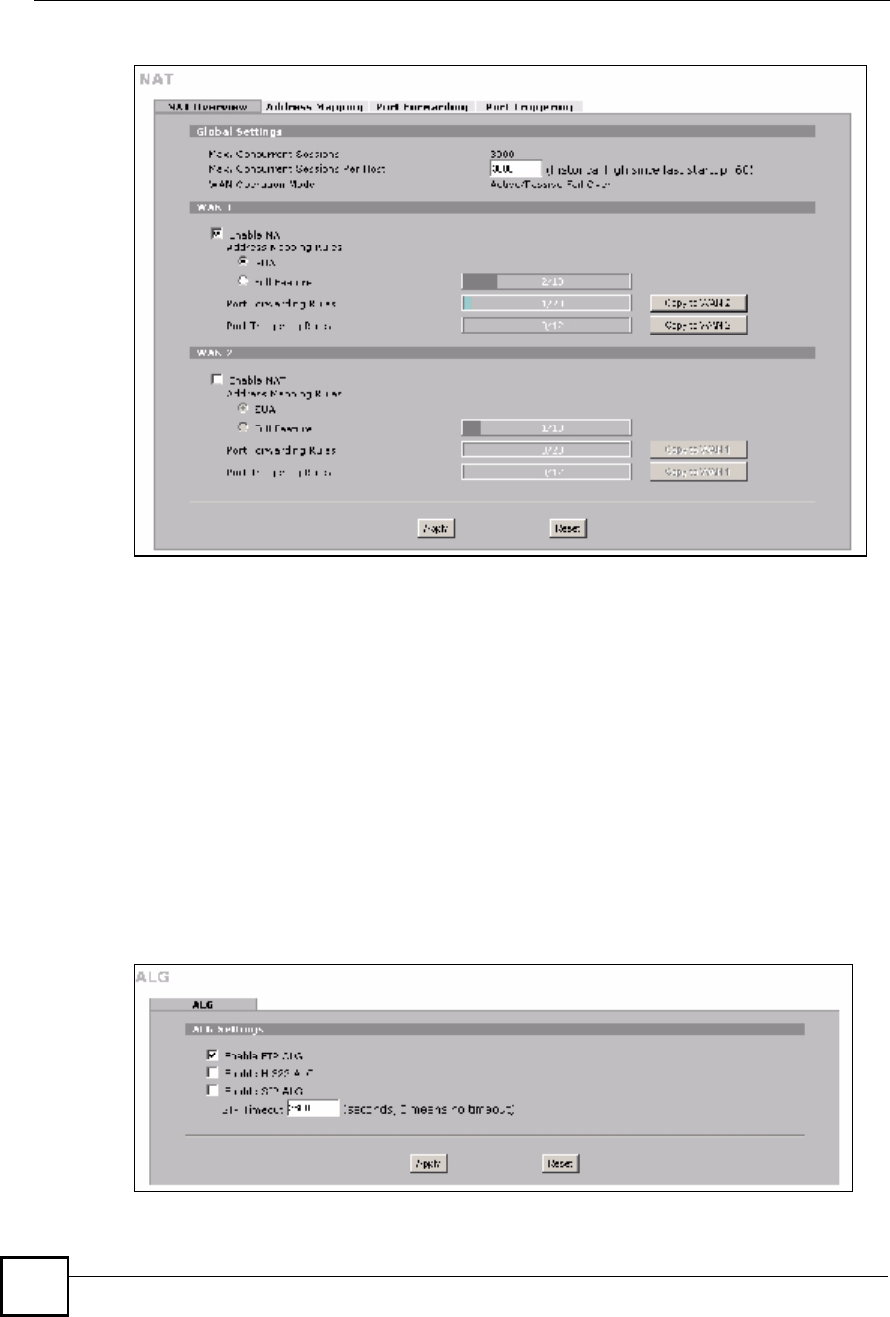
Chapter 4Tutorials
NBG410W3G Series User s Guide
68
Figure 22 DMZ Tutorial: ADVANCED > NAT Overview
This completes basic setup of your DMZ.
4.2.2 Advanced Setup
In this scenario the file server runs an FTP (File Transfer Protocol) download service. Since
FTP is not compatible with NAT, you can use the ALG (Application Layer Gateway) to
manage FTP. (See Chapter 18 on page 293 for more information.)
To allow FTP sessions to be initiated by users on the WAN, port-forwarding is also required
(see Section 12.5 on page 235 for more information) and for port-forwarding the file server
needs a static IP address.
ALG Setup
To turn on the ZyXEL Device!s FTP ALG, click ADVANCED > ALG. Select Enable FTP
ALG and click Apply.
Figure 23 DMZ Tutorial: ADVANCED > ALG
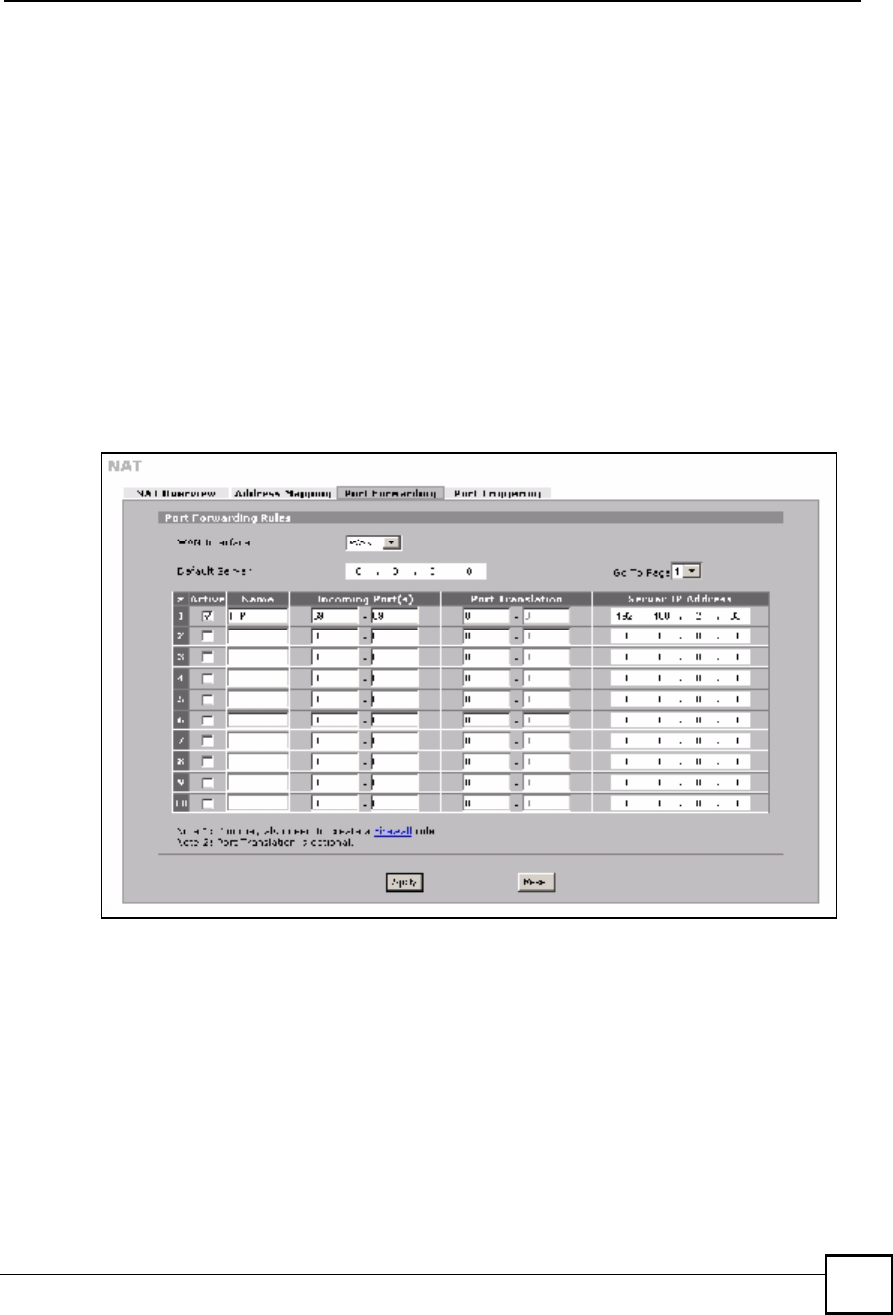
Chapter 4Tutorials
NBG410W3G Series User s Guide 69
Port Forwarding Setup
1To configure port forwarding, first configure a static IP on the file server if you haven!t
already. See Section 4.2.1.2 on page 66.
2Click ADVANCED > NAT > Port Forwarding to open the Port Forwarding screen.
3In the WAN Interface field select the correct WAN for your network. This example uses
WAN1.
4In the rule row you are configuring select Active.
5In the Name field type a descriptive name for the port forwarding rule. This example
uses FTP.
6In the Incoming Port(s) field type the port number used by the FTP application. This
example uses 69.
7In the Server IP Address field type the IP address of your file server. This example uses
192.168.1.33.
8Click Apply.
Figure 24 DMZ Tutorial: ADVANCED > NAT > Port Forwarding
This completes setup of NAT-incompatible services on the server in your DMZ. Now users
can access the file server on your DMZ from the Internet.
4.3 Firewall Rule Setup
Your ZyXEL Device!s firewall default settings provide network security by allowing traffic
from the WAN to your DMZ, and blocking traffic from the DMZ to the LAN. However, you
can further enhance network security by defining firewall rules specifically for traffic from the
WAN to the DMZ.
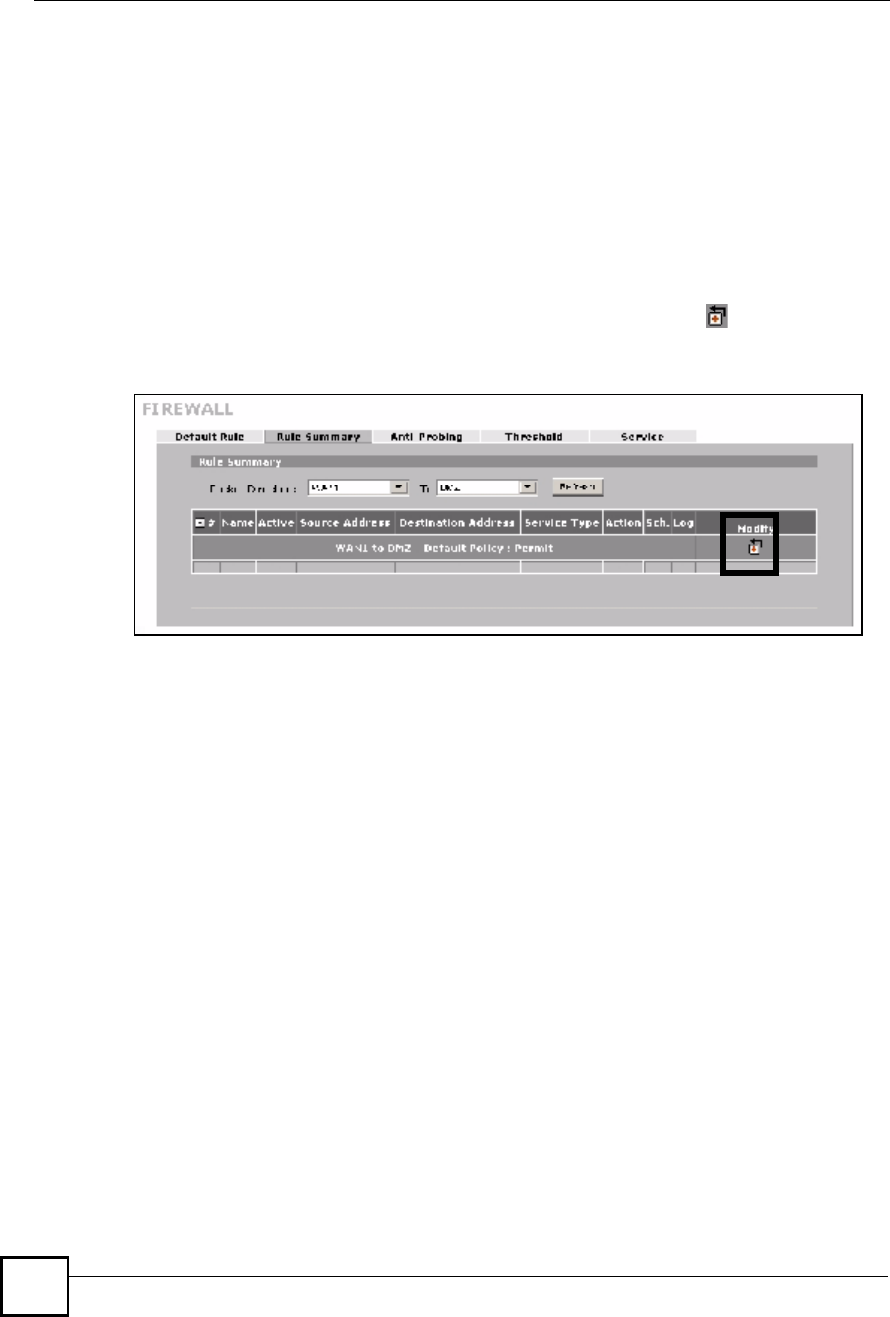
Chapter 4Tutorials
NBG410W3G Series User s Guide
70
You need to define two rules - one to drop all traffic from the WAN to the DMZ, the other to
permit HTTP and FTP traffic from the WAN to the DMZ. This ensures that only HTTP and
FTP traffic from the WAN to the DMZ is permitted and all other traffic is blocked.
If you have not already done so, define a static IP address for the file server (see step 1 on
page69 for instructions).
1Click SECURITY > Firewall > Rule Summary to display the Rule Summary screen.
Use this screen to configure firewall rules on traffic between the file server and the
WAN. In this example, traffic from WAN1 to the the file server is restricted to HTTP and
FTP traffic.
2The Rule Summary screen appears. Select WAN1 and DMZ from the drop-down list in
the Packet Direction field and click Refresh. Click the Modify () icon to add a new
rule.
Figure 25 DMZ Tutorial: SECURITY > Firewall > Rule Summary
3The Firewall - Edit screen appears. Type the name of the firewall rule in the Rule Name
field. In this example WAN12DMZ - DENY is used.
4In the Edit Source Address section select Any Address in the drop-down box in the
Address Type field to define the source address of traffic from the Internet as any IP
address.
5In the Edit Destination Address section select Single Address in the drop-down box in
the Address Type field. Type the destination address of traffic in the Start IP Address
field. In this case the WAN1 IP address is used - 123.23.23.23. If you are using a public
static IP address for your web server, type the server!s IP address in this field.
6Click Add so that the IP address appears in the Destination Address(es) field.
7In the Edit Service section of the Firewall - Edit screen select Any so that they appear
in the Selected Service(s) field.
8In the Action for Matched Packets field select Drop from the drop-down box.
9In the Edit Service section select FTP and click the arrow icon. Then select HTTP and
click the arrow icon again so that FTP and HTTP appear in the Selected Service(s)
field.
10 Click Apply.
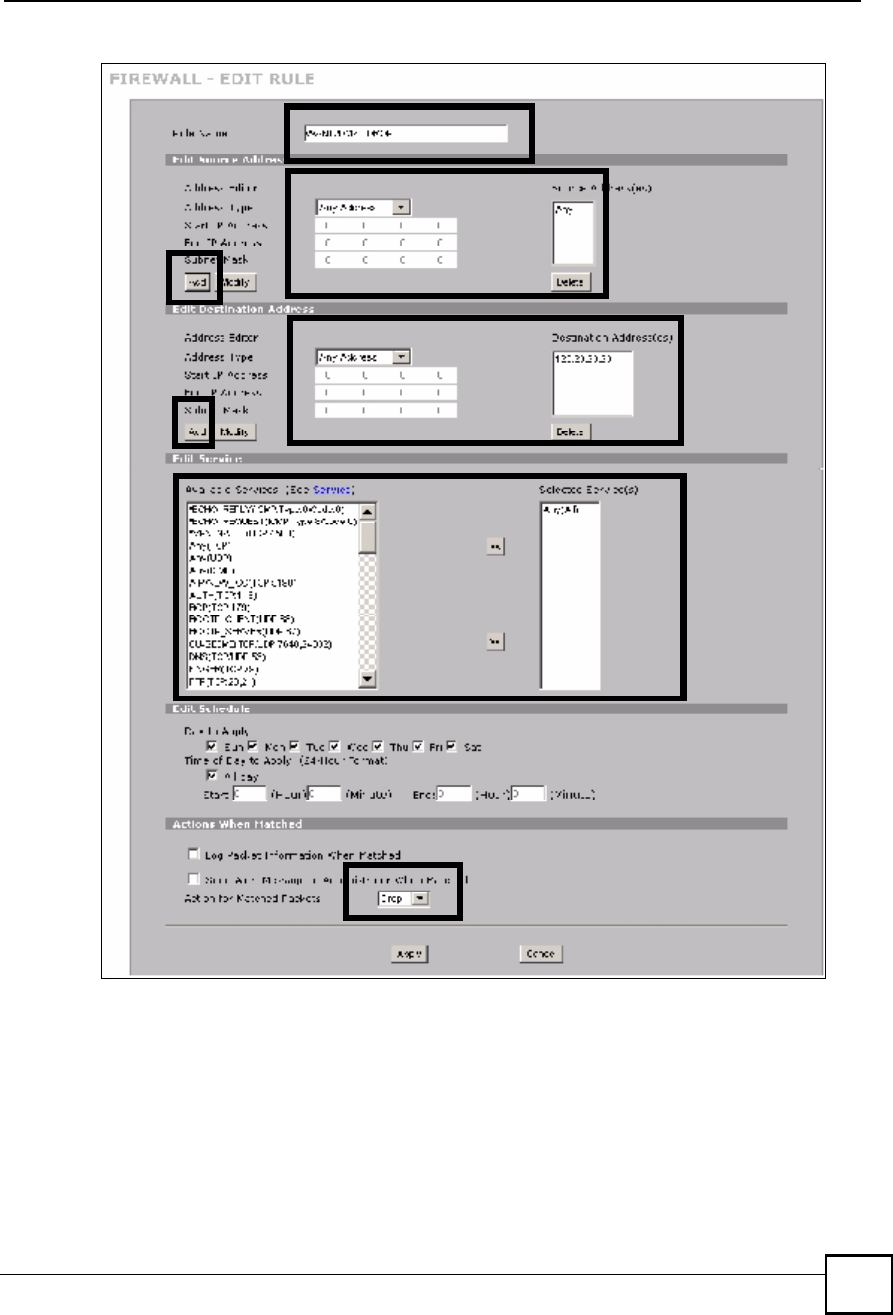
Chapter 4Tutorials
NBG410W3G Series User s Guide 71
Figure 26 DMZ Tutorial: NETWORK > Firewall > Rule Summary: Firewall - Edit
11 Repeat the firewall rule setup procedure to set up a rule for WAN1 to DMZ traffic with
the same source and destination addresses. In the Edit Service section of the Firewall -
Edit screen select HTTP and FTP so that they appear in the Selected Service(s) field.
12 In the Action for Matched Packets field select Permit from the drop-down list and
click Apply.
13 In the Rule Summary screen select Any and Any from the drop-down list in the Packet
Direction fields and click Refresh to check your firewall rule settings.
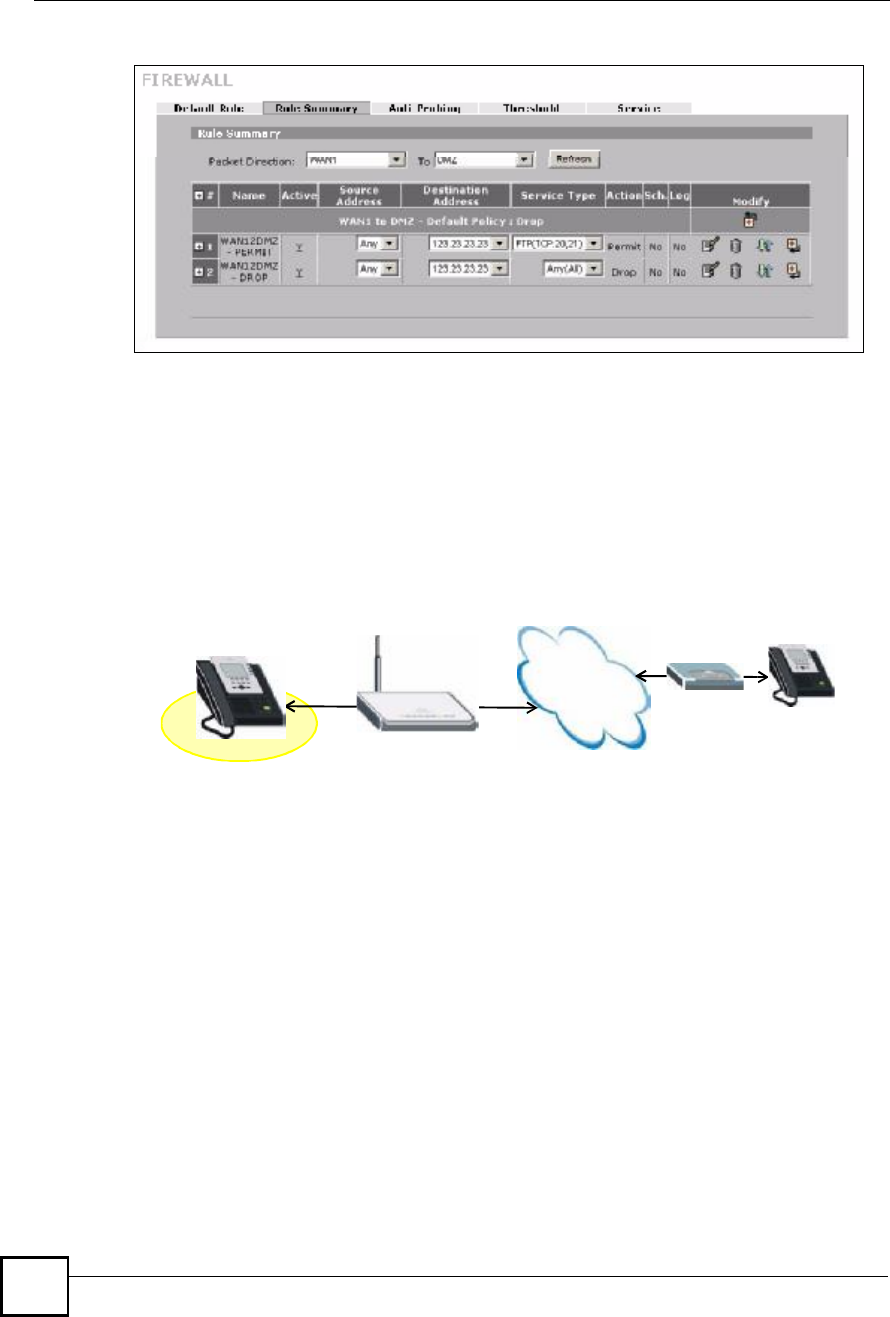
Chapter 4Tutorials
NBG410W3G Series User s Guide
72
Figure 27 DMZ Tutorial: SECURITY > Firewall > Rule Summary Example
This completes setup of a firewall rules for the file server on your DMZ.
4.4 Setting Up a VoIP Phone with H.323
You can use the ZyXEL Device to manage calls from your VoIP enabled phone using H.323.
The following diagram shows an example of a VoIP phone configured to make calls over the
Internet.
Figure 28 Tutorial: H.323 Phone Setup
To configure your ZyXEL Device to allow VoIP phone calls using your H.323 phone, you
need to set up the H.323 ALG (Application Layer Gateway) and port forwarding, which in
turn requires a fixed IP address for your phone.
IP Address Settings
Follow these steps to give your phone a fixed IP address.
1Click NETWORK > LAN > Static DHCP to open the Static DHCP screen.
2Type the MAC address of your device in the MAC Address field and a valid IP address
on your LAN in the IP Address field. In this example the MAC address is
00:A0:C5:00:00:02 and the IP address is 192.168.1.33.
3Click Apply.
Internet
LAN: WAN:
192.168.1.33123.23.23.23
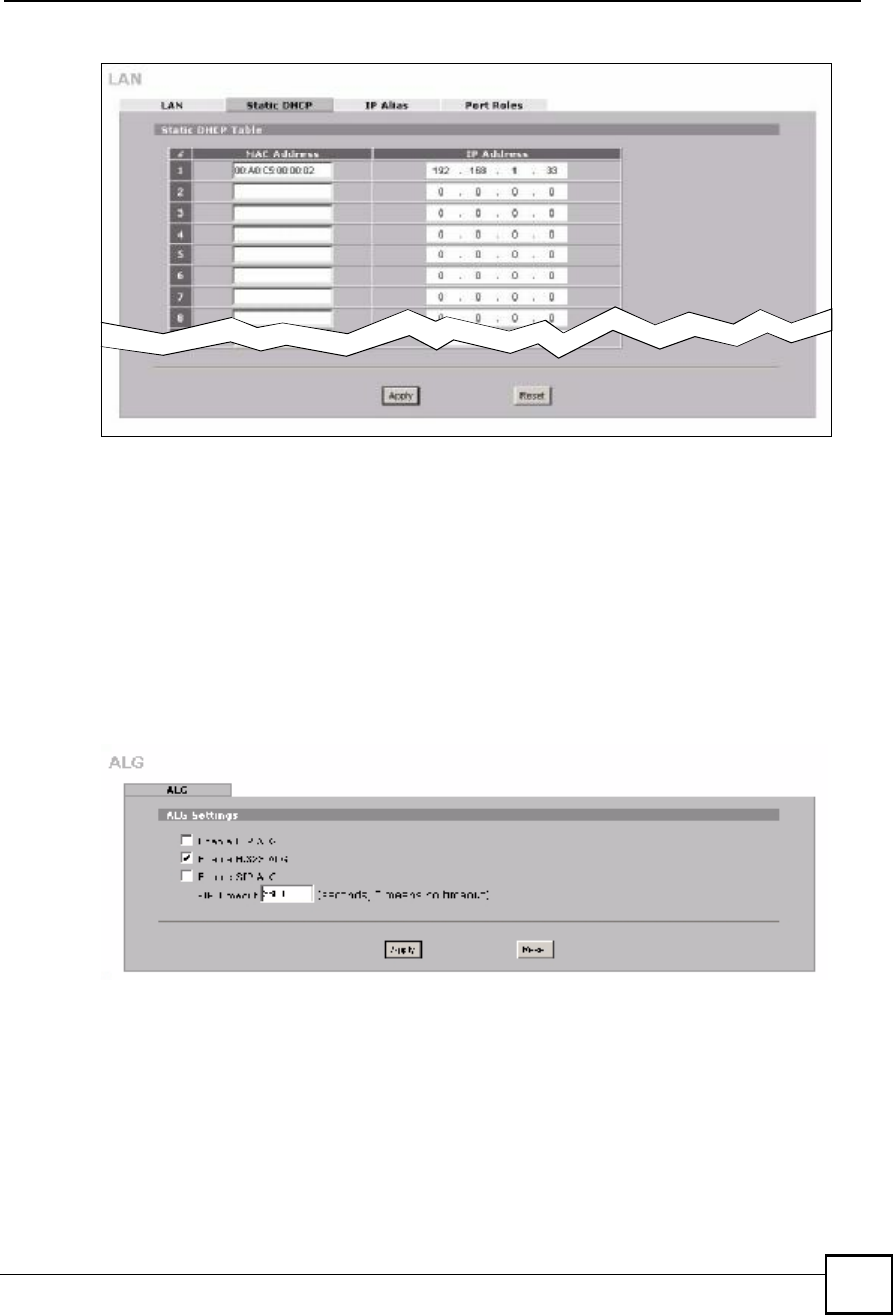
Chapter 4Tutorials
NBG410W3G Series User s Guide 73
Figure 29 H.323 Tutorial: NETWORK > LAN > Static DHCP
4Click NETWORK > LAN to display the LAN screen. Ensure that Server is selected in
the drop-down box in the DHCP field.
Set up ALG
Follow these steps to set up ALG (Application Layer Gateway) to let your ZyXEL Device
manage H.323 traffic. (For more information on ALG see Chapter 18 on page 293.)
1Click ADVANCED > ALG to display the ALG screen. Select Enable H.323 ALG and
click Apply. This configures ALG (Application Layer Gateway) to manage H.323 traffic
through your ZyXEL Device.
2Click Apply.
Figure 30 H.323 Tutorial: ADVANCED > ALG
Set up Port Forwarding
1Click ADVANCED > NAT > Port Forwarding to display the Port Forwarding screen.
2Select the correct WAN for your network in the WAN Interface field.
3Select Active in the rule row you are configuring.
4Type a descriptive name for the port forwarding rule in the Name field. In this example
H.323 is used.
5Type 1720 in the Incoming Port(s) field. This port number is used for the H.323
services.
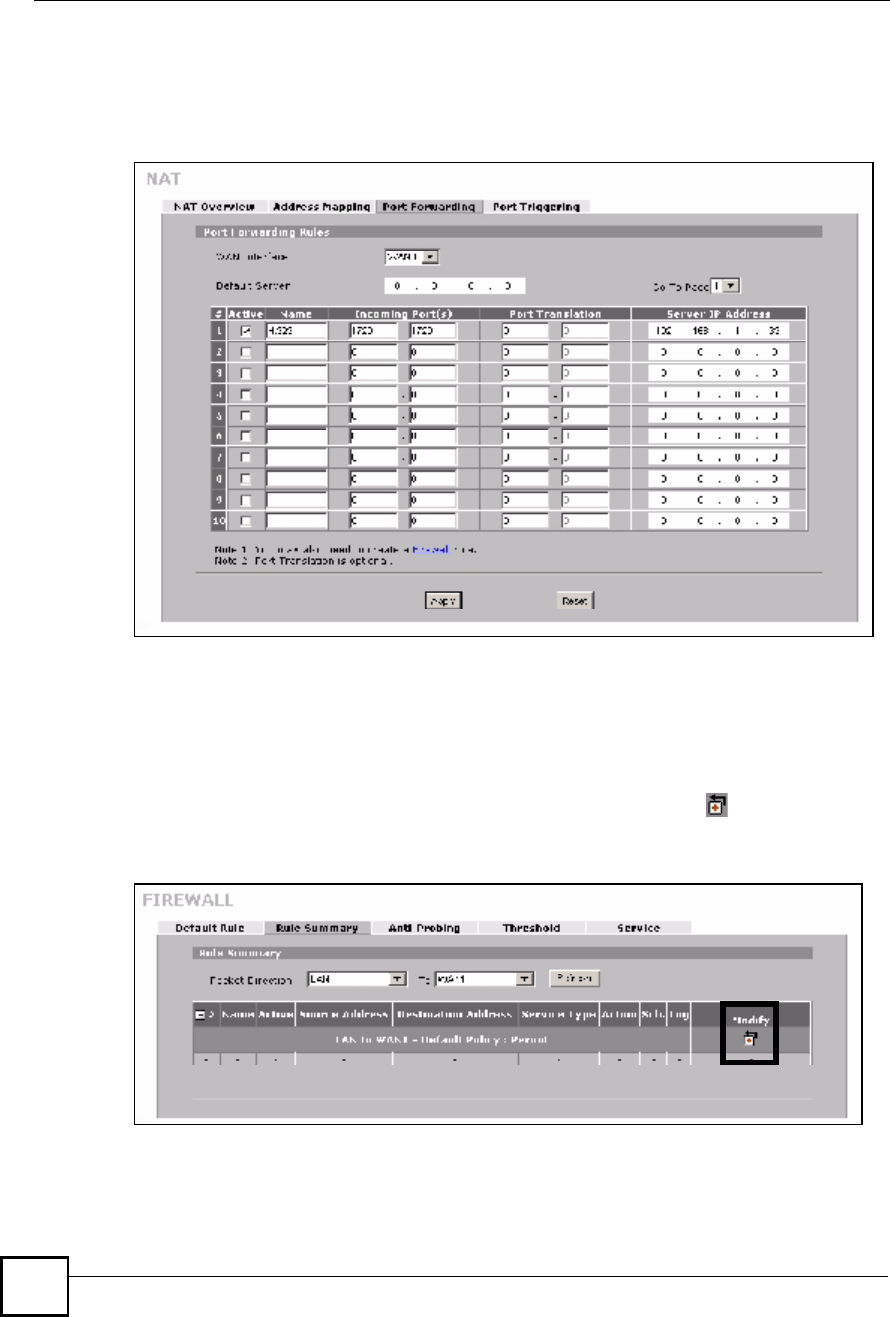
Chapter 4Tutorials
NBG410W3G Series User s Guide
74
6Type the IP address of your VoIP phone in the Server IP Address field. In this example
192.168.1.33 is used.
7Click Apply.
Figure 31 H.323 Tutorial: ADVANCED > NAT > Port Forwarding
Set up a Firewall Rule
1Click SECURITY > Firewall > Rule Summary to display the Rule Summary screen
and to configure firewall rules on traffic between the VoIP phone and the WAN. In this
example, traffic between the file server and WAN1 is restricted to H.323 traffic.
2The Rule Summary screen appears. Select DMZ and WAN1 from the drop-down list in
the Packet Direction field and click Refresh. Click the Modify () icon to add a new
rule.
Figure 32 H.323 Tutorial: SECURITY > Firewall > Rule Summary
3The Firewall - Edit screen appears. Type the name of the firewall rule in the Rule Name
field. In this example LAN2WAN1 - H.323 is used.
4In the Edit Source Address section select Single Address in the drop-down box in the
Address Type field. Type the source address of H.323 traffic in the Start IP Address

Chapter 4Tutorials
NBG410W3G Series User s Guide 75
field - 123.23.23.23 and click Add so that the IP address appears in the Destination
Address(es) field. If you are using a H.323 server, use its IP address instead.
5In the Edit Destination Address section select Single Address in the drop-down box in
the Address Type field. Type the destination address of H.323 traffic in the Start IP
Address field - 192.168.1.33 and click Add so that the IP address appears in the Source
Address(es) field.
6In the Edit Service section select H.323 and click the arrow icon so that H.323 appears
in the Selected Service(s) field.
7Click Apply.
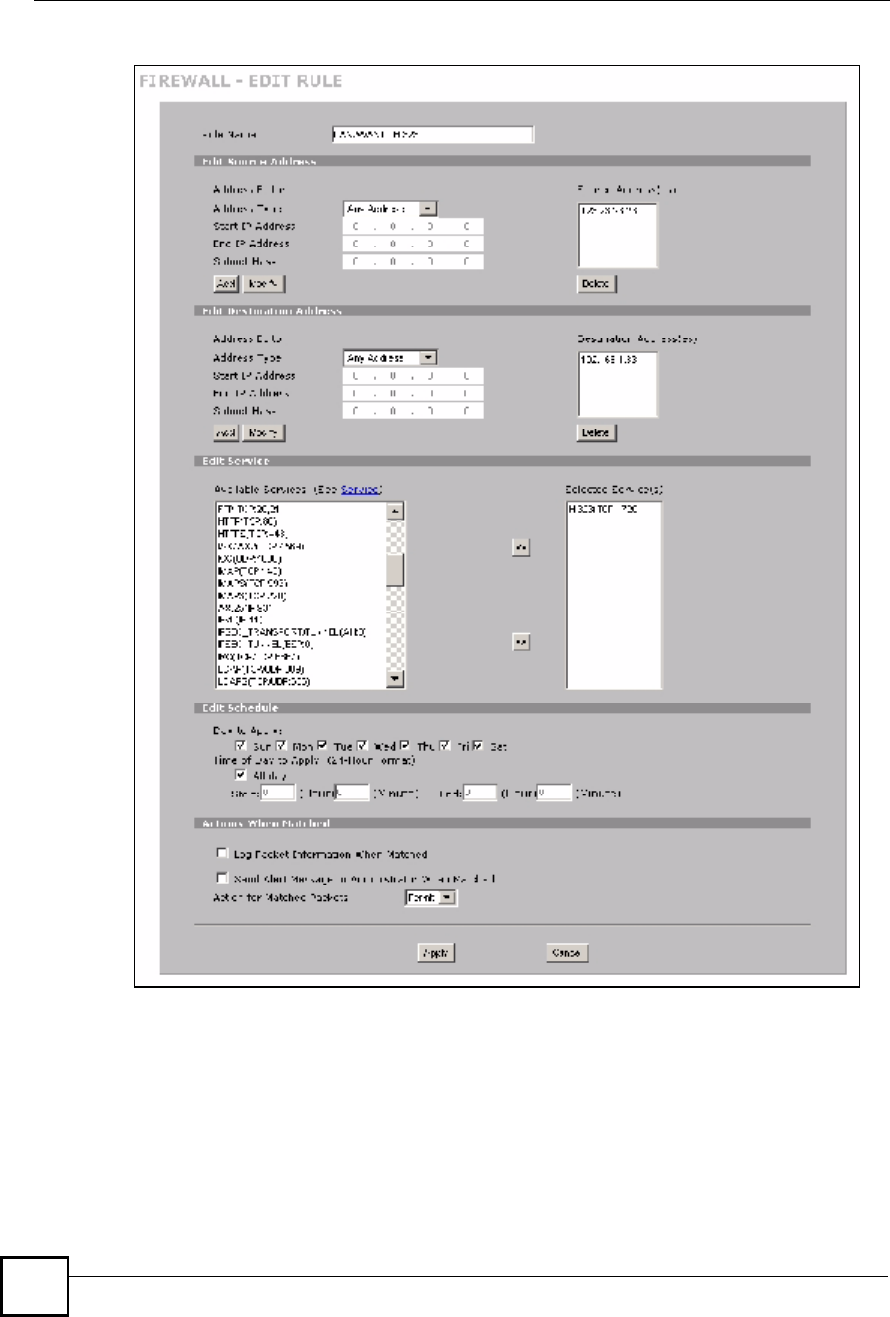
Chapter 4Tutorials
NBG410W3G Series User s Guide
76
Figure 33 H.323 Tutorial: SECURITY > Firewall > Rule Summary
8Repeat the firewall rule setup procedure to add a similar firewall rule for H.323 traffic
from the WAN to the LAN, using the same WAN IP address and LAN IP address
settings.
9In the Rule Summary screen select Any and Any from the drop-down list in the Packet
Direction fields and click Refresh to check your firewall rule settings.
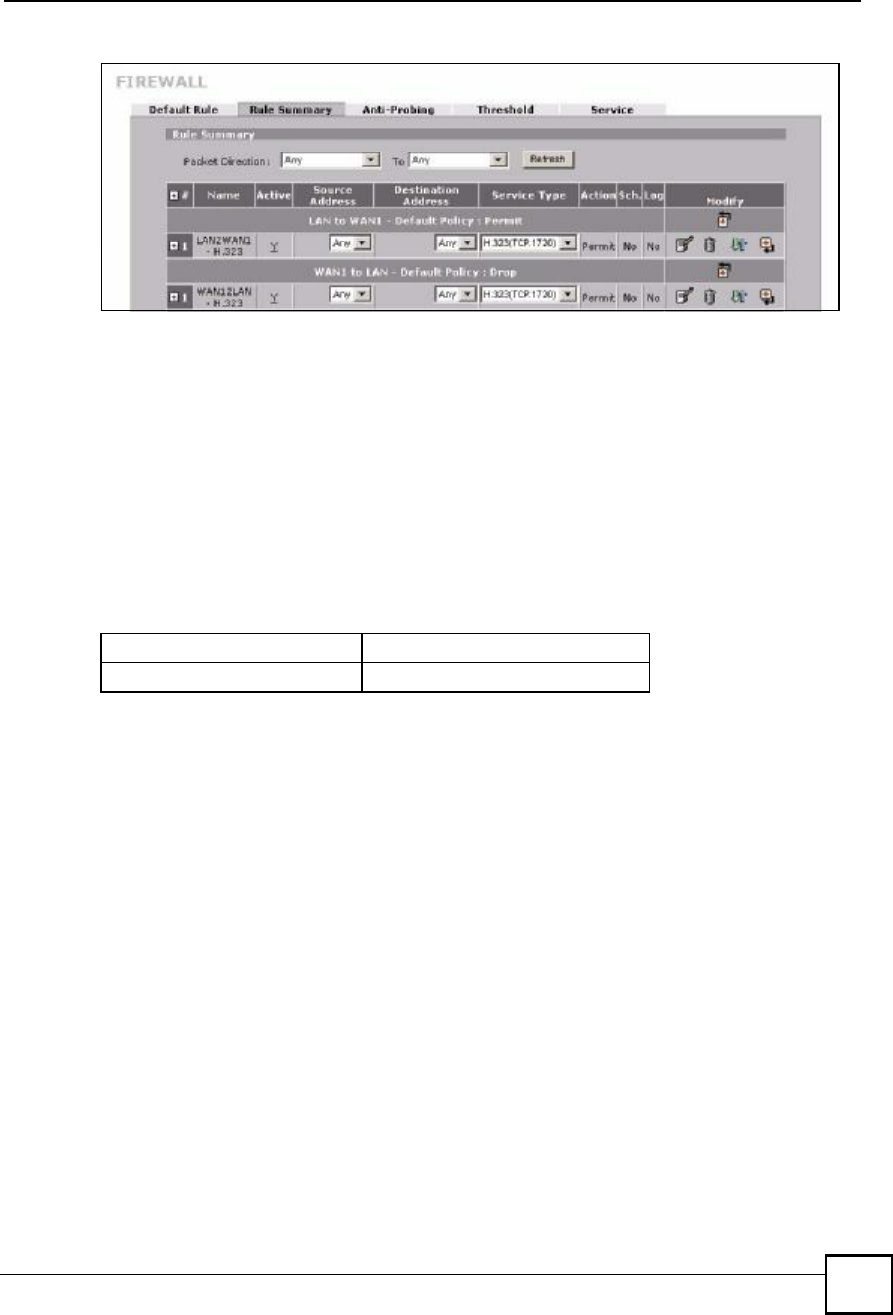
Chapter 4Tutorials
NBG410W3G Series User s Guide 77
Figure 34 H.323 Tutorial: SECURITY > Firewall > Rule Summary
That completes setup of your H.323 VoIP phone.
4.5 Using NAT with Multiple Public IP Addresses
This section shows you examples of how to set up your ZyXEL Device if you have more than
one fixed (static) IP address from your ISP.
4.5.1 Example Parameters and Scenario
The following table shows the public IP addresses from your ISP and your ZyXEL Device!s
LAN IP address.
The following figure shows the network you want to set up in this example.
Assign the first public address (1.2.3.4) to the ZyXEL Device!s WAN 1 port.
Map the second and third public IP addresses (1.2.3.5 and 1.2.3.6) to the web and mail
servers (192.168.1.12 and 192.168.1.13) respectively for traffic in both directions.
Map the first public address (1.2.3.4) to outgoing traffic from other local computers.
Map the first public address (1.2.3.4) to incoming traffic from WAN 1.
Forward FTP traffic using port 21 from WAN 1 to a specific local computer
(192.168.1.39).
The last public IP address (1.2.3.7) is not mapped to any device and is reserved for future
use.
Public IP Addresses 1.2.3.4 to 1.2.3.7
ZyXEL Device s LAN IP Address 192.168.1.1
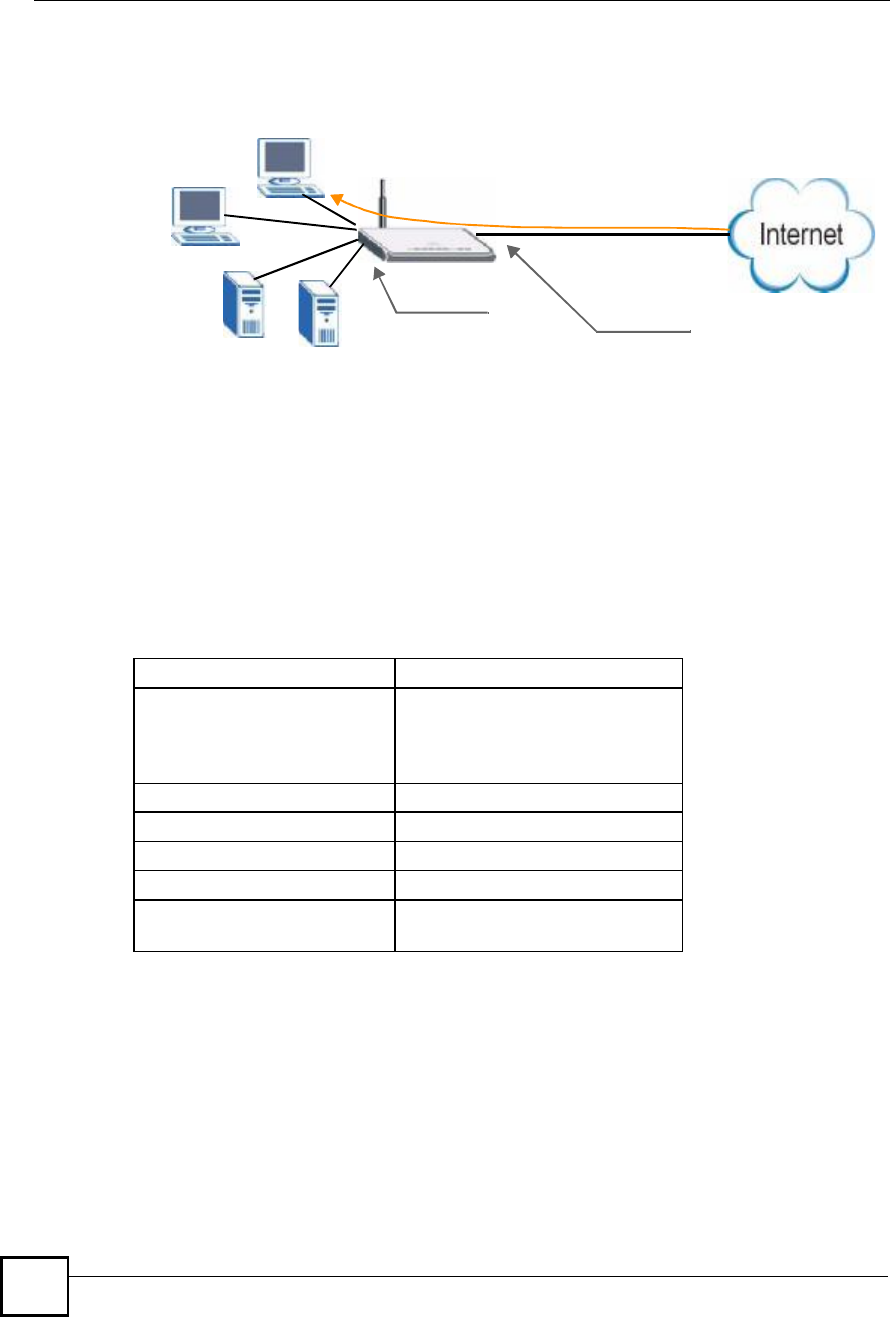
Chapter 4Tutorials
NBG410W3G Series User s Guide
78
Figure 35 Tutorial Example: Using NAT with Static Public IP Addresses
To set up this network, we are going to:
1Configure the WAN 1 connection to use the first public IP address (1.2.3.4).
2Configure NAT address mapping for other public IP addresses (1.2.3.5 and 1.2.3.6).
3Configure NAT port forwarding to forward FTP traffic from WAN 1 to a specific
computer on your local network.
4.5.2 Configuring the WAN Connection with a Static IP Address
The following table shows the information your ISP gave you for Internet connection.
Follow the steps below to configure your ZyXEL Device for Internet access using PPPoE in
this example.
FTP
FTP
192.168.1.39
192.168.1.39
192.168.1.12 192.168.1.13
Mail
Web
192.168.1.1
1.2.3.4
1.2.3.5
1.2.3.6
1.2.3.7
WAN
LAN Mapping rules:
192.168.1.12 <---> 1.2.3.5 (1-1)
192.168.1.13 <---> 1.2.3.6 (1-1)
Other outgoing LAN traffic ---> 1.2.3.4 (M-1)
Incoming traffic <--- 1.2.3.4 (Server)
Encapsulation PPPoE
Public IP Addresses 1.2.3.4
1.2.3.5
1.2.3.6
1.2.3.7
Gateway IP Address 1.2.3.89
Subnet Mask 255.255.255.0
User Name exampleuser
Password abcd1234
DNS Server 1.2.1.1
1.2.1.2
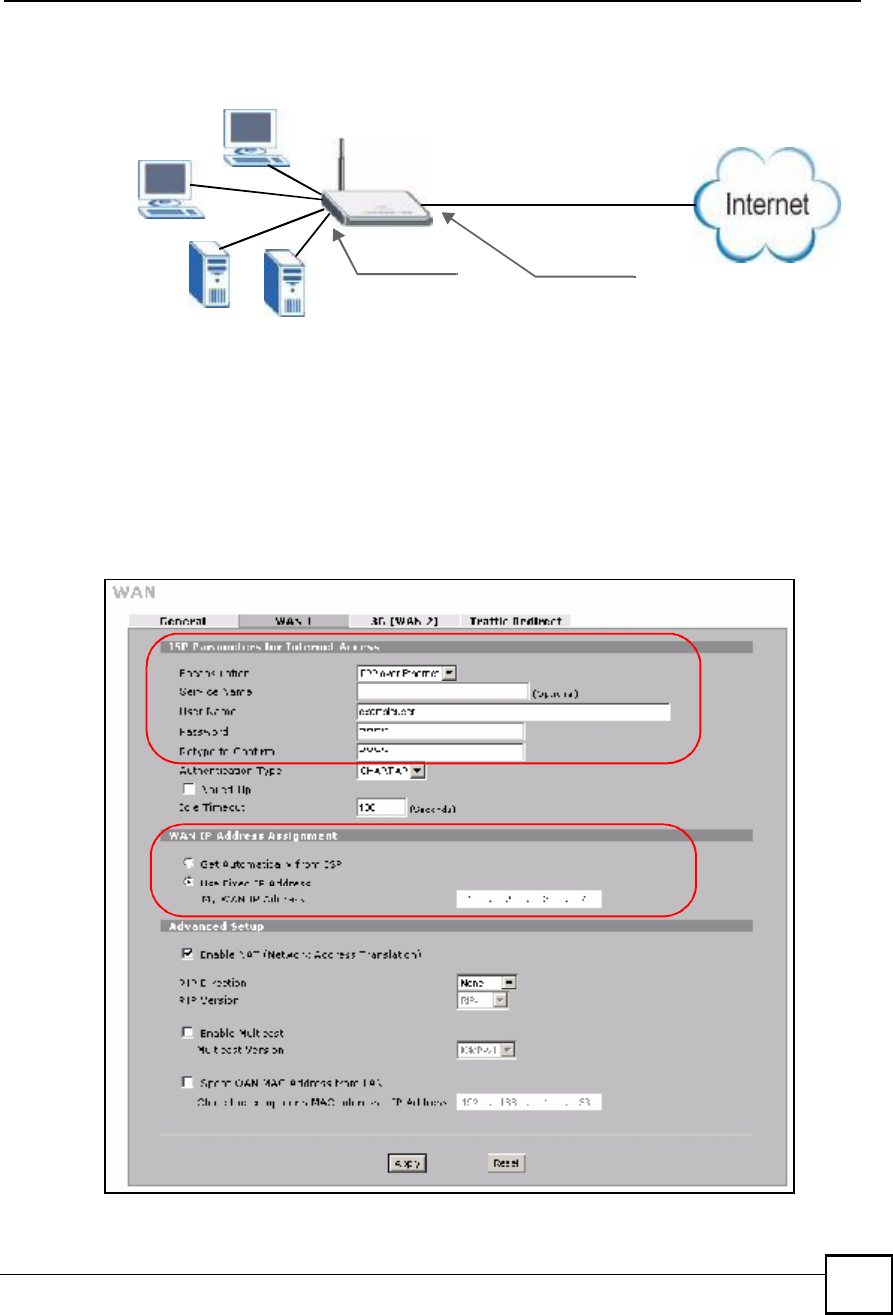
Chapter 4Tutorials
NBG410W3G Series User s Guide 79
Figure 36 Tutorial Example: WAN Connection with a Static Public IP Address
1Click NETWORK > WAN > WAN 1.
2Select PPPoE (PPP over Ethernet) from the Encapsulation drop-down list box.
3In the ISP Parameters for Internet Access section, enter the information (such as the
user name and password) provided by your ISP. If your ISP didn!t give you the service
name, leave the field blank.
4In the WAN IP Address Assignment section, select Use Fixed IP Address and enter
the first fixed public IP address (1.2.3.4 in this example).
5Click Apply.
Figure 37 Tutorial Example: WAN 1 Screen
6Click ADVANCED > DNS.
192.168.1.1 1.2.3.4
WAN
LAN
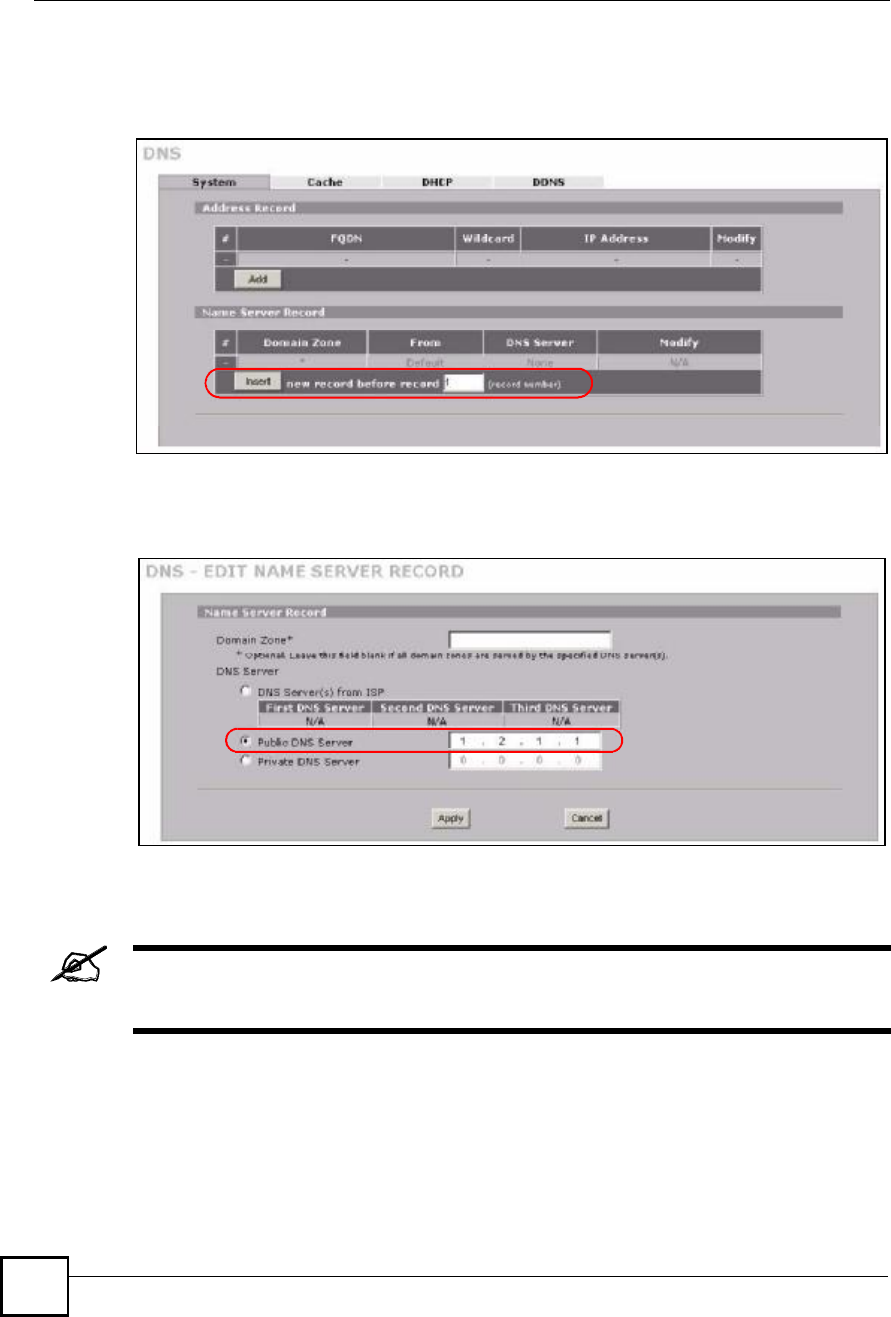
Chapter 4Tutorials
NBG410W3G Series User s Guide
80
7The System screen displays. Click the Insert button to configure the IP address of the
DNS server the ZyXEL Device can query to resolve domain names.
Figure 38 Tutorial Example: DNS > System
8Select Public DNS Server and enter the first DNS server!s IP address given by your ISP.
Click Apply.
Figure 39 Tutorial Example: DNS > System Edit-1
9Enter the rule number (2) where you want to put the second record and click the Insert
button to configure the second DNS server!s IP address as follows. Click Apply.
To resolve a domain name, theZyXEL Device checks it against the name
server record entries in the order that they appear in this list.
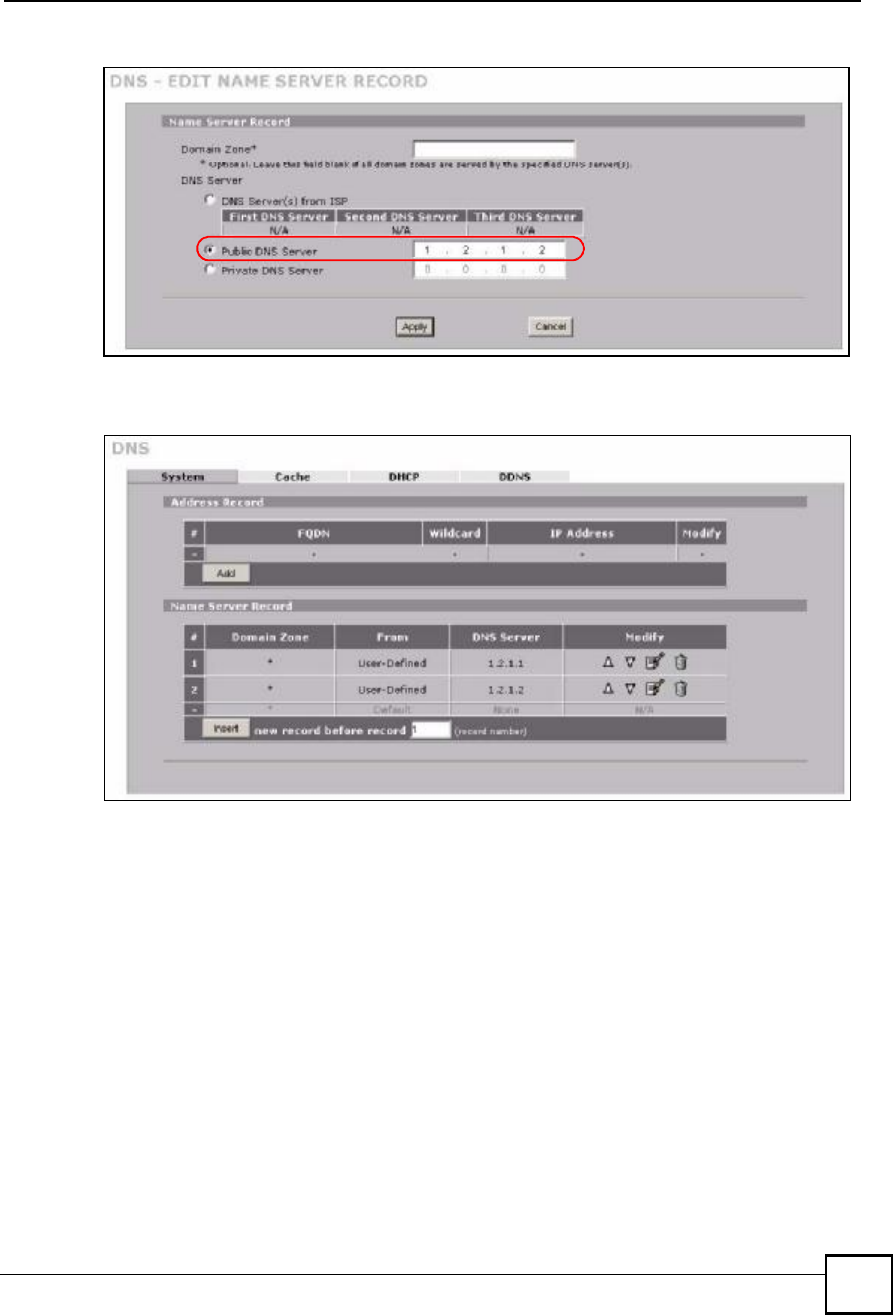
Chapter 4Tutorials
NBG410W3G Series User s Guide 81
Figure 40 Tutorial Example: DNS > System Edit-2
10 The DNS > System screen should look as shown.
Figure 41 Tutorial Example: DNS > System: Done
11 Go to the Home screen to check your WAN connection status. Make sure the status is
not down.
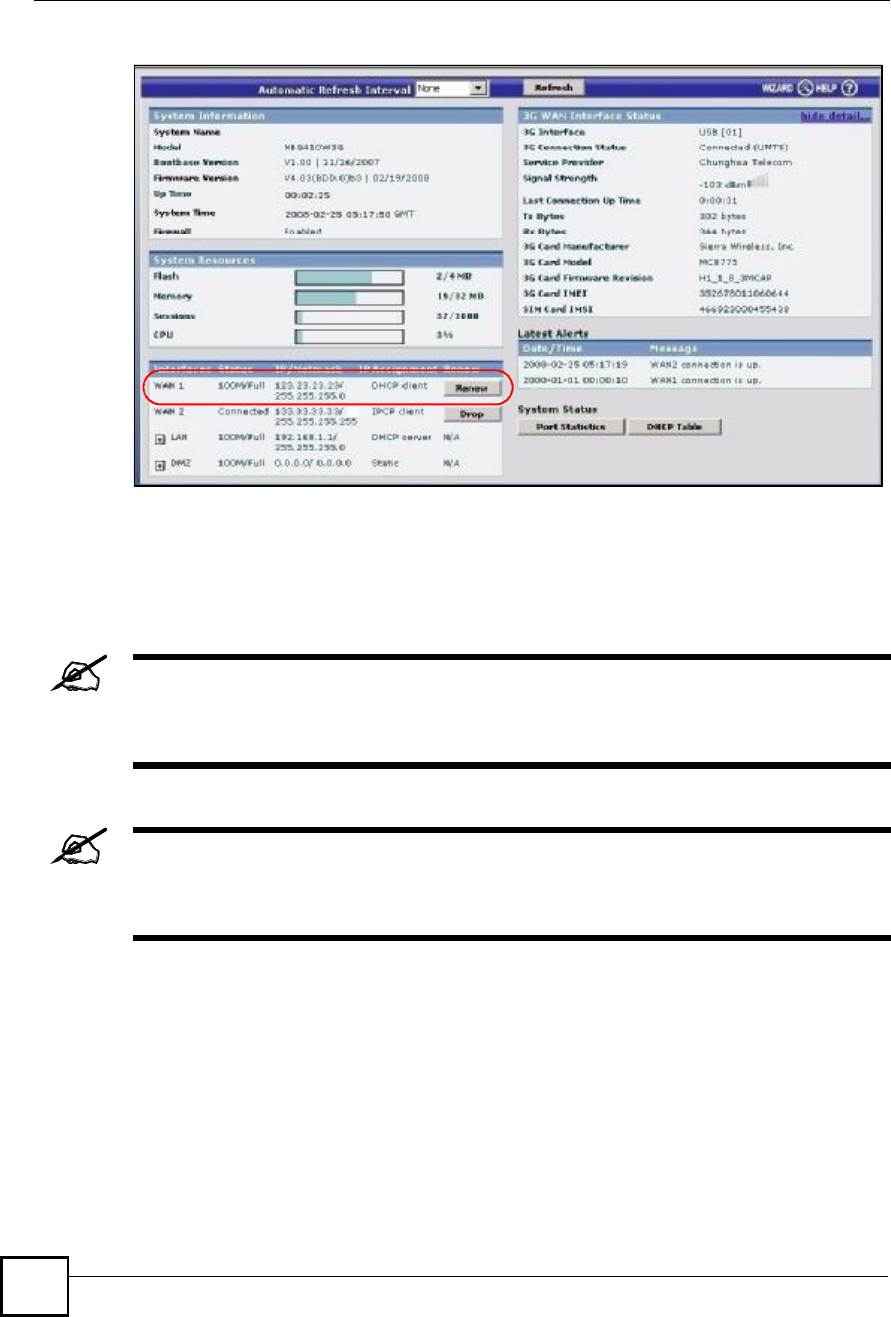
Chapter 4Tutorials
NBG410W3G Series User s Guide
82
Figure 42 Tutorial Example: Status
4.5.3 Public IP Address Mapping
To have the local computers and servers use specific WAN IP addresses, you need to map
static public IP addresses to them.
The one-to-one NAT address mapping rules are for both incoming and
outgoing connections. The ZyXEL Device forwards traffic that is initiated from
either the LAN or the WAN to the destination IP address.
The many-to-one or many-to-many NAT address mapping rules are for
outgoing connections only. That means only traffic initiated from the LAN or
returned packets are allowed to go through the ZyXEL Device.
In this example, you create two one-to-one rules to map the internal web server (192.168.1.12)
and mail server (192.168.1.13) to different static public IP addresses. The many-to-one rule
maps a public IP address (1.2.3.4, that is, the ZyXEL Device!s WAN 1 IP address) to outgoing
LAN traffic. It allows other local computers on the same subnet as the ZyXEL Device!s LAN
IP address to use this IP address to access the Internet.
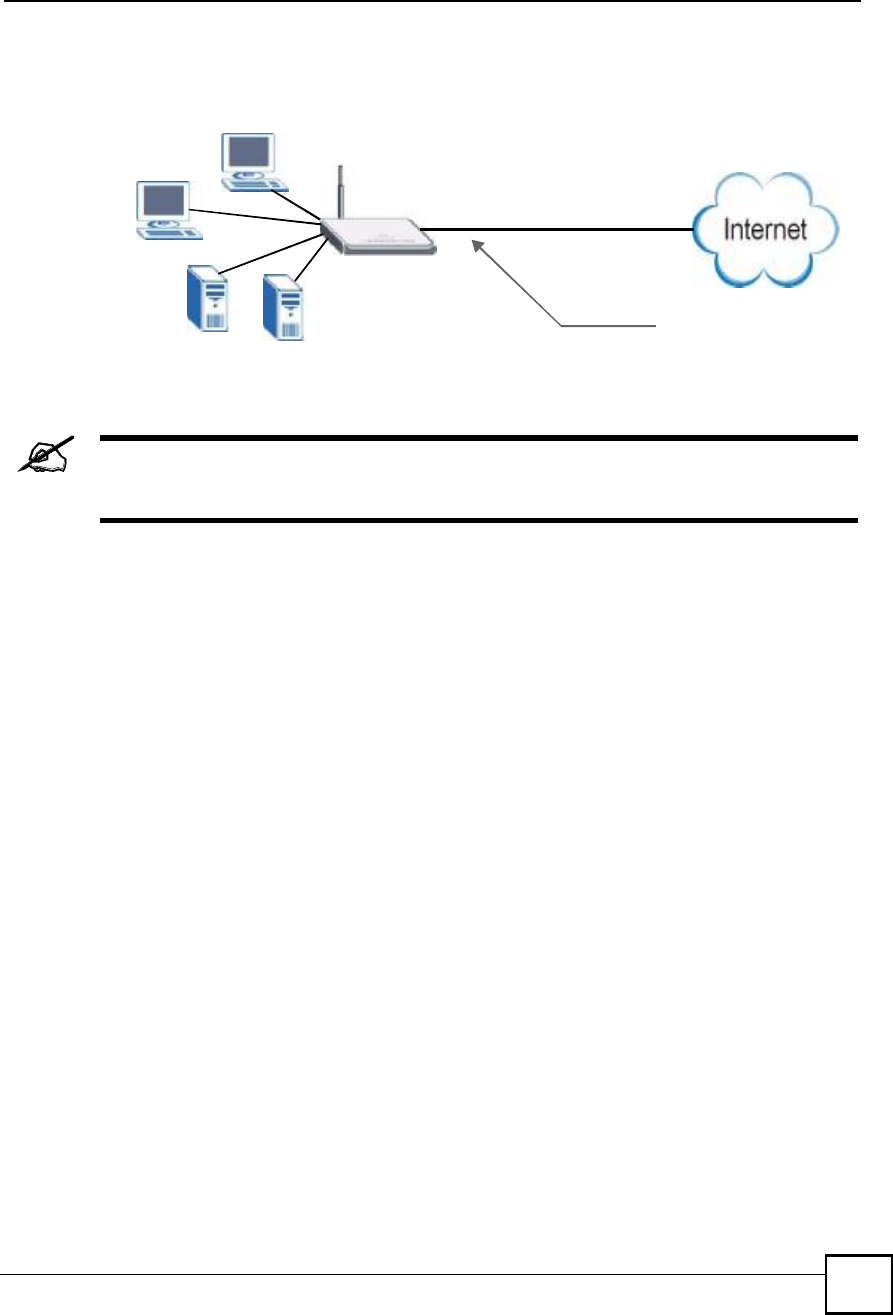
Chapter 4Tutorials
NBG410W3G Series User s Guide 83
Figure 43 Tutorial Example: Mapping Multiple Public IP Addresses to Inside Servers
The ZyXEL Device applies the rules in the order that you specify. You should
put any one-to-one rules before a many-to-one rule.
1Click ADVANCED > NAT.
2Enable NAT and select Full Feature for the WAN 1 interface as you have multiple
public IP addresses to map to private IP addresses. Click Apply.
192.168.1.39
192.168.1.39
192.168.1.12 192.168.1.13
Mail
Web
1.2.3.4
1.2.3.5
1.2.3.6
1.2.3.7
WAN
LAN Mapping rules:
192.168.1.12 <---> 1.2.3.5 (1-1)
192.168.1.13 <---> 1.2.3.6 (1-1)
Other outgoing LAN traffic ---> 1.2.3.4 (M-1)
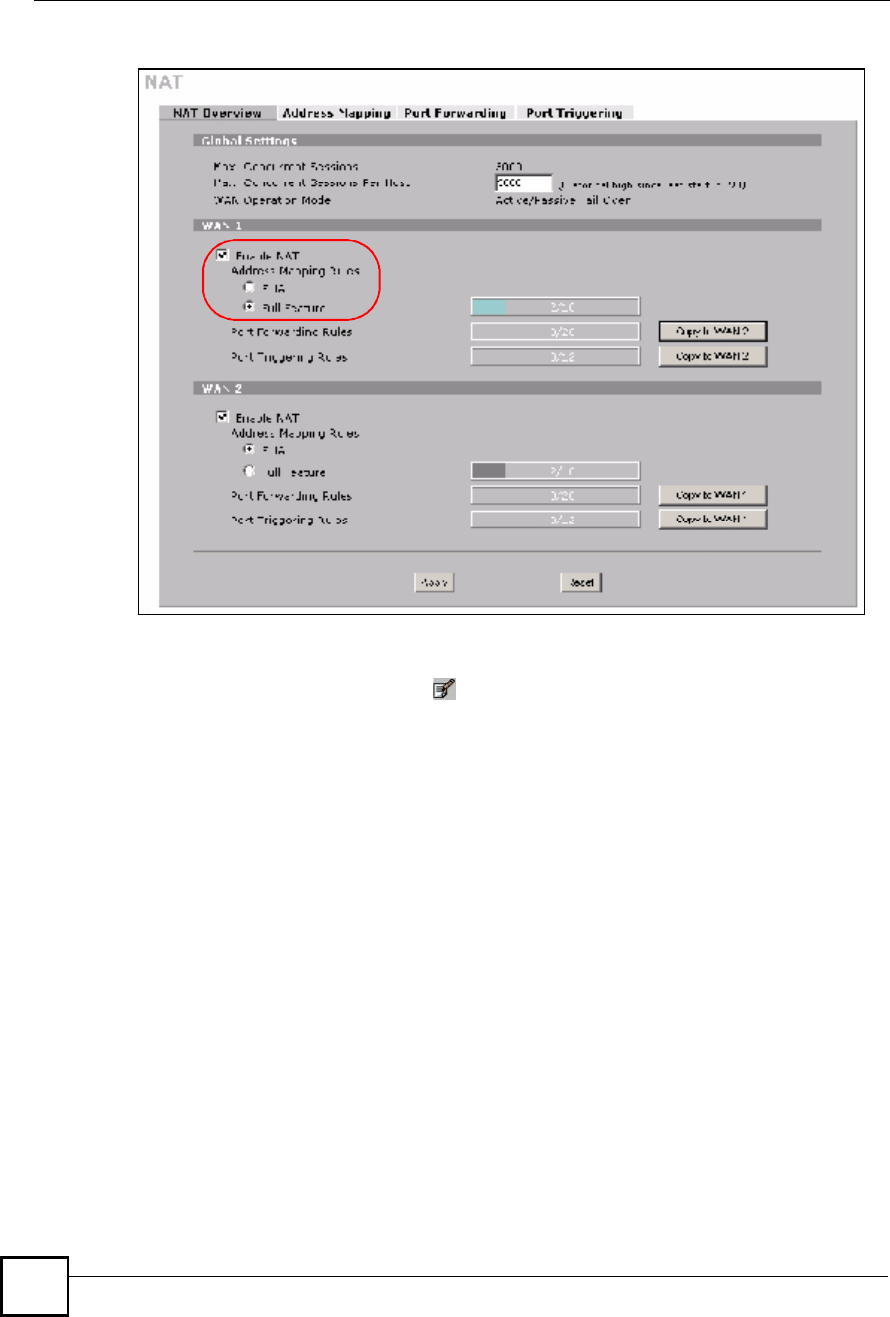
Chapter 4Tutorials
NBG410W3G Series User s Guide
84
Figure 44 Tutorial Example: NAT > NAT Overview
3Click the Address Mapping tab.
4Select WAN 1.
5Click the first rule!s Edit icon () in the Modify column to display the Address
Mapping Rule screen.
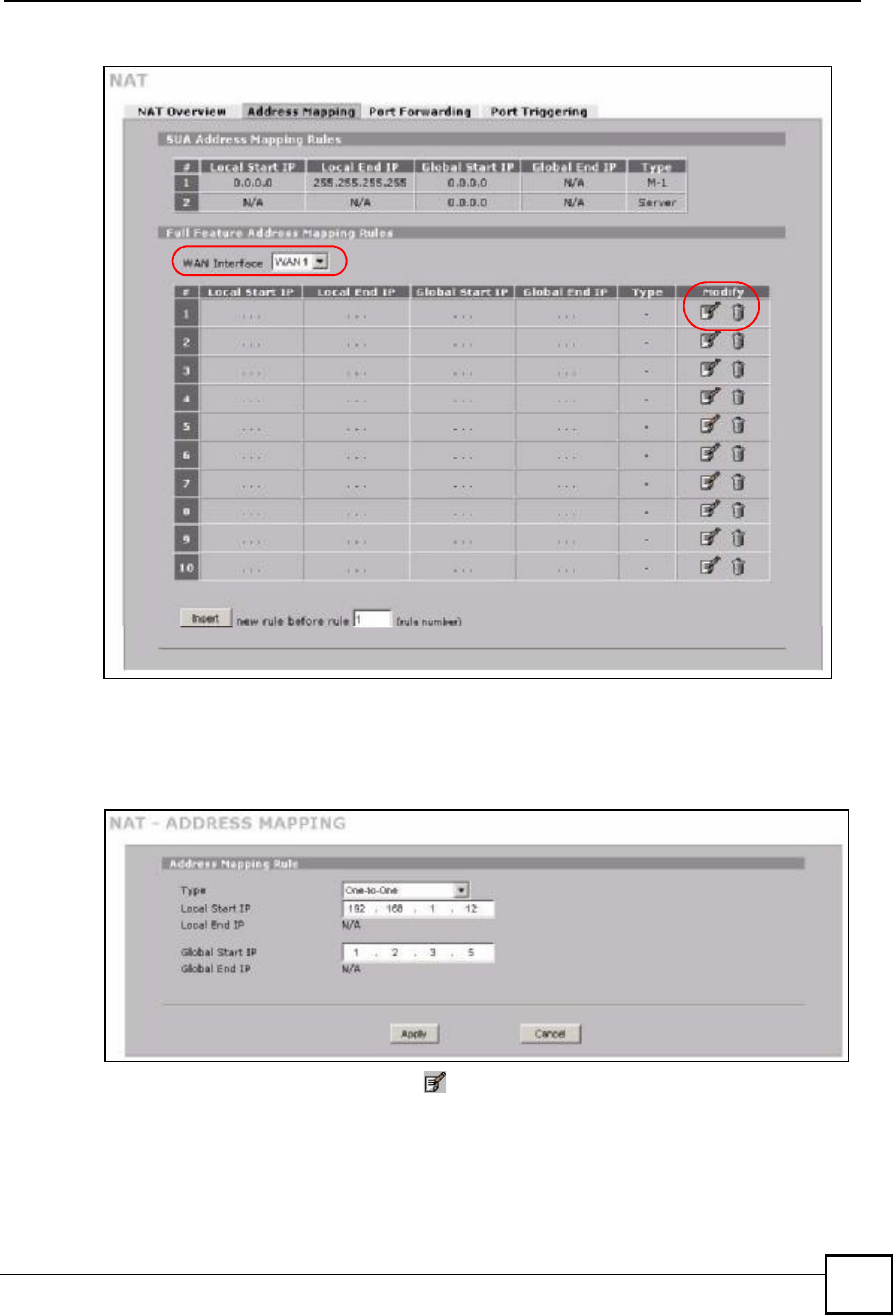
Chapter 4Tutorials
NBG410W3G Series User s Guide 85
Figure 45 Tutorial Example: NAT > Address Mapping
6Map a public IP address to the web server.
Select the One-to-One type and enter 192.168.1.12 as the local start IP address and
1.2.3.5 as the global start IP address. Click Apply.
Figure 46 Tutorial Example: NAT Address Mapping Edit: One-to-One (1)
7Click the second rule!s Edit icon ().
8Map a public IP address to the mail server.
Select the One-to-One type and enter 192.168.1.13 as the local start IP address and
1.2.3.6 as the global start IP address. Click Apply.
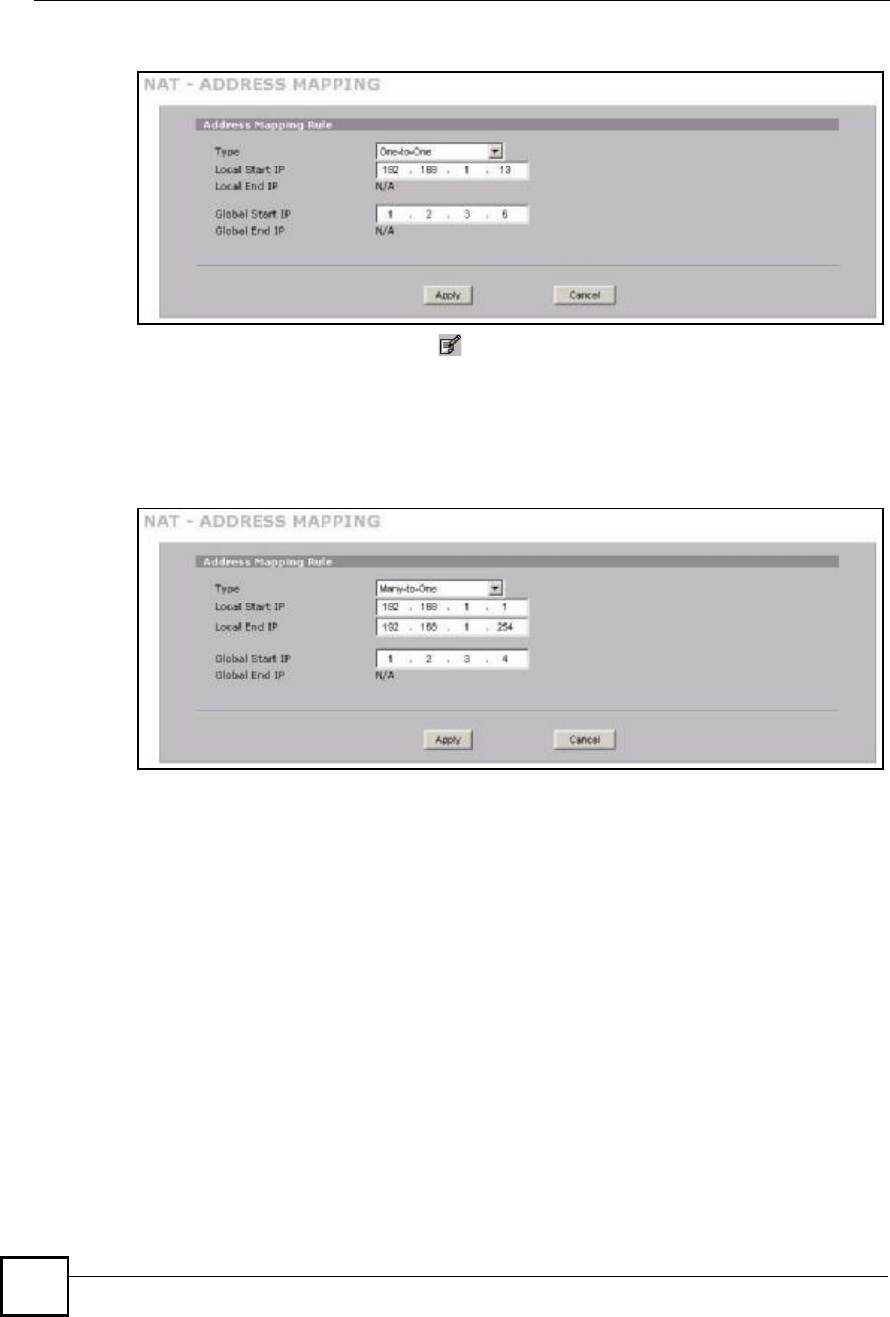
Chapter 4Tutorials
NBG410W3G Series User s Guide
86
Figure 47 Tutorial Example: NAT Address Mapping Edit: One-to-One (2)
9Click the third rule!s Edit icon ().
10 Map a public IP address to other outgoing LAN traffic.
Select the Many-to-One type and enter 192.168.1.1 as the local start IP address,
192.168.1.254 as the local end IP address and 1.2.3.4 as the global start IP address. Click
Apply.
Figure 48 Tutorial Example: NAT Address Mapping Edit: Many-to-One
11 After the configurations, the Address Mapping screen looks as shown. You still have
one IP address (1.2.3.7) that can be assigned to another internal server when you expand
your network.
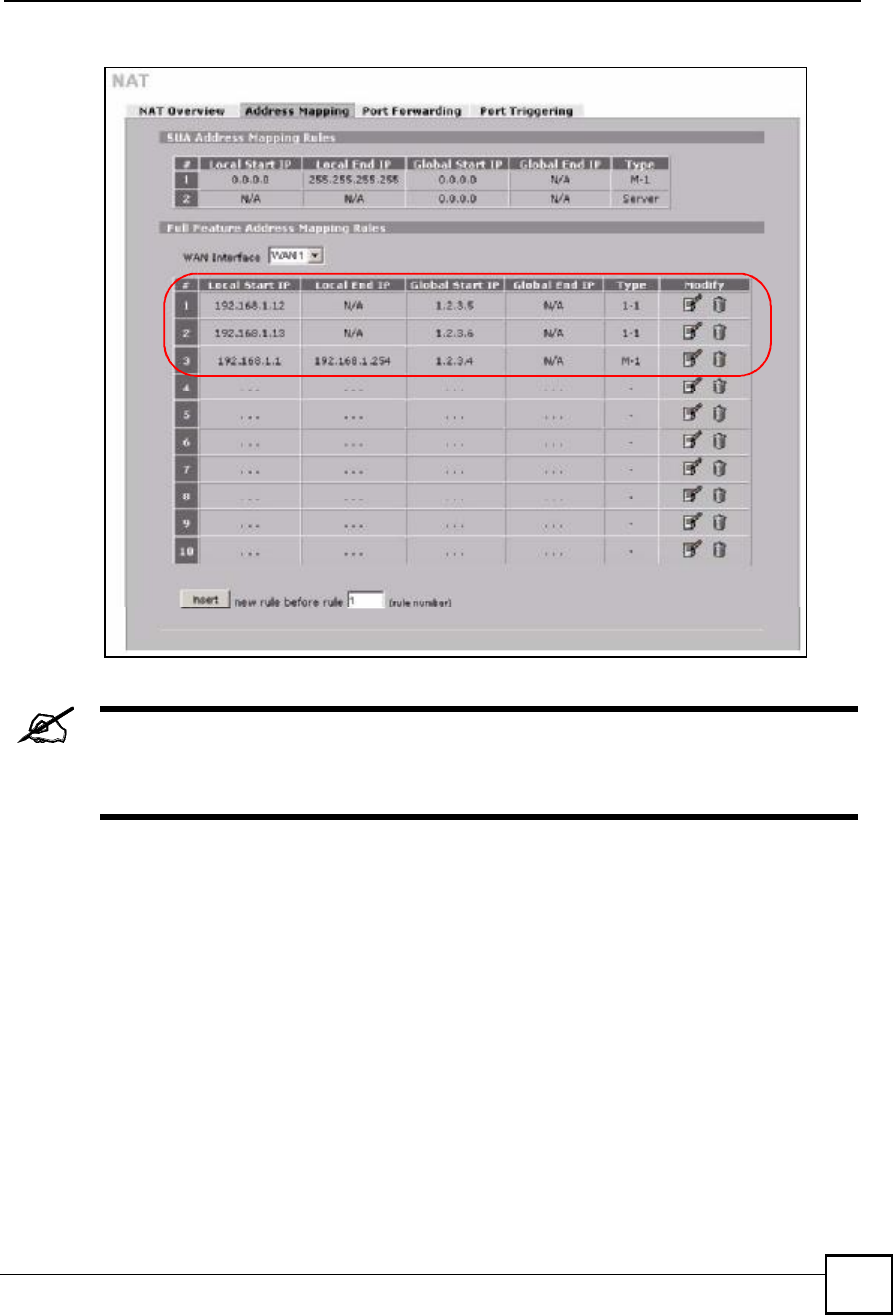
Chapter 4Tutorials
NBG410W3G Series User s Guide 87
Figure 49 Tutorial Example: NAT Address Mapping Done
To allow traffic from the WAN to be forwarded through the ZyXEL Device, you
must also create a firewall rule. Refer to Section 4.5.5 on page 89 for more
information.
4.5.4 Forwarding Traffic from the WAN to a Local Computer
A server NAT address mapping rule allows computers behind the NAT be accessible to the
outside world. To have the ZyXEL Device forward incoming traffic to a specific computer on
your local network, you should also create a port forwarding (server mapping) rule.
In this example, you want to forward FTP traffic using port 21 to the computer with the IP
address of 192.168.1.39.
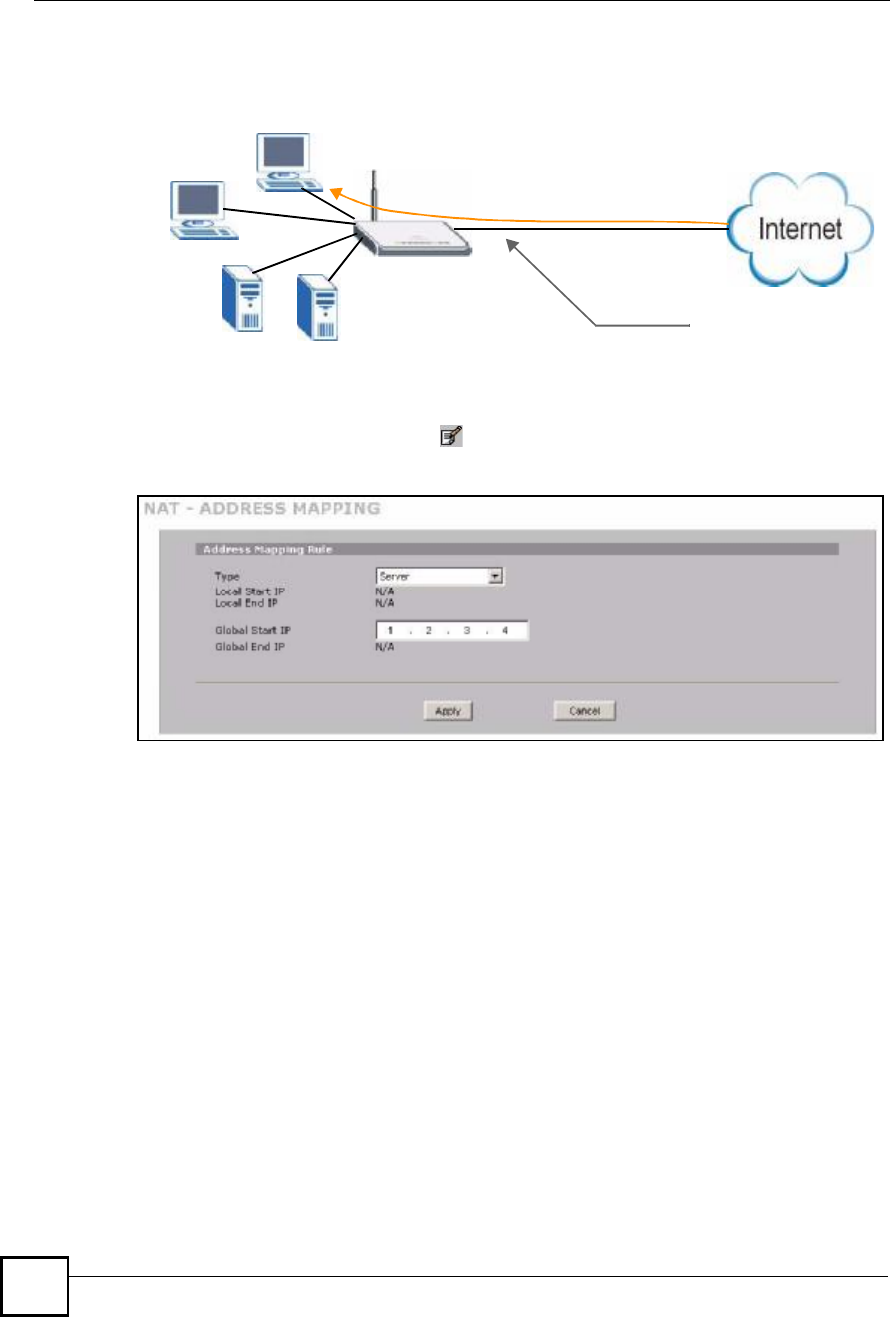
Chapter 4Tutorials
NBG410W3G Series User s Guide
88
Figure 50 Tutorial Example: Forwarding Incoming FTP Traffic to a Local Computer
1Click ADVANCED > NAT > Address Mapping.
2Click the forth rule!s Edit icon () to configure a server rule.
Figure 51 Tutorial Example: NAT Address Mapping Edit: Server
3Click the Port Forwarding tab.
4Select WAN 1.
5Select the Active check box, enter a descriptive name (FTP for example), incoming port
number (21) and 192.168.1.39 as the server IP address. Click Apply.
FTP
FTP
192.168.1.39
192.168.1.39
192.168.1.12 192.168.1.13
Mail
Web
1.2.3.4
1.2.3.5
1.2.3.6
1.2.3.7
WAN
LAN Mapping rules:
Incoming traffic <--- 1.2.3.4 (Server)
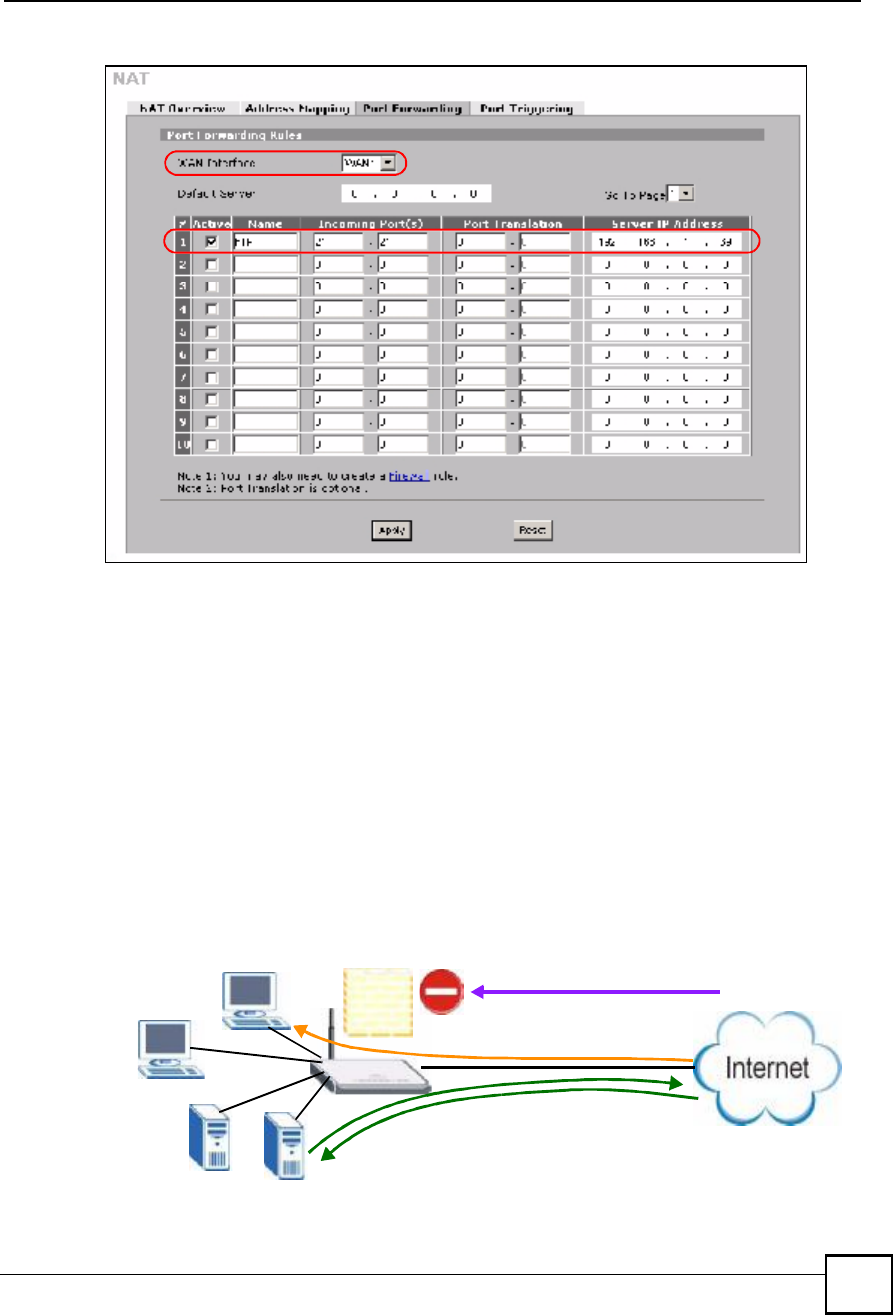
Chapter 4Tutorials
NBG410W3G Series User s Guide 89
Figure 52 Tutorial Example: NAT Port Forwarding
4.5.5 Allow WAN-to-LAN Traffic through the Firewall
By default, the ZyXEL Device blocks any traffic initiated from the WAN to the LAN. To have
the ZyXEL Device forward traffic initiated from WAN 1 to a local computer or server on the
LAN, you need to configure a firewall rule to allow it.
In this example, you create the firewall rules to allow traffic from the WAN to the following
servers on the LAN:
Web server
Mail server
FTP server
Figure 53 Tutorial Example: Forwarding Incoming FTP Traffic to a Local Computer
FTP
FTP
192.168.1.39
192.168.1.39
192.168.1.12 192.168.1.13
Mail
Web
WAN
LAN
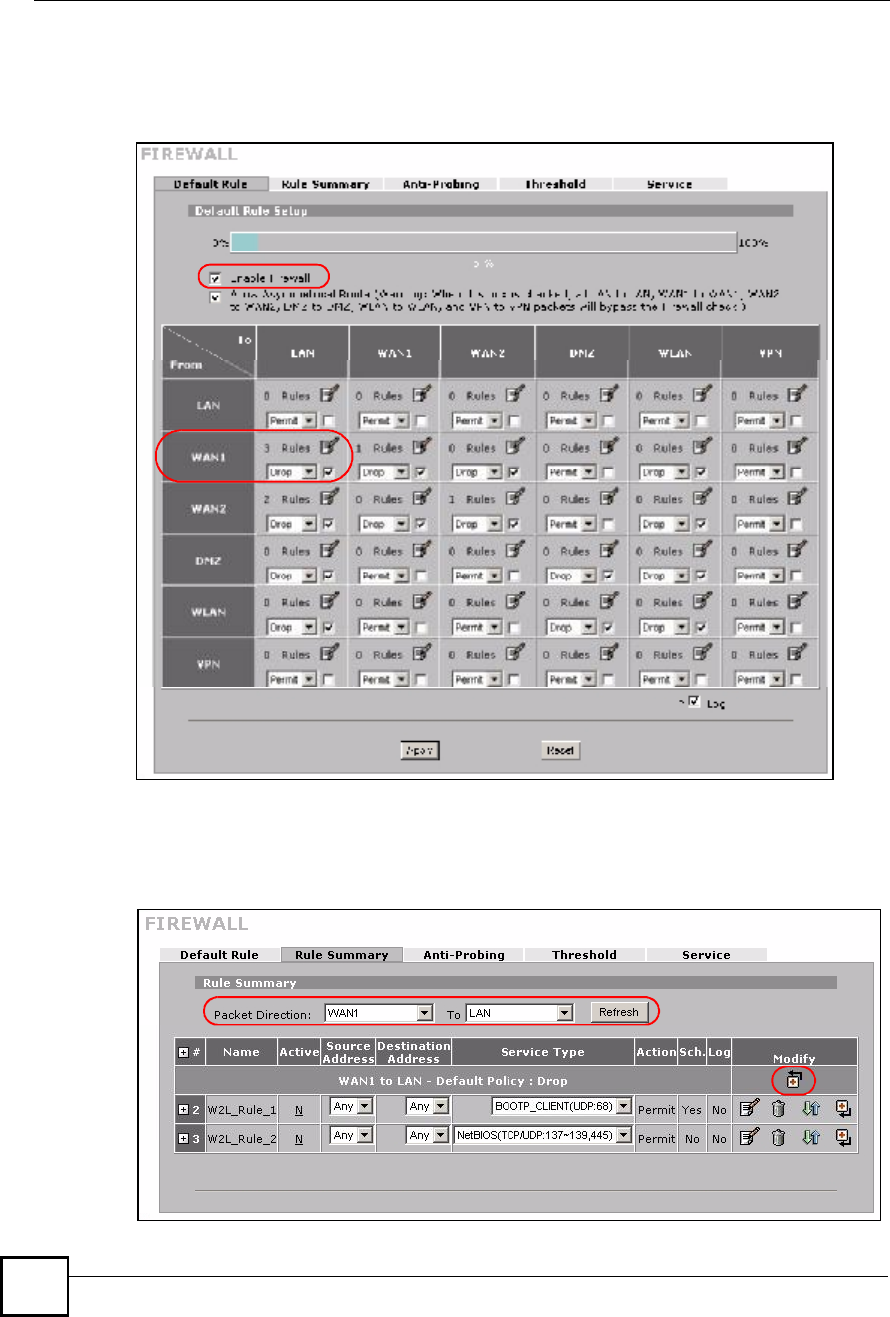
Chapter 4Tutorials
NBG410W3G Series User s Guide
90
1Click SECURITY > FIREWALL.
2Make sure the firewall is enabled and traffic from WAN 1 to the LAN is dropped.
Figure 54 Tutorial Example: Firewall Default Rule
3Go to the Rule Summary screen.
4Select WAN1 to LAN as the packet direction and click Refresh.
5Click the insert icon to create a new firewall rule.
Figure 55 Tutorial Example: Firewall Rule: WAN1 to LAN
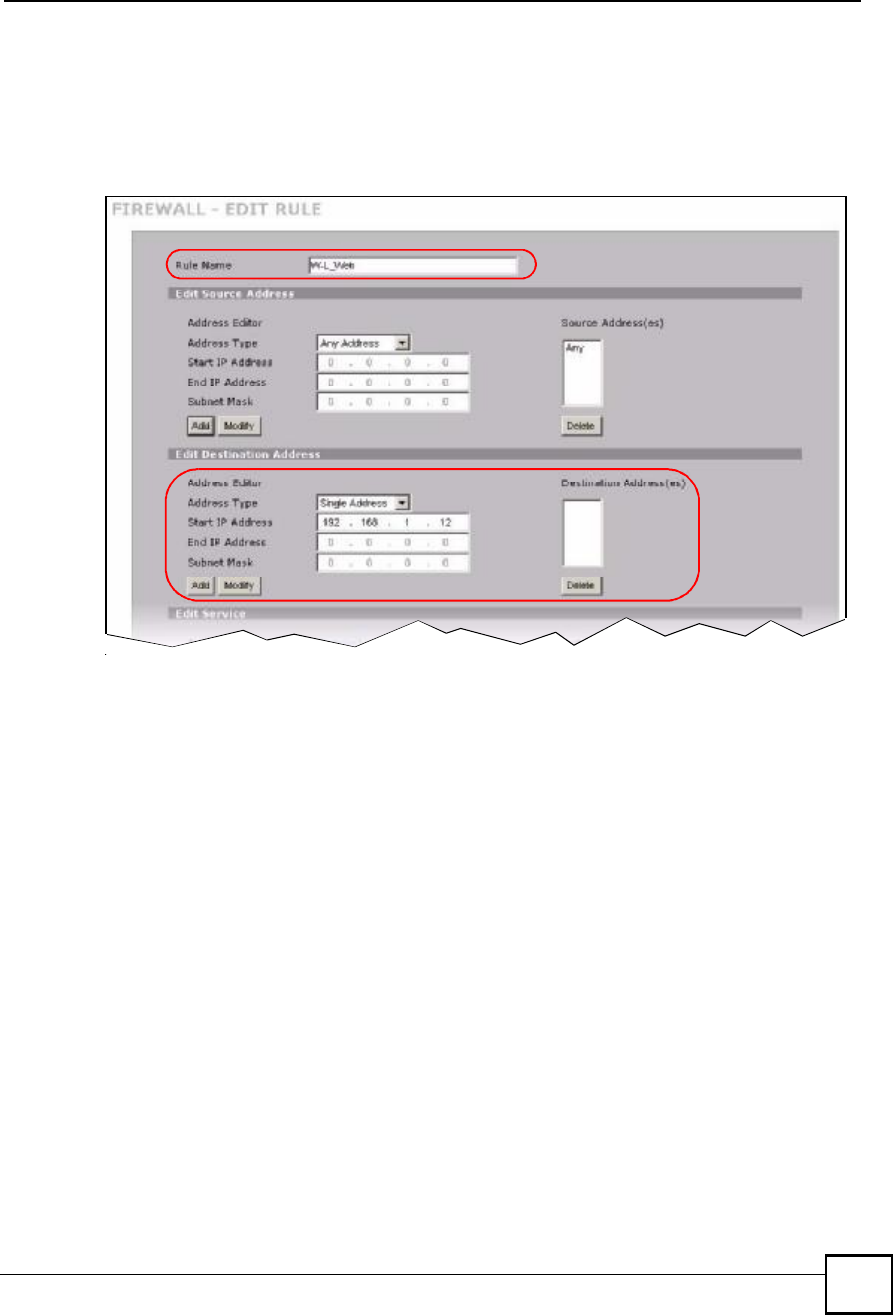
Chapter 4Tutorials
NBG410W3G Series User s Guide 91
6Configure a firewall rule to allow HTTP traffic from the WAN to the web server.
Enter a descriptive name (W-L_Web for example).
Select Any in the Destination Address(es) box and click Delete.
Select Single Address as the destination address type. Enter 192.168.1.12 and click Add.
Figure 56 Tutorial Example: Firewall Rule: WAN to LAN Address Edit for Web Server
7Select HTTP(TCP:80) and HTTPS(TCP:443) in the Available Services box on the left,
and click >> to add them to the Selected Service(s) box on the right. Click Apply.
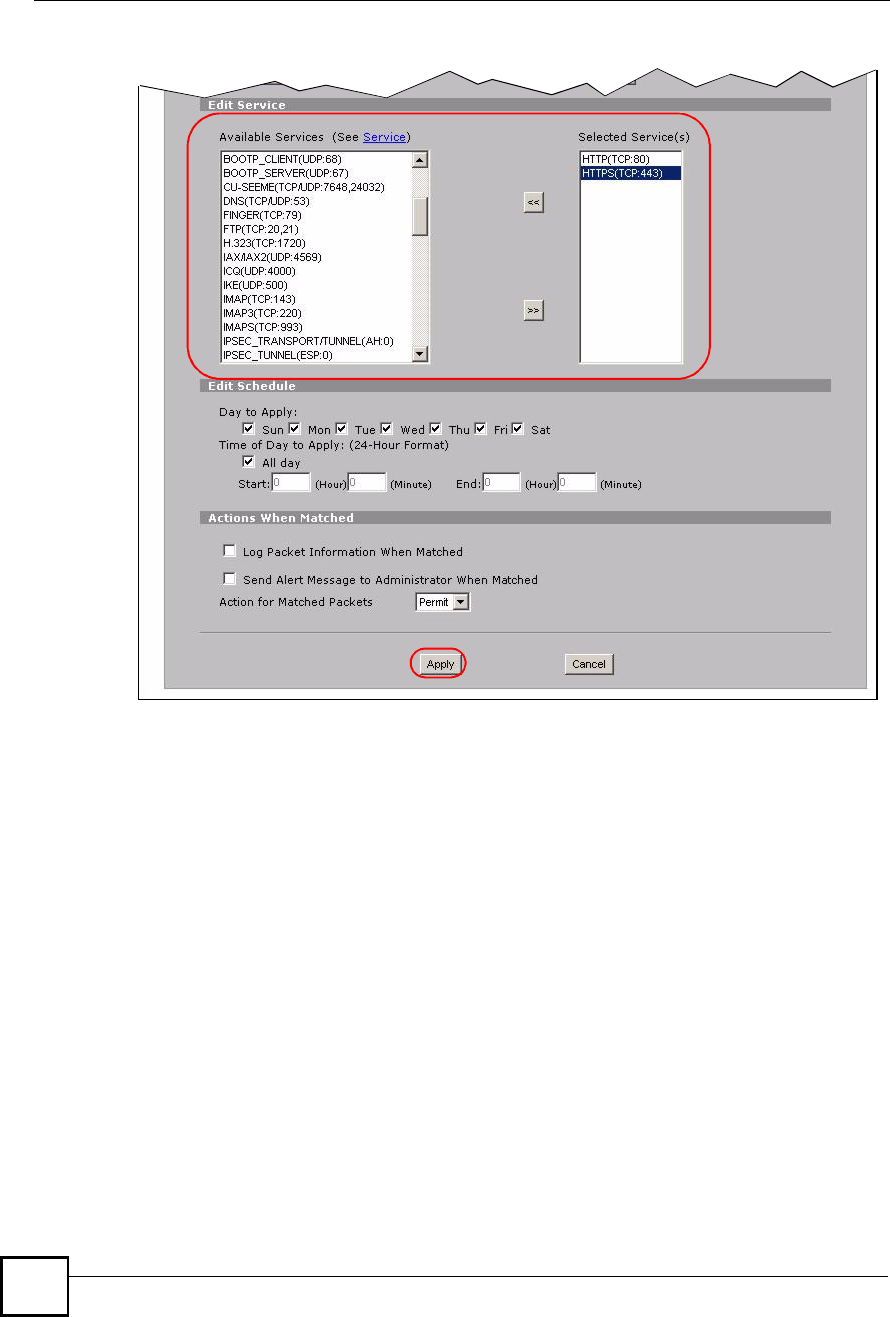
Chapter 4Tutorials
NBG410W3G Series User s Guide
92
Figure 57 Tutorial Example: Firewall Rule: WAN to LAN Service Edit for Web Server
8Click the insert icon to configure a firewall rule to allow traffic from the WAN to the mail
server.
Enter a descriptive name (W-L_Mail for example).
Select Any in the Destination Address(es) box and click Delete.
Select Single Address as the destination address type. Enter 192.168.1.13 and click Add.
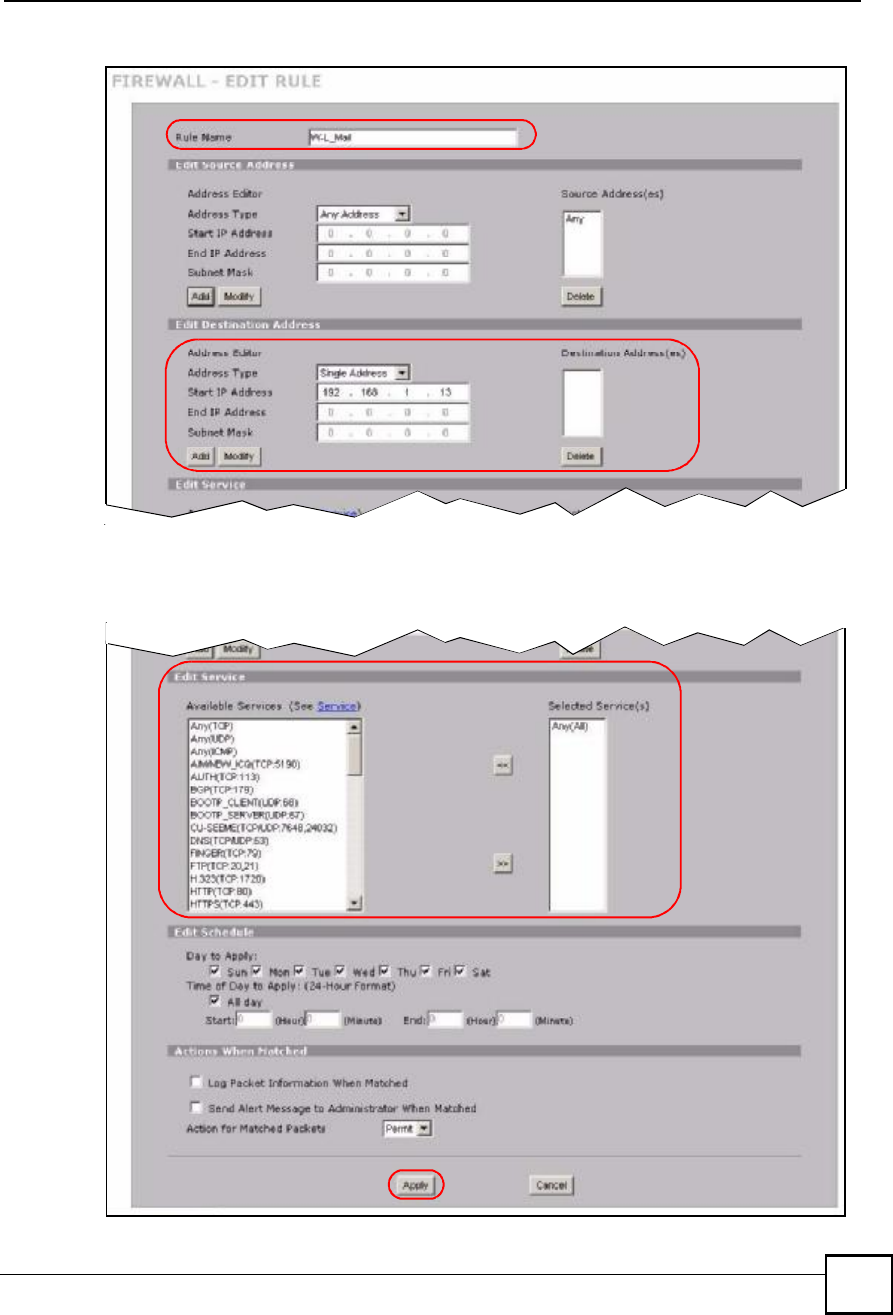
Chapter 4Tutorials
NBG410W3G Series User s Guide 93
Figure 58 Tutorial Example: Firewall Rule: WAN to LAN Address Edit for Mail Server
9Select Any(All) in the Available Services box on the left, and click >> to add it to the
Selected Service(s) box on the right. Click Apply.
Figure 59 Tutorial Example: Firewall Rule: WAN to LAN Service Edit for Mail Server
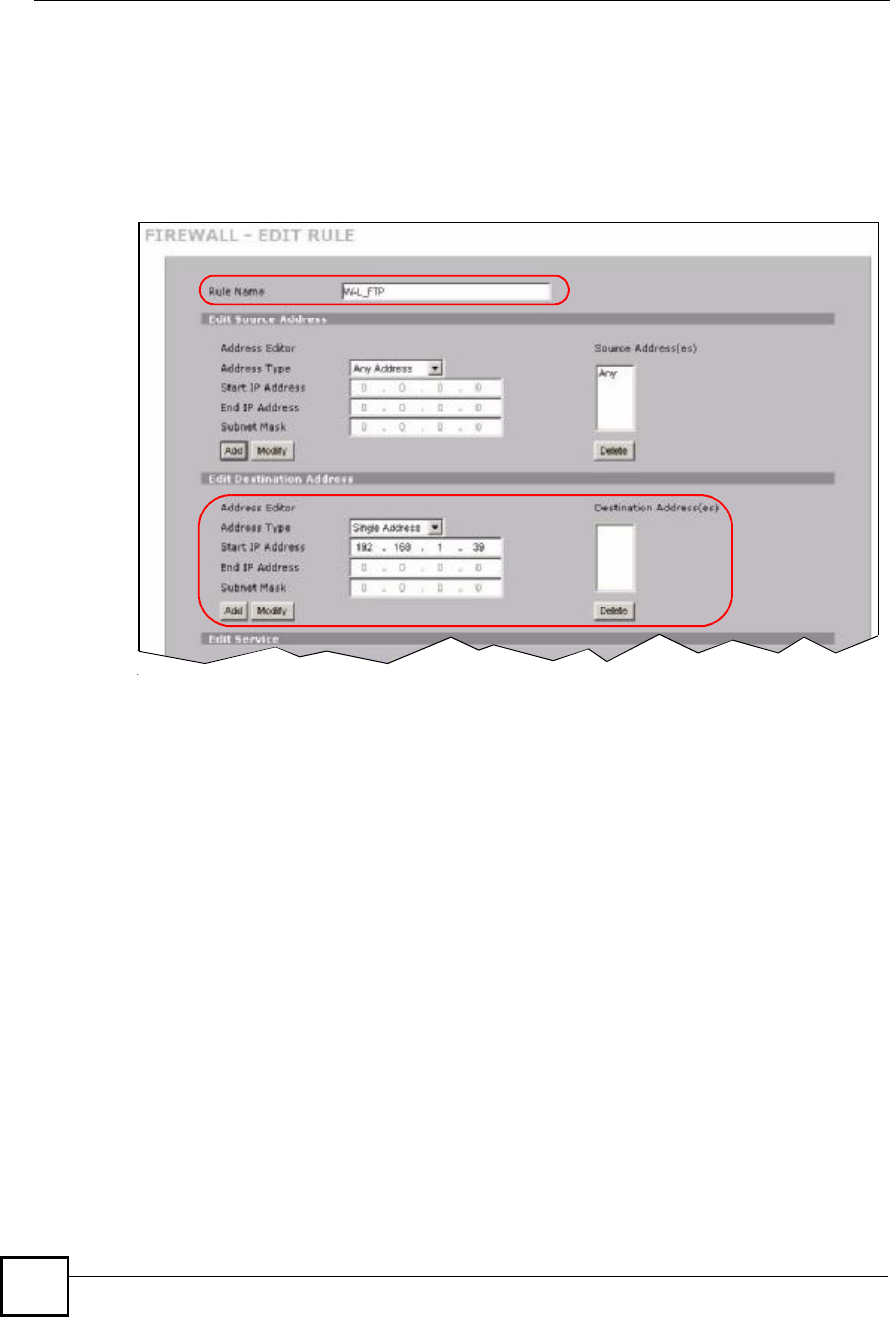
Chapter 4Tutorials
NBG410W3G Series User s Guide
94
10 Click the insert icon to configure a firewall rule to allow FTP traffic from the WAN to
the FTP server.
Enter a descriptive name (W-L_FTP for example).
Select Any in the Destination Address(es) box and click Delete.
Select Single Address as the destination address type. Enter 192.168.1.39 and click Add.
Figure 60 Tutorial Example: Firewall Rule: WAN to LAN Address Edit for FTP Server
11 Select FTP(TCP:20,21) in the Available Services box on the left, and click >> to add it
to the Selected Service(s) box on the right. Click Apply.
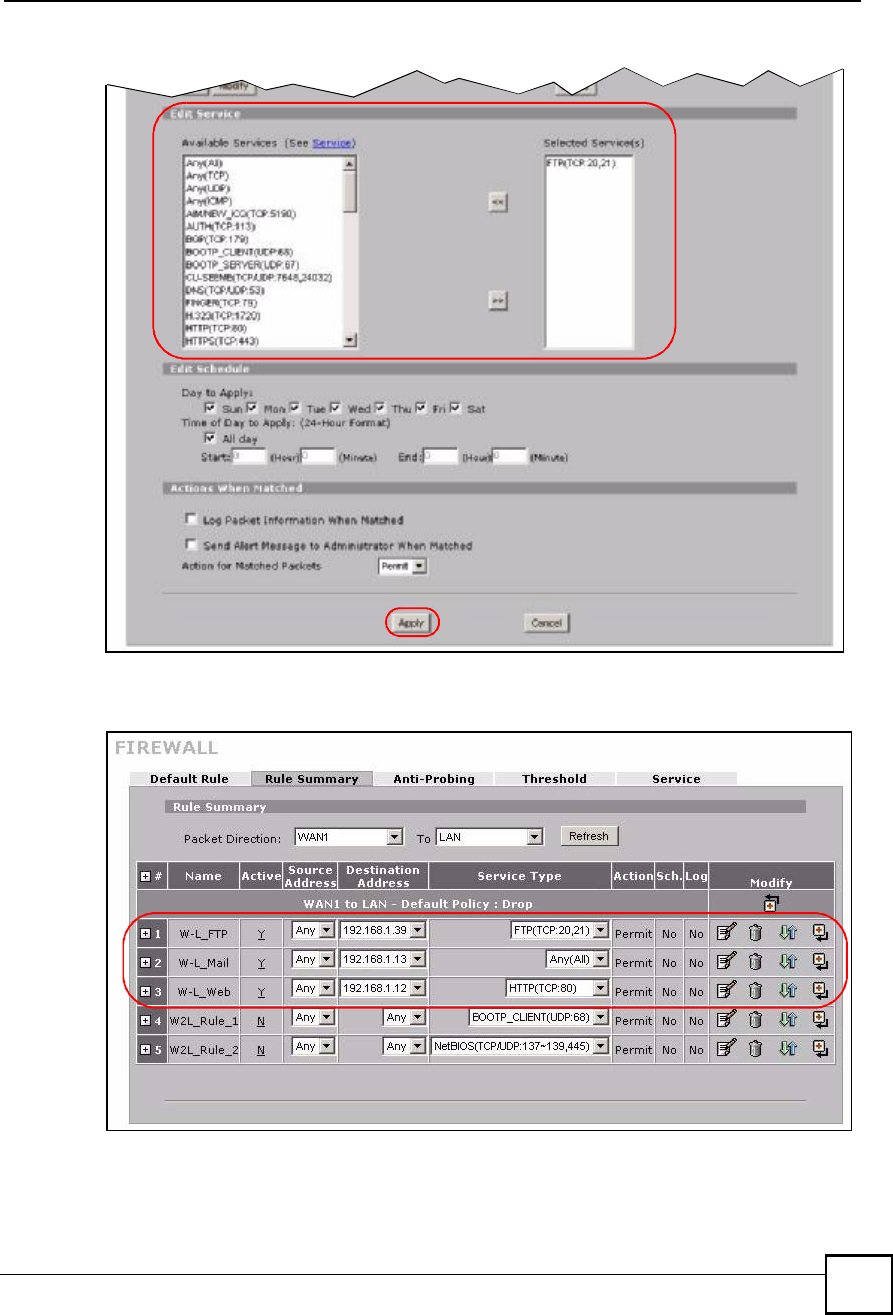
Chapter 4Tutorials
NBG410W3G Series User s Guide 95
Figure 61 Tutorial Example: Firewall Rule: WAN to LAN Service Edit for FTP Server
12 When you are done, the Rule Summary screen looks as shown.
Figure 62 Tutorial Example: Firewall Rule Summary

Chapter 4Tutorials
NBG410W3G Series User s Guide
96
4.5.6 Testing the Connections
1Open the web browser on one of the local computers and enter any web site!s URL in the
address bar. If you can access the web site, your WAN 1 connection and NAT address
mapping are configured successfully. If you cannot access it, make sure you entered the
correct information in the WAN and NAT Address Mapping screens. Also check that
the Internet account is active and the computer!s IP address is in the same subnet as the
ZyXEL Device.
2Open your web browser and try accessing the web server (1.2.3.5) from the outside
network. If you cannot access the web server, make sure the NAT address mapping rule is
configured correctly and there is a firewall rule to allow HTTP traffic from the WAN to
the web server.
3Try accessing the FTP server (1.2.3.4) from the outside network to send or retrieve a file.
If you cannot access the FTP server, make sure the NAT port forwarding rule is active and
there is a firewall rule to allow FTP traffic from the WAN to FTP server.
4.6 Using NAT with Multiple Game Players
If two users (behind the ZyXEL Device) want to connect to the same server to play online
games at the same time, but the server does not allow more than one login from the same IP
address, you can configure a many-to-many rule instead of a many-to-one rule.
In this example, you have four static IP addresses (1.2.3.4 to 1.2.3.7) from your ISP. After you
set up your WAN connection (see Section 4.5.2 on page 78), use the NAT > Address
Mapping screen to map the third and forth public IP addresses to the mail server
(192.168.1.12) and web server (192.168.1.13) respectively. The first and second public IP
addresses are mapped to other outgoing LAN traffic. See Section 4.5.3 on page 82 for more
information about IP address mapping.
When you finish configuration, the screen looks as shown.
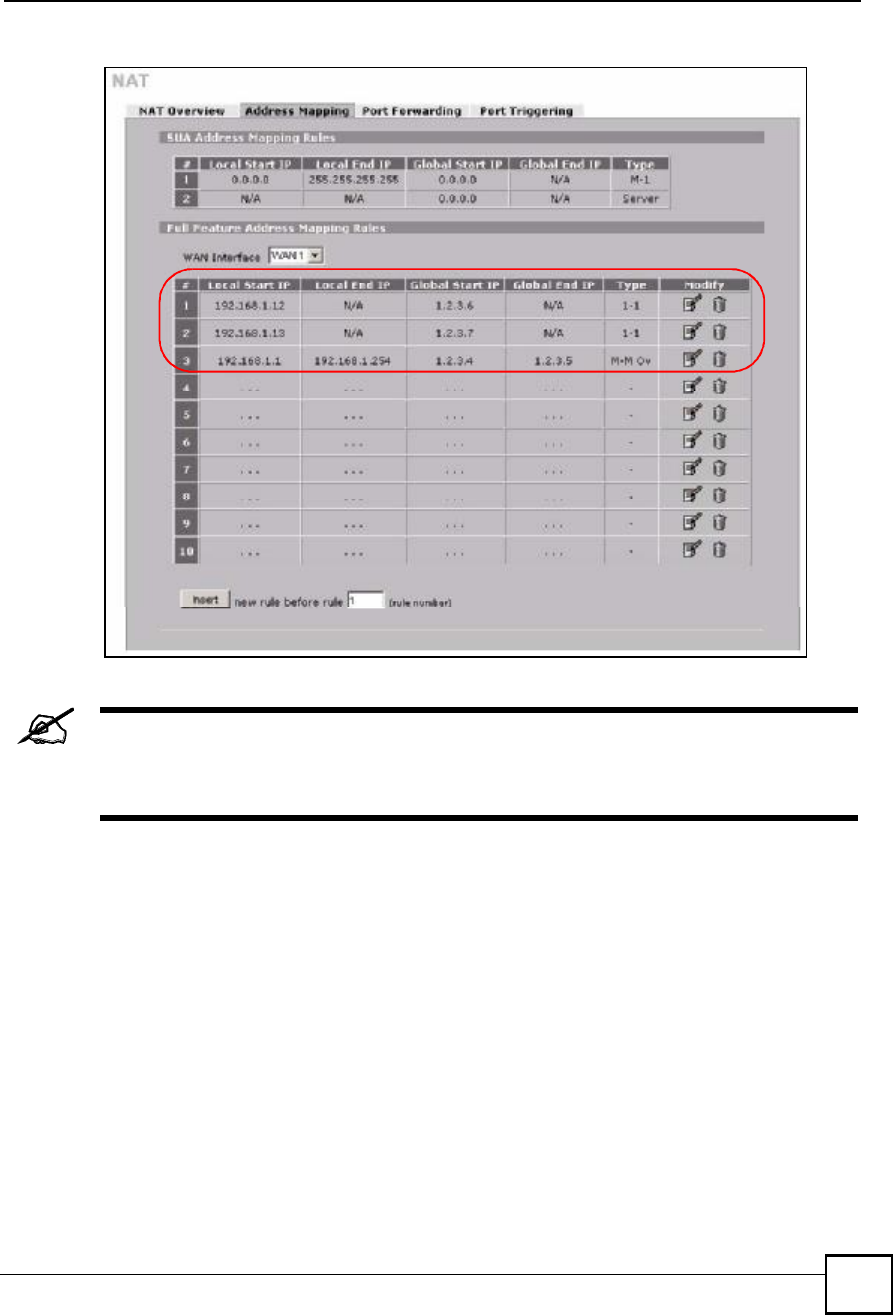
Chapter 4Tutorials
NBG410W3G Series User s Guide 97
Figure 63 Tutorial Example: NAT Address Mapping Done: Game Playing
To allow traffic from the WAN to be forwarded through the ZyXEL Device, you
must also create a firewall rule. Refer to Section 4.5.5 on page 89 for more
information.

Chapter 4Tutorials
NBG410W3G Series User s Guide
98

99
PART II
Network
LAN Screens (101)
WAN Screens (111)
DMZ Screens (135)

100
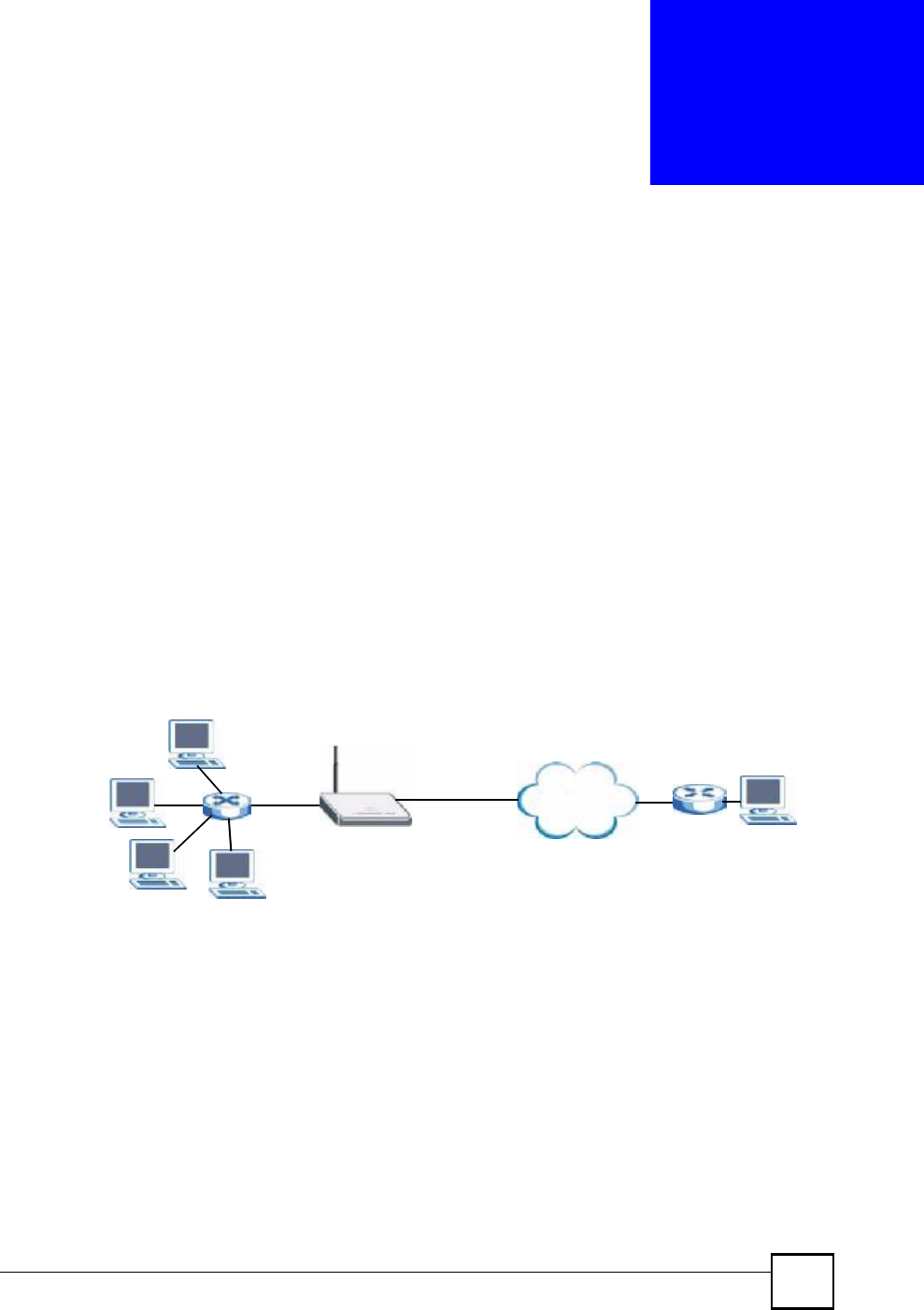
NBG410W3G Series User s Guide 101
CHAPTER 5
LAN Screens
This chapter describes how to configure LAN settings.
5.1 LAN, WAN and the ZyXEL Device
A network is a shared communication system to which many computers are attached.
The Local Area Network (LAN) includes the computers and networking devices in your home
or office that you connect to the ZyXEL Device!s LAN ports.
The Wide Area Network (WAN) is another network (most likely the Internet) that you connect
to the ZyXEL Device!s WAN port. See Chapter 6 on page 111 for how to use the WAN screens
to set up your WAN connection.
The LAN and the WAN are two separate networks. The ZyXEL Device controls the traffic that
goes between them. The following graphic gives an example.
Figure 64 LAN and WAN
5.2 IP Address and Subnet Mask
Similar to the way houses on a street share a common street name, so too do computers on a
LAN share one common network number.
Where you obtain your network number depends on your particular situation. If the ISP or
your network administrator assigns you a block of registered IP addresses, follow their
instructions in selecting the IP addresses and the subnet mask.
If the ISP did not explicitly give you an IP network number, then most likely you have a single
user account and the ISP will assign you a dynamic IP address when the connection is
established. If this is the case, it is recommended that you select a network number from
192.168.0.0 to 192.168.255.0 and you must enable the Network Address Translation (NAT)
Internet
WAN
LAN

Chapter 5LAN Screens
NBG410W3G Series User s Guide
102
feature of the ZyXEL Device. The Internet Assigned Number Authority (IANA) reserved this
block of addresses specifically for private use; please do not use any other number unless you
are told otherwise. If you select 192.168.1.0 as the network number; it covers 254 individual
addresses, from 192.168.1.1 to 192.168.1.254 (zero and 255 are reserved). In other words, the
first three numbers specify the network number while the last number identifies an individual
computer on that network.
Once you have decided on the network number, pick an IP address that is easy to remember,
for instance, 192.168.1.1, for your ZyXEL Device, but make sure that no other device on your
network is using that IP address.
The subnet mask specifies the network number portion of an IP address. Your ZyXEL Device
will compute the subnet mask automatically based on the IP address that you entered. You
don't need to change the subnet mask computed by the ZyXEL Device unless you are
instructed to do otherwise.
5.2.1 Private IP Addresses
Every machine on the Internet must have a unique address. If your networks are isolated from
the Internet, for example, only between your two branch offices, you can assign any IP
addresses to the hosts without problems. However, the Internet Assigned Numbers Authority
(IANA) has reserved the following three blocks of IP addresses specifically for private
networks:
10.0.0.0 $ 10.255.255.255
172.16.0.0 $ 172.31.255.255
192.168.0.0 $ 192.168.255.255
You can obtain your IP address from the IANA, from an ISP or it can be assigned from a
private network. If you belong to a small organization and your Internet access is through an
ISP, the ISP can provide you with the Internet addresses for your local networks. On the other
hand, if you are part of a much larger organization, you should consult your network
administrator for the appropriate IP addresses.
Regardless of your particular situation, do not create an arbitrary IP address;
always follow the guidelines above. For more information on address
assignment, please refer to RFC 1597, Address Allocation for Private Internets
and RFC 1466, Guidelines for Management of IP Address Space.
5.3 DHCP
The ZyXEL Device can use DHCP (Dynamic Host Configuration Protocol, RFC 2131 and
RFC 2132) to automatically assign IP addresses subnet masks, gateways, and some network
information like the IP addresses of DNS servers to the computers on your LAN. You can
alternatively have the ZyXEL Device relay DHCP information from another DHCP server. If
you disable the ZyXEL Device!s DHCP service, you must have another DHCP server on your
LAN, or else the computers must be manually configured.

Chapter 5LAN Screens
NBG410W3G Series User s Guide 103
5.3.1 IP Pool Setup
The ZyXEL Device is pre-configured with a pool of IP addresses for the computers on your
LAN. See Chapter 22 on page 345 for the default IP pool range. Do not assign your LAN
computers static IP addresses that are in the DHCP pool.
5.4 RIP Setup
RIP (Routing Information Protocol, RFC 1058 and RFC 1389) allows a router to exchange
routing information with other routers. RIP Direction controls the sending and receiving of
RIP packets. When set to Both or Out Only, the ZyXEL Device will broadcast its routing
table periodically. When set to Both or In Only, it will incorporate the RIP information that it
receives; when set to None, it will not send any RIP packets and will ignore any RIP packets
received.
RIP Version controls the format and the broadcasting method of the RIP packets that the
ZyXEL Device sends (it recognizes both formats when receiving). RIP-1 is universally
supported; but RIP-2 carries more information. RIP-1 is probably adequate for most networks,
unless you have an unusual network topology.
Both RIP-2B and RIP-2M send routing data in RIP-2 format; the difference being that RIP-
2B uses subnet broadcasting while RIP-2M uses multicasting. Multicasting can reduce the
load on non-router machines since they generally do not listen to the RIP multicast address
and so will not receive the RIP packets. However, if one router uses multicasting, then all
routers on your network must use multicasting, also.
By default, RIP Direction is set to Both and RIP Version to RIP-1.
5.5 Multicast
Traditionally, IP packets are transmitted in one of either two ways - Unicast (1 sender - 1
recipient) or Broadcast (1 sender - everybody on the network). Multicast delivers IP packets to
a group of hosts on the network - not everybody and not just 1.
IGMP (Internet Group Multicast Protocol) is a network-layer protocol used to establish
membership in a Multicast group - it is not used to carry user data. IGMP version 2 (RFC
2236) is an improvement over version 1 (RFC 1112) but IGMP version 1 is still in wide use. If
you would like to read more detailed information about interoperability between IGMP
version 2 and version 1, please see sections 4 and 5 of RFC 2236. The class D IP address is
used to identify host groups and can be in the range 224.0.0.0 to 239.255.255.255. The address
224.0.0.0 is not assigned to any group and is used by IP multicast computers. The address
224.0.0.1 is used for query messages and is assigned to the permanent group of all IP hosts
(including gateways). All hosts must join the 224.0.0.1 group in order to participate in IGMP.
The address 224.0.0.2 is assigned to the multicast routers group.
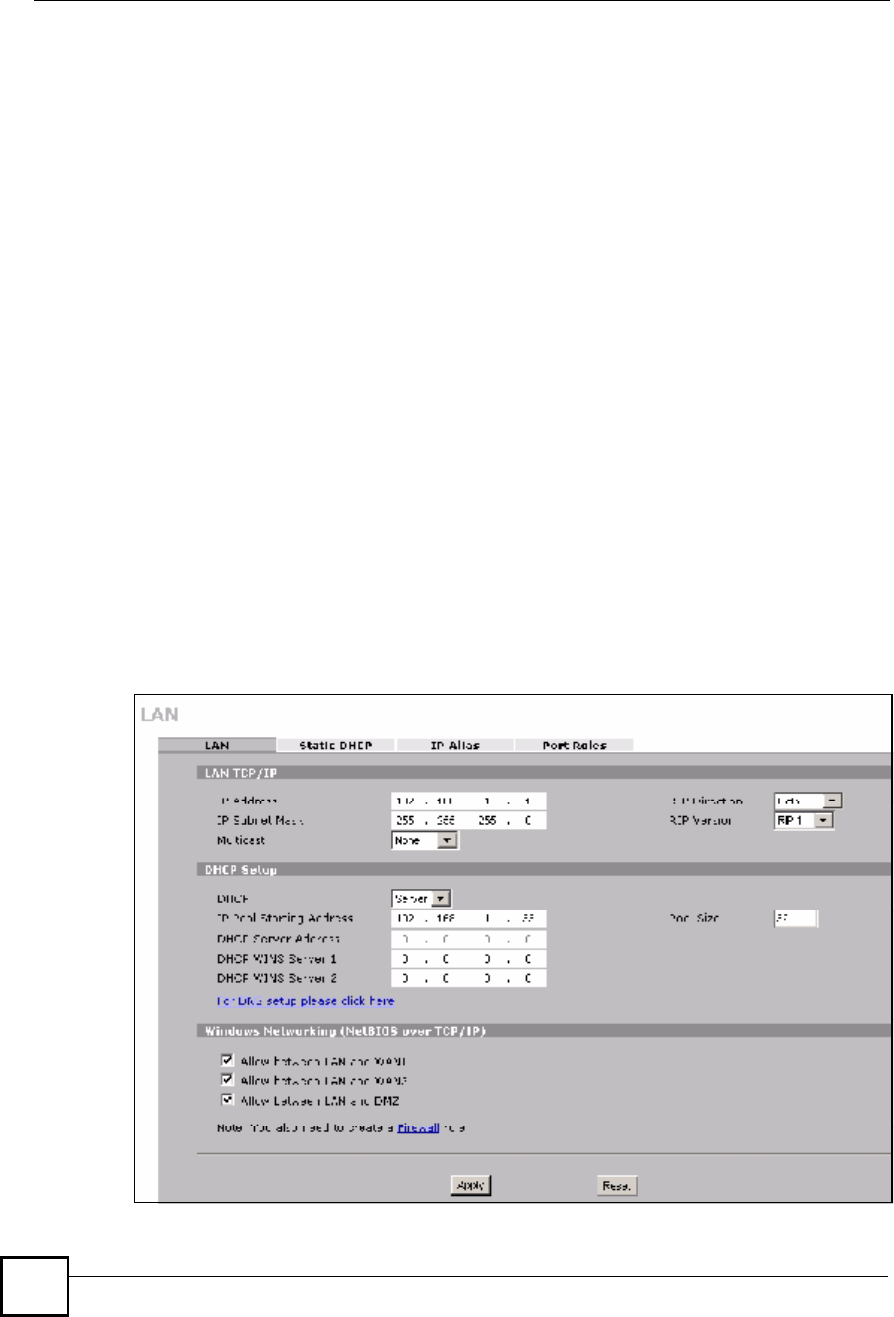
Chapter 5LAN Screens
NBG410W3G Series User s Guide
104
The ZyXEL Device supports both IGMP version 1 (IGMP-v1) and IGMP version 2 (IGMP-
v2). At start up, the ZyXEL Device queries all directly connected networks to gather group
membership. After that, the ZyXEL Device periodically updates this information. IP
multicasting can be enabled/disabled on the ZyXEL Device LAN and/or WAN interfaces in
the web configurator (LAN; WAN). Select None to disable IP multicasting on these
interfaces.
5.6 WINS
WINS (Windows Internet Naming Service) is a Windows implementation of NetBIOS Name
Server (NBNS) on Windows. It keeps track of NetBIOS computer names. It stores a mapping
table of your network!s computer names and IP addresses. The table is dynamically updated
for IP addresses assigned by DHCP. This helps reduce broadcast traffic since computers can
query the server instead of broadcasting a request for a computer name!s IP address. In this
way WINS is similar to DNS, although WINS does not use a hierarchy (unlike DNS). A
network can have more than one WINS server. Samba can also serve as a WINS server.
5.7 LAN
Click NETWORK > LAN to open the LAN screen. Use this screen to configure the ZyXEL
Device!s IP address and other LAN TCP/IP settings as well as the built-in DHCP server
capability that assigns IP addresses and DNS servers to systems that support DHCP client
capability.
Figure 65 NETWORK > LAN

Chapter 5LAN Screens
NBG410W3G Series User s Guide 105
The following table describes the labels in this screen.
Table 12 NETWORK > LAN
LABEL DESCRIPTION
LAN TCP/IP
IP AddressType the IP address of your ZyXEL Device in dotted decimal notation. 192.168.1.1
is the factory default. Alternatively, click the right mouse button to copy and/or
paste the IP address.
IP Subnet MaskThe subnet mask specifies the network number portion of an IP address. Your
ZyXEL Device automatically calculates the subnet mask based on the IP address
that you assign. Unless you are implementing subnetting, use the subnet mask
computed by the ZyXEL Device.
RIP DirectionRIP (Routing Information Protocol, RFC1058 and RFC 1389) allows a router to
exchange routing information with other routers. The RIP Direction field controls
the sending and receiving of RIP packets. Select the RIP direction from Both/In
Only/Out Only/None. When set to Both or Out Only, the ZyXEL Device will
broadcast its routing table periodically. When set to Both or In Only, it will
incorporate the RIP information that it receives; when set to None, it will not send
any RIP packets and will ignore any RIP packets received. Both is the default.
RIP VersionThe RIP Version field controls the format and the broadcasting method of the RIP
packets that the ZyXEL Device sends (it recognizes both formats when receiving).
RIP-1 is universally supported but RIP-2 carries more information. RIP-1 is
probably adequate for most networks, unless you have an unusual network
topology. Both RIP-2B and RIP-2M sends the routing data in RIP-2 format; the
difference being that RIP-2B uses subnet broadcasting while RIP-2M uses
multicasting. Multicasting can reduce the load on non-router machines since they
generally do not listen to the RIP multicast address and so will not receive the RIP
packets. However, if one router uses multicasting, then all routers on your network
must use multicasting, also. By default, RIP direction is set to Both and the Version
set to RIP-1.
MulticastSelect IGMP V-1 or IGMP V-2 or None. IGMP (Internet Group Multicast Protocol)
is a network-layer protocol used to establish membership in a Multicast group - it is
not used to carry user data. IGMP version 2 (RFC 2236) is an improvement over
version 1 (RFC 1112) but IGMP version 1 is still in wide use. If you would like to
read more detailed information about interoperability between IGMP version 2 and
version 1, please see sections 4 and 5 of RFC 2236.
DHCP Setup
DHCP DHCP (Dynamic Host Configuration Protocol, RFC 2131 and RFC 2132) allows
individual clients (workstations) to obtain TCP/IP configuration at startup from a
server. Unless you are instructed by your ISP, leave this field set to Server. When
configured as a server, the ZyXEL Device provides TCP/IP configuration for the
clients. When set as a server, fill in the IP Pool Starting Address and Pool Size
fields.
Select Relay to have the ZyXEL Device forward DHCP requests to another DHCP
server. When set to Relay, fill in the DHCP Server Address field.
Select None to stop the ZyXEL Device from acting as a DHCP server. When you
select None, you must have another DHCP server on your LAN, or else the
computers must be manually configured.
IP Pool Starting
Address
This field specifies the first of the contiguous addresses in the IP address pool.
Pool SizeThis field specifies the size, or count of the IP address pool.
DHCP Server
Address
Type the IP address of the DHCP server to which you want the ZyXEL Device to
relay DHCP requests. Use dotted decimal notation. Alternatively, click the right
mouse button to copy and/or paste the IP address.

Chapter 5LAN Screens
NBG410W3G Series User s Guide
106
5.8 LAN Static DHCP
This table allows you to assign IP addresses on the LAN to specific individual computers
based on their MAC Addresses.
Every Ethernet device has a unique MAC (Media Access Control) address. The MAC address
is assigned at the factory and consists of six pairs of hexadecimal characters, for example,
00:A0:C5:00:00:02.
To change your ZyXEL Device!s static DHCP settings, click NETWORK > LAN > Static
DHCP. The screen appears as shown.
DHCP WINS
Server 1, 2
Type the IP address of the WINS (Windows Internet Naming Service) server that
you want to send to the DHCP clients. The WINS server keeps a mapping table of
the computer names on your network and the IP addresses that they are currently
using.
Windows
Networking
(NetBIOS over
TCP/IP)
NetBIOS (Network Basic Input/Output System) are TCP or UDP packets that
enable a computer to connect to and communicate with a LAN. For some dial-up
services such as PPPoE or PPTP, NetBIOS packets cause unwanted calls.
However it may sometimes be necessary to allow NetBIOS packets to pass
through to the WAN in order to find a computer on the WAN.
Allow between
LAN and WAN1
Select this check box to forward NetBIOS packets from the LAN to WAN 1and from
WAN 1 to the LAN. If your firewall is enabled with the default policy set to block
WAN 1 to LAN traffic, you also need to enable the default WAN 1 to LAN firewall
rule that forwards NetBIOS traffic.
Clear this check box to block all NetBIOS packets going from the LAN to WAN 1
and from WAN 1 to the LAN.
Allow between
LAN and WAN2
Select this check box to forward NetBIOS packets from the LAN to WAN 2 and
from WAN 2 to the LAN. If your firewall is enabled with the default policy set to
block WAN 2 to LAN traffic, you also need to enable the default WAN 2 to LAN
firewall rule that forwards NetBIOS traffic.
Clear this check box to block all NetBIOS packets going from the LAN to WAN 2
and from WAN 2 to the LAN.
Allow between
LAN and DMZ
Select this check box to forward NetBIOS packets from the LAN to the DMZ and
from the DMZ to the LAN. If your firewall is enabled with the default policy set to
block DMZ to LAN traffic, you also need to enable the default DMZ to LAN firewall
rule that forwards NetBIOS traffic.
Clear this check box to block all NetBIOS packets going from the LAN to the DMZ
and from the DMZ to the LAN.
ApplyClick Apply to save your changes.
ResetClick Reset to begin configuring this screen afresh.
Table 12 NETWORK > LAN (continued)
LABEL DESCRIPTION
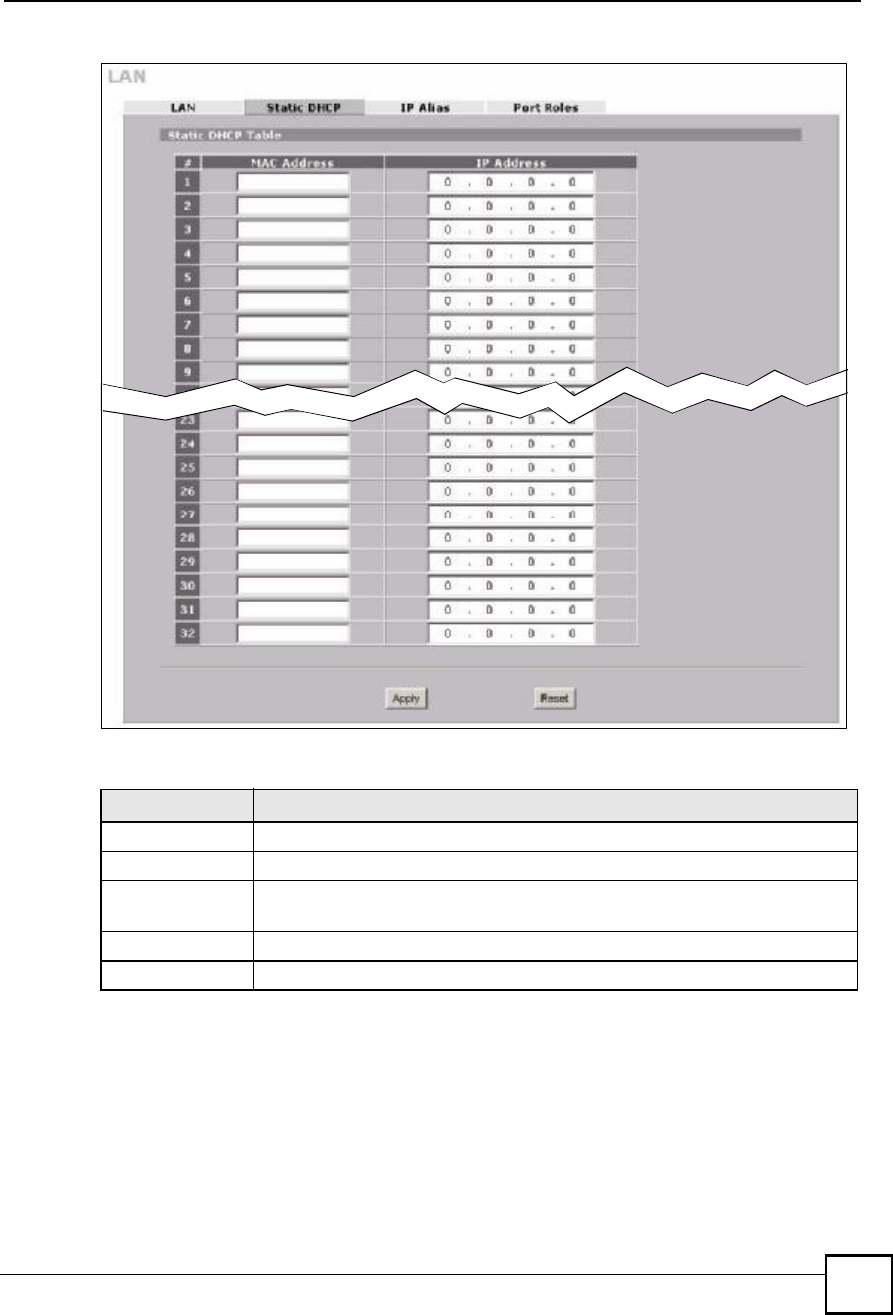
Chapter 5LAN Screens
NBG410W3G Series User s Guide 107
Figure 66 NETWORK > LAN > Static DHCP
The following table describes the labels in this screen.
5.9 LAN IP Alias
IP alias allows you to partition a physical network into different logical networks over the
same Ethernet interface.
The ZyXEL Device has a single LAN interface. Even though more than one of ports 1~4 may
be in the LAN port role, they are all still part of a single physical Ethernet interface and all use
the same IP address.
Table 13 NETWORK > LAN > Static DHCP
LABEL DESCRIPTION
#This is the index number of the Static IP table entry (row).
MAC AddressType the MAC address of a computer on your LAN.
IP AddressType the IP address that you want to assign to the computer on your LAN.
Alternatively, click the right mouse button to copy and/or paste the IP address.
ApplyClick Apply to save your changes.
ResetClick Reset to begin configuring this screen afresh.
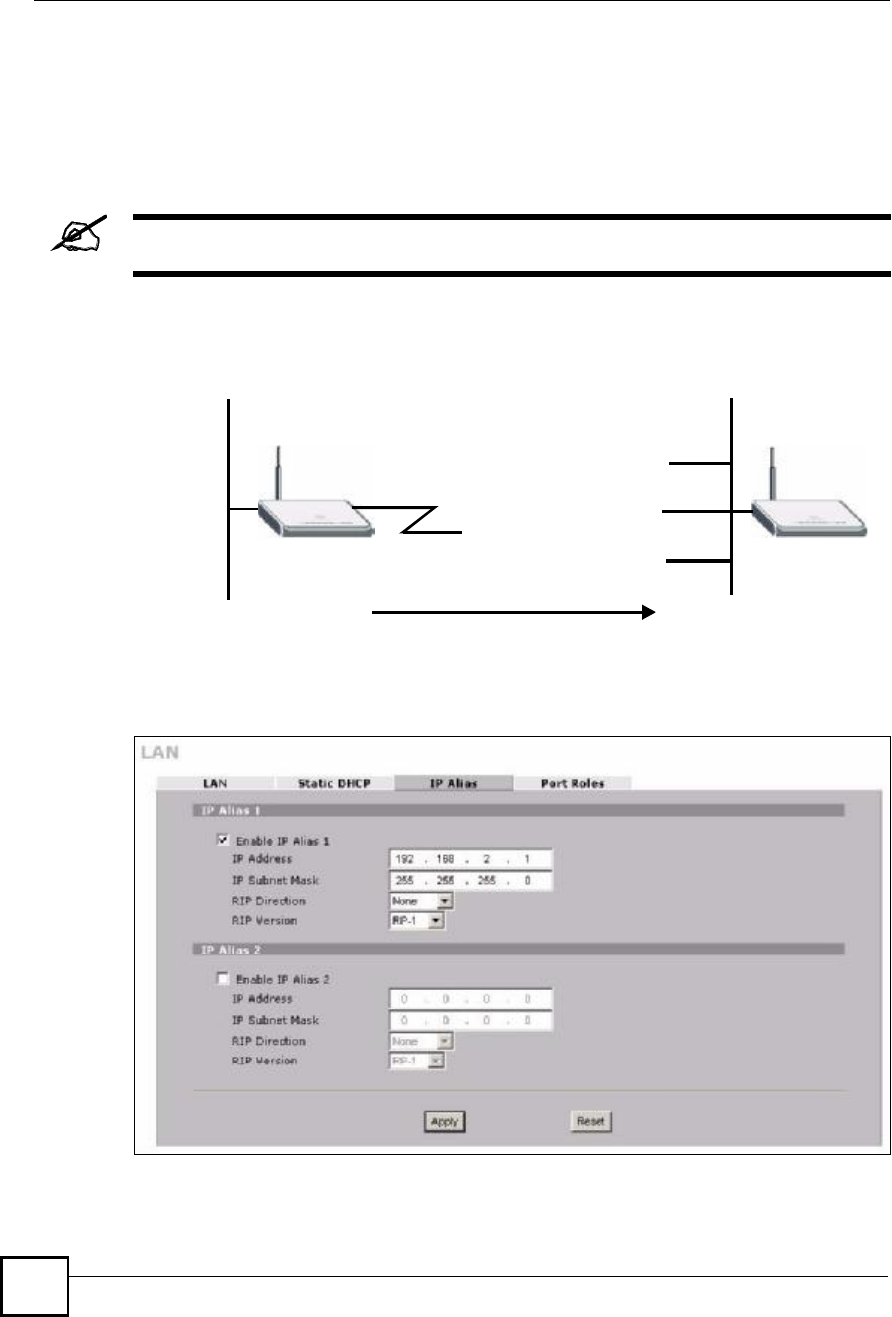
Chapter 5LAN Screens
NBG410W3G Series User s Guide
108
The ZyXEL Device supports three logical LAN interfaces via its single physical LAN
Ethernet interface. The ZyXEL Device itself is the gateway for each of the logical LAN
networks.
When you use IP alias, you can also configure firewall rules to control access between the
LAN's logical networks (subnets).
Make sure that the subnets of the logical networks do not overlap.
The following figure shows a LAN divided into subnets A, B, and C.
Figure 67 Physical Network & Partitioned Logical Networks
To change your ZyXEL Device!s IP alias settings, click NETWORK > LAN > IP Alias. The
screen appears as shown.
Figure 68 NETWORK > LAN > IP Alias
Ethernet
Interface
A: 192.168.1.1 - 192.168.1.24
B: 192.168.2.1 - 192.168.2.24
C: 192.168.3.1 - 192.168.3.24

Chapter 5LAN Screens
NBG410W3G Series User s Guide 109
The following table describes the labels in this screen.
5.10 LAN Port Roles
Use the Port Roles screen to set ports as part of the LAN or DMZ interface.
Ports 1~4 on the ZyXEL Device can be part of the LAN or DMZ interface.
Do the following if you are configuring from a computer connected to a LAN or
DMZ port and changing the port's role:
1A port's IP address varies as its role changes, make sure your computer's IP address is in
the same subnet as the ZyXEL Device's LAN or DMZ IP address.
2Use the appropriate LAN or DMZ IP address to access the ZyXEL Device.
To change your ZyXEL Device!s port role settings, click NETWORK > LAN > Port Roles.
The screen appears as shown.
The radio buttons correspond to Ethernet ports on the front panel of the ZyXEL Device. On
the ZyXEL Device, ports 1 to 4 are all LAN ports by default.
Table 14 NETWORK > LAN > IP Alias
LABEL DESCRIPTION
Enable IP Alias 1,
2
Select the check box to configure another LAN network for the ZyXEL Device.
IP AddressEnter the IP address of your ZyXEL Device in dotted decimal notation.
Alternatively, click the right mouse button to copy and/or paste the IP address.
IP Subnet MaskYour ZyXEL Device will automatically calculate the subnet mask based on the IP
address that you assign. Unless you are implementing subnetting, use the subnet
mask computed by the ZyXEL Device.
RIP DirectionRIP (Routing Information Protocol, RFC 1058 and RFC 1389) allows a router to
exchange routing information with other routers. The RIP Direction field controls
the sending and receiving of RIP packets. Select the RIP direction from Both/In
Only/Out Only/None. When set to Both or Out Only, the ZyXEL Device will
broadcast its routing table periodically. When set to Both or In Only, it will
incorporate the RIP information that it receives; when set to None, it will not send
any RIP packets and will ignore any RIP packets received.
RIP VersionThe RIP Version field controls the format and the broadcasting method of the RIP
packets that the ZyXEL Device sends (it recognizes both formats when receiving).
RIP-1 is universally supported but RIP-2 carries more information. RIP-1 is
probably adequate for most networks, unless you have an unusual network
topology. Both RIP-2B and RIP-2M sends the routing data in RIP-2 format; the
difference being that RIP-2B uses subnet broadcasting while RIP-2M uses
multicasting. Multicasting can reduce the load on non-router machines since they
generally do not listen to the RIP multicast address and so will not receive the RIP
packets. However, if one router uses multicasting, then all routers on your network
must use multicasting, also. By default, RIP direction is set to Both and the
Version set to RIP-1.
ApplyClick Apply to save your changes.
ResetClick Reset to begin configuring this screen afresh.
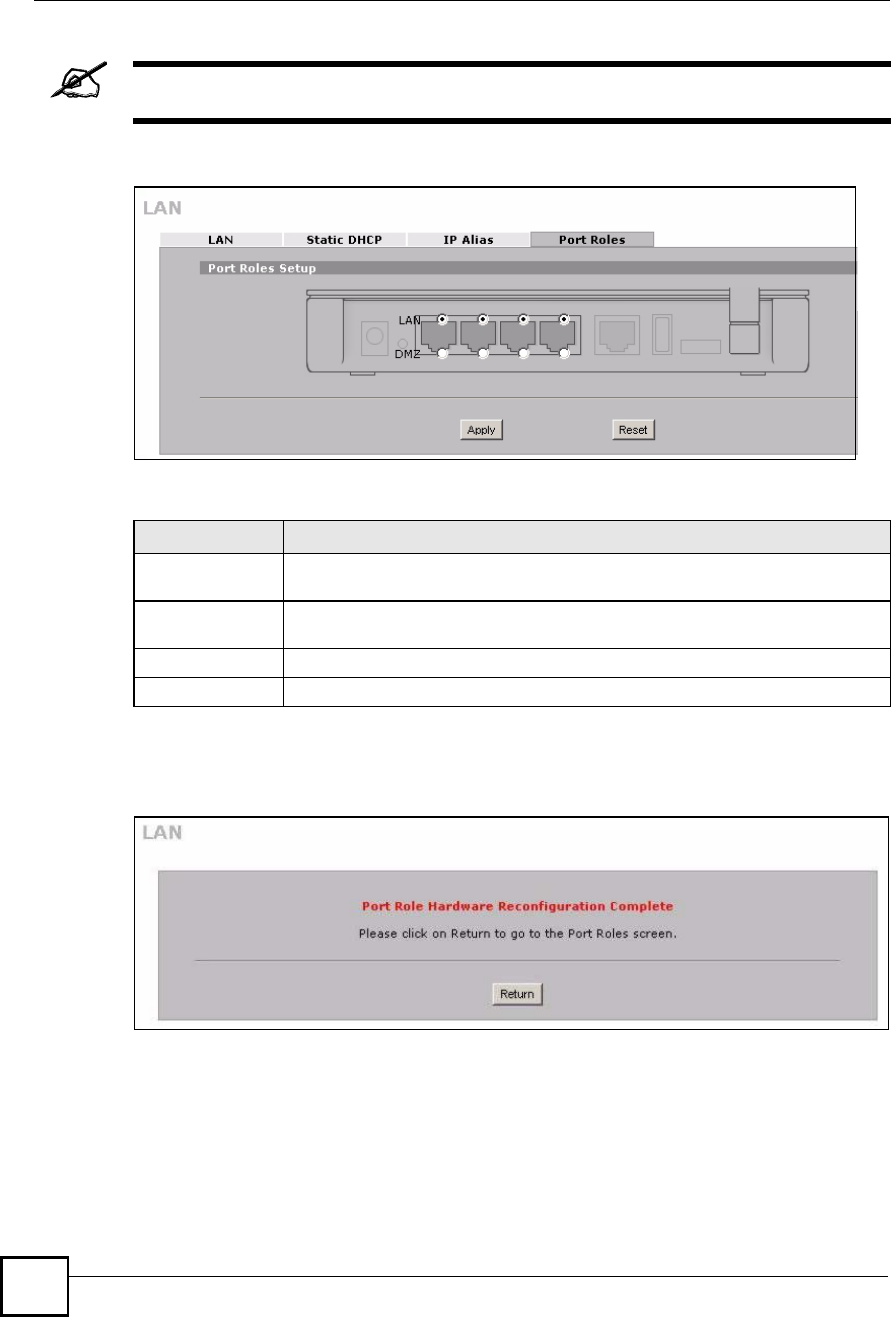
Chapter 5LAN Screens
NBG410W3G Series User s Guide
110
Your changes are also reflected in the DMZ Port Roles screen.
Figure 69 NETWORK > LAN > Port Roles
The following table describes the labels in this screen.
After you change the LAN or DMZ port roles and click Apply, please wait for few seconds
until the following screen appears. Click Return to go back to the Port Roles screen.
Figure 70 Port Roles Change Complete
Table 15 NETWORK > LAN > Port Roles
LABEL DESCRIPTION
LANSelect a port s LAN radio button to use the port as part of the LAN. The port will
use the ZyXEL Device s LAN IP address and MAC address.
DMZSelect a port s DMZ radio button to use the port as part of the DMZ. The port will
use the ZyXEL Device s DMZ IP address and MAC address.
ApplyClick Apply to save your changes.
ResetClick Reset to begin configuring this screen afresh.

NBG410W3G Series User s Guide 111
CHAPTER 6
WAN Screens
This chapter describes how to configure WAN settings.
WAN 2 refers to the 3G card on the supported ZyXEL Device.
6.1 WAN Overview
Use the WAN General screen to configure operation mode, route priority and connection
test for the ZyXEL Device.
Use the WAN 1 screen to configure the WAN1 interface for Internet access on the ZyXEL
Device.
Use the 3G (WAN 2) screen to configure the WAN2 interface for Internet access on the
ZyXEL Device.
Use the Traffic Redirect screen to configure an alternative gateway.
6.2 Multiple WAN
You can use a second connection as a backup to enhance network reliability.
The ZyXEL Device has two WAN ports. You can optionally activate the internal 3G card to
use the second 3G WAN interface. You can connect one interface to one ISP (or network) and
connect the other to a second ISP (or network).
The ZyXEL Device's NAT feature allows you to configure sets of rules for one WAN interface
and separate sets of rules for the other WAN interface. Refer to Chapter 12 on page 225 for
details.
You can select through which WAN interface you want to send out traffic from UPnP-enabled
applications (see Chapter 16 on page 281).
The ZyXEL Device's DDNS lets you select which WAN interface you want to use for each
individual domain name. The DDNS high availability feature lets you have the ZyXEL Device
use the other WAN interface for a domain name if the configured WAN interface's connection
goes down. See Section 14.10.2 on page 256 for details.

Chapter 6WAN Screens
NBG410W3G Series User s Guide
112
6.3 TCP/IP Priority (Metric)
The metric represents the "cost of transmission". A router determines the best route for
transmission by choosing a path with the lowest "cost". RIP routing uses hop count as the
measurement of cost, with a minimum of "1" for directly connected networks. The number
must be between "1" and "15"; a number greater than "15" means the link is down. The
smaller the number, the lower the "cost".
1The metric sets the priority for the ZyXEL Device's routes to the Internet. Each route
must have a unique metric.
2The priorities of the WAN interface routes must always be higher than the traffic redirect
route priorities.
Lets say that you have the WAN operation mode set to active/passive, meaning the ZyXEL
Device use the second highest priority WAN interface as a back up. The WAN 1 route has a
metric of "2", the WAN 2 route has a metric of "3", and the traffic-redirect route has a metric
of "14". In this case, the WAN 1 route acts as the primary default route. If the WAN 1 route
fails to connect to the Internet, the ZyXEL Device tries the WAN 2 route next. If the WAN 2
route fails, the ZyXEL Device tries the traffic-redirect route.
The traffic redirect route cannot take priority over the WAN 1 and WAN 2 routes.
6.4 WAN General
Click NETWORK > WAN to open the General screen. Use this screen to configure operation
mode, route priority and connection test.
WAN 2 refers to the 3G card on the supported ZyXEL Device.
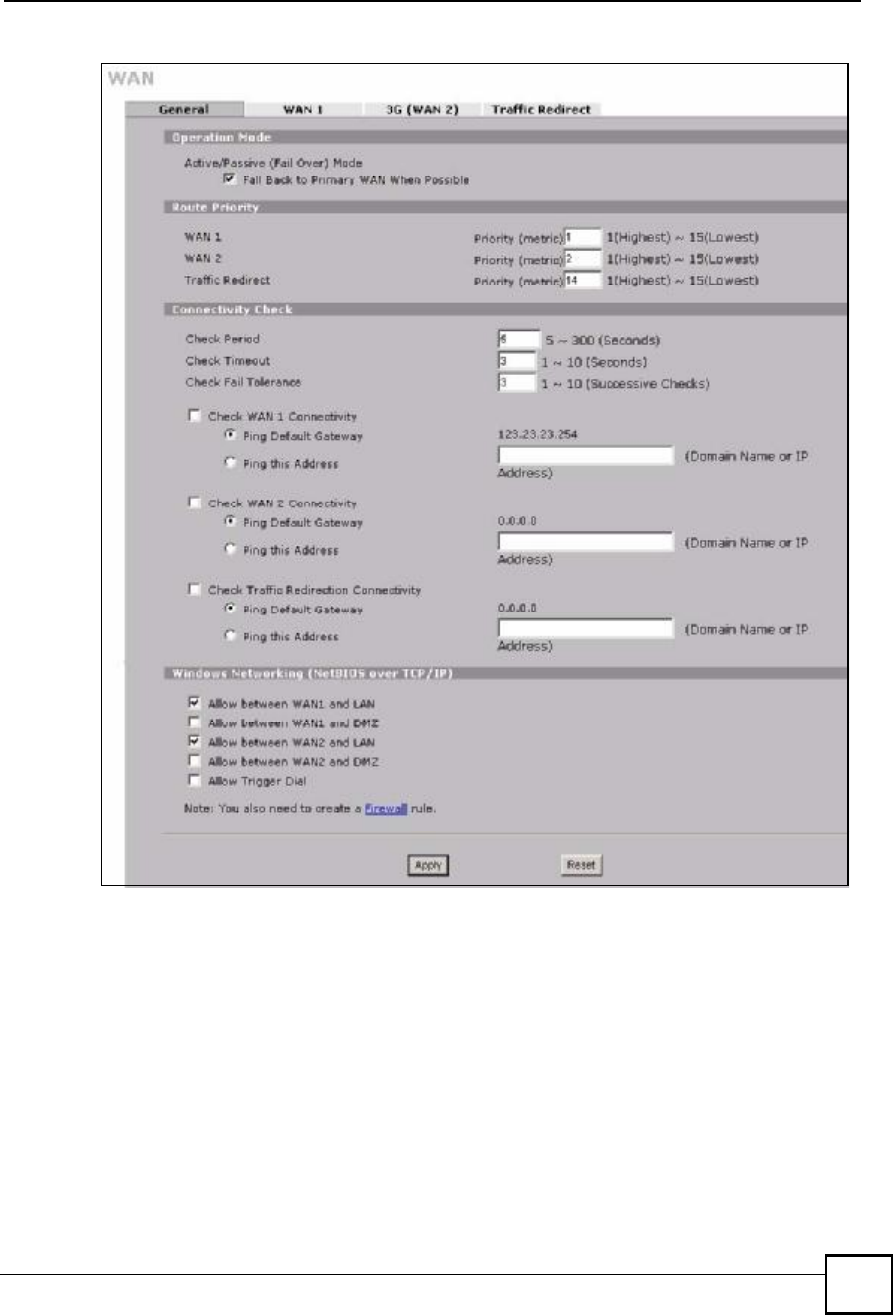
Chapter 6WAN Screens
NBG410W3G Series User s Guide 113
Figure 71 NETWORK > WAN General

Chapter 6WAN Screens
NBG410W3G Series User s Guide
114
The following table describes the labels in this screen.
Table 16 NETWORK > WAN General
LABEL DESCRIPTION
Active/Passive
(Fail Over) Mode
The ZyXEL Device uses the second highest priority WAN interface as a back up.
This means that the ZyXEL Device will normally use the highest priority (primary)
WAN interface (depending on the priorities you configure in the Route Priority
fields). The ZyXEL Device will switch to the secondary (second highest priority)
WAN interface when the primary WAN interface's connection fails.
Fall Back to
Primary WAN
When Possible
This field determines the action the ZyXEL Device takes after the primary WAN
interface fails and the ZyXEL Device starts using the secondary WAN interface.
Select this check box to have the ZyXEL Device change back to using the primary
WAN interface when the ZyXEL Device can connect through the primary WAN
interface again.
Clear this check box to have the ZyXEL Device continue using the secondary WAN
interface, even after the ZyXEL Device can connect through the primary WAN
interface again. The ZyXEL Device continues to use the secondary WAN interface
until it's connection fails (at which time it will change back to using the primary
WAN interface if its connection is up.
Route Priority
WAN1
WAN2
Traffic Redirect
The default WAN connection is "1# as your broadband connection via the WAN
interface should always be your preferred method of accessing the WAN. The
ZyXEL Device switches from WAN interface 1 to WAN interface 2 if WAN interface
1's connection fails and then back to WAN interface 1 when WAN interface 1's
connection comes back up. The default priority of the routes is WAN 1, WAN 2 and
then Traffic Redirect:
You have two choices for an auxiliary connection (WAN 2 and Traffic Redirect) in
the event that your regular WAN connection goes down.
Connectivity
Check
Check PeriodThe ZyXEL Device tests a WAN connection by periodically sending a ping to either
the default gateway or the address in the Ping this Address field.
Type a number of seconds (5 to 300) to set the time interval between checks. Allow
more time if your destination IP address handles lots of traffic.
Check TimeoutType the number of seconds (1 to 10) for your ZyXEL Device to wait for a response
to the ping before considering the check to have failed. This setting must be less
than the Check Period. Use a higher value in this field if your network is busy or
congested.
Check Fail
Tolerance
Type how many WAN connection checks can fail (1-10) before the connection is
considered "down" (not connected). The ZyXEL Device still checks a "down"
connection to detect if it reconnects.
Check WAN1/2
Connectivity
Select the check box to have the ZyXEL Device periodically test the respective
WAN interface's connection.
Select Ping Default Gateway to have the ZyXEL Device ping the WAN interface's
default gateway IP address.
Select Ping this Address and enter a domain name or IP address of a reliable
nearby computer (for example, your ISP's DNS server address) to have the ZyXEL
Device ping that address. For a domain name, use up to 63 alphanumeric
characters (hyphens, periods and the underscore are also allowed) without
spaces.

Chapter 6WAN Screens
NBG410W3G Series User s Guide 115
6.5 WAN IP Address Assignment
Every computer on the Internet must have a unique IP address. If your networks are isolated
from the Internet, for instance, only between your two branch offices, you can assign any IP
addresses to the hosts without problems. However, the Internet Assigned Numbers Authority
(IANA) has reserved the following three blocks of IP addresses specifically for private
networks.
Check Traffic
Redirection
Connectivity
Select the check box to have the ZyXEL Device periodically test the traffic redirect
connection.
Select Ping Default Gateway to have the ZyXEL Device ping the backup
gateway's IP address.
Select Ping this Address and enter a domain name or IP address of a reliable
nearby computer (for example, your ISP's DNS server address) to have the ZyXEL
Device ping that address. For a domain name, use up to 63 alphanumeric
characters (hyphens, periods and the underscore are also allowed) without
spaces.
Windows
Networking
(NetBIOS over
TCP/IP)
NetBIOS (Network Basic Input/Output System) are TCP or UDP packets that
enable a computer to connect to and communicate with a LAN. For some dial-up
services such as PPPoE or PPTP, NetBIOS packets cause unwanted calls.
Allow between
WAN1 and LAN
Select this check box to forward NetBIOS packets from WAN 1 to the LAN port and
from the LAN port to WAN1. If your firewall is enabled with the default policy set to
block WAN 1 to LAN traffic, you also need to enable the default WAN1 to LAN
firewall rule that forwards NetBIOS traffic.
Clear this check box to block all NetBIOS packets going from WAN 1 to the LAN
port and from LAN port to WAN1.
Allow between
WAN1 and DMZ
Select this check box to forward NetBIOS packets from WAN 1 to the DMZ port and
from the DMZ port to WAN1.
Clear this check box to block all NetBIOS packets going from WAN 1 to the DMZ
port and from DMZ port to WAN1.
Allow between
WAN2 and LAN
Select this check box to forward NetBIOS packets from WAN 2 to the LAN port and
from the LAN port to WAN2. If your firewall is enabled with the default policy set to
block WAN 2 to LAN traffic, you also need to enable the default WAN2 to LAN
firewall rule that forwards NetBIOS traffic.
Clear this check box to block all NetBIOS packets going from WAN 2 to the LAN
port and from LAN port to WAN2.
Allow between
WAN2 and DMZ
Select this check box to forward NetBIOS packets from WAN 2 to the DMZ port and
from the DMZ port to WAN2.
Clear this check box to block all NetBIOS packets going from WAN 2 to the DMZ
port and from DMZ port to WAN2.
Allow Trigger DialSelect this option to allow NetBIOS packets to initiate calls.
ApplyClick Apply to save your changes.
ResetClick Reset to begin configuring this screen afresh.
Table 16 NETWORK > WAN General (continued)
LABEL DESCRIPTION
Table 17 Private IP Address Ranges
10.0.0.0-10.255.255.255
172.16.0.0-172.31.255.255
192.168.0.0-192.168.255.255

Chapter 6WAN Screens
NBG410W3G Series User s Guide
116
You can obtain your IP address from the IANA, from an ISP or have it assigned by a private
network. If you belong to a small organization and your Internet access is through an ISP, the
ISP can provide you with the Internet addresses for your local networks. On the other hand, if
you are part of a much larger organization, you should consult your network administrator for
the appropriate IP addresses.
Regardless of your particular situation, do not create an arbitrary IP address;
always follow the guidelines above. For more information on address
assignment, please refer to RFC 1597, Address Allocation for Private Internets
and RFC 1466, Guidelines for Management of IP Address Space.
6.6 DNS Server Address Assignment
Use DNS (Domain Name System) to map a domain name to its corresponding IP address and
vice versa, for instance, the IP address of www.zyxel.com is 204.217.0.2. The DNS server is
extremely important because without it, you must know the IP address of a computer before
you can access it.
The ZyXEL Device can get the DNS server addresses in the following ways.
1The ISP tells you the DNS server addresses, usually in the form of an information sheet,
when you sign up. If your ISP gives you DNS server addresses, manually enter them in
the DNS server fields.
2If your ISP dynamically assigns the DNS server IP addresses (along with the ZyXEL
Device!s WAN IP address), set the DNS server fields to get the DNS server address from
the ISP.
3You can manually enter the IP addresses of other DNS servers. These servers can be
public or private. A DNS server could even be behind a remote IPSec router (see Section
14.5.1 on page 248).
6.7 WAN MAC Address
Every Ethernet device has a unique MAC (Media Access Control) address. The MAC address
is assigned at the factory and consists of six pairs of hexadecimal characters, for example,
00:A0:C5:00:00:02.
You can configure the WAN port's MAC address by either using the factory default or cloning
the MAC address from a computer on your LAN. Once it is successfully configured, the
address will be copied to the "rom" file (ZyNOS configuration file). It will not change unless
you change the setting or upload a different "rom" file.
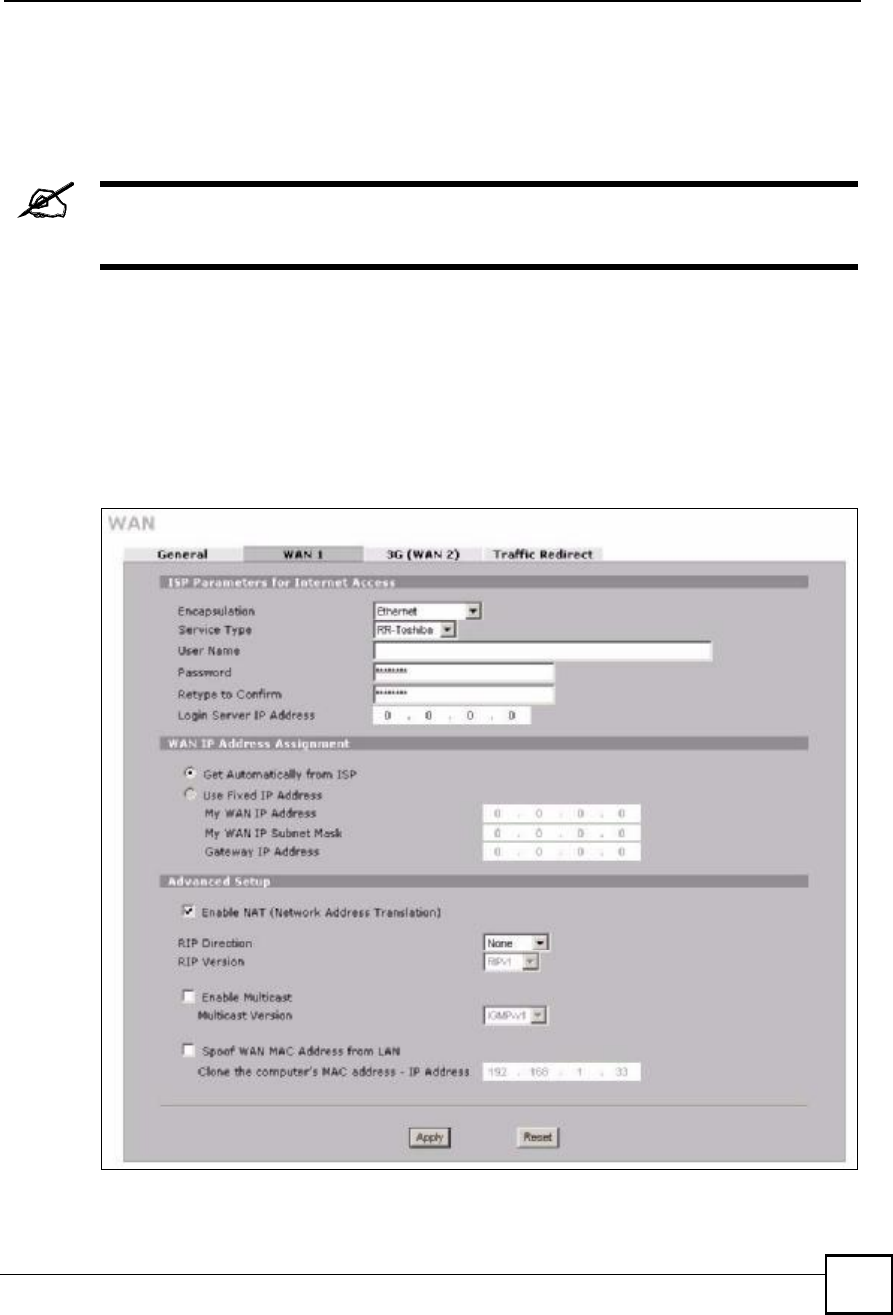
Chapter 6WAN Screens
NBG410W3G Series User s Guide 117
6.8 WAN 1
Use this screen to change your ZyXEL Device's WAN 1 ISP, IP and MAC settings. Click
NETWORK > WAN > WAN 1 to display this screen. The screen differs by the encapsulation.
The WAN 1 and WAN 2 IP addresses of a ZyXEL Device with multiple WAN
interfaces must be on different subnets.
6.8.1 WAN Ethernet Encapsulation
For ISPs (such as Telstra) that send UDP heartbeat packets to verify that the customer is still
online, please create a WAN-to-WAN/ZyXEL Device firewall rule for those packets. Contact
your ISP to find the correct port number.
The screen shown next is for Ethernet encapsulation.
Figure 72 NETWORK > WAN > WAN 1 (Ethernet Encapsulation)

Chapter 6WAN Screens
NBG410W3G Series User s Guide
118
The following table describes the labels in this screen.
Table 18 NETWORK > WAN > WAN 1 (Ethernet Encapsulation)
LABEL DESCRIPTION
ISP Parameters
for Internet
Access
EncapsulationYou must choose the Ethernet option when the WAN port is used as a regular
Ethernet.
Service TypeChoose from Standard, Telstra (RoadRunner Telstra authentication method), RR-
Manager (Roadrunner Manager authentication method), RR-Toshiba
(Roadrunner Toshiba authentication method) or Telia Login.
The following fields do not appear with the Standard service type.
User NameType the user name given to you by your ISP.
PasswordType the password associated with the user name above.
Retype to
Confirm
Type your password again to make sure that you have entered is correctly.
Login Server IP
Address
Type the authentication server IP address here if your ISP gave you one.
This field is not available for Telia Login.
Login Server
(Telia Login only)
Type the domain name of the Telia login server, for example login1.telia.com.
Relogin
Every(min)
(Telia Login only)
The Telia server logs the ZyXEL Device out if the ZyXEL Device does not log in
periodically. Type the number of minutes from 1 to 59 (30 default) for the ZyXEL
Device to wait between logins.
WAN IP Address
Assignment
Get automatically
from ISP
Select this option If your ISP did not assign you a fixed IP address. This is the
default selection.
Use Fixed IP
Address
Select this option If the ISP assigned a fixed IP address.
My WAN IP
Address
Enter your WAN IP address in this field if you selected Use Fixed IP Address.
My WAN IP
Subnet Mask
Enter the IP subnet mask (if your ISP gave you one) in this field if you selected Use
Fixed IP Address.
Gateway IP
Address
Enter the gateway IP address (if your ISP gave you one) in this field if you selected
Use Fixed IP Address.
Advanced Setup
Enable NAT
(Network
Address
Translation)
Network Address Translation (NAT) allows the translation of an Internet protocol
address used within one network (for example a private IP address used in a local
network) to a different IP address known within another network (for example a
public IP address used on the Internet).
Select this check box to enable NAT.

Chapter 6WAN Screens
NBG410W3G Series User s Guide 119
RIP DirectionRIP (Routing Information Protocol) allows a router to exchange routing information
with other routers. The RIP Direction field controls the sending and receiving of
RIP packets.
Choose Both, None, In Only or Out Only.
When set to Both or Out Only, the ZyXEL Device will broadcast its routing table
periodically.
When set to Both or In Only, the ZyXEL Device will incorporate RIP information
that it receives.
When set to None, the ZyXEL Device will not send any RIP packets and will ignore
any RIP packets received.
By default, RIP Direction is set to Both.
RIP VersionThe RIP Version field controls the format and the broadcasting method of the RIP
packets that the ZyXEL Device sends (it recognizes both formats when receiving).
Choose RIP-1, RIP-2B or RIP-2M.
RIP-1 is universally supported; but RIP-2 carries more information. RIP-1 is
probably adequate for most networks, unless you have an unusual network
topology. Both RIP-2B and RIP-2M sends the routing data in RIP-2 format; the
difference being that RIP-2B uses subnet broadcasting while RIP-2M uses
multicasting. Multicasting can reduce the load on non-router machines since they
generally do not listen to the RIP multicast address and so will not receive the RIP
packets. However, if one router uses multicasting, then all routers on your network
must use multicasting, also. By default, the RIP Version field is set to RIP-1.
Enable MulticastSelect this check box to turn on IGMP (Internet Group Multicast Protocol). IGMP is
a network-layer protocol used to establish membership in a Multicast group - it is
not used to carry user data.
Multicast VersionChoose None (default), IGMP-V1 or IGMP-V2. IGMP (Internet Group Multicast
Protocol) is a session-layer protocol used to establish membership in a Multicast
group $ it is not used to carry user data. IGMP version 2 (RFC 2236) is an
improvement over version 1 (RFC 1112) but IGMP version 1 is still in wide use. If
you would like to read more detailed information about interoperability between
IGMP version 2 and version 1, please see sections 4 and 5 of RFC 2236.
Spoof WAN MAC
Address from
LAN
You can configure the WAN port's MAC address by either using the factory
assigned default MAC Address or cloning the MAC address of a computer on your
LAN. By default, the ZyXEL Device uses the factory assigned MAC Address to
identify itself on the WAN.
Otherwise, select the check box next to Spoof WAN MAC Address from LAN and
enter the IP address of the computer on the LAN whose MAC you are cloning.
Once it is successfully configured, the address will be copied to the rom file
(ZyNOS configuration file). It will not change unless you change the setting or
upload a different ROM file.
Clone the
computer s MAC
address $ IP
Address
Enter the IP address of the computer on the LAN whose MAC you are cloning.
If you clone the MAC address of a computer on your LAN, it is recommended that
you clone the MAC address prior to hooking up the WAN port.
ApplyClick Apply to save your changes.
ResetClick Reset to begin configuring this screen afresh.
Table 18 NETWORK > WAN > WAN 1 (Ethernet Encapsulation) (continued)
LABEL DESCRIPTION

Chapter 6WAN Screens
NBG410W3G Series User s Guide
120
6.8.2 PPPoE Encapsulation
The ZyXEL Device supports PPPoE (Point-to-Point Protocol over Ethernet). PPPoE is an
IETF standard (RFC 2516) specifying how a personal computer (PC) interacts with a
broadband modem (DSL, cable, wireless, etc.) connection. The PPPoE option is for a dial-up
connection using PPPoE.
For the service provider, PPPoE offers an access and authentication method that works with
existing access control systems (for example RADIUS).
One of the benefits of PPPoE is the ability to let you access one of multiple network services,
a function known as dynamic service selection. This enables the service provider to easily
create and offer new IP services for individuals.
Operationally, PPPoE saves significant effort for both you and the ISP or carrier, as it requires
no specific configuration of the broadband modem at the customer site.
By implementing PPPoE directly on the ZyXEL Device (rather than individual computers),
the computers on the LAN do not need PPPoE software installed, since the ZyXEL Device
does that part of the task. Furthermore, with NAT, all of the LANs! computers will have
access.
The screen shown next is for PPPoE encapsulation.
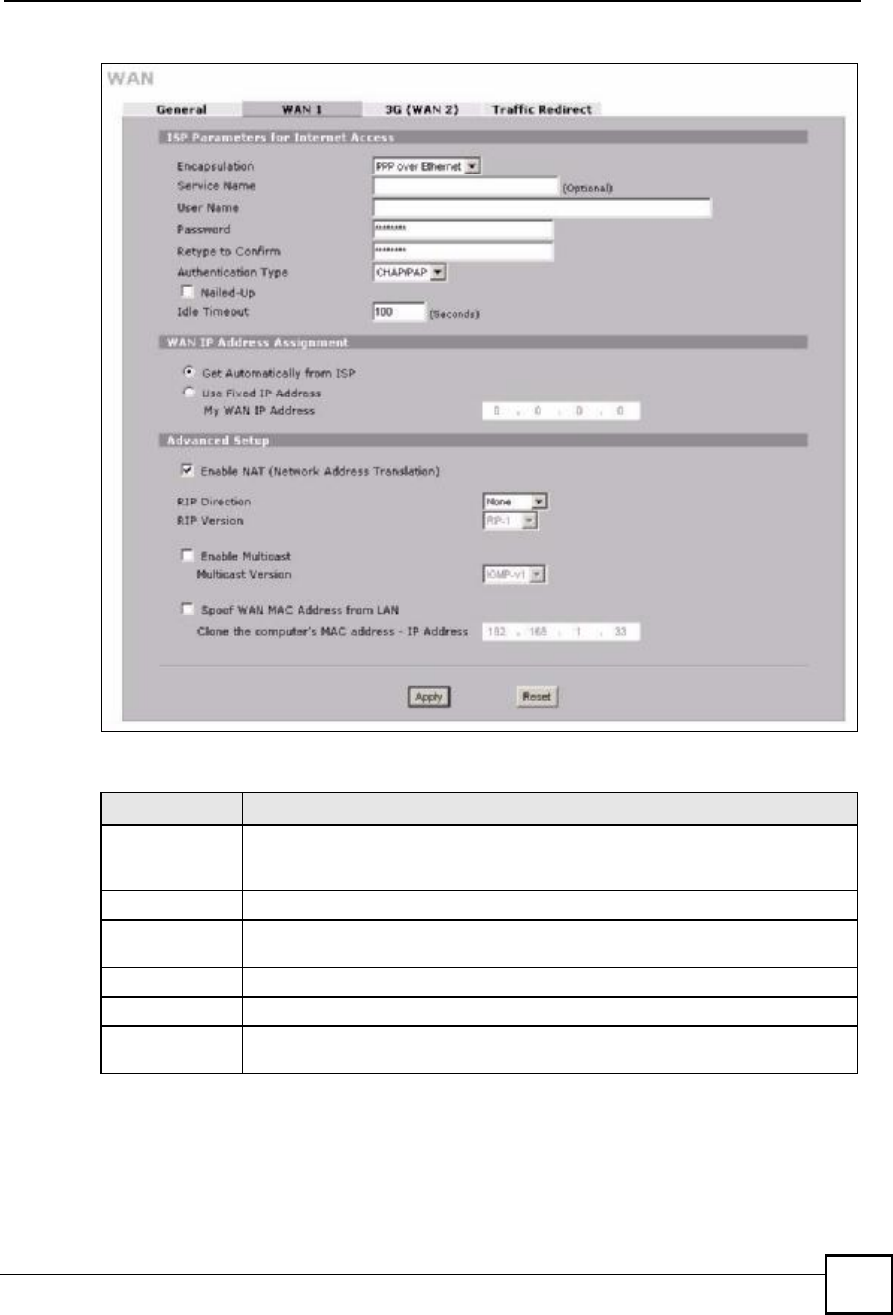
Chapter 6WAN Screens
NBG410W3G Series User s Guide 121
Figure 73 NETWORK > WAN > WAN 1 (PPPoE Encapsulation)
The following table describes the labels in this screen.
Table 19 NETWORK > WAN > WAN 1 (PPPoE Encapsulation)
LABEL DESCRIPTION
ISP Parameters
for Internet
Access
EncapsulationSelect PPPoE for a dial-up connection using PPPoE.
Service NameType the PPPoE service name provided to you by your ISP. PPPoE uses a service
name to identify and reach the PPPoE server.
User NameType the user name given to you by your ISP.
PasswordType the password associated with the user name above.
Retype to
Confirm
Type your password again to make sure that you have entered is correctly.

Chapter 6WAN Screens
NBG410W3G Series User s Guide
122
Authentication
Type
The ZyXEL Device supports PAP (Password Authentication Protocol) and CHAP
(Challenge Handshake Authentication Protocol). CHAP is more secure than PAP;
however, PAP is readily available on more platforms.
Use the drop-down list box to select an authentication protocol for outgoing calls.
Options are:
CHAP/PAP - Your ZyXEL Device accepts either CHAP or PAP when requested by
this remote node.
CHAP - Your ZyXEL Device accepts CHAP only.
PAP - Your ZyXEL Device accepts PAP only.
Nailed-Up Select Nailed-Up if you do not want the connection to time out.
Idle TimeoutThis value specifies the time in seconds that elapses before the ZyXEL Device
automatically disconnects from the PPPoE server.
WAN IP Address
Assignment
Get
automatically
from ISP
Select this option If your ISP did not assign you a fixed IP address. This is the
default selection.
Use Fixed IP
Address
Select this option If the ISP assigned a fixed IP address.
My WAN IP
Address
Enter your WAN IP address in this field if you selected Use Fixed IP Address.
Advanced Setup
Enable NAT
(Network
Address
Translation)
Network Address Translation (NAT) allows the translation of an Internet protocol
address used within one network (for example a private IP address used in a local
network) to a different IP address known within another network (for example a
public IP address used on the Internet).
Select this checkbox to enable NAT.
For more information about NAT see Chapter 12 on page 225.
RIP DirectionRIP (Routing Information Protocol) allows a router to exchange routing information
with other routers. The RIP Direction field controls the sending and receiving of
RIP packets.
Choose Both, None, In Only or Out Only.
When set to Both or Out Only, the ZyXEL Device will broadcast its routing table
periodically.
When set to Both or In Only, the ZyXEL Device will incorporate RIP information
that it receives.
When set to None, the ZyXEL Device will not send any RIP packets and will ignore
any RIP packets received.
By default, RIP Direction is set to Both.
RIP VersionThe RIP Version field controls the format and the broadcasting method of the RIP
packets that the ZyXEL Device sends (it recognizes both formats when receiving).
Choose RIP-1, RIP-2B or RIP-2M.
RIP-1 is universally supported; but RIP-2 carries more information. RIP-1 is
probably adequate for most networks, unless you have an unusual network
topology. Both RIP-2B and RIP-2M sends the routing data in RIP-2 format; the
difference being that RIP-2B uses subnet broadcasting while RIP-2M uses
multicasting. Multicasting can reduce the load on non-router machines since they
generally do not listen to the RIP multicast address and so will not receive the RIP
packets. However, if one router uses multicasting, then all routers on your network
must use multicasting, also. By default, the RIP Version field is set to RIP-1.
Table 19 NETWORK > WAN > WAN 1 (PPPoE Encapsulation) (continued)
LABEL DESCRIPTION

Chapter 6WAN Screens
NBG410W3G Series User s Guide 123
6.8.3 PPTP Encapsulation
Point-to-Point Tunneling Protocol (PPTP) is a network protocol that enables secure transfer of
data from a remote client to a private server, creating a Virtual Private Network (VPN) using
TCP/IP-based networks.
PPTP supports on-demand, multi-protocol and virtual private networking over public
networks, such as the Internet. The screen shown next is for PPTP encapsulation.
Enable MulticastSelect this check box to turn on IGMP (Internet Group Multicast Protocol). IGMP is
a network-layer protocol used to establish membership in a Multicast group - it is
not used to carry user data.
Multicast VersionChoose None (default), IGMP-V1 or IGMP-V2. IGMP (Internet Group Multicast
Protocol) is a session-layer protocol used to establish membership in a Multicast
group $ it is not used to carry user data. IGMP version 2 (RFC 2236) is an
improvement over version 1 (RFC 1112) but IGMP version 1 is still in wide use. If
you would like to read more detailed information about interoperability between
IGMP version 2 and version 1, please see sections 4 and 5 of RFC 2236.
Spoof WAN MAC
Address from
LAN
You can configure the WAN port's MAC address by either using the factory
assigned default MAC Address or cloning the MAC address of a computer on your
LAN. By default, the ZyXEL Device uses the factory assigned MAC Address to
identify itself on the WAN.
Otherwise, select the check box next to Spoof WAN MAC Address from LAN and
enter the IP address of the computer on the LAN whose MAC you are cloning.
Once it is successfully configured, the address will be copied to the rom file
(ZyNOS configuration file). It will not change unless you change the setting or
upload a different ROM file.
Clone the
computer s MAC
address $ IP
Address
Enter the IP address of the computer on the LAN whose MAC you are cloning.
If you clone the MAC address of a computer on your LAN, it is recommended that
you clone the MAC address prior to hooking up the WAN port.
ApplyClick Apply to save your changes.
ResetClick Reset to begin configuring this screen afresh.
Table 19 NETWORK > WAN > WAN 1 (PPPoE Encapsulation) (continued)
LABEL DESCRIPTION
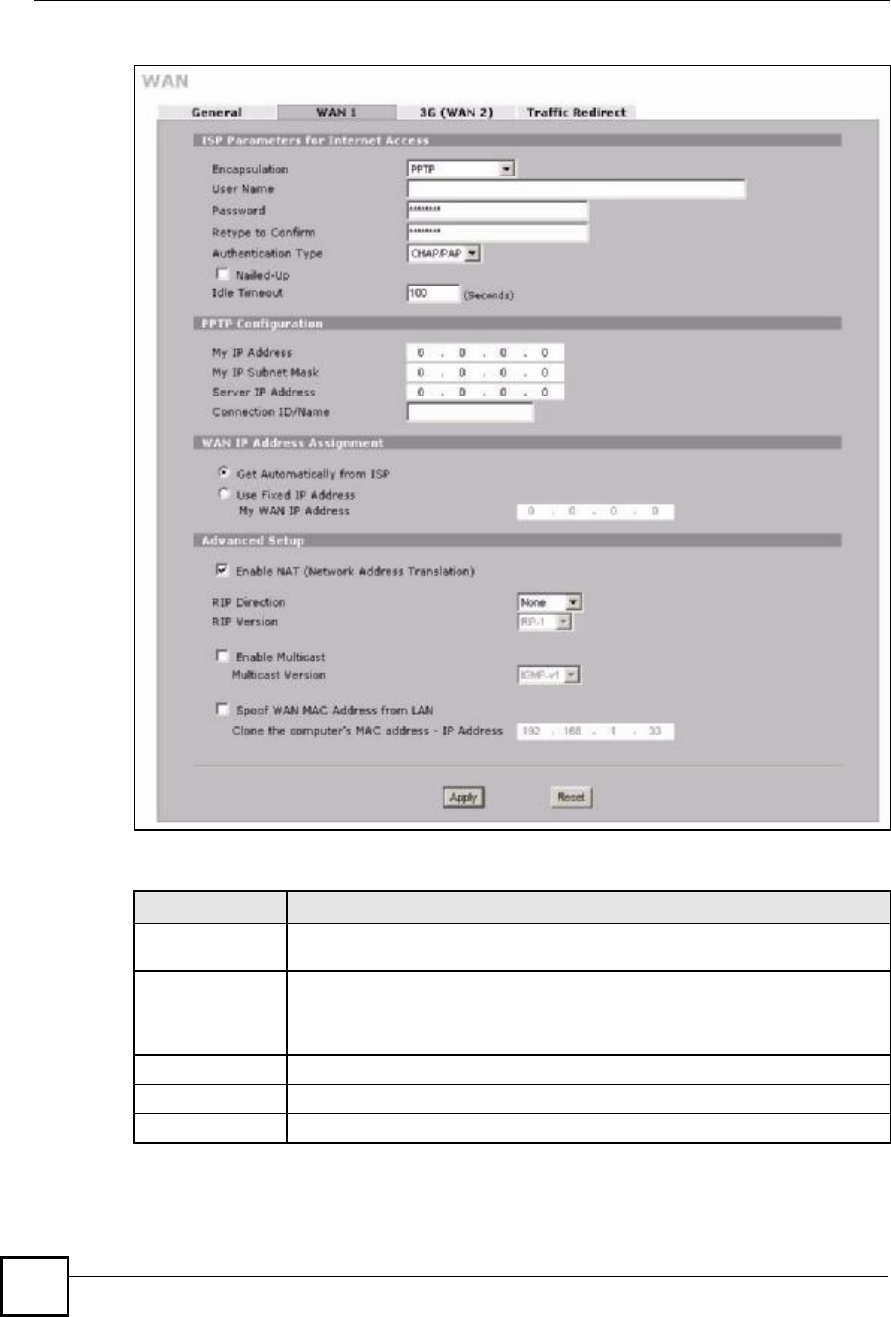
Chapter 6WAN Screens
NBG410W3G Series User s Guide
124
Figure 74 NETWORK > WAN > WAN 1 (PPTP Encapsulation)
The following table describes the labels in this screen.
Table 20 NETWORK > WAN > WAN 1 (PPTP Encapsulation)
LABEL DESCRIPTION
ISP Parameters
for Internet Access
EncapsulationSet the encapsulation method to PPTP. The ZyXEL Device supports only one
PPTP server connection at any given time. To configure a PPTP client, you must
configure the User Name and Password fields for a PPP connection and the
PPTP parameters for a PPTP connection.
User NameType the user name given to you by your ISP.
PasswordType the password associated with the user name above.
Retype to ConfirmType your password again to make sure that you have entered it correctly.

Chapter 6WAN Screens
NBG410W3G Series User s Guide 125
Authentication
Type
The ZyXEL Device supports PAP (Password Authentication Protocol) and CHAP
(Challenge Handshake Authentication Protocol). CHAP is more secure than PAP;
however, PAP is readily available on more platforms.
Use the drop-down list box to select an authentication protocol for outgoing calls.
Options are:
CHAP/PAP - Your ZyXEL Device accepts either CHAP or PAP when requested
by this remote node.
CHAP - Your ZyXEL Device accepts CHAP only.
PAP - Your ZyXEL Device accepts PAP only.
Nailed-upSelect Nailed-Up if you do not want the connection to time out.
Idle TimeoutThis value specifies the time in seconds that elapses before the ZyXEL Device
automatically disconnects from the PPTP server.
PPTP
Configuration
My IP AddressType the (static) IP address assigned to you by your ISP.
My IP Subnet
Mask
Your ZyXEL Device will automatically calculate the subnet mask based on the IP
address that you assign. Unless you are implementing subnetting, use the subnet
mask computed by the ZyXEL Device.
Server IP AddressType the IP address of the PPTP server.
Connection ID/
Name
Type your identification name for the PPTP server.
WAN IP Address
Assignment
Get automatically
from ISP
Select this option If your ISP did not assign you a fixed IP address. This is the
default selection.
Use Fixed IP
Address
Select this option If the ISP assigned a fixed IP address.
My WAN IP
Address
Enter your WAN IP address in this field if you selected Use Fixed IP Address.
Advanced Setup
Enable NAT
(Network Address
Translation)
Network Address Translation (NAT) allows the translation of an Internet protocol
address used within one network (for example a private IP address used in a local
network) to a different IP address known within another network (for example a
public IP address used on the Internet).
Select this checkbox to enable NAT.
For more information about NAT see Chapter 12 on page 225.
RIP DirectionRIP (Routing Information Protocol) allows a router to exchange routing
information with other routers. The RIP Direction field controls the sending and
receiving of RIP packets.
Choose Both, None, In Only or Out Only.
When set to Both or Out Only, the ZyXEL Device will broadcast its routing table
periodically.
When set to Both or In Only, the ZyXEL Device will incorporate RIP information
that it receives.
When set to None, the ZyXEL Device will not send any RIP packets and will
ignore any RIP packets received.
By default, RIP Direction is set to Both.
Table 20 NETWORK > WAN > WAN 1 (PPTP Encapsulation) (continued)
LABEL DESCRIPTION

Chapter 6WAN Screens
NBG410W3G Series User s Guide
126
6.9 3G (WAN 2)
3G (Third Generation) is a digital, packet-switched wireless technology. Bandwidth usage is
optimized as multiple users share the same channel and bandwidth is only allocated to users
when they send data. It allows fast transfer of voice and non-voice data and provides
broadband Internet access to mobile devices.
RIP VersionThe RIP Version field controls the format and the broadcasting method of the RIP
packets that the ZyXEL Device sends (it recognizes both formats when
receiving).
Choose RIP-1, RIP-2B or RIP-2M.
RIP-1 is universally supported; but RIP-2 carries more information. RIP-1 is
probably adequate for most networks, unless you have an unusual network
topology. Both RIP-2B and RIP-2M sends the routing data in RIP-2 format; the
difference being that RIP-2B uses subnet broadcasting while RIP-2M uses
multicasting. Multicasting can reduce the load on non-router machines since they
generally do not listen to the RIP multicast address and so will not receive the RIP
packets. However, if one router uses multicasting, then all routers on your
network must use multicasting, also. By default, the RIP Version field is set to
RIP-1.
Enable MulticastSelect this check box to turn on IGMP (Internet Group Multicast Protocol). IGMP
is a network-layer protocol used to establish membership in a Multicast group - it
is not used to carry user data.
Multicast VersionChoose None (default), IGMP-V1 or IGMP-V2. IGMP (Internet Group Multicast
Protocol) is a session-layer protocol used to establish membership in a Multicast
group $ it is not used to carry user data. IGMP version 2 (RFC 2236) is an
improvement over version 1 (RFC 1112) but IGMP version 1 is still in wide use. If
you would like to read more detailed information about interoperability between
IGMP version 2 and version 1, please see sections 4 and 5 of RFC 2236.
Spoof WAN MAC
Address from LAN
You can configure the WAN port's MAC address by either using the factory
assigned default MAC Address or cloning the MAC address of a computer on
your LAN. By default, the ZyXEL Device uses the factory assigned MAC Address
to identify itself on the WAN.
Otherwise, select the check box next to Spoof WAN MAC Address from LAN
and enter the IP address of the computer on the LAN whose MAC you are
cloning. Once it is successfully configured, the address will be copied to the rom
file (ZyNOS configuration file). It will not change unless you change the setting or
upload a different ROM file.
Clone the
computer s MAC
address $ IP
Address
Enter the IP address of the computer on the LAN whose MAC you are cloning.
If you clone the MAC address of a computer on your LAN, it is recommended that
you clone the MAC address prior to hooking up the WAN port.
ApplyClick Apply to save your changes.
ResetClick Reset to begin configuring this screen afresh.
Table 20 NETWORK > WAN > WAN 1 (PPTP Encapsulation) (continued)
LABEL DESCRIPTION

Chapter 6WAN Screens
NBG410W3G Series User s Guide 127
The actual data rate you obtain varies depending on your 3G card, the signal
strength of the service provider s base station, your service plan, etc.
If the signal strength of a 3G network is too low, the 3G card may switch to an available 2.5G
or 2.75G network. See the following table for a comparison between 2G, 2.5G, 2.75G, 3G and
3.5G wireless technologies.
After you activate 3G on your ZyXEL Device, the 3G connection becomes WAN 2. Refer to
the Chapter 22 on page 345 for the type of 3G cards that you can use in the ZyXEL Device
along with the corresponding supported features.
To change your ZyXEL Device's 3G WAN settings, click NETWORK > WAN > 3G (WAN
2) or WIRELESS > 3G (WAN 2).
Table 21 2G, 2.5G, 2.75G, 3G and 3.5G Wireless Technologies
NAME TYPE
MOBILE PHONE AND DATA STANDARDS DATA
SPEED
GSM-BASED CDMA-BASED
2G Circuit-
switched
GSM (Global System for Mobile
Communications), Personal Handy-
phone System (PHS), etc.
Interim Standard 95 (IS-95), the first
CDMA-based digital cellular standard
pioneered by Qualcomm. The brand
name for IS-95 is cdmaOne. IS-95 is
also known as TIA-EIA-95.
Slow
Fast
2.5GPacket-
switched
GPRS (General Packet Radio
Services), High-Speed Circuit-
Switched Data (HSCSD), etc.
CDMA2000 is a hybrid 2.5G / 3G
protocol of mobile telecommunications
standards that use CDMA, a multiple
access scheme for digital radio.
CDMA2000 1xRTT (1 times Radio
Transmission Technology) is the core
CDMA2000 wireless air interface
standard. It is also known as 1x, 1xRTT,
or IS-2000 and considered to be a 2.5G
or 2.75G technology.
2.75GPacket-
switched
Enhanced Data rates for GSM
Evolution (EDGE), Enhanced GPRS
(EGPRS), etc.
3G Packet-
switched
UMTS (Universal Mobile
Telecommunications System), a third-
generation (3G) wireless standard
defined in ITUA specification, is
sometimes marketed as 3GSM. The
UMTS uses GSM infrastructures and
W-CDMA (Wideband Code Division
Multiple Access) as the air interface.
CDMA2000 EV-DO (Evolution-Data
Optimized, originally 1x Evolution-Data
Only), also referred to as EV-DO, EVDO,
or just EV, is an evolution of CDMA2000
1xRTT and enables high-speed wireless
connectivity. It is also denoted as IS-856
or High Data Rate (HDR).
3.5GPacket-
switched
HSDPA (High-Speed Downlink Packet
Access) is a mobile telephony
protocol, used for UMTS-based 3G
networks and allows for higher data
transfer speeds.
A.The International Telecommunication Union (ITU) is an international organization within which governments and the private sector
coordinate global telecom networks and services.
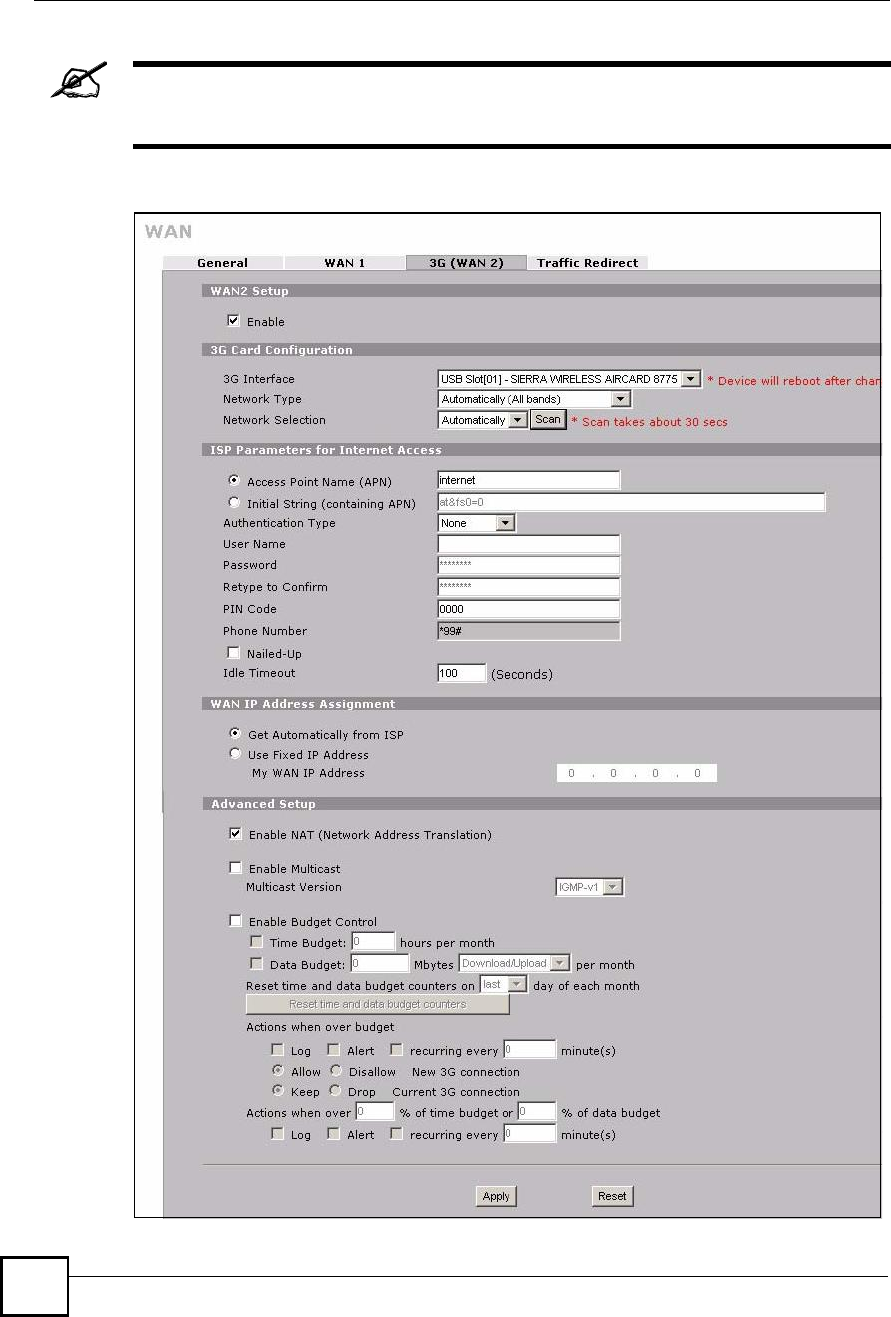
Chapter 6WAN Screens
NBG410W3G Series User s Guide
128
The WAN 1 and WAN 2 IP addresses of a ZyXEL Device with multiple WAN
interfaces must be on different subnets.
Figure 75 NETWORK > WAN > 3G (WAN 2)

Chapter 6WAN Screens
NBG410W3G Series User s Guide 129
The following table describes the labels in this screen.
Table 22 NETWORK > WAN > 3G (WAN 2)
LABEL DESCRIPTION
WAN2 Setup
EnableSelect this option to enable WAN 2. The Network Type and Network Selection
fields appear.
3G Card
Configuration
3G Interface This displays the model of the 3G card installed in your ZyXEL Device.
Network TypeSelect the type of 3G service and frequency band for your 3G connection. If you
are unsure what to select, check with your 3G service provider to find the 3G
service available to you in your region.
Select Automatically (All bands) to have the card connect to the highest speed
network available. Once connected the ZyXEL Device will continue searching for
and connecting to the highest speed network as it becomes available.
Select UMTS/HSDPA only (WCDMA 2100) to access HSDPA or UMTS networks
available at 2100 Mhz in your region. At the time of writing, Europe and Asia offer
UMTS or HSDPA using WCDMA 2100.
Select GPRS/EDGE (GSM 900/1800) only to access GPRS or EDGE networks
available at 900 or 1800 Mhz in your region. At the time of writing, Europe and
most of Asia offer GPRS or EDGE using GSM 900/1800. GSM 1800 may also be
known as DCS in some countries.
Select GSM all to access GPRS or EDGE networks in other GSM frequency bands
in other regions.
Select WCDMA all to access UMTS or HSDPA networks in other WCDMA
frequency bands in other regions.
See Table 21 on page 127 for more information.
Network
Selection
Select a 3G service provider for your connection. Otherwise, select Automatically
to have the ZyXEL Device use the default settings on the 3G SIM card and connect
to your service provider s base station.
This shows Automatically by default. Click Scan to have the ZyXEL Device
search for and display the available service providers. Ensure you have
disconnected your 3G connection as the ZyXEL Device cannot scan for available
3G service providers while it has a 3G connection.
This field resets to the default setting (Automatically) if the ZyXEL Device restarts.
ISP Parameters
for Internet
Access
Access Point
Name (APN)
Select this option and enter the APN (Access Point Name) if your ISP gives you the
APN only. Connections with different APNs may provide different services (such as
Internet access or MMS (Multi-Media Messaging Service)) and charge methods.
You can enter up to 31 ASCII printable characters. Spaces are allowed.
Initial String
(containing APN)
Select this option and enter the initial string and APN if you know how to configure
or your ISP provides a string, which would include the APN, to initialize the 3G
card.
You can enter up to 72 ASCII printable characters. Spaces are allowed.

Chapter 6WAN Screens
NBG410W3G Series User s Guide
130
Authentication
Type
The ZyXEL Device supports PAP (Password Authentication Protocol) and CHAP
(Challenge Handshake Authentication Protocol). CHAP is more secure than PAP;
however, PAP is readily available on more platforms.
Use the drop-down list box to select an authentication protocol for outgoing calls.
Options are:
CHAP/PAP - Your ZyXEL Device accepts either CHAP or PAP when requested by
the ISP.
CHAP - Your ZyXEL Device accepts CHAP only.
PAP - Your ZyXEL Device accepts PAP only.
None - Your ZyXEL Device does not send your user name and password for
authentication. The user name and password fields are grayed out. Select this
option if your ISP did not give you a user name and password.
User NameType the user name (of up to 31 ASCII printable characters) given to you by your
service provider.
PasswordType the password (of up to 31 ASCII printable characters) associated with the
user name above.
Retype to
Confirm
Type your password again to make sure that you have entered is correctly.
PIN CodeA PIN (Personal Identification Number) code is a key to a 3G card. Without the PIN
code, you cannot use the 3G card.
Enter the PIN code (four to eight digits, 0000 for example) provided by your ISP. If
you enter the PIN code incorrectly, the 3G card may be blocked by your ISP and
you cannot use the account to access the Internet.
If your ISP disabled PIN code authentication, enter an arbitrary number.
This field is available only when you insert a GSM 3G card.
Check the HOME screen to see if you have entered the correct PIN.
Phone NumberEnter the phone number (dial string) used to dial up a connection to your service
provider s base station. Your ISP should provide the dial string.
By default, *99# is the dial string for GSM-based networks and #777 is the dial
string for CDMA-based networks.
Nailed-Up Select Nailed-Up if you do not want the connection to time out.
Idle TimeoutThis specifies the time (from 0 to 9999) in seconds that elapses before the ZyXEL
Device automatically disconnects from the ISP.
WAN IP Address
Assignment
Get automatically
from ISP
Select this option if your ISP did not assign you a fixed IP address. This is the
default selection.
Use Fixed IP
Address
Select this option if the ISP assigned a fixed IP address.
My WAN IP
Address
Enter your WAN IP address in this field if you selected Use Fixed IP Address.
Advanced Setup
Enable NAT
(Network
Address
Translation)
Network Address Translation (NAT) allows the translation of an Internet protocol
address used within one network (for example a private IP address used in a local
network) to a different IP address known within another network (for example a
public IP address used on the Internet).
Select this checkbox to enable NAT.
For more information about NAT see Chapter 12 on page 225.
Table 22 NETWORK > WAN > 3G (WAN 2) (continued)
LABEL DESCRIPTION

Chapter 6WAN Screens
NBG410W3G Series User s Guide 131
Enable MulticastSelect this check box to turn on IGMP (Internet Group Multicast Protocol). IGMP is
a network-layer protocol used to establish membership in a Multicast group - it is
not used to carry user data.
Multicast VersionChoose None (default), IGMP-V1 or IGMP-V2. IGMP (Internet Group Multicast
Protocol) is a session-layer protocol used to establish membership in a Multicast
group $ it is not used to carry user data. IGMP version 2 (RFC 2236) is an
improvement over version 1 (RFC 1112) but IGMP version 1 is still in wide use. If
you would like to read more detailed information about interoperability between
IGMP version 2 and version 1, please see sections 4 and 5 of RFC 2236.
Enable Budget
Control
Select this check box to set a monthly limit for the user account of the installed 3G
card. You must insert a 3G card before you enable budget control on the ZyXEL
Device.
You can set a limit on the total traffic and/or call time. The ZyXEL Device takes the
actions you specified when a limit is exceeded during the month.
Time BudgetSelect this check box and specify the amount of time (in hours) that the 3G
connection can be used within one month.
If you change the value after you configure and enable budget control, the ZyXEL
Device resets the statistics.
Data BudgetSelect this check box and specify how much downstream and/or upstream data (in
Mbytes) can be transmitted via the 3G connection within one month.
Select Download to set a limit on the downstream traffic (from the ISP to the
ZyXEL Device).
Select Upload to set a limit on the upstream traffic (from the ZyXEL Device to the
ISP).
Select Download/Upload to set a limit on the total traffic in both directions.
If you change the value after you configure and enable budget control, the ZyXEL
Device resets the statistics.
Reset time and
data budget
counters on
Select the date on which the ZyXEL Device resets the budget every month. If the
date you selected is not available in a month, such as 30th or 31th, the ZyXEL
Device resets the budget on the last day of the month.
Reset time and
data budget
counters
This button is available only when you enable budget control in this screen.
Click this button to reset the time and data budgets immediately. The count starts
over with the 3G connection s full configured monthly time and data budgets. This
does not affect the normal monthly budget restart.
Actions when
over budget
Specify the actions the ZyXEL Device takes when the time or data limit is
exceeded.
Select Log to create a log.
Select Alert to create an alert. This option is available only when you select Log.
If you select Log, you can also select recurring every to have the ZyXEL Device
send a log (and alert if selected) for this event periodically. Specify how often (from
1 to 65535 minutes) to send the log (and alert if selected).
Select Allow to permit new 3G connections or Disallow to drop/block new 3G
connections.
Select Keep to maintain the existing 3G connection or Drop to disconnect it.
You cannot select Allow and Drop at the same time.
If you select Disallow and Keep, the ZyXEL Device allows you to transmit data
using the current connection, but you cannot build a new connection if the existing
connection is disconnected.
Table 22 NETWORK > WAN > 3G (WAN 2) (continued)
LABEL DESCRIPTION
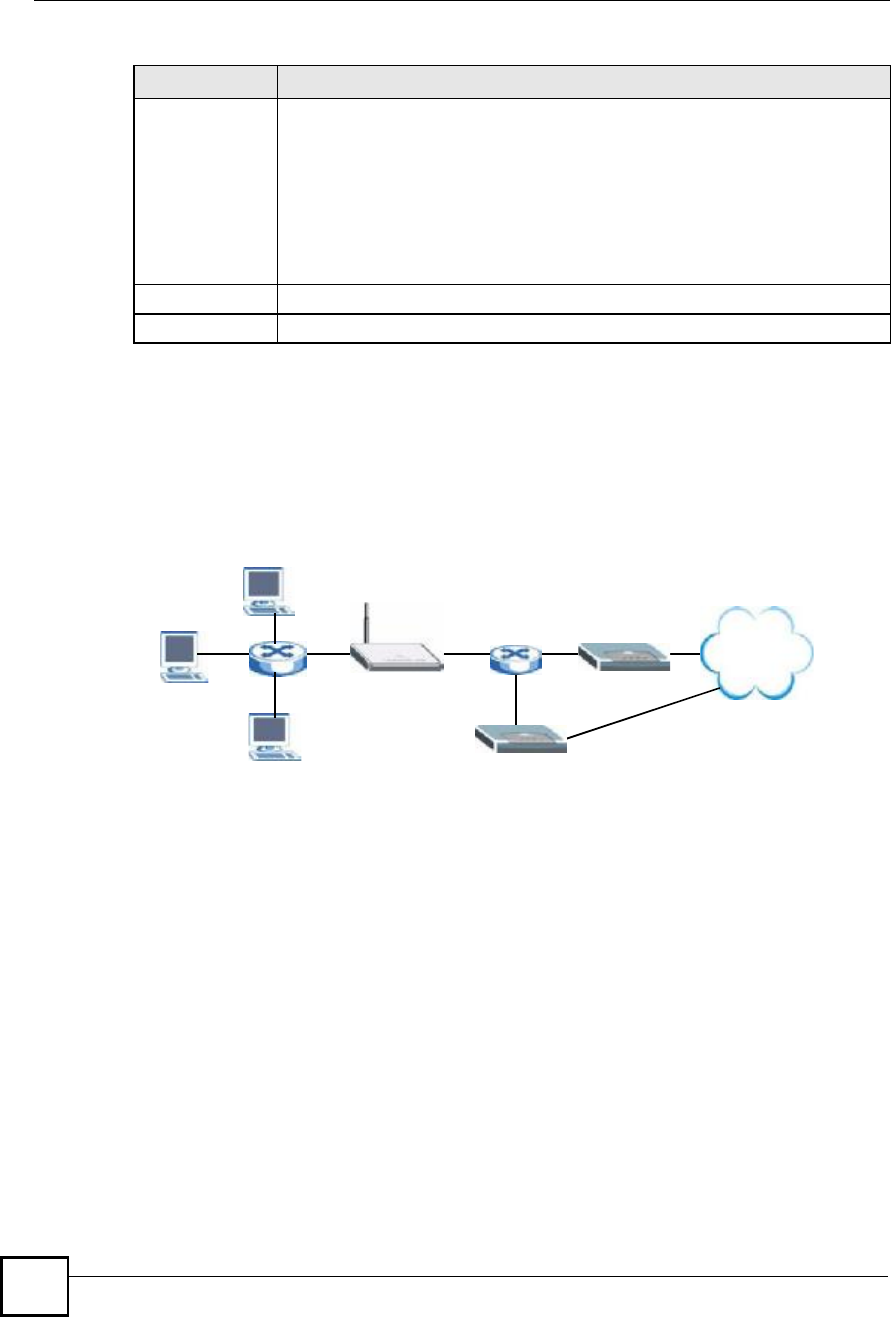
Chapter 6WAN Screens
NBG410W3G Series User s Guide
132
6.10 Traffic Redirect
Traffic redirect forwards WAN traffic to a backup gateway when the ZyXEL Device cannot
connect to the Internet through its normal gateway. Connect the backup gateway on the WAN
so that the ZyXEL Device still provides firewall protection for the LAN.
Figure 76 Traffic Redirect WAN Setup
IP alias allows you to avoid triangle route security issues when the backup gateway is
connected to the LAN or DMZ. Use IP alias to configure the LAN into two or three logical
networks with the ZyXEL Device itself as the gateway for each LAN network. Put the
protected LAN in one subnet (Subnet 1 in the following figure) and the backup gateway in
another subnet (Subnet 2). Configure a LAN to LAN/ZyXEL Device firewall rule that
forwards packets from the protected LAN (Subnet 1) to the backup gateway (Subnet 2).
Figure 77 Traffic Redirect LAN Setup
Actions when
over % of time
budget or % of
data budget
Specify the actions the ZyXEL Device takes when the specified percentage of time
budget or data limit is exceeded. Enter a number from 1 to 99 in the percentage
fields. If you change the value after you configure and enable budget control, the
ZyXEL Device resets the statistics.
Select Log to create a log.
Select Alert to create an alert. This option is available only when you select Log.
If you select Log, you can also select recurring every to have the ZyXEL Device
send a log (and alert if selected) for this event periodically. Specify how often (from
1 to 65535 minutes) to send the log (and alert if selected).
ApplyClick Apply to save your changes.
ResetClick Reset to begin configuring this screen afresh.
Table 22 NETWORK > WAN > 3G (WAN 2) (continued)
LABEL DESCRIPTION
Internet
WAN
LAN
Backup Gateway
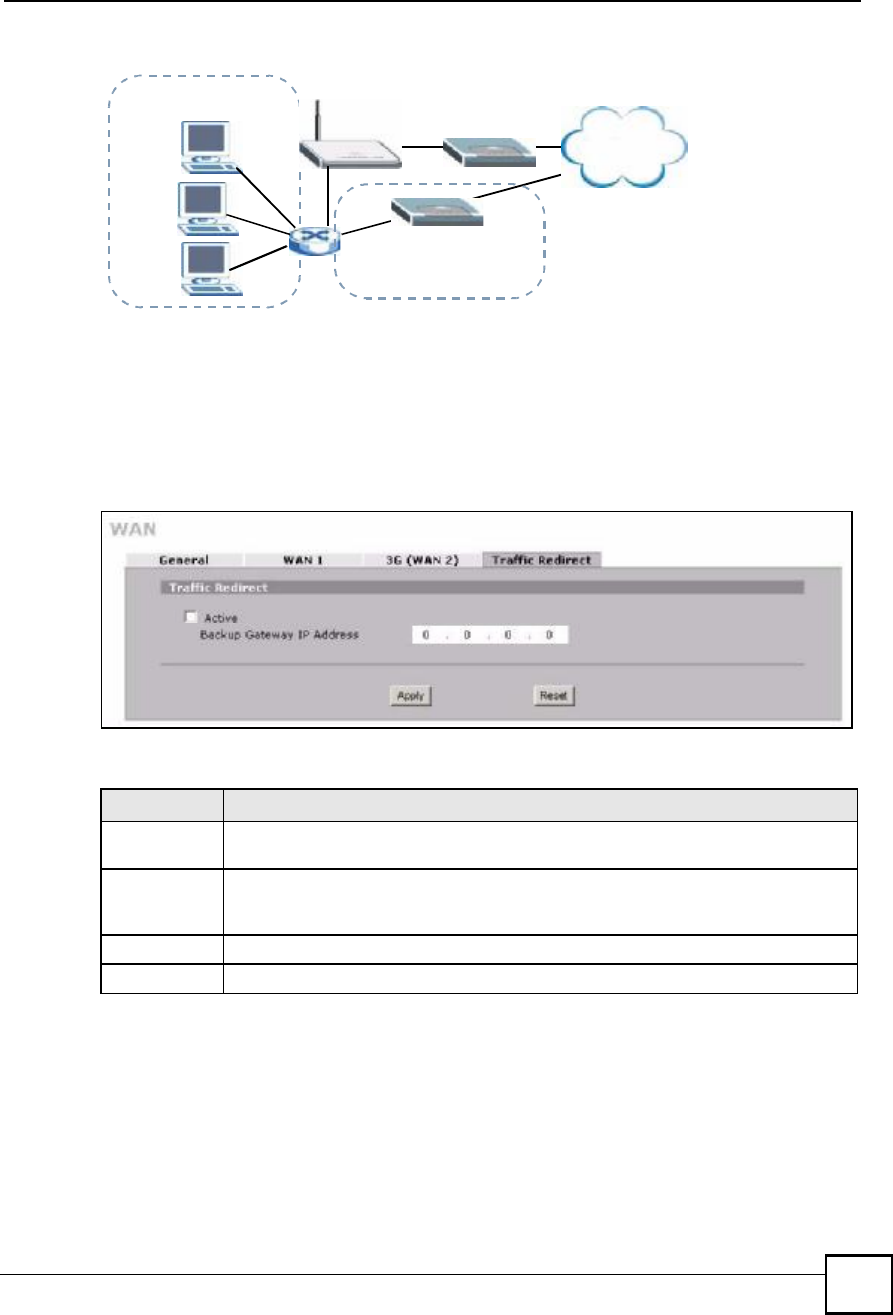
Chapter 6WAN Screens
NBG410W3G Series User s Guide 133
6.11 Configuring Traffic Redirect
To change your ZyXEL Device!s traffic redirect settings, click NETWORK > WAN > Traffic
Redirect. The screen appears as shown.
Figure 78 NETWORK > WAN > Traffic Redirect
The following table describes the labels in this screen.
Internet
WAN
LAN
Backup Gateway
Subnet 2
192.168.2.0 - 192.168.2.24
Subnet 1
192.168.1.0 - 192.168.1.24
Table 23 NETWORK > WAN > Traffic Redirect
LABEL DESCRIPTION
ActiveSelect this check box to have the ZyXEL Device use traffic redirect if the normal WAN
connection goes down.
Backup
Gateway IP
Address
Type the IP address of your backup gateway in dotted decimal notation. The ZyXEL
Device automatically forwards traffic to this IP address if the ZyXEL Device's Internet
connection terminates.
ApplyClick Apply to save your changes.
ResetClick Reset to begin configuring this screen afresh.

Chapter 6WAN Screens
NBG410W3G Series User s Guide
134

NBG410W3G Series User s Guide 135
CHAPTER 7
DMZ Screens
This chapter describes how to configure the ZyXEL Device!s DMZ.
7.1 DMZ
The DeMilitarized Zone (DMZ) provides a way for public servers (Web, e-mail, FTP, etc.) to
be visible to the outside world (while still being protected from DoS (Denial of Service)
attacks such as SYN flooding and Ping of Death). These public servers can also still be
accessed from the secure LAN.
By default the firewall allows traffic between the WAN and the DMZ, traffic from the DMZ to
the LAN is denied, and traffic from the LAN to the DMZ is allowed. Internet users can have
access to host servers on the DMZ but no access to the LAN, unless special filter rules
allowing access were configured by the administrator or the user is an authorized remote user.
It is highly recommended that you connect all of your public servers to the DMZ port(s).
It is also highly recommended that you keep all sensitive information off of the public servers
connected to the DMZ port. Store sensitive information on LAN computers.
7.2 Configuring DMZ
The DMZ and the connected computers can have private or public IP addresses.
When the DMZ uses public IP addresses, the WAN and DMZ ports must use public IP
addresses that are on separate subnets. See Appendix C on page 377 for information on IP
subnetting. If you do not configure SUA NAT or any full feature NAT mapping rules for the
public IP addresses on the DMZ, the ZyXEL Device will route traffic to the public IP
addresses on the DMZ without performing NAT. This may be useful for hosting servers for
NAT unfriendly applications (see Chapter 12 on page 225 for more information).
If the DMZ computers use private IP addresses, use NAT if you want to make them publicly
accessible.
Like the LAN, the ZyXEL Device can also assign TCP/IP configuration via DHCP to
computers connected to the DMZ ports.
From the main menu, click NETWORK > DMZ to open the DMZ screen. The screen appears
as shown next.
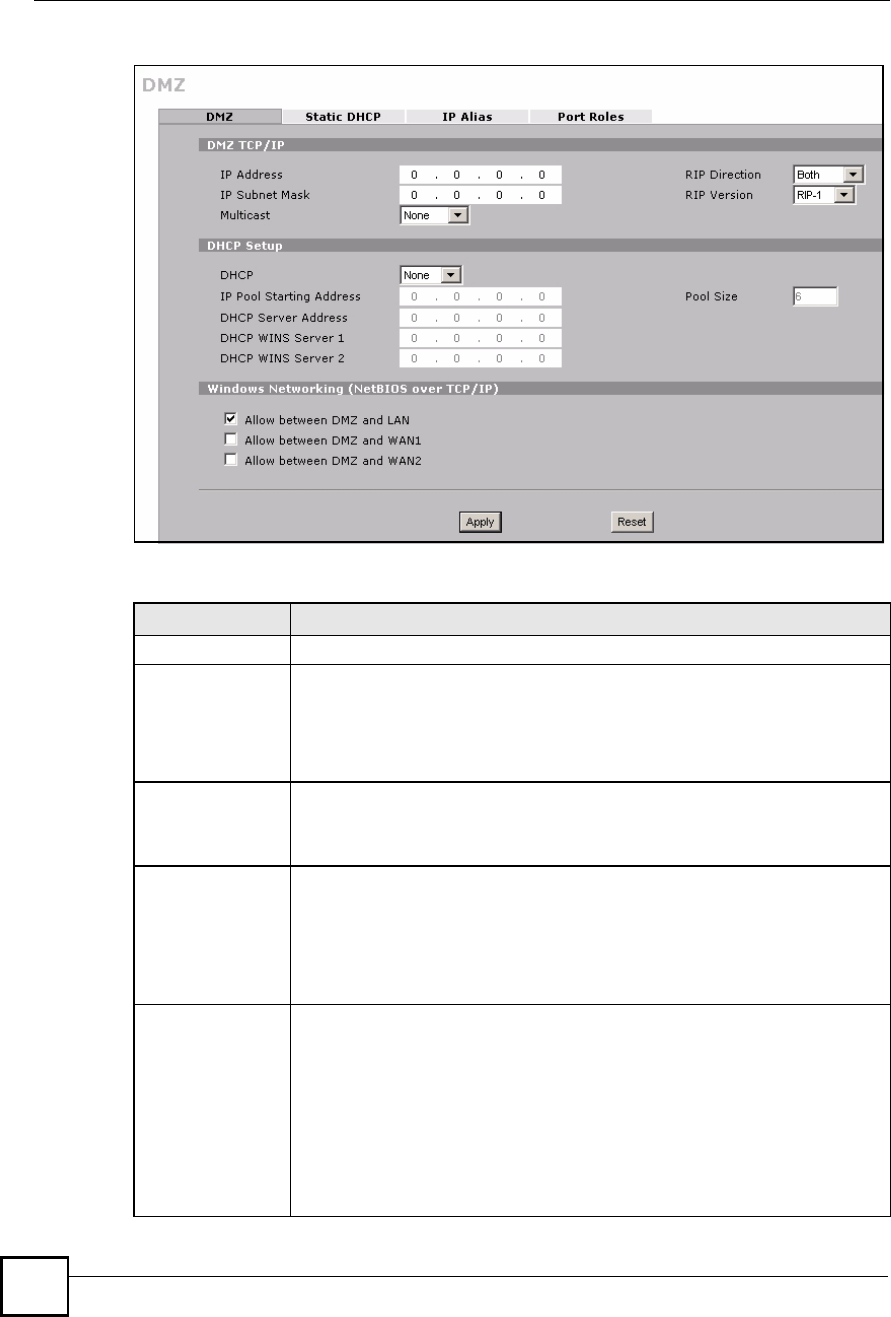
Chapter 7DMZ Screens
NBG410W3G Series User s Guide
136
Figure 79 NETWORK > DMZ
The following table describes the labels in this screen.
Table 24 NETWORK > DMZ
LABEL DESCRIPTION
DMZ TCP/IP
IP AddressType the IP address of your ZyXEL Device s DMZ port in dotted decimal notation.
Note: Make sure the IP addresses of the LAN, WAN and DMZ are
on separate subnets.
IP Subnet MaskThe subnet mask specifies the network number portion of an IP address. Your
ZyXEL Device will automatically calculate the subnet mask based on the IP
address that you assign. Unless you are implementing subnetting, use the
subnet mask computed by the ZyXEL Device 255.255.255.0.
RIP DirectionRIP (Routing Information Protocol, RFC1058 and RFC 1389) allows a router to
exchange routing information with other routers. The RIP Direction field controls
the sending and receiving of RIP packets. Select the RIP direction from Both/In
Only/Out Only/None. When set to Both or Out Only, the ZyXEL Device will
broadcast its routing table periodically. When set to Both or In Only, it will
incorporate the RIP information that it receives; when set to None, it will not send
any RIP packets and will ignore any RIP packets received. Both is the default.
RIP VersionThe RIP Version field controls the format and the broadcasting method of the
RIP packets that the ZyXEL Device sends (it recognizes both formats when
receiving). RIP-1 is universally supported but RIP-2 carries more information.
RIP-1 is probably adequate for most networks, unless you have an unusual
network topology. Both RIP-2B and RIP-2M sends the routing data in RIP-2
format; the difference being that RIP-2B uses subnet broadcasting while RIP-2M
uses multicasting. Multicasting can reduce the load on non-router machines
since they generally do not listen to the RIP multicast address and so will not
receive the RIP packets. However, if one router uses multicasting, then all
routers on your network must use multicasting, also. By default, RIP direction is
set to Both and the Version set to RIP-1.

Chapter 7DMZ Screens
NBG410W3G Series User s Guide 137
MulticastSelect IGMP V-1 or IGMP V-2 or None. IGMP (Internet Group Multicast Protocol)
is a network-layer protocol used to establish membership in a Multicast group - it
is not used to carry user data. IGMP version 2 (RFC 2236) is an improvement
over version 1 (RFC 1112) but IGMP version 1 is still in wide use. If you would
like to read more detailed information about interoperability between IGMP
version 2 and version 1, please see sections 4 and 5 of RFC 2236.
DHCP Setup
DHCP DHCP (Dynamic Host Configuration Protocol, RFC 2131 and RFC 2132) allows
individual clients (workstations) to obtain TCP/IP configuration at startup from a
server. Unless you are instructed by your ISP, leave this field set to Server. When
configured as a server, the ZyXEL Device provides TCP/IP configuration for the
clients. When set as a server, fill in the IP Pool Starting Address and Pool Size
fields.
Select Relay to have the ZyXEL Device forward DHCP requests to another
DHCP server. When set to Relay, fill in the DHCP Server Address field.
Select None to stop the ZyXEL Device from acting as a DHCP server. When you
select None, you must have another DHCP server on your LAN, or else the
computers must be manually configured.
IP Pool Starting
Address
This field specifies the first of the contiguous addresses in the IP address pool.
Pool SizeThis field specifies the size, or count of the IP address pool.
DHCP Server
Address
Type the IP address of the DHCP server to which you want the ZyXEL Device to
relay DHCP requests. Use dotted decimal notation. Alternatively, click the right
mouse button to copy and/or paste the IP address.
DHCP WINS
Server 1, 2
Type the IP address of the WINS (Windows Internet Naming Service) server that
you want to send to the DHCP clients. The WINS server keeps a mapping table
of the computer names on your network and the IP addresses that they are
currently using.
Windows
Networking
(NetBIOS over
TCP/IP)
Allow between
DMZ and LAN
Select this check box to forward NetBIOS packets from the LAN to the DMZ and
from the DMZ to the LAN. If your firewall is enabled with the default policy set to
block DMZ to LAN traffic, you also need to configure a DMZ to LAN firewall rule
that forwards NetBIOS traffic.
Clear this check box to block all NetBIOS packets going from the LAN to the DMZ
and from the DMZ to the LAN.
Allow between
DMZ and WAN 1
Select this check box to forward NetBIOS packets from the DMZ to WAN 1 and
from WAN 1 to the DMZ.
Clear this check box to block all NetBIOS packets going from the DMZ to WAN 1
and from WAN 1 to the DMZ.
Allow between
DMZ and WAN 2
Select this check box to forward NetBIOS packets from the DMZ to WAN 2 and
from WAN 2 to the DMZ.
Clear this check box to block all NetBIOS packets going from the DMZ to WAN 2
and from WAN 2 to the DMZ.
ApplyClick Apply to save your changes.
ResetClick Reset to begin configuring this screen afresh.
Table 24 NETWORK > DMZ (continued)
LABEL DESCRIPTION
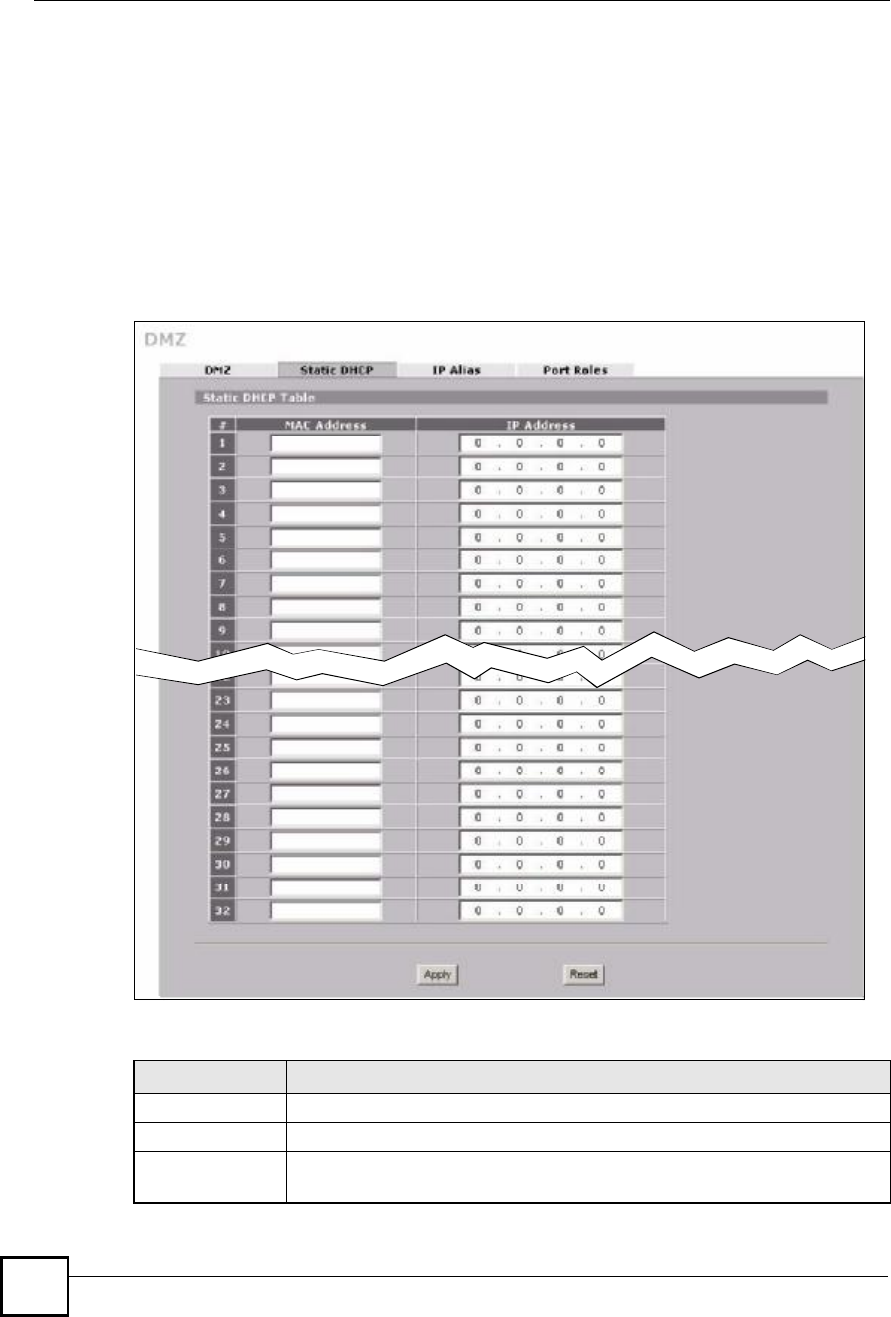
Chapter 7DMZ Screens
NBG410W3G Series User s Guide
138
7.3 DMZ Static DHCP
This table allows you to assign IP addresses on the DMZ to specific individual computers
based on their MAC Addresses.
Every Ethernet device has a unique MAC (Media Access Control) address. The MAC address
is assigned at the factory and consists of six pairs of hexadecimal characters, for example,
00:A0:C5:00:00:02.
To change your ZyXEL Device!s static DHCP settings on the DMZ, click NETWORK >
DMZ > Static DHCP. The screen appears as shown.
Figure 80 NETWORK > DMZ > Static DHCP
The following table describes the labels in this screen.
Table 25 NETWORK > DMZ > Static DHCP
LABEL DESCRIPTION
#This is the index number of the Static IP table entry (row).
MAC AddressType the MAC address of a computer on your DMZ.
IP AddressType the IP address that you want to assign to the computer on your DMZ.
Alternatively, click the right mouse button to copy and/or paste the IP address.

Chapter 7DMZ Screens
NBG410W3G Series User s Guide 139
7.4 DMZ IP Alias
IP alias allows you to partition a physical network into different logical networks over the
same Ethernet interface.
The ZyXEL Device has a single DMZ interface. Even though more than one of ports 1~4 may
be in the DMZ port role, they are all still part of a single physical Ethernet interface and all use
the same IP address.
The ZyXEL Device supports three logical DMZ interfaces via its single physical DMZ
Ethernet interface. The ZyXEL Device itself is the gateway for each of the logical DMZ
networks.
The IP alias IP addresses can be either private or public regardless of whether the physical
DMZ interface is set to use a private or public IP address. Use NAT if you want to make DMZ
computers with private IP addresses publicly accessible (see Chapter 12 on page 225 for more
information). When you use IP alias, you can have the DMZ use both public and private IP
addresses at the same time.
Make sure that the subnets of the logical networks do not overlap.
To change your ZyXEL Device!s IP alias settings, click NETWORK > DMZ > IP Alias. The
screen appears as shown.
ApplyClick Apply to save your changes.
ResetClick Reset to begin configuring this screen afresh.
Table 25 NETWORK > DMZ > Static DHCP
LABEL DESCRIPTION
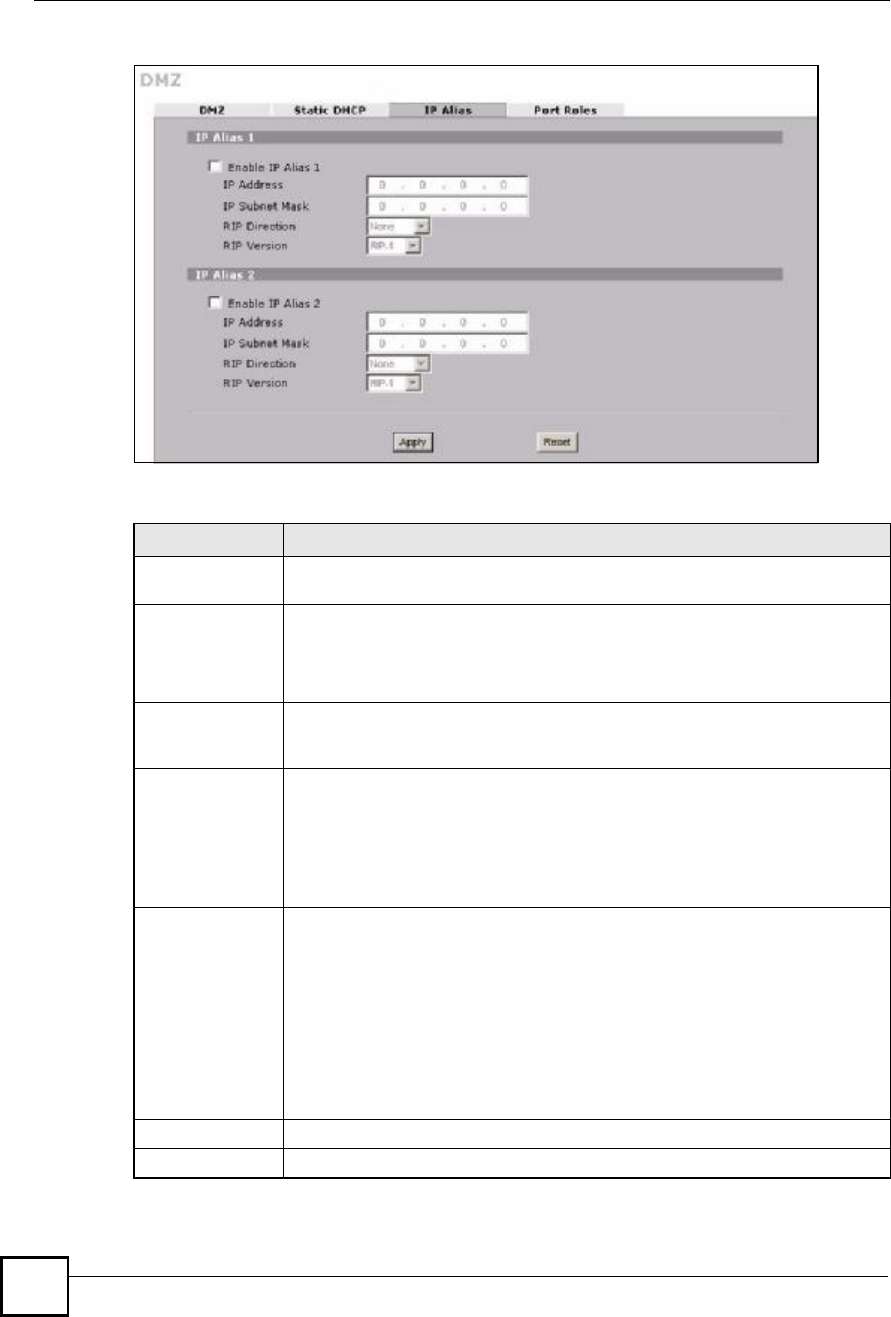
Chapter 7DMZ Screens
NBG410W3G Series User s Guide
140
Figure 81 NETWORK > DMZ > IP Alias
The following table describes the labels in this screen.
Table 26 NETWORK > DMZ > IP Alias
LABEL DESCRIPTION
Enable IP Alias 1,
2
Select the check box to configure another DMZ network for the ZyXEL Device.
IP AddressEnter the IP address of your ZyXEL Device in dotted decimal notation.
Note: Make sure the IP addresses of the LAN, WAN and DMZ are
on separate subnets.
IP Subnet MaskYour ZyXEL Device will automatically calculate the subnet mask based on the IP
address that you assign. Unless you are implementing subnetting, use the subnet
mask computed by the ZyXEL Device.
RIP DirectionRIP (Routing Information Protocol, RFC1058 and RFC 1389) allows a router to
exchange routing information with other routers. The RIP Direction field controls
the sending and receiving of RIP packets. Select the RIP direction from Both/In
Only/Out Only/None. When set to Both or Out Only, the ZyXEL Device will
broadcast its routing table periodically. When set to Both or In Only, it will
incorporate the RIP information that it receives; when set to None, it will not send
any RIP packets and will ignore any RIP packets received.
RIP VersionThe RIP Version field controls the format and the broadcasting method of the RIP
packets that the ZyXEL Device sends (it recognizes both formats when receiving).
RIP-1 is universally supported but RIP-2 carries more information. RIP-1 is
probably adequate for most networks, unless you have an unusual network
topology. Both RIP-2B and RIP-2M sends the routing data in RIP-2 format; the
difference being that RIP-2B uses subnet broadcasting while RIP-2M uses
multicasting. Multicasting can reduce the load on non-router machines since they
generally do not listen to the RIP multicast address and so will not receive the RIP
packets. However, if one router uses multicasting, then all routers on your network
must use multicasting, also. By default, RIP direction is set to Both and the
Version set to RIP-1.
ApplyClick Apply to save your changes.
ResetClick Reset to begin configuring this screen afresh.
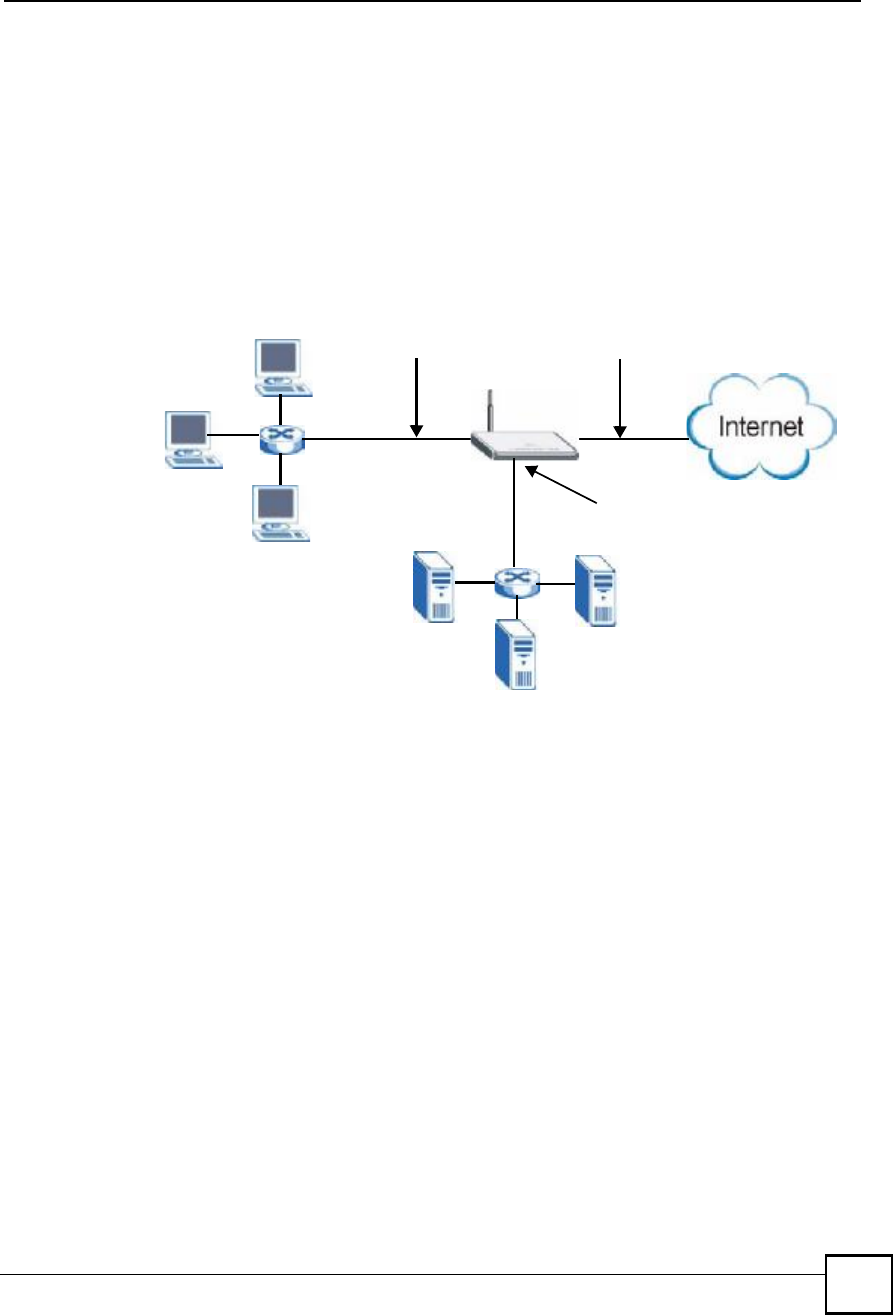
Chapter 7DMZ Screens
NBG410W3G Series User s Guide 141
7.5 DMZ Public IP Address Example
The following figure shows a simple network setup with public IP addresses on the WAN and
DMZ and private IP addresses on the LAN. Lower case letters represent public IP addresses
(like a.b.c.d for example). The LAN port and connected computers (A through C) use private
IP addresses that are in one subnet. The DMZ port and connected servers (D through F) use
public IP addresses that are in another subnet. The public IP addresses of the DMZ and WAN
ports are in separate subnets.
Figure 82 DMZ Public Address Example
7.6 DMZ Private and Public IP Address Example
The following figure shows a network setup with both private and public IP addresses on the
DMZ. Lower case letters represent public IP addresses (like a.b.c.d for example). The LAN
port and connected computers (A through C) use private IP addresses that are in one subnet.
The DMZ port and server F use private IP addresses that are in one subnet. The private IP
addresses of the LAN and DMZ are on separate subnets. The DMZ port and connected servers
(D and E) use public IP addresses that are in one subnet. The public IP addresses of the DMZ
and WAN are on separate subnets.
Configure one subnet (either the public or the private) in the Network > DMZ screen (see
Figure 7.2 on page 135) and configure the other subnet in the Network > DMZ > IP Alias
screen (see Figure 7.4 on page 139) to use this kind of network setup. You also need to
configure NAT for the private DMZ IP addresses.
A
IP: 192.168.1.3
B
IP: 192.168.1.4
C
IP: 192.168.1.5
LAN LAN
IP: 192.168.1.1
D
IP: a.b.c.i E
IP: a.b.c.j
F
IP: a.b.c.k
DMZ
DMZ
IP: a.b.c.h
WAN
IP: a.b.d.b
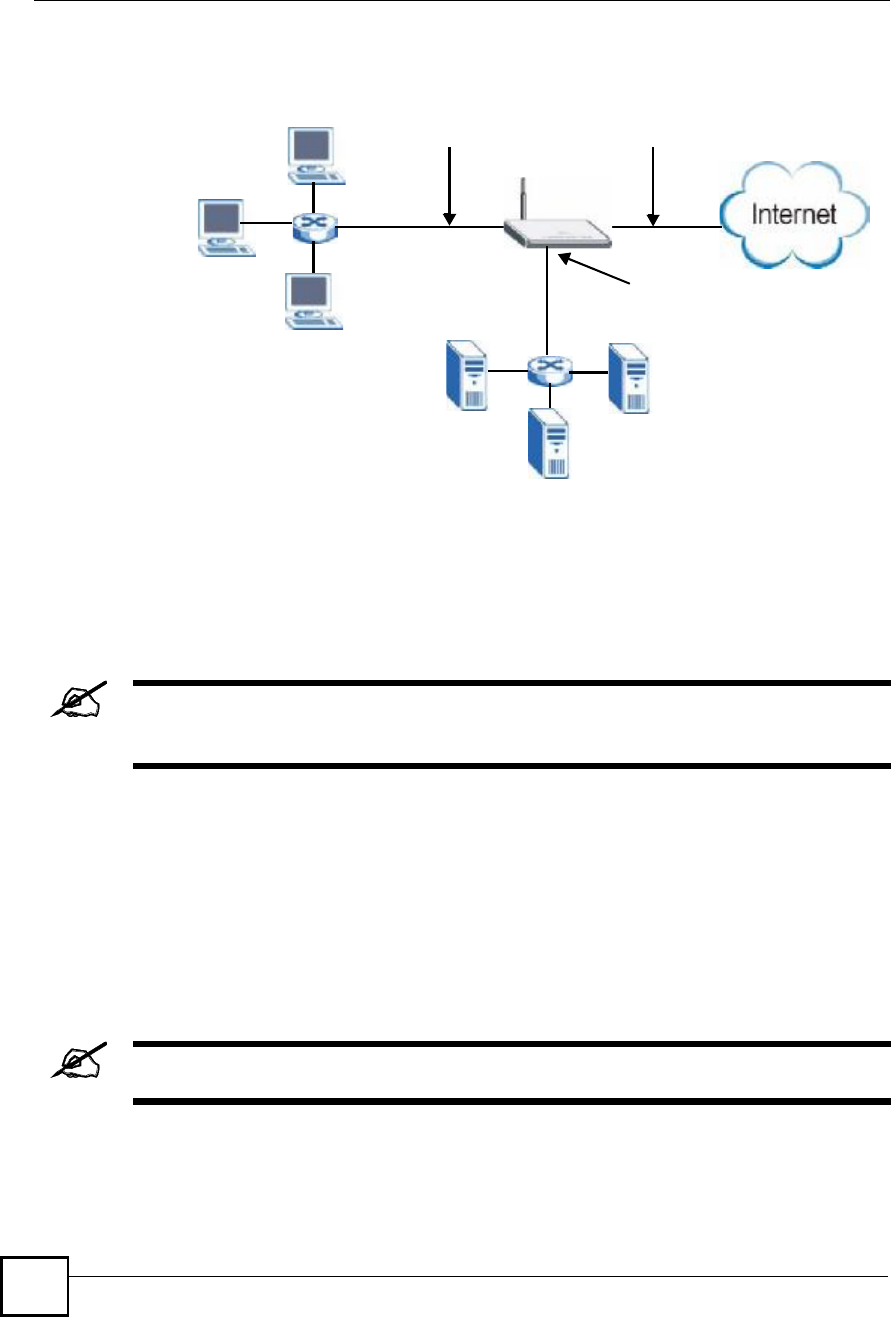
Chapter 7DMZ Screens
NBG410W3G Series User s Guide
142
Figure 83 DMZ Private and Public Address Example
7.7 DMZ Port Roles
Use the Port Roles screen to set ports as part of the LAN and/or DMZ interface.
Ports 1~4 on the ZyXEL Device can be part of the LAN and/or DMZ interface.
Do the following if you are configuring from a computer connected to a LAN or
DMZ port and changing the port's role:
1A port's IP address varies as its role changes, make sure your computer's IP address is in
the same subnet as the ZyXEL Device's LAN or DMZ IP address.
2Use the appropriate LAN or DMZ IP address to access the ZyXEL Device.
To change your ZyXEL Device!s port role settings, click NETWORK > DMZ > Port Roles.
The screen appears as shown.
The radio buttons correspond to Ethernet ports on the front panel of the ZyXEL Device. On
the ZyXEL Device, ports 1 to 4 are all LAN ports by default.
Your changes are also reflected in the LAN Port Roles screens.
A
IP: 192.168.1.3
B
IP: 192.168.1.4
C
IP: 192.168.1.5
LAN
LAN
IP: 192.168.1.1
D
IP: a.b.c.i E
IP: a.b.c.j
F
IP: 10.0.0.2
DMZ
DMZ
IP: a.b.c.h
WAN
IP: a.b.d.b
IP: 10.0.0.1

Chapter 7DMZ Screens
NBG410W3G Series User s Guide 143
Figure 84 NETWORK > DMZ > Port Roles
The following table describes the labels in this screen.
Table 27 NETWORK > DMZ > Port Roles
LABEL DESCRIPTION
LANSelect a port s LAN radio button to use the port as part of the LAN. The port will
use the ZyXEL Device s LAN IP address and MAC address.
DMZSelect a port s DMZ radio button to use the port as part of the DMZ. The port will
use the ZyXEL Device s DMZ IP address and MAC address.
ApplyClick Apply to save your changes.
ResetClick Reset to begin configuring this screen afresh.

Chapter 7DMZ Screens
NBG410W3G Series User s Guide
144

145
PART III
Wireless
Wi-Fi (147)

146
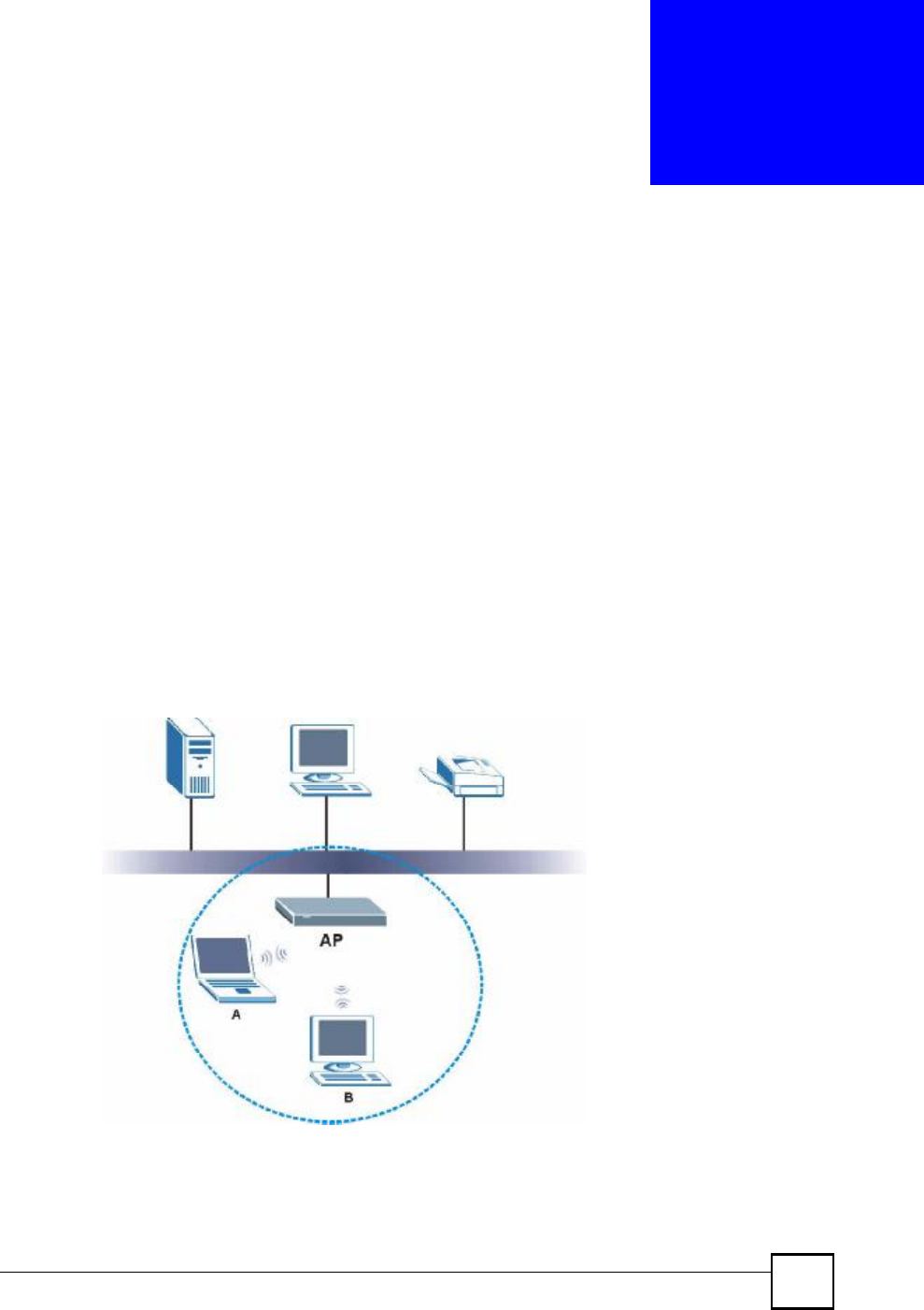
NBG410W3G Series User s Guide 147
CHAPTER 8
Wi-Fi
This chapter discusses how to configure wireless LAN on the ZyXEL Device.
8.1 Wi-Fi Introduction
Your ZyXEL Device comes with an internal Wi-Fi card, providing AP (access point)
functionality, and allowing you to set up a wireless LAN (WLAN). Before you set up your
WLAN it is important to understand WLAN and WLAN security concepts.
A wireless LAN can be as simple as two computers with wireless LAN adapters
communicating in a peer-to-peer network or as complex as a number of computers with
wireless LAN adapters communicating through access points which bridge network traffic to
the wired LAN.
The following figure provides an example of a wireless network.
Figure 85 Example of a Wireless Network
The wireless network is the part in the blue circle. In this wireless network, devices A and B
are called wireless clients. The wireless clients use the access point (AP) to interact with other
devices (such as the printer) or with the Internet. Your ZyXEL Device is the AP.

Chapter 8Wi-Fi
NBG410W3G Series User s Guide
148
Every wireless network must follow these basic guidelines.
Every wireless client in the same wireless network must use the same SSID.
The SSID is the name of the wireless network. It stands for Service Set IDentity.
If two wireless networks overlap, they should use different channels.
Like radio stations or television channels, each wireless network uses a specific channel,
or frequency, to send and receive information.
Every wireless client in the same wireless network must use security compatible with the
AP.
Security stops unauthorized devices from using the wireless network. It can also protect
the information that is sent in the wireless network.
See the WLAN appendix for more detailed information on WLANs.
8.2 Wireless Security Overview
The following sections introduce different types of wireless security you can set up in the
wireless network.
8.2.1 SSID
Normally, the AP acts like a beacon and regularly broadcasts the SSID in the area. You can
hide the SSID instead, in which case the AP does not broadcast the SSID. In addition, you
should change the default SSID to something that is difficult to guess.
This type of security is fairly weak, however, because there are ways for unauthorized devices
to get the SSID. In addition, unauthorized devices can still see the information that is sent in
the wireless network.
8.2.2 MAC Address Filter
Every wireless client has a unique identification number, called a MAC address.1 A MAC
address is usually written using twelve hexadecimal characters2; for example, 00A0C5000002
or 00:A0:C5:00:00:02. To get the MAC address for each wireless client, see the appropriate
User!s Guide or other documentation.
1.Some wireless devices, such as scanners, can detect wireless networks but cannot use wireless
networks. These kinds of wireless devices might not have MAC addresses.
2.Hexadecimal characters are 0, 1, 2, 3, 4, 5, 6, 7, 8, 9, A, B, C, D, E, and F.

Chapter 8Wi-Fi
NBG410W3G Series User s Guide 149
You can use the MAC address filter to tell the AP which wireless clients are allowed or not
allowed to use the wireless network. If a wireless client is allowed to use the wireless network,
it still has to have the correct settings (SSID, channel, and security). If a wireless client is not
allowed to use the wireless network, it does not matter if it has the correct settings.
This type of security does not protect the information that is sent in the wireless network.
Furthermore, there are ways for unauthorized devices to get the MAC address of an authorized
wireless client. Then, they can use that MAC address to use the wireless network.
8.2.3 User Authentication
You can make every user log in to the wireless network before they can use it. This is called
user authentication. However, every wireless client in the wireless network has to support
IEEE 802.1x to do this.
For wireless networks, there are two typical places to store the user names and passwords for
each user.
In the AP: this feature is called a local user database or a local database.
In a RADIUS server: this is a server used in businesses more than in homes.
If your AP does not provide a local user database and if you do not have a RADIUS server,
you cannot set up user names and passwords for your users.
Unauthorized devices can still see the information that is sent in the wireless network, even if
they cannot use the wireless network. Furthermore, there are ways for unauthorized wireless
users to get a valid user name and password. Then, they can use that user name and password
to use the wireless network.
Local user databases also have an additional limitation that is explained in the next section.
8.2.4 Encryption
Wireless networks can use encryption to protect the information that is sent in the wireless
network. Encryption is like a secret code. If you do not know the secret code, you cannot
understand the message.

Chapter 8Wi-Fi
NBG410W3G Series User s Guide
150
The types of encryption you can choose depend on the type of user authentication. (See
Section 8.2.3 on page 149 for information about this.)
For example, if the wireless network has a RADIUS server, you can choose WPA or WPA2. If
users do not log in to the wireless network, you can choose no encryption, Static WEP, WPA-
PSK, or WPA2-PSK.
Usually, you should set up the strongest encryption that every wireless client in the wireless
network supports. For example, suppose the AP does not have a local user database, and you
do not have a RADIUS server. Therefore, there is no user authentication. Suppose the wireless
network has two wireless clients. Device A only supports WEP, and device B supports WEP
and WPA. Therefore, you should set up Static WEP in the wireless network.
It is recommended that wireless clients use WPA-PSK, WPA, or stronger
encryption. IEEE 802.1x and WEP encryption are better than none at all, but it
is still possible for unauthorized devices to figure out the original information
pretty quickly.
It is not possible to use WPA-PSK, WPA or stronger encryption with a local
user database. In this case, it is better to set up stronger encryption with no
authentication than to set up weaker encryption with the local user database.
If some wireless clients support WPA and some support WPA2, you should set up WPA2-
PSK-Mix or WPA2-Mix (depending on the type of wireless network login) in the ZyXEL
Device.
Many types of encryption use a key to protect the information in the wireless network. The
longer the key, the stronger the encryption. Every wireless client in the wireless network must
have the same key.
Table 28 Types of Encryption for Each Type of Authentication
No Authentication RADIUS Server
Weakest No Security
Static WEP
802.1x +Static WEP
WPA-PSKWPA
Strongest WPA2-PSK or WPA2-PSK-MixWPA2 or WPA2-Mix
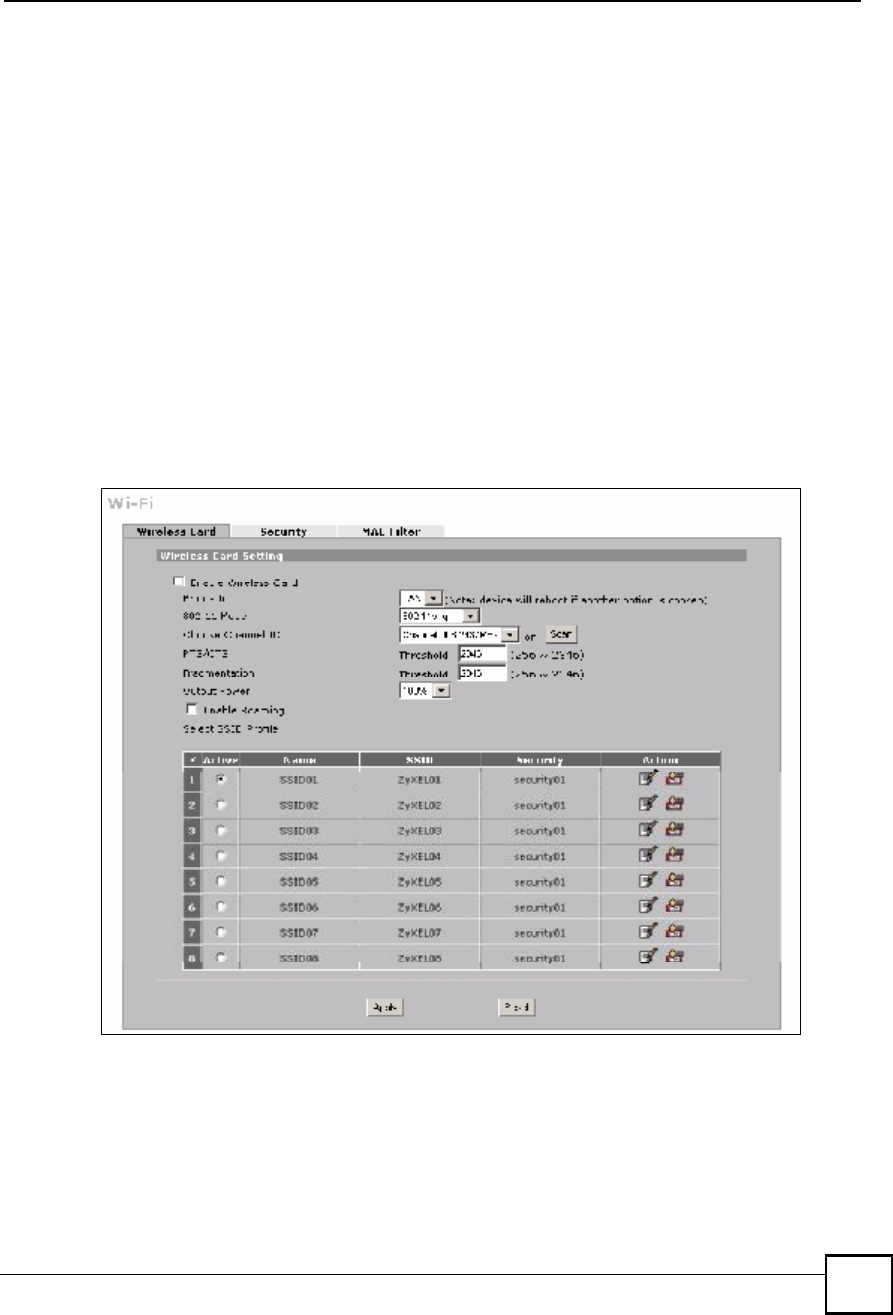
Chapter 8Wi-Fi
NBG410W3G Series User s Guide 151
8.2.5 Additional Installation Requirements for Using 802.1x
A computer with an IEEE 802.11b/g wireless LAN card.
A computer equipped with a web browser (with JavaScript enabled) and/or Telnet.
A wireless station must be running IEEE 802.1x-compliant software. Currently, this is
offered in Windows XP.
An optional network RADIUS server for remote user authentication and accounting.
8.3 Wireless Card
If you are configuring the ZyXEL Device from a computer connected to the wireless LAN and
you change the ZyXEL Device!s SSID or security settings, you will lose your wireless
connection when you press Apply to confirm. You must then change the wireless settings of
your computer to match the ZyXEL Device!s new settings.
Click WIRELESS > Wi-Fi to open the Wireless Card screen.
Figure 86 WIRELESS > Wi-Fi > Wireless Card

Chapter 8Wi-Fi
NBG410W3G Series User s Guide
152
The following table describes the labels in this screen.
Table 29 WIRELESS > Wi-Fi > Wireless Card
LABEL DESCRIPTION
Enable
Wireless Card
The wireless LAN through a wireless LAN card is turned off by default. Before you
enable the wireless LAN you should configure security by setting MAC filters and/or
802.1x security; otherwise your wireless LAN will be vulnerable upon enabling it.
Select the check box to enable the wireless LAN.
Bridge toSelect LAN to use the wireless card as part of the LAN.
Select DMZ to use the wireless card as part of the DMZ.
The ZyXEL Device restarts after you change the wireless card setting.
Note: If you set the wireless card to be part of the LAN or DMZ, you
can still use wireless access. The firewall will treat the wireless
card as part of the LAN or DMZ respectively.
802.11 ModeSelect 802.11b Only to allow only IEEE 802.11b compliant wireless devices to
associate with the ZyXEL Device.
Select 802.11g Only to allow only IEEE 802.11g compliant wireless devices to
associate with the ZyXEL Device.
Select 802.11b+g to allow both IEEE802.11b and IEEE802.11g compliant wireless
devices to associate with the ZyXEL Device. The transmission rate of your ZyXEL
Device might be reduced.
Choose
Channel ID
Set the operating frequency/channel depending on your particular region. To manually
set the ZyXEL Device to use a channel, select a channel from the drop-down list box.
To have the ZyXEL Device automatically select a channel, click Scan instead.
ScanClick this button to have the ZyXEL Device automatically select the wireless channel
with the lowest interference.
RTS/CTS
Threshold
In a wireless network which covers a large area, wireless devices are sometimes not
aware of each other s presence. This may cause them to send information to the AP
at the same time and result in information colliding and not getting through.
RTS/CTS is designed to prevent collisions due to hidden nodes. You should only
configure RTS/CTS if the possibility of hidden nodes exists on your network and the
"cost" of resending large frames is more than the extra network overhead involved in
the RTS (Request To Send)/CTS (Clear to Send) handshake.
Enter a value between 256 and 2346. Data with a frame size larger than this value will
perform the RTS (Request To Send)/CTS (Clear to Send) handshake. The lower the
value, the more often the devices must get permission.
If the RTS/CTS value is greater than the Fragmentation value, then the RTS/CTS
handshake will never occur as data frames will be fragmented before they reach RTS/
CTS size.
Fragmentation
Threshold
This is the threshold (number of bytes) for the fragmentation boundary for directed
messages. It is the maximum data fragment size that can be sent. Enter a value
between 256 and 2346.
Output Power Set the output power of the ZyXEL Device in this field. If there is a high density of APs
in an area, decrease the output power to reduce interference with other APs. Select
one of the following 100% (full power), 50%, 25%, 12.5% or min (minimum). See the
product specifications for more information on your ZyXEL Device s output power.
Enable
Roaming
Roaming allows wireless stations to switch from one access point to another as they
move from one coverage area to another. Select this checkbox to enable roaming on
the ZyXEL Device if you have two or more ZyXEL Devices on the same subnet.
Note: All APs on the same subnet and the wireless clients must have
the same SSID to allow roaming.

Chapter 8Wi-Fi
NBG410W3G Series User s Guide 153
8.3.1 SSID Profile
Configure wireless network security by configuring and applying an SSID profile. You can
configure multiple profiles but you can only apply one to your network.
Use the Wireless Card screen to see information about the SSID profiles on the ZyXEL
Device, and use the Wireless Card > Edit screen to configure the SSID profiles.
Each SSID profile references the settings configured in the following screens:
WIRELESS > Wi-Fi> Security (one of the security profiles).
AUTH SERVER > RADIUS (the RADIUS server settings).
WIRELESS > Wi-Fi > MAC Filter (the MAC filter list, if activated in the SSID profile).
Configure the fields in the above screens to use the settings in an SSID profile.
In the Wireless Card screen, click the edit icon next to an SSID profile to display the
following screen.
Select SSID
Profile
An SSID profile is the set of parameters relating to one of the ZyXEL Device s BSSs.
The SSID (Service Set IDentifier) identifies the Service Set with which a wireless client
is associated. Wireless clients associating with the access point (AP) must have the
same SSID.
Note: If you are configuring the ZyXEL Device from a computer
connected to the wireless LAN and you change the ZyXEL
Device s SSID or security settings, you will lose your wireless
connection when you press Apply to confirm. You must then
change the wireless settings of your computer to match the
ZyXEL Device s new settings.
#This field displays the index number of each SSID profile.
ActiveChoose a profile to apply to your wireless network by selecting its radio button.
NameThis field displays the identification name of each SSID profile on the ZyXEL Device.
SSIDThis field displays the name of the wireless profile on the network. When a wireless
client scans for an AP to associate with, this is the name that is broadcast and seen in
the wireless client utility.
SecurityThis field indicates which security profile is currently associated with each SSID
profile.
See Section 8.4 on page 154 for more information.
ActionClick the edit icon next to the profile you want to configure and go to the SSID
configuration screen.
Click the reset default icon to clear all user-entered configuration information and
return the SSID profile to its factory defaults.
ApplyClick Apply to save your changes.
ResetClick Reset to begin configuring this screen afresh.
Table 29 WIRELESS > Wi-Fi > Wireless Card (continued)
LABEL DESCRIPTION
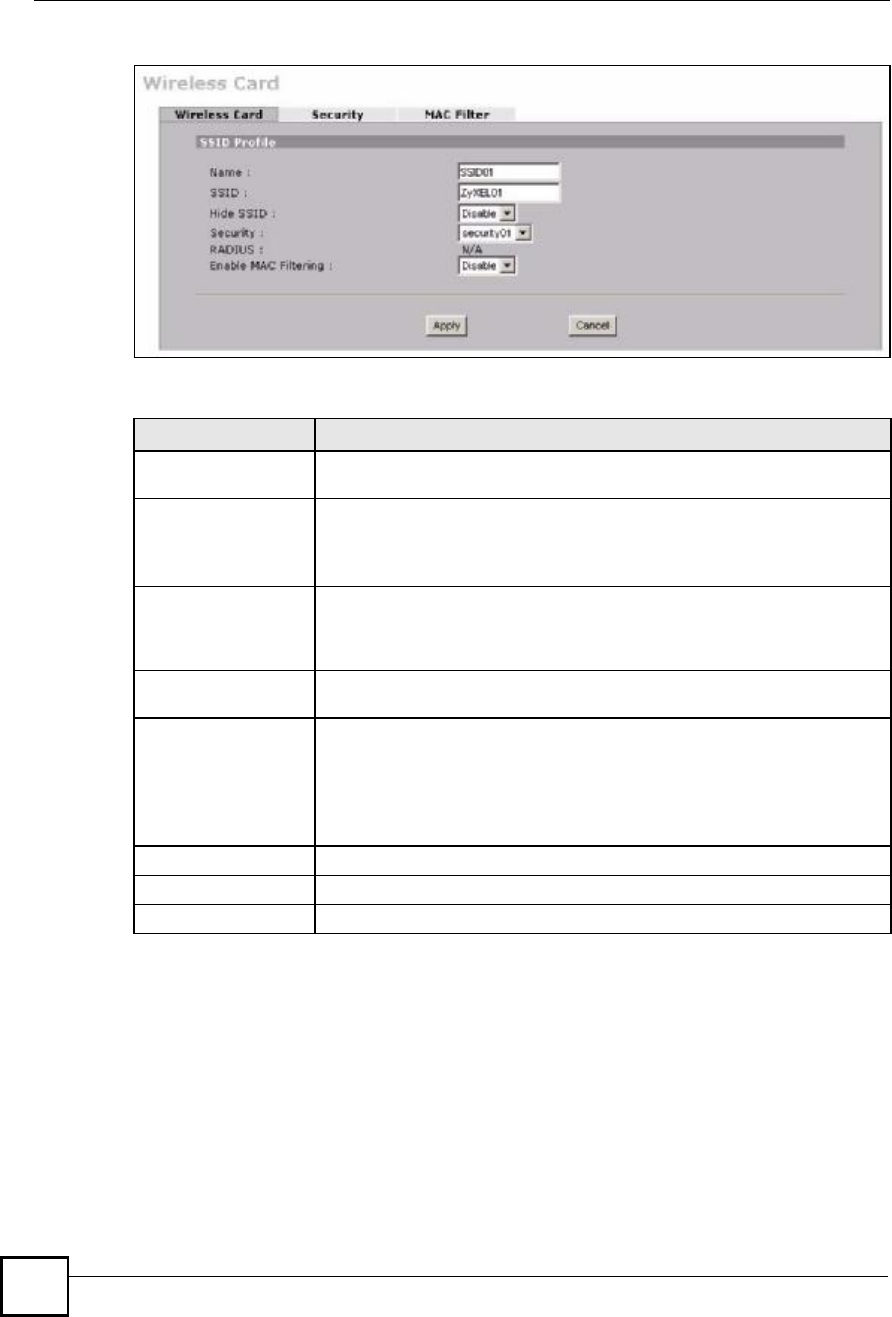
Chapter 8Wi-Fi
NBG410W3G Series User s Guide
154
Figure 87 WIRELESS > Wi-Fi > Configuring SSID
The following table describes the labels in this screen.
8.4 Configuring Wireless Security
Click WIRELESS > Wi-Fi > Security to open the Security screen. Use this screen to create
security profiles. A security profile is a group of configuration settings which can be assigned
to an SSID profile in the Wireless Card screen.
The screen changes when you configure a security profile and varies according to the security
modes you select.
Table 30 WIRELESS > Wi-Fi > Configuring SSID
LABEL DESCRIPTION
NameEnter a name (up to 32 printable 7-bit ASCII characters) identifying this
profile.
SSIDWhen a wireless client scans for an AP to associate with, this is the name that
is broadcast and seen in the wireless client utility.
Enter a descriptive name (up to 32 printable 7-bit ASCII characters) for the
wireless LAN.
Hide SSIDSelect Disable if you want the ZyXEL Device to broadcast this SSID (a
wireless client scanning for an AP will find this SSID). Alternatively, select
Enable to have the ZyXEL Device hide this SSID (a wireless client scanning
for an AP will not find this SSID).
SecuritySelect a security profile to use with this SSID profile. See Section 8.4 on page
154 for more information.
RADIUSThis displays N/A if the security profile you selected does not use RADIUS
authentication. See Section 8.4 on page 154 for more information.
This displays Radius Configuration if you select a security profile that uses
RADIUS authentication. Click Radius Configuration to go to the RADIUS
screen where you can view and/or change the RADIUS settings.
See Section 10.3 on page 193 for more information.
Enable MAC Filtering Select Enable from the drop down list box to activate MAC address filtering.
ApplyClick Apply to save your customized settings and exit this screen.
CancelClick Cancel to exit this screen without saving.
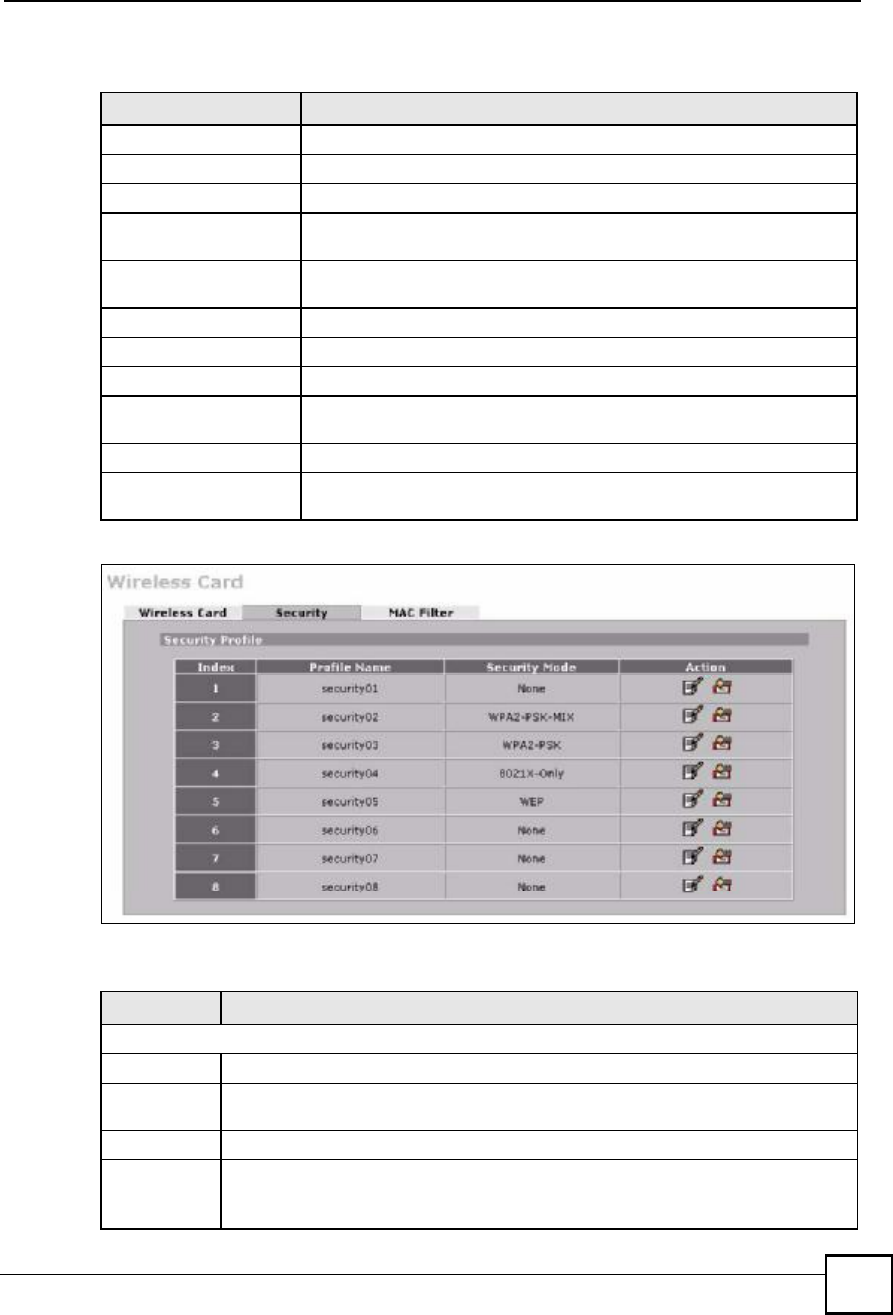
Chapter 8Wi-Fi
NBG410W3G Series User s Guide 155
The following table describes the security modes you can configure.
Figure 88 WIRELESS > Wi-Fi > Security
The following table describes the labels in this screen.
Table 31 Security Modes
SECURITY MODE DESCRIPTION
NoneSelect this to have no data encryption.
WEPSelect this to use WEP encryption.
802.1x-OnlySelect this to use 802.1x authentication with no data encryption.
802.1x-Static64Select this to use 802.1x authentication with a static 64bit WEP key and an
authentication server.
802.1x-Static128Select this to use 802.1x authentication with a static 128bit WEP key and
an authentication server.
WPASelect this to use WPA.
WPA-PSKSelect this to use WPA with a pre-shared key.
WPA2Select this to use WPA2.
WPA2-MIXSelect this to use either WPA2 or WPA depending on which security mode
the wireless client uses.
WPA2-PSKSelect this to use WPA2 with a pre-shared key.
WPA2-PSK-MIXSelect this to use either WPA-PSK or WPA2-PSK depending on which
security mode the wireless client uses.
Table 32 WIRELESS > Wi-Fi > Security
LABEL DESCRIPTION
Security Profile
Index This is the index number of the security profile.
Profile Name This field displays a name given to a security profile in the Security configuration
screen.
Security Mode This field displays the security mode this security profile uses.
Action Click the edit icon to configure security settings for that profile.
Click the reset default icon to clear all user-entered configuration information and
return the security profile to its factory defaults.
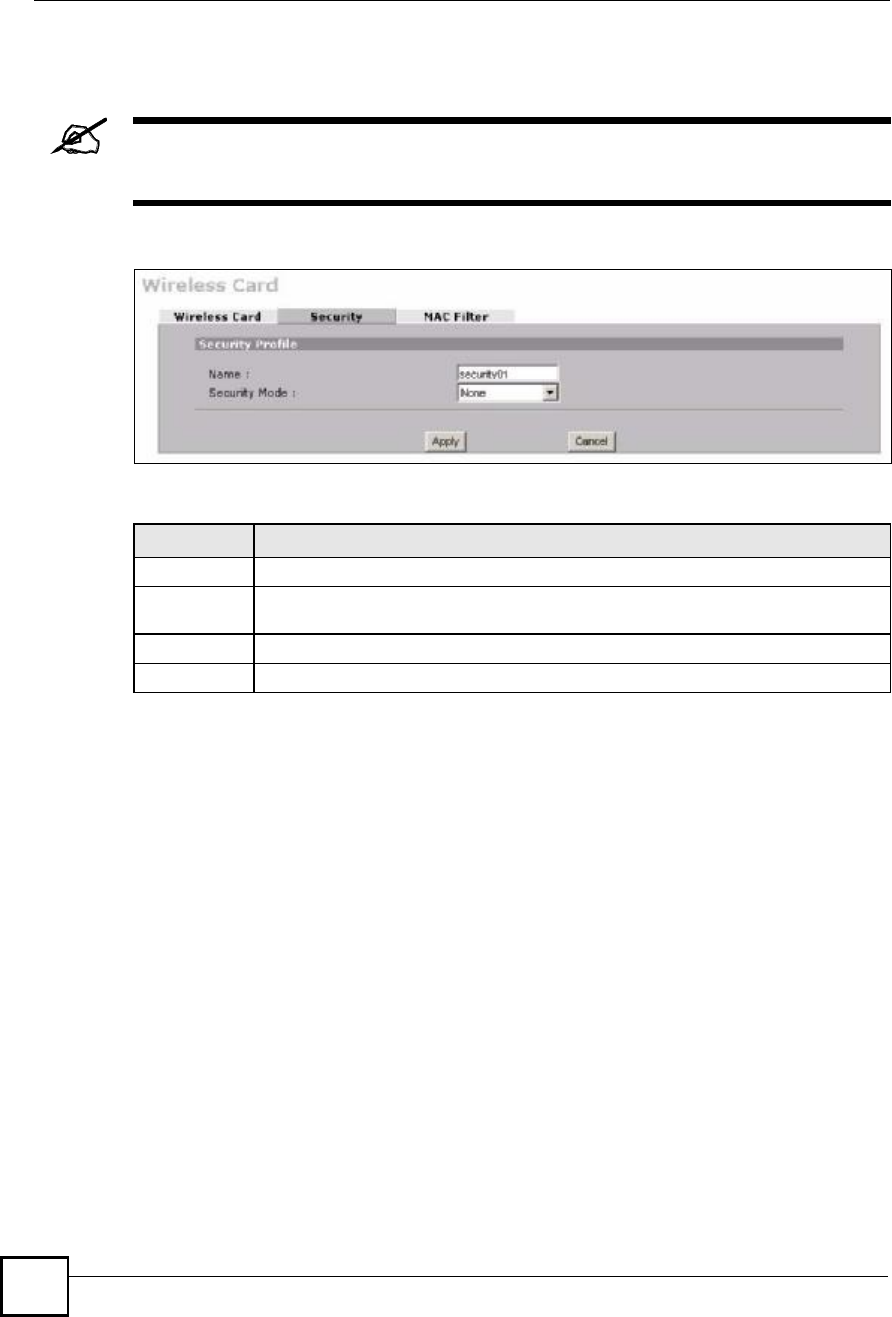
Chapter 8Wi-Fi
NBG410W3G Series User s Guide
156
8.4.1 No Security
If you do not enable any wireless security on your ZyXEL Device, your network
is accessible to any wireless networking device within range.
Figure 89 WIRELESS > Wi-Fi > Security: None
The following table describes the wireless LAN security labels in this screen.
8.4.2 Static WEP
Static WEP provides a mechanism for encrypting data using encryption keys. Both the AP and
the wireless stations must use the same WEP key to encrypt and decrypt data.
Your ZyXEL Device allows you to configure up to four 64-bit, 128-bit or 152-bit WEP keys,
but only one key can be used at any one time.
In order to configure and enable WEP encryption, click WIRELESS > Wi-Fi > Security >
Edit.
Table 33 WIRELESS > Wi-Fi > Security: None
LABEL DESCRIPTION
Name Type a name (up to 32 printable 7-bit ASCII characters) to identify this security profile.
Security ModeSelect None to allow wireless clients to communicate with the access points without
any data encryption.
ApplyClick Apply to save your customized settings and exit this screen.
CancelClick Cancel to exit this screen without saving.
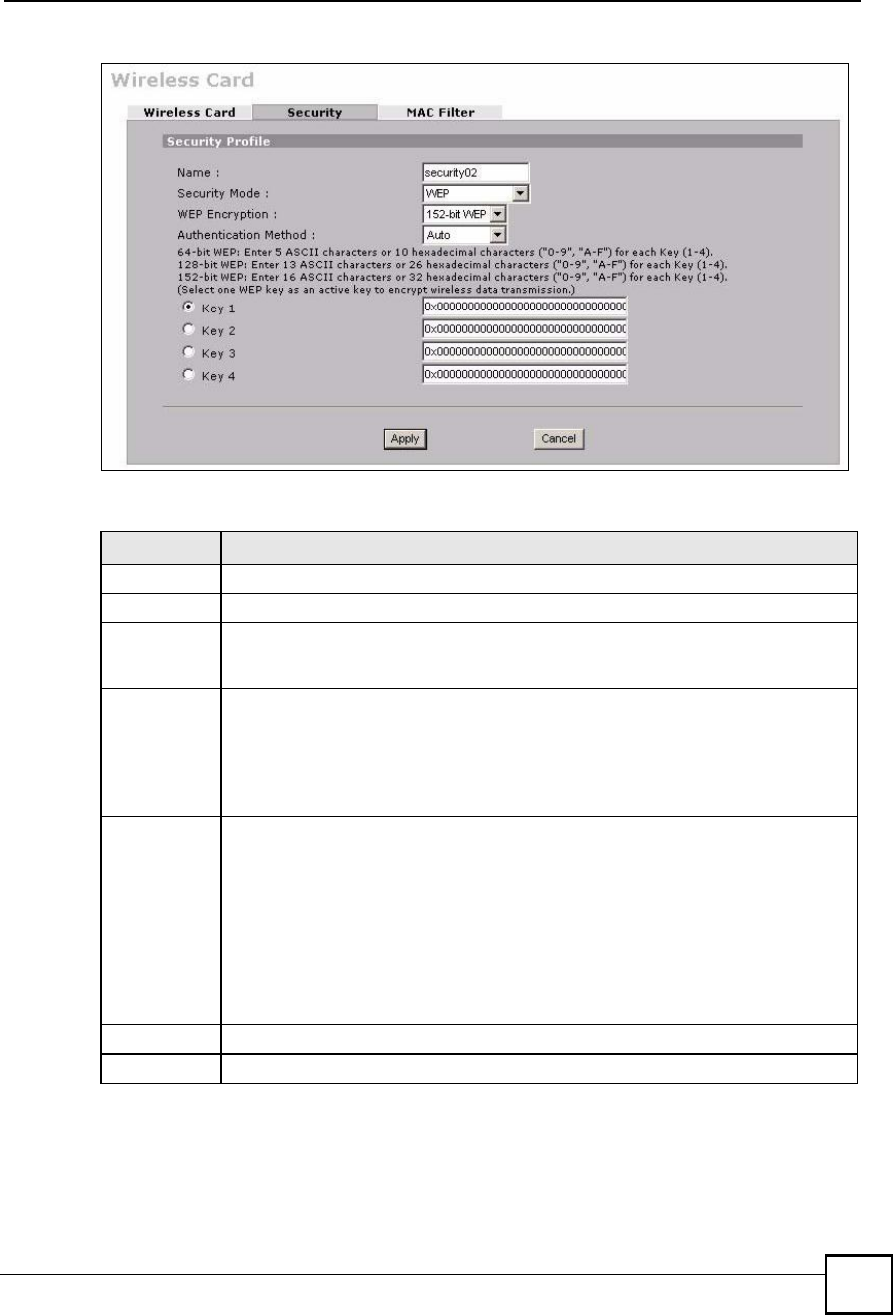
Chapter 8Wi-Fi
NBG410W3G Series User s Guide 157
Figure 90 WIRELESS > Wi-Fi > Security: WEP
The following table describes the labels in this screen.
8.4.3 IEEE 802.1x Only
Click the WIRELESS > Wi-Fi > Security > Edit. Select 8021X-Only from the Security
Mode list.
Table 34 WIRELESS > Wi-Fi > Security: WEP
LABEL DESCRIPTION
Name Type a name to identify this security profile.
Security ModeSelect WEP from the drop-down list.
WEP
Encryption
WEP (Wired Equivalent Privacy) provides data encryption to prevent unauthorized
wireless stations from accessing data transmitted over the wireless network.
Select 64-bit WEP, 128-bit WEP or 152-bit WEP to enable data encryption.
Authentication
Method
Select Shared-Key to have the ZyXEL Device use the default WEP key to
authenticate the wireless client to the ZyXEL Device.
Select Auto to have the ZyXEL Device switch between the shared-key and open
system (the wireless clients and AP do not share a secret key for authentication)
modes automatically.
The default setting is Auto.
Key 1 to Key 4The WEP keys are used to encrypt data. Both the ZyXEL Device and the wireless
clients must use the same WEP key for data transmission.
If you chose 64-bit WEP in the WEP Encryption field, then enter any 5 ASCII
characters or 10 hexadecimal characters ("0-9", "A-F") preceded by 0x for each key.
If you chose 128-bit WEP in the WEP Encryption field, then enter 13 ASCII
characters or 26 hexadecimal characters ("0-9", "A-F") preceded by 0x for each key.
If you chose 152-bit WEP in the WEP Encryption field, then enter 16 ASCII
characters or 32 hexadecimal characters ("0-9", "A-F") preceded by 0x for each key.
You can configure up to four keys, but only one key can be activated at any one time.
The default key is key 1.
ApplyClick Apply to save your customized settings and exit this screen.
CancelClick Cancel to exit this screen without saving.
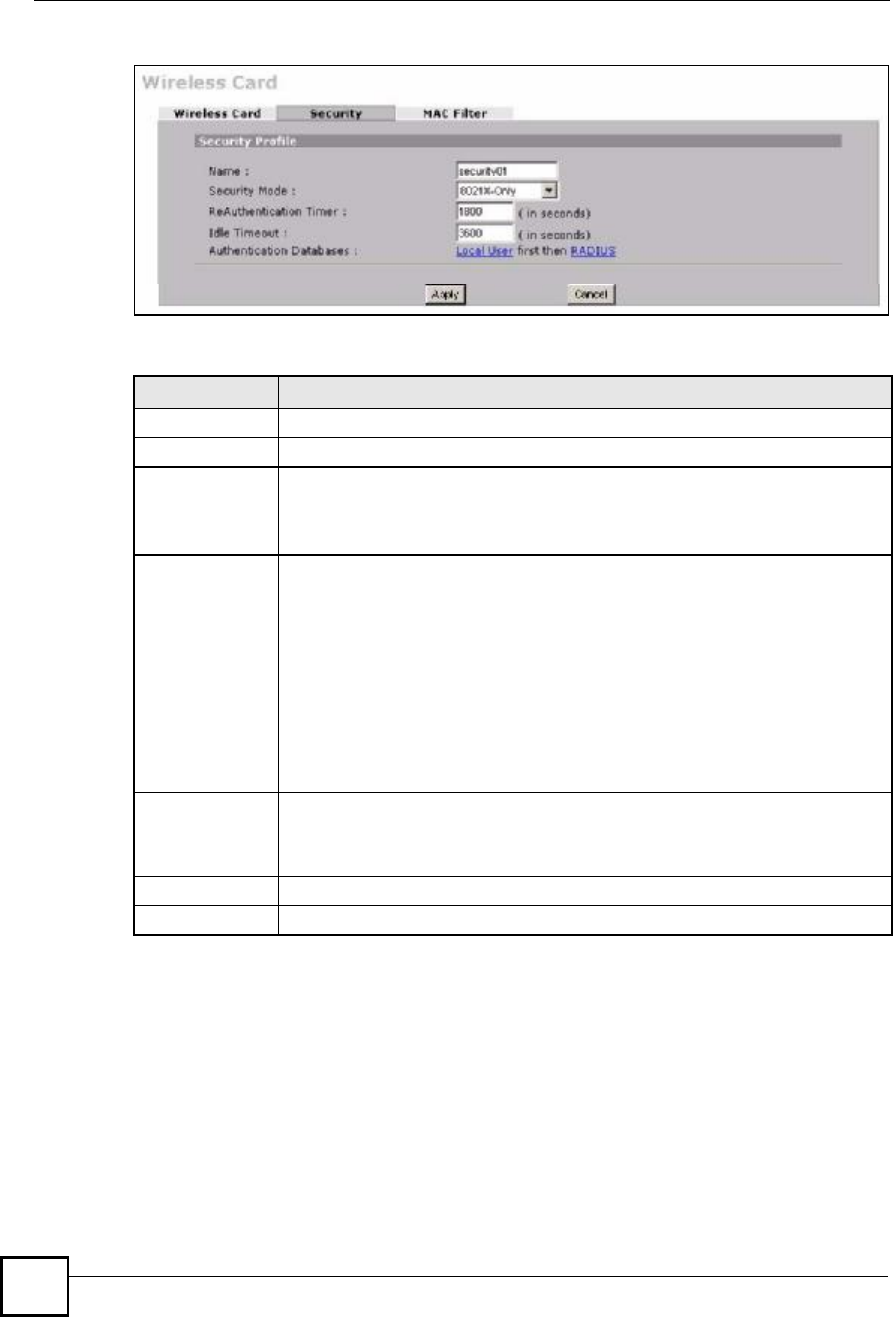
Chapter 8Wi-Fi
NBG410W3G Series User s Guide
158
Figure 91 WIRELESS > Wi-Fi > Security: 802.1x Only
The following table describes the labels in this screen.
8.4.4 IEEE 802.1x + Static WEP
Click the WIRELESS > Wi-Fi > Security > Edit. Select 8021X-Static 64 or 8021X-
Static128 in the Security Mode field to display the following screen.
Table 35 WIRELESS > Wi-Fi > Security: 802.1x Only
LABEL DESCRIPTION
Name Type a name to identify this security profile.
Security ModeSelect 8021X-Only from the drop-down list.
ReAuthentication
Timer
Specify how often wireless clients have to resend user names and passwords in
order to stay connected. Enter a time interval between 600 and 65535 seconds.
If wireless client authentication is done using a RADIUS server, the
reauthentication timer on the RADIUS server has priority.
Idle Timeout The ZyXEL Device automatically disconnects a wireless client from the wireless
network after a period of inactivity. The wireless client needs to send the username
and password again before it can use the wireless network again. Some wireless
clients may prompt users for a username and password; other clients may use
saved login credentials. In either case, there is usually a short delay while the
wireless client logs in to the wireless network again.
This value is usually smaller when the wireless network is keeping track of how
much time each wireless client is connected to the wireless network (for example,
using an authentication server). If the wireless network is not keeping track of this
information, you can usually set this value higher to reduce the number of delays
caused by logging in again.
Enter a time interval between 600 and 65535 seconds.
Authentication
Databases
Click Local User to go to the Local User Database screen where you can view
and/or edit the list of users and passwords. Click RADIUS to go to the RADIUS
screen where you can configure the ZyXEL Device to check an external RADIUS
server.
ApplyClick Apply to save your customized settings and exit this screen.
CancelClick Cancel to exit this screen without saving.
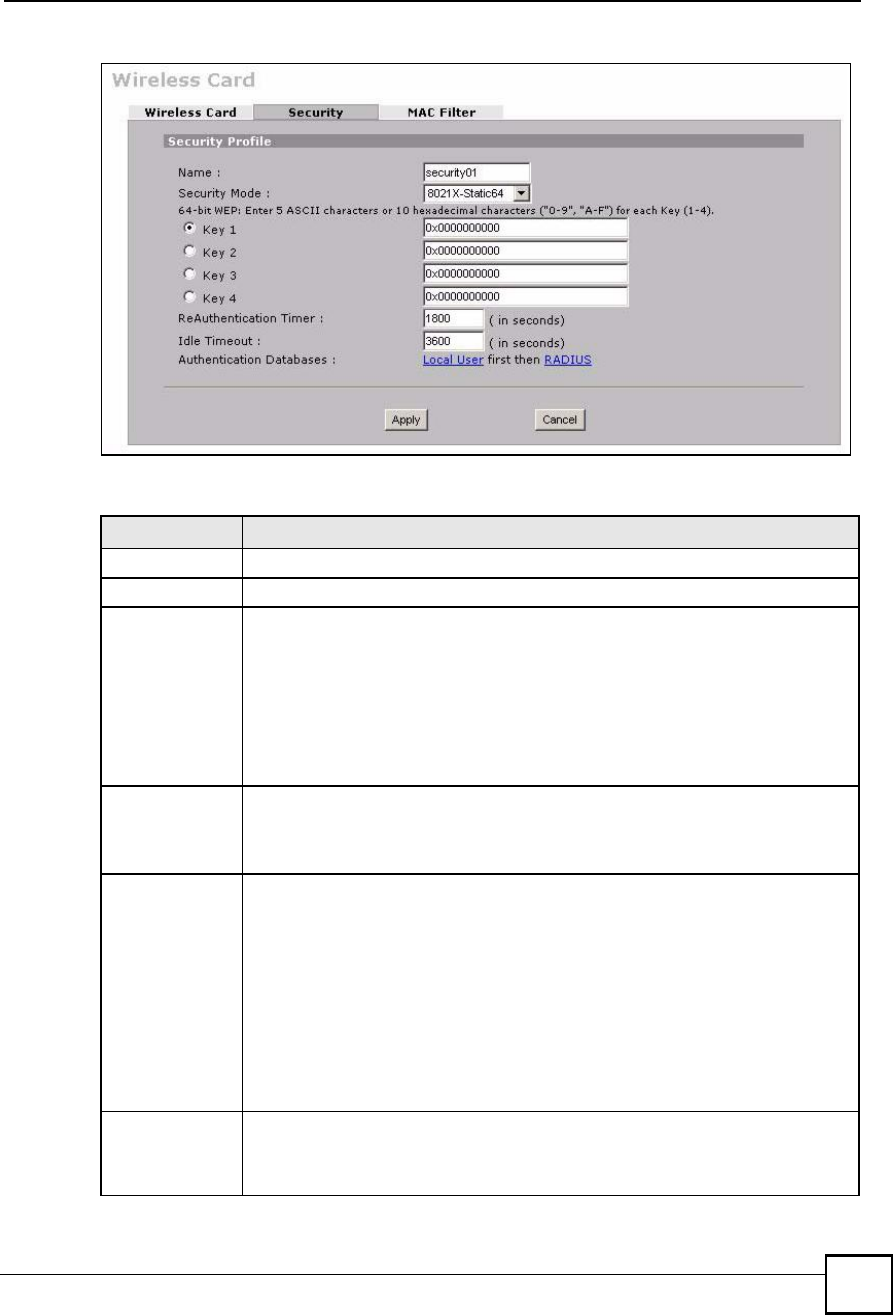
Chapter 8Wi-Fi
NBG410W3G Series User s Guide 159
Figure 92 WIRELESS > Wi-Fi > Security: 802.1x + Static WEP
The following table describes the labels in this screen.
Table 36 WIRELESS > Wi-Fi > Security: 802.1x + Static WEP
LABEL DESCRIPTION
Name Type a name to identify this security profile.
Security ModeSelect 8021X-Static64 or 8021X-Static128 from the drop-down list.
Key 1 to Key 4If you chose 8021X-Static64 in the Security Mode field, then enter any 5
characters (ASCII string) or 10 hexadecimal characters ("0-9", "A-F") preceded by
0x for each key.
If you chose 8021X-Static128 in the Security Mode field, then enter 13 characters
(ASCII string) or 26 hexadecimal characters ("0-9", "A-F") preceded by 0x for each
key.
There are four data encryption keys to secure your data from eavesdropping by
unauthorized wireless users. The values for the keys must be set up exactly the
same on the access points as they are on the wireless clients.
ReAuthentication
Timer
Specify how often wireless clients have to resend user names and passwords in
order to stay connected. Enter a time interval between 600 and 65535 seconds.
If wireless client authentication is done using a RADIUS server, the reauthentication
timer on the RADIUS server has priority.
Idle Timeout The ZyXEL Device automatically disconnects a wireless client from the wireless
network after a period of inactivity. The wireless client needs to send the username
and password again before it can use the wireless network again. Some wireless
clients may prompt users for a username and password; other clients may use
saved login credentials. In either case, there is usually a short delay while the
wireless client logs in to the wireless network again.
This value is usually smaller when the wireless network is keeping track of how
much time each wireless client is connected to the wireless network (for example,
using an authentication server). If the wireless network is not keeping track of this
information, you can usually set this value higher to reduce the number of delays
caused by logging in again.
Enter a time interval between 600 and 65535 seconds.
Authentication
Databases
Click Local User to go to the Local User Database screen where you can view
and/or edit the list of users and passwords. Click RADIUS to go to the RADIUS
screen where you can configure the ZyXEL Device to check an external RADIUS
server.
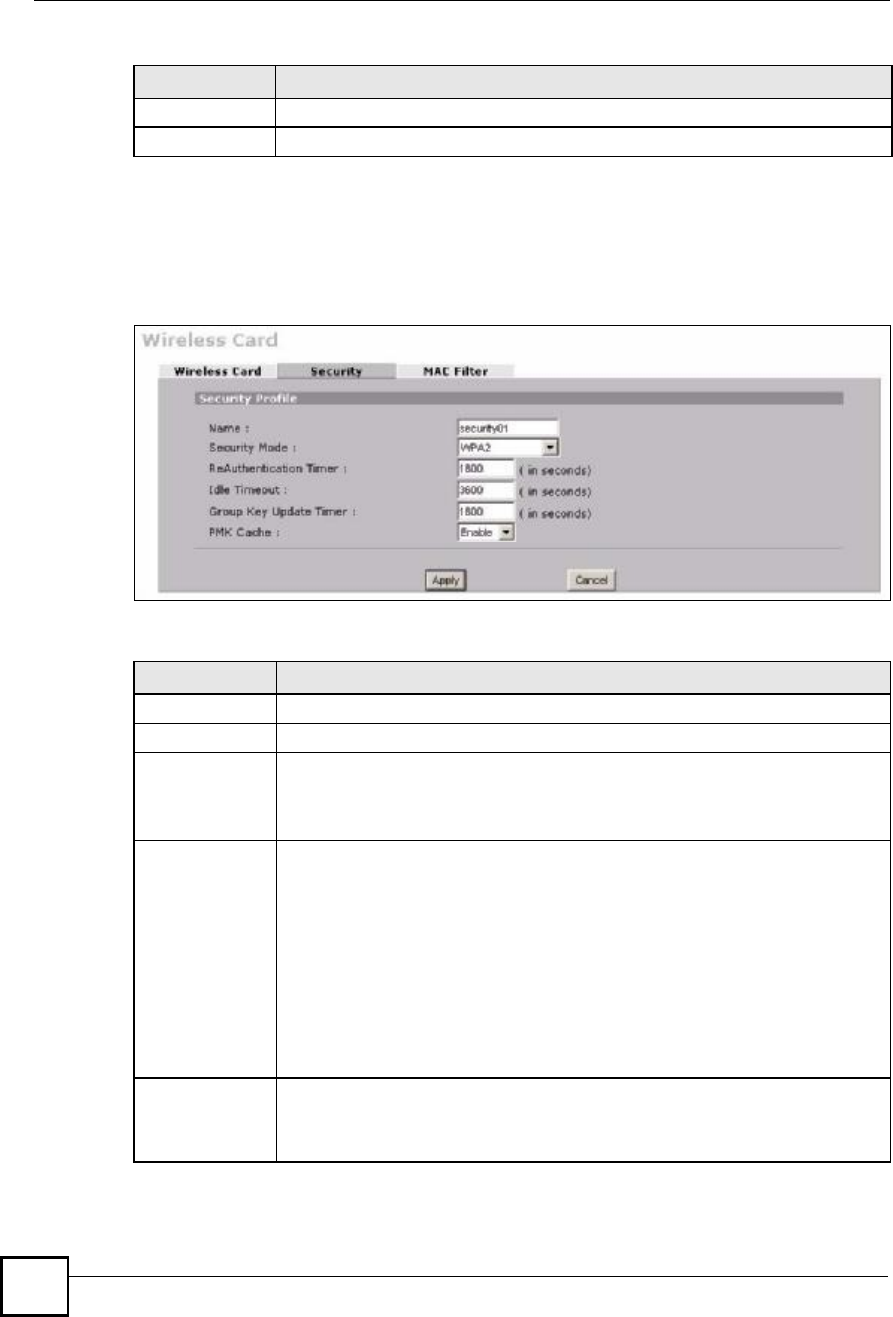
Chapter 8Wi-Fi
NBG410W3G Series User s Guide
160
8.4.5 WPA, WPA2, WPA2-MIX
Click WIRELESS > Wi-Fi > Security > Edit. Select WPA, WPA2 or WPA2-MIX from the
Security Mode list.
Figure 93 WIRELESS > Wi-Fi > Security: WPA, WPA2 or WPA2-MIX
The following table describes the labels in this screen.
ApplyClick Apply to save your customized settings and exit this screen.
CancelClick Cancel to exit this screen without saving.
Table 36 WIRELESS > Wi-Fi > Security: 802.1x + Static WEP (continued)
LABEL DESCRIPTION
Table 37 WIRELESS > Wi-Fi > Security: WPA, WPA2 or WPA2-MIX
LABEL DESCRIPTION
Name Type a name to identify this security profile.
Security ModeSelect WPA, WPA2 or WPA2-MIX from the drop-down list.
ReAuthentication
Timer
Specify how often wireless clients have to resend user names and passwords in
order to stay connected. Enter a time interval between 600 and 65535 seconds.
If wireless client authentication is done using a RADIUS server, the
reauthentication timer on the RADIUS server has priority.
Idle Timeout The ZyXEL Device automatically disconnects a wireless client from the wireless
network after a period of inactivity. The wireless client needs to send the username
and password again before it can use the wireless network again. Some wireless
clients may prompt users for a username and password; other clients may use
saved login credentials. In either case, there is usually a short delay while the
wireless client logs in to the wireless network again.
This value is usually smaller when the wireless network is keeping track of how
much time each wireless client is connected to the wireless network (for example,
using an authentication server). If the wireless network is not keeping track of this
information, you can usually set this value higher to reduce the number of delays
caused by logging in again.
Enter a time interval between 600 and 65535 seconds.
Group Key
Update Timer
The Group Key Update Timer is the rate at which the AP sends a new group key
out to all clients. The re-keying process is the WPA equivalent of automatically
changing the WEP key for an AP and all stations in a WLAN on a periodic basis.
Setting of the Group Key Update Timer is also supported in WPA(2)-PSK mode.
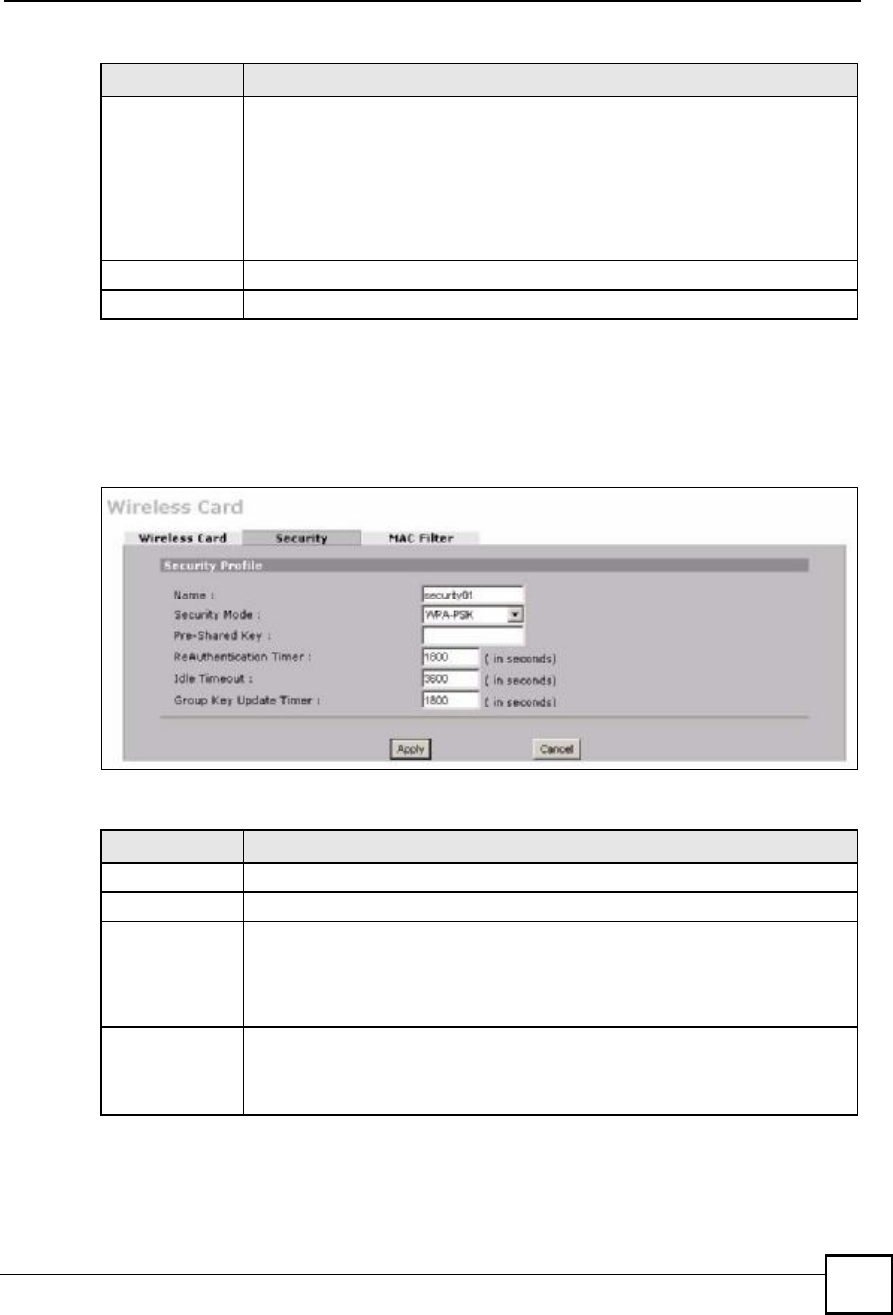
Chapter 8Wi-Fi
NBG410W3G Series User s Guide 161
8.4.6 WPA-PSK, WPA2-PSK, WPA2-PSK-MIX
Click WIRELESS > Wi-Fi > Security > Edit. Select WPA-PSK, WPA2-PSK or WPA2-
PSK-MIX from the Security Mode list.
Figure 94 WIRELESS > Wi-Fi > Security: WPA(2)-PSK
The following table describes the labels in this screen.
PMK Cache This field is available only when you select WPA2 or WPA2-MIX.
When a wireless client moves from one AP s coverage area to another, it performs
an authentication procedure (exchanging security information) with the new AP.
Instead of re-authenticating a client each time it returns to the AP s coverage area,
which can cause delays to time-sensitive applications, the AP and the client can
store (or "cache#) and use information about their previous authentication.
Select Enable to allow PMK (Pairwise Master Key) caching, or Disable to switch
this feature off.
ApplyClick Apply to save your customized settings and exit this screen.
CancelClick Cancel to exit this screen without saving.
Table 37 WIRELESS > Wi-Fi > Security: WPA, WPA2 or WPA2-MIX (continued)
LABEL DESCRIPTION
Table 38 WIRELESS > Wi-Fi > Security: WPA(2)-PSK
LABEL DESCRIPTION
Name Type a name to identify this security profile.
Security ModeSelect WPA-PSK, WPA2-PSK or WPA2-PSK-MIX from the drop-down list.
Pre-Shared KeyThe encryption mechanisms used for WPA(2) and WPA(2)-PSK are the same. The
only difference between the two is that WPA(2)-PSK uses a simple common
password, instead of user-specific credentials.
Type a pre-shared key from 8 to 63 case-sensitive ASCII characters (including
spaces and symbols).
ReAuthentication
Timer
Specify how often wireless clients have to resend user names and passwords in
order to stay connected. Enter a time interval between 600 and 65535 seconds.
If wireless client authentication is done using a RADIUS server, the
reauthentication timer on the RADIUS server has priority.

Chapter 8Wi-Fi
NBG410W3G Series User s Guide
162
8.5 MAC Filter
The MAC filter screen allows you to configure the ZyXEL Device to give exclusive access to
specific devices (Allow) or exclude specific devices from accessing the ZyXEL Device
(Deny). Every Ethernet device has a unique MAC (Media Access Control) address. The MAC
address is assigned at the factory and consists of six pairs of hexadecimal characters, for
example, 00:A0:C5:00:00:02. You need to know the MAC addresses of the devices to
configure this screen.
To change your ZyXEL Device!s MAC filter settings, click the WIRELESS > Wi-Fi > MAC
Filter. The screen appears as shown.
To activate MAC filtering on a profile, select Enable from the Enable MAC
Filtering drop-down list box in the Wireless Card > Edit screen and click
Apply.
Idle Timeout The ZyXEL Device automatically disconnects a wireless client from the wireless
network after a period of inactivity. The wireless client needs to send the username
and password again before it can use the wireless network again. Some wireless
clients may prompt users for a username and password; other clients may use
saved login credentials. In either case, there is usually a short delay while the
wireless client logs in to the wireless network again.
This value is usually smaller when the wireless network is keeping track of how
much time each wireless client is connected to the wireless network (for example,
using an authentication server). If the wireless network is not keeping track of this
information, you can usually set this value higher to reduce the number of delays
caused by logging in again.
Enter a time interval between 600 and 65535 seconds.
Group Key
Update Timer
The Group Key Update Timer is the rate at which the AP sends a new group key
out to all clients. The re-keying process is the WPA equivalent of automatically
changing the WEP key for an AP and all stations in a WLAN on a periodic basis.
Setting of the Group Key Update Timer is also supported in WPA(2)-PSK mode.
ApplyClick Apply to save your customized settings and exit this screen.
CancelClick Cancel to exit this screen without saving.
Table 38 WIRELESS > Wi-Fi > Security: WPA(2)-PSK (continued)
LABEL DESCRIPTION
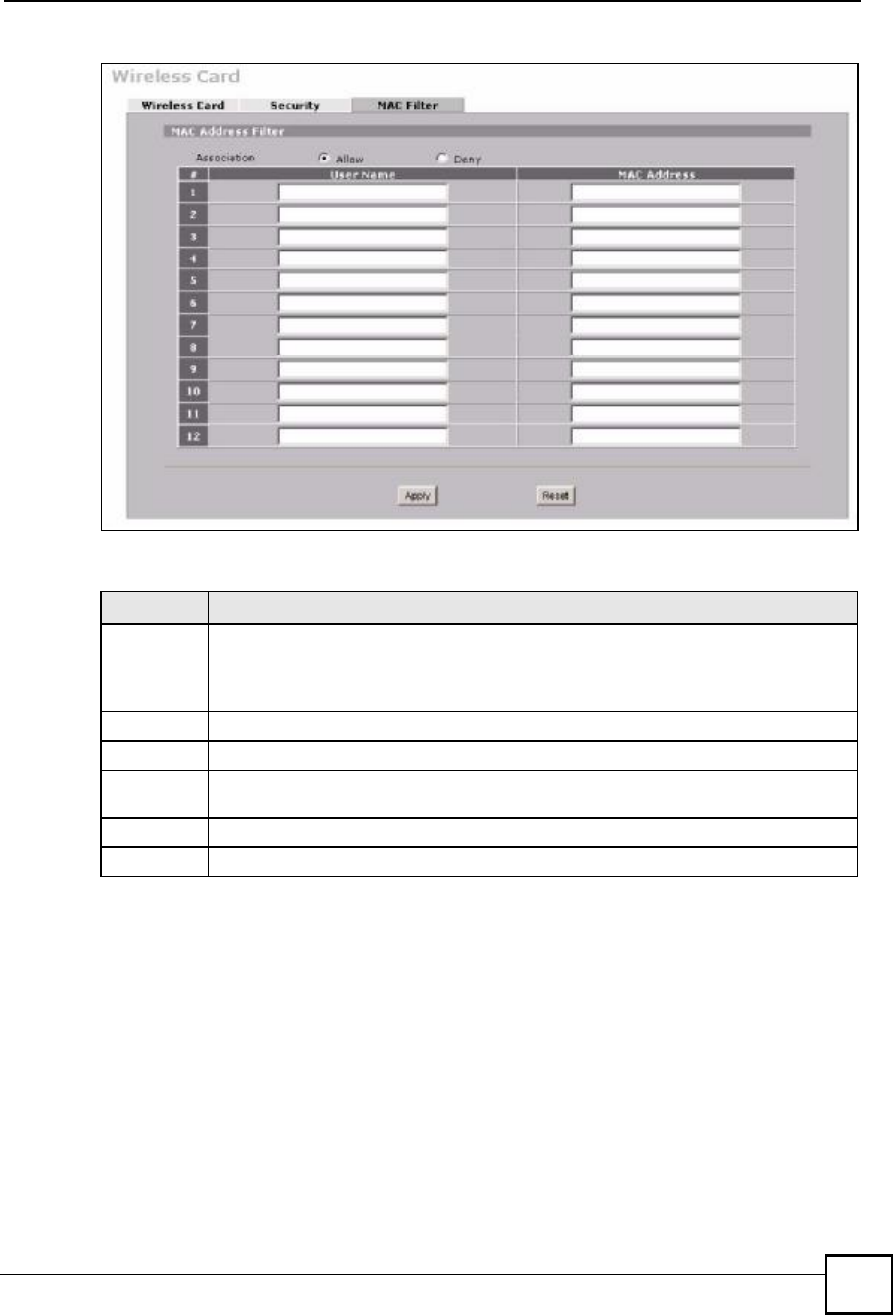
Chapter 8Wi-Fi
NBG410W3G Series User s Guide 163
Figure 95 WIRELESS > Wi-Fi > MAC Filter
The following table describes the labels in this menu.
Table 39 WIRELESS > Wi-Fi > MAC Filter
LABEL DESCRIPTION
Association Define the filter action for the list of MAC addresses in the MAC address filter table.
Select Deny to block access to the router, MAC addresses not listed will be allowed to
access the router. Select Allow to permit access to the router, MAC addresses not listed
will be denied access to the router.
#This is the index number of the MAC address.
User NameEnter a descriptive name for the MAC address.
MAC
Address
Enter the MAC addresses (in XX:XX:XX:XX:XX:XX format) of the wireless stations that
are allowed or denied access to the ZyXEL Device in these address fields.
ApplyClick Apply to save your changes back to the ZyXEL Device.
ResetClick Reset to begin configuring this screen afresh.

Chapter 8Wi-Fi
NBG410W3G Series User s Guide
164

165
PART IV
Security
Firewall (167)
Certificates (195)
Authentication Server (191)

166
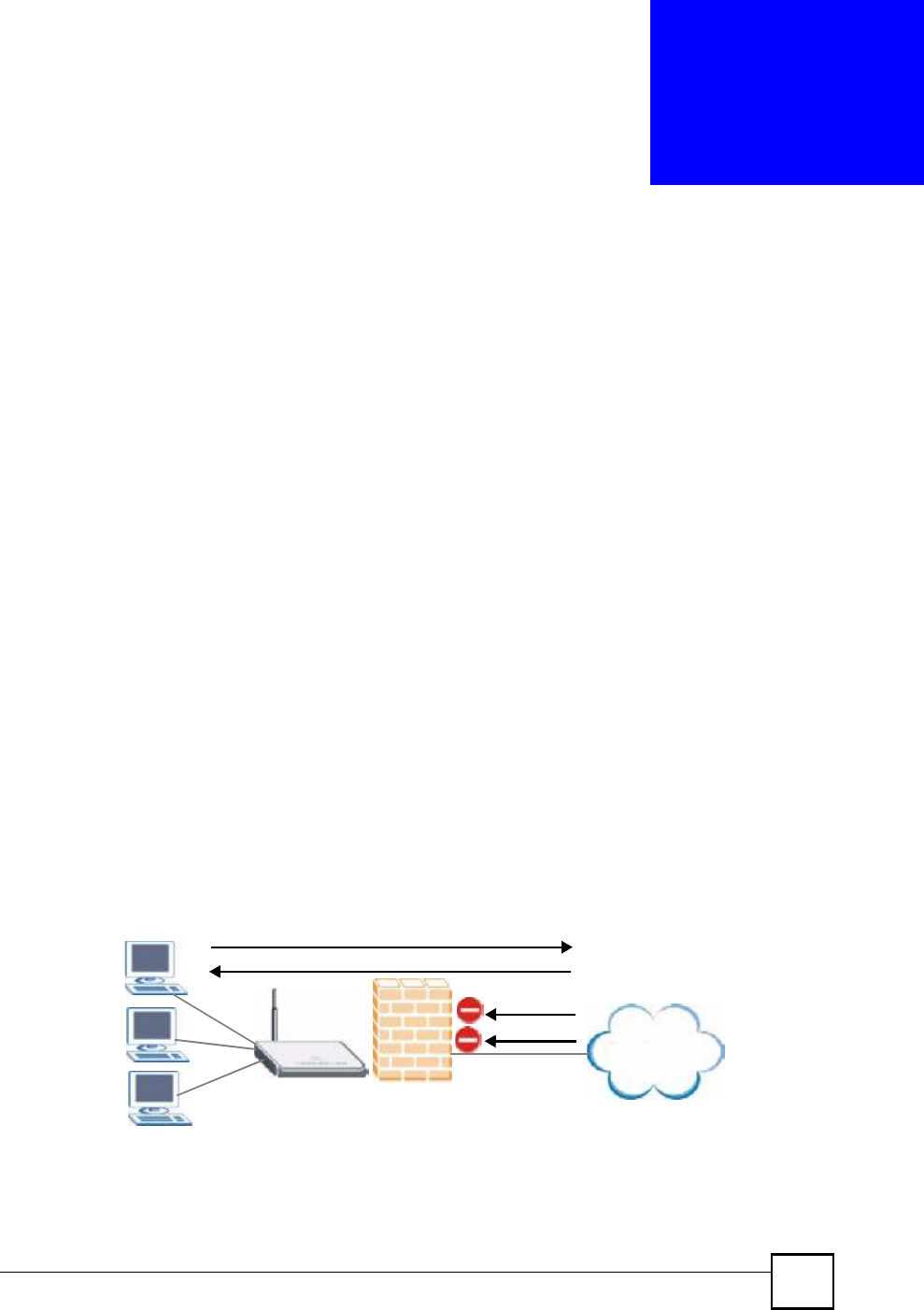
NBG410W3G Series User s Guide 167
CHAPTER 9
Firewall
This chapter shows you how to configure your ZyXEL Device!s firewall.
9.1 Firewall Overview
The networking term firewall is a system or group of systems that enforces an access-control
policy between two networks. It is generally a mechanism used to protect a trusted network
from an untrusted network.
The ZyXEL Device physically separates the LAN, DMZ and the WAN and acts as a secure
gateway for all data passing between the networks. The ZyXEL Device protects against Denial
of Service (DoS) attacks, prevents theft, destruction and modification of data, and logs events.
Enable the firewall to protect your LAN computers from attacks by hackers on the Internet and
control access between the LAN, DMZ and WAN. By default the firewall:
allows traffic that originates from your LAN computers to go to all of the networks.
blocks traffic that originates on the other networks from going to the LAN.
allows traffic that originates on the WAN to go to the DMZ and protects your DMZ
computers against DoS attacks.
The following figure illustrates the default firewall action. User A can initiate an IM (Instant
Messaging) session from the LAN to the WAN (1). Return traffic for this session is also
allowed (2). However other traffic initiated from the WAN is blocked (3 and 4).
Figure 96 Default Firewall Action
Your customized rules take precedence and override the ZyXEL Device!s default settings. The
ZyXEL Device checks the source IP address, destination IP address and IP protocol type of
network traffic against the firewall rules (in the order you list them). When the traffic matches
a rule, the ZyXEL Device takes the action specified in the rule.
WAN
LAN
Internet
3
4
1
2
A
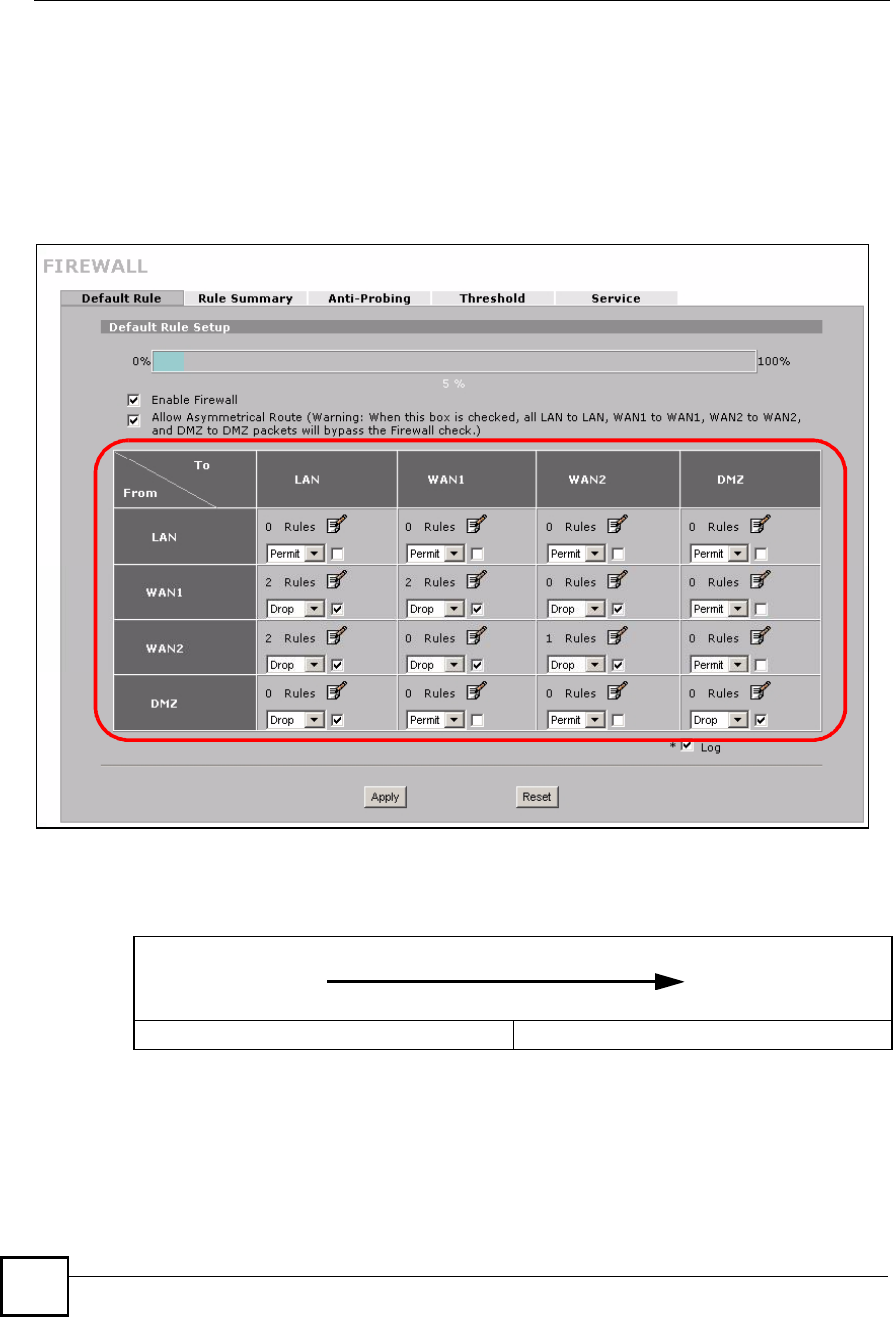
Chapter 9Firewall
NBG410W3G Series User s Guide
168
9.2 Packet Direction Matrix
The ZyXEL Device!s packet direction matrix allows you to apply certain security settings
(like firewall) to traffic flowing in specific directions.
For example, click SECURITY > FIREWALL to open the following screen. This screen
configures general firewall settings.
Figure 97 SECURITY > FIREWALL > Default Rule
Packets have a source and a destination. The packet direction matrix in the lower part of the
screen sets what the ZyXEL Device does with packets traveling in a specific direction that do
not match any of the firewall rules.
To set the ZyXEL Device to block traffic from WAN 1 from going to the DMZ interfaces, find
where the From WAN1 row and the To DMZ column intersect and set the field to Drop as
shown.
A specific interface A specific interface
From To
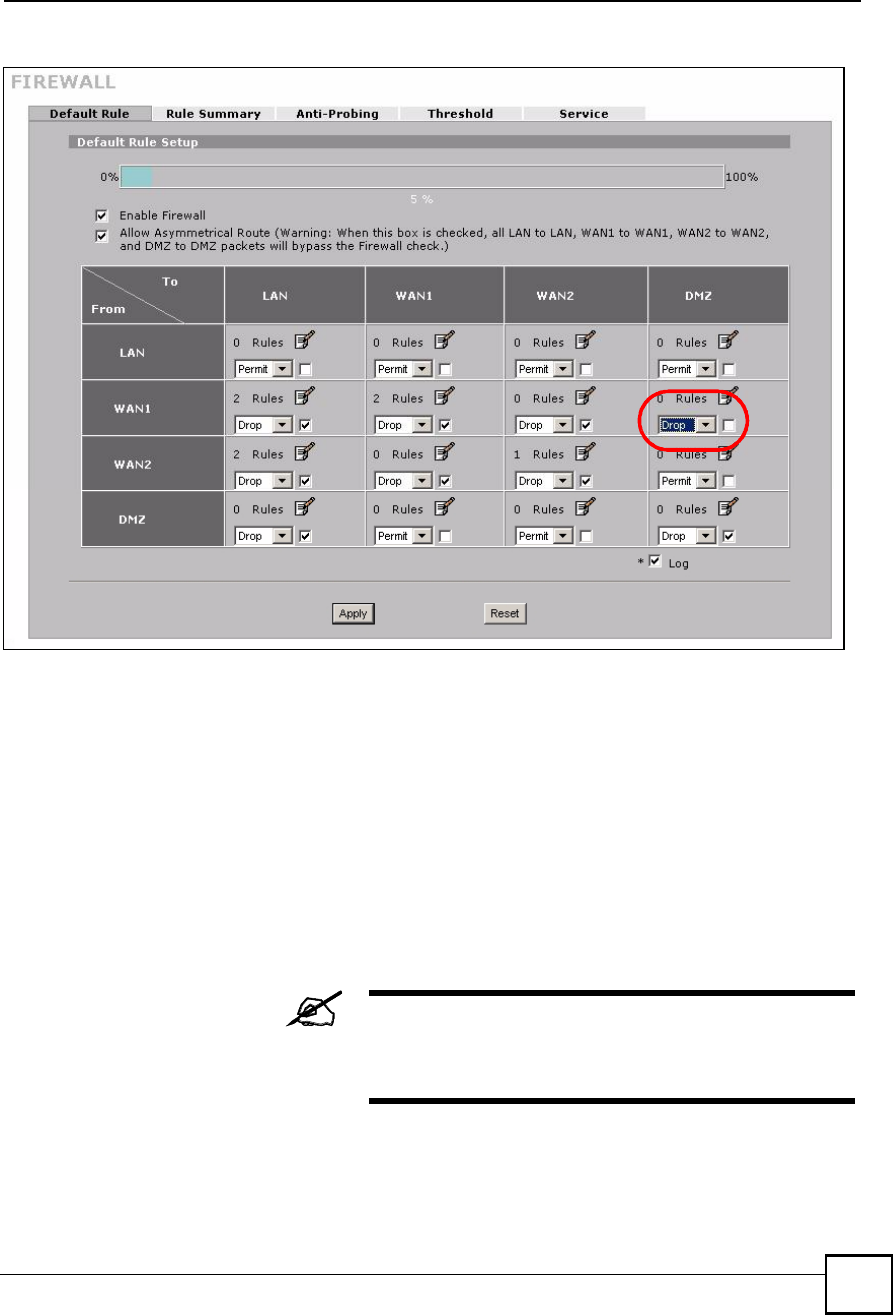
Chapter 9Firewall
NBG410W3G Series User s Guide 169
Figure 98 Default Block Traffic From WAN1 to DMZ Example
9.3 Packet Direction Examples
Firewall rules are grouped based on the direction of travel of packets to which they apply. This
section gives some examples of why you might configure firewall rules for specific
connection directions.
By default, the ZyXEL Device allows packets traveling in the following directions.:
LAN to LANThese rules specify which computers on the LAN can manage the
ZyXEL Device (remote management) and communicate between
networks or subnets connected to the LAN interface (IP alias).
You can also configure the remote management
settings to allow only a specific computer to
manage the ZyXEL Device.
LAN to WAN
1
These rules specify which computers on the LAN can access which
computers or services connected to WAN 1. See Section 9.5 on page 171
for an example.

Chapter 9Firewall
NBG410W3G Series User s Guide
170
By default, the ZyXEL Device drops packets traveling in the following directions.
9.4 Security Considerations
Incorrectly configuring the firewall may block valid access or introduce security
risks to the ZyXEL Device and your protected network. Use caution when
creating or deleting firewall rules and test your rules after you configure them.
Consider these security ramifications before creating a rule:
WAN 1 to LANThese rules specify which computers connected to WAN 1 can access
which computers or services on the LAN. For example, you may
create rules to:
Allow certain types of traffic, such as Lotus Notes database
synchronization, from specific hosts on the Internet to specific
hosts on the LAN.
Allow public access to a Web server on your protected network.
You could also block certain IP addresses from accessing it.
You also need to configure NAT port forwarding
(or full featured NAT address mapping rules) to
allow computers on the WAN to access devices
on the LAN. See Section 12.5.3 on page 236 for
an example.
WAN to WANBy default the ZyXEL Device stops computers connected to WAN1 or
WAN2 from managing the ZyXEL Device or using the ZyXEL Device
as a gateway to communicate with other computers on the WAN. You
could configure one of these rules to allow a WAN computer to
manage the ZyXEL Device.
You also need to configure the remote
management settings to allow a WAN computer
to manage the ZyXEL Device.
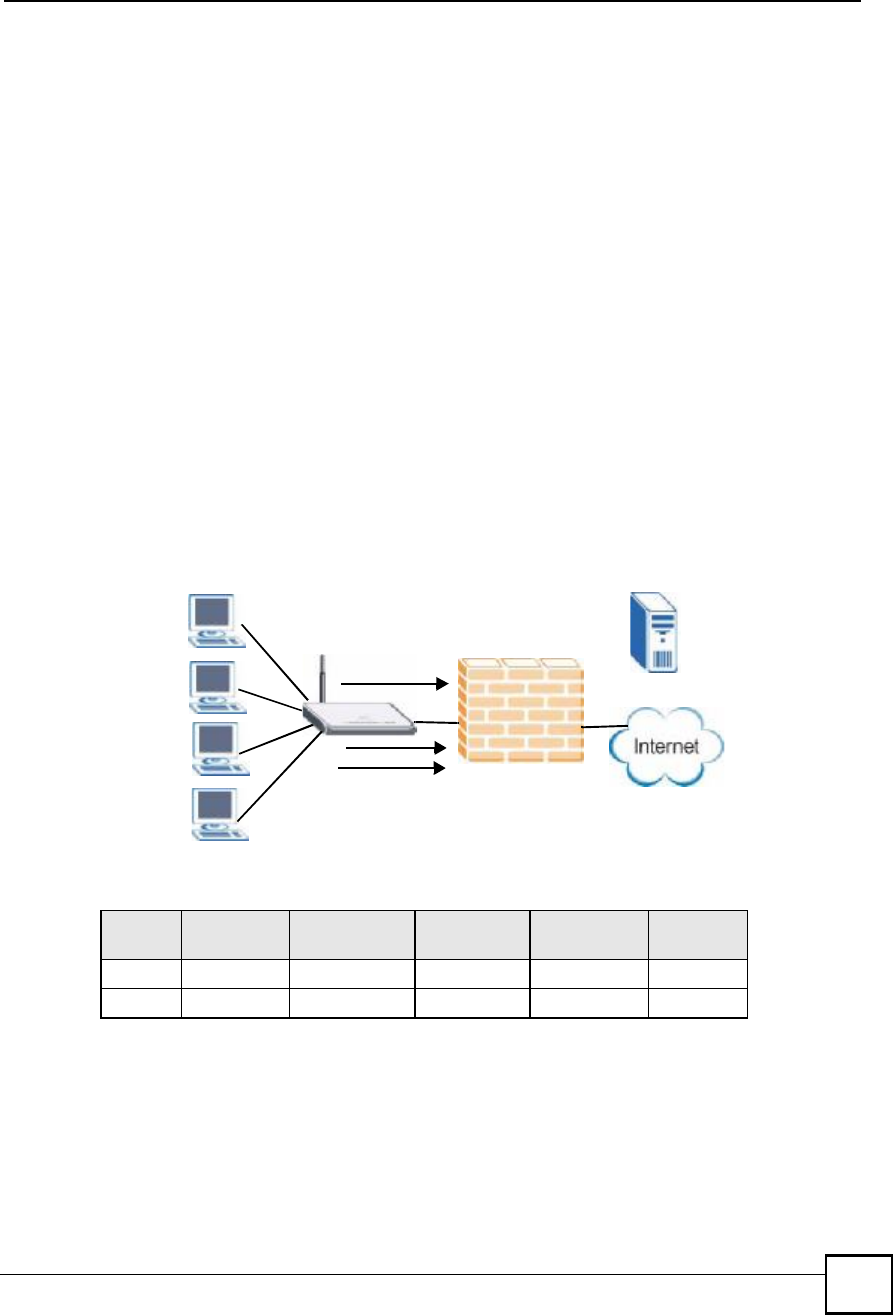
Chapter 9Firewall
NBG410W3G Series User s Guide 171
1Does this rule stop LAN users from accessing critical resources on the Internet? For
example, if IRC is blocked, are there users that require this service?
2Is it possible to modify the rule to be more specific? For example, if IRC is blocked for
all users, will a rule that blocks just certain users be more effective?
3Does a rule that allows Internet users access to resources on the LAN create a security
vulnerability? For example, if FTP ports (TCP 20, 21) are allowed from the Internet to
the LAN, Internet users may be able to connect to computers with running FTP servers.
4Does this rule conflict with any existing rules?
Once these questions have been answered, adding rules is simply a matter of entering the
information into the correct fields in the web configurator screens.
9.5 Firewall Rules Example
Suppose that your company decides to block all of the LAN users from using IRC (Internet
Relay Chat) through the Internet. To do this, you would configure a LAN to WAN firewall rule
that blocks IRC traffic from any source IP address from going to any destination address. You
do not need to specify a schedule since you need the firewall rule to always be in effect. The
following figure shows the results of this rule.
Figure 99 Blocking All LAN to WAN IRC Traffic Example
Your firewall would have the following configuration.
The first row blocks LAN access to the IRC service on the WAN.
The second row is the firewall!s default policy that allows all traffic from the LAN to go to
the WAN.
Table 40 Blocking All LAN to WAN IRC Traffic Example
#SOURCE DESTINATIO
NSCHEDULE SERVICE ACTION
1AnyAnyAnyIRCDrop
DefaultAnyAnyAnyAnyAllow
LANWAN
IRC
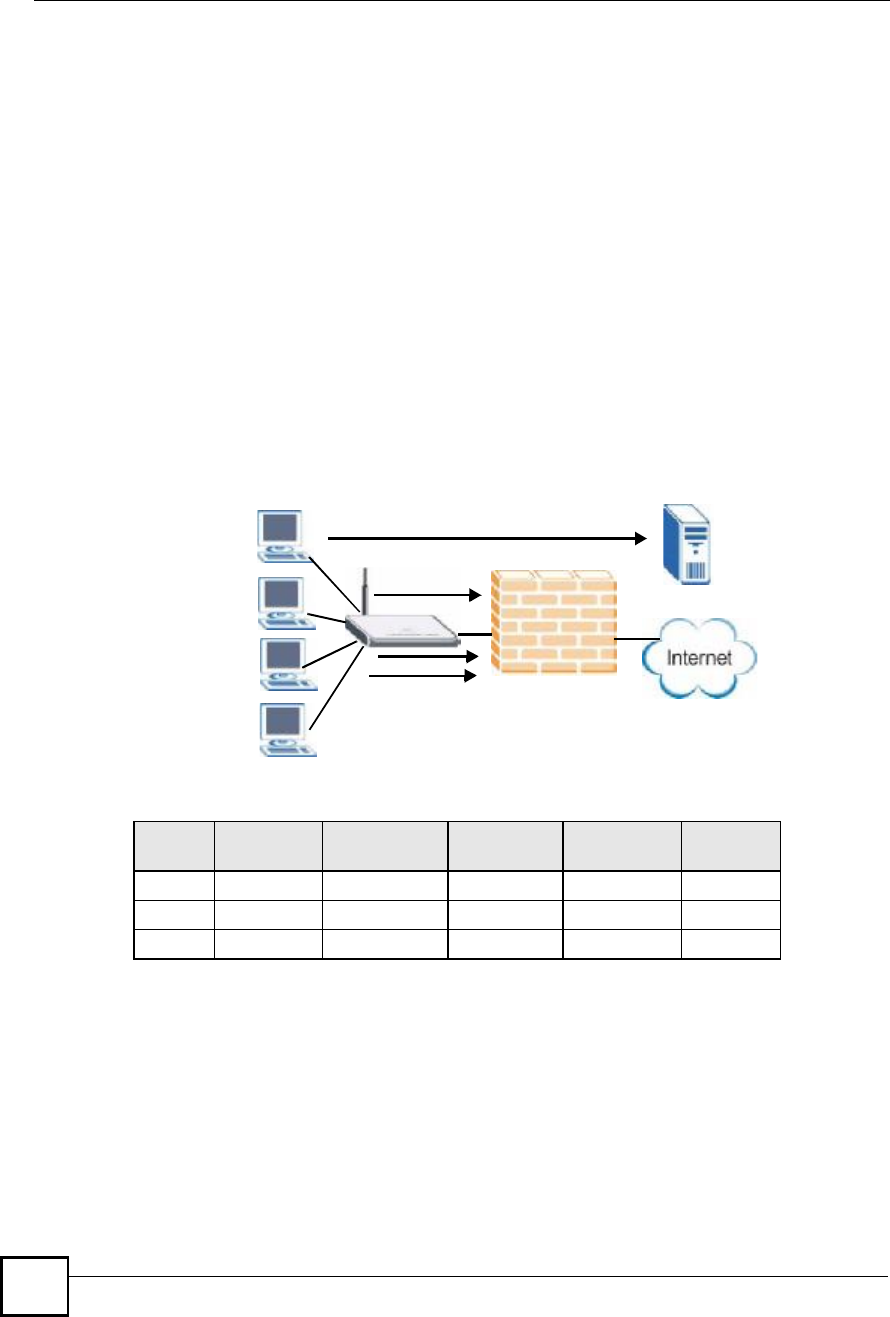
Chapter 9Firewall
NBG410W3G Series User s Guide
172
The ZyXEL Device applies the firewall rules in order. So for this example, when the ZyXEL
Device receives traffic from the LAN, it checks it against the first rule. If the traffic matches (if
it is IRC traffic) the firewall takes the action in the rule (drop) and stops checking the firewall
rules. Any traffic that does not match the first firewall rule will match the default rule and the
ZyXEL Device forwards it.
Now suppose that your company wants to let the CEO use IRC. You can configure a LAN to
WAN firewall rule that allows IRC traffic from the IP address of the CEO!s computer. In order
to make sure that the CEO!s computer always uses the same IP address, make sure it either:
has a static IP address,
or you configure a static DHCP entry for it so the ZyXEL Device always assigns it the
same IP address (see Section 5.8 on page 106 for information on static DHCP).
Now you configure a LAN to WAN firewall rule that allows IRC traffic from the IP address of
the CEO!s computer (192.168.1.7 for example) to go to any destination address. You do not
need to specify a schedule since you want the firewall rule to always be in effect. The
following figure shows the results of your two custom rules.
Figure 100 Limited LAN to WAN IRC Traffic Example
Your firewall would have the following configuration.
The first row allows the LAN computer at IP address 192.168.1.7 to access the IRC
service on the WAN.
The second row blocks LAN access to the IRC service on the WAN.
The third row is (still) the firewall!s default policy of allowing all traffic from the LAN to
go to the WAN.
The rule for the CEO must come before the rule that blocks all LAN to WAN IRC traffic. If the
rule that blocks all LAN to WAN IRC traffic came first, the CEO!s IRC traffic would match
that rule and the ZyXEL Device would drop it and not check any other firewall rules.
Table 41 Limited LAN to WAN IRC Traffic Example
#SOURCE DESTINATIO
NSCHEDULE SERVICE ACTION
1192.168.1.7AnyAnyIRCAllow
2AnyAnyAnyIRCDrop
DefaultAnyAnyAnyAnyAllow
LAN
192.168.1.7
CEO WAN
IRC
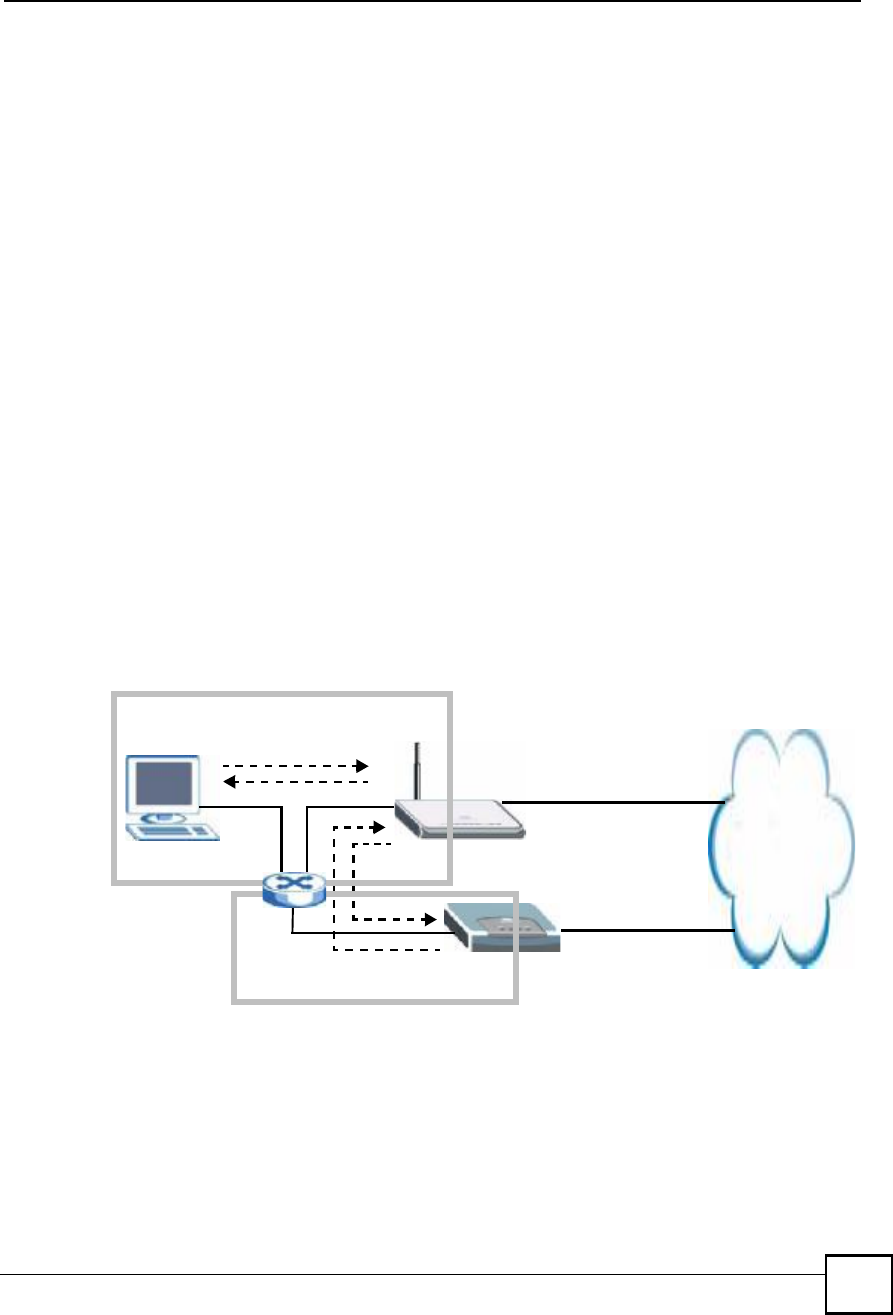
Chapter 9Firewall
NBG410W3G Series User s Guide 173
9.6 Asymmetrical Routes
If an alternate gateway on the LAN has an IP address in the same subnet as the ZyXEL
Device!s LAN IP address, return traffic may not go through the ZyXEL Device. This is called
an asymmetrical or "triangle# route. This causes the ZyXEL Device to reset the connection, as
the connection has not been acknowledged.
You can have the ZyXEL Device permit the use of asymmetrical route topology on the
network (not reset the connection).
Allowing asymmetrical routes may let traffic from the WAN go directly to the LAN without
passing through the ZyXEL Device. A better solution is to use IP alias to put the ZyXEL
Device and the backup gateway on separate subnets.
9.6.1 Asymmetrical Routes and IP Alias
You can use IP alias instead of allowing asymmetrical routes. IP Alias allow you to partition
your network into logical sections over the same interface.
By putting your LAN and Gateway A in different subnets, all returning network traffic must
pass through the ZyXEL Device to your LAN. The following steps describe such a scenario.
1A computer on the LAN initiates a connection by sending a SYN packet to a receiving
server on the WAN.
2The ZyXEL Device reroutes the packet to Gateway A, which is in Subnet 2.
3The reply from the WAN goes to the ZyXEL Device.
4The ZyXEL Device then sends it to the computer on the LAN in Subnet 1.
Figure 101 Using IP Alias to Solve the Triangle Route Problem
9.7 Firewall Default Rule
Click SECURITY > FIREWALL to open the Default Rule screen.
Use this screen to configure general firewall settings.
1
2Internet
3
LAN
A
ISP 1
ISP 2
4
WAN
Subnet 1
Subnet 2
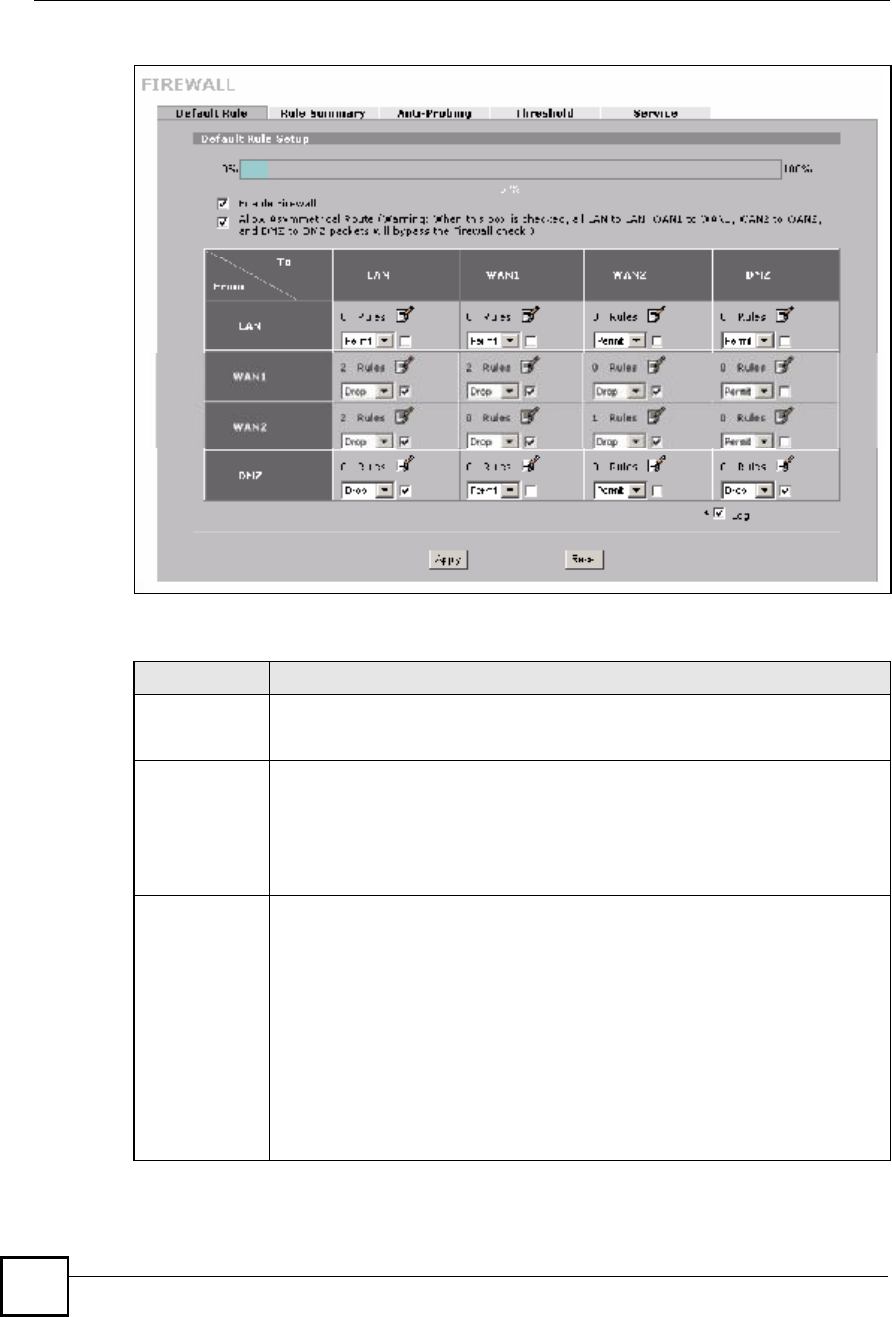
Chapter 9Firewall
NBG410W3G Series User s Guide
174
Figure 102 SECURITY > FIREWALL > Default Rule
The following table describes the labels in this screen.
Table 42 SECURITY > FIREWALL > Default Rule
LABEL DESCRIPTION
0-100%This bar displays the percentage of the ZyXEL Device s firewall rules storage space
that is currently in use. When the storage space is almost full, you should consider
deleting unnecessary firewall rules before adding more firewall rules.
Enable FirewallSelect this check box to activate the firewall. The ZyXEL Device performs access
control and protects against Denial of Service (DoS) attacks when the firewall is
activated.
Note: When you activate the firewall, all current connections through
the ZyXEL Device are dropped when you apply your changes.
Allow
Asymmetrical
Route
If an alternate gateway on the LAN has an IP address in the same subnet as the
ZyXEL Device s LAN IP address, return traffic may not go through the ZyXEL
Device. This is called an asymmetrical or "triangle# route. This causes the ZyXEL
Device to reset the connection, as the connection has not been acknowledged.
Select this check box to have the ZyXEL Device permit the use of asymmetrical
route topology on the network (not reset the connection).
Note: Allowing asymmetrical routes may let traffic from the WAN go
directly to the LAN without passing through the ZyXEL Device.
A better solution is to use IP alias to put the ZyXEL Device
and the backup gateway on separate subnets. See Section
9.6.1 on page 173 for an example.

Chapter 9Firewall
NBG410W3G Series User s Guide 175
9.8 Firewall Rule Summary
Click SECURITY > FIREWALL > Rule Summary to open the screen. This screen displays
a list of the configured firewall rules.
The ordering of your rules is very important as rules are applied in the order
that they are listed.
See Section 9.1 on page 167 for more information about the firewall.
From, ToThe firewall rules are grouped by the direction of packet travel. This displays the
number of rules for each packet direction. Click the edit icon to go to a summary
screen of the rules for that packet direction.
Here is an example description of the directions of travel.
From LAN To LAN means packets traveling from a computer on one LAN subnet to
a computer on another LAN subnet on the LAN interface of the ZyXEL Device or the
ZyXEL Device itself. The ZyXEL Device does not apply the firewall to packets
traveling from a LAN computer to another LAN computer on the same subnet.
Use the drop-down list box to set the firewall s default actions based on the direction
of travel of packets.
Select Drop to silently discard the packets without sending a TCP reset packet or an
ICMP destination-unreachable message to the sender.
Select Reject to deny the packets and send a TCP reset packet (for a TCP packet)
or an ICMP destination-unreachable message (for a UDP packet) to the sender.
Select Permit to allow the passage of the packets.
LogSelect the check box next to a direction of packet travel to create a log when the
above action is taken for packets that are traveling in that direction and do not match
any of your customized rules.
ApplyClick Apply to save your changes.
ResetClick Reset to begin configuring this screen afresh.
Table 42 SECURITY > FIREWALL > Default Rule (continued)
LABEL DESCRIPTION
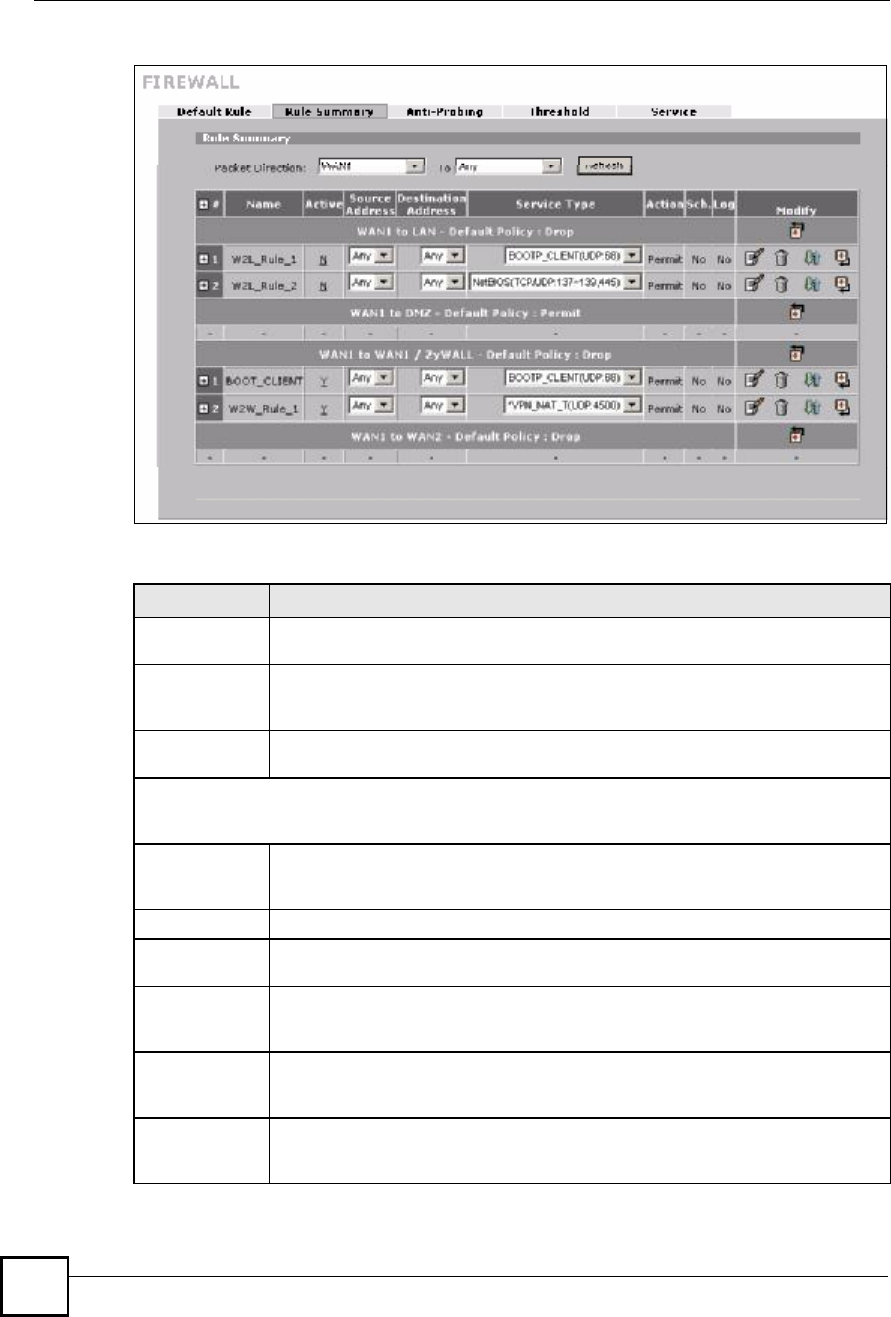
Chapter 9Firewall
NBG410W3G Series User s Guide
176
Figure 103 SECURITY > FIREWALL > Rule Summary
The following table describes the labels in this screen.
Table 43 SECURITY > FIREWALL > Rule Summary
LABEL DESCRIPTION
Packet DirectionUse the drop-down list boxes and click Refresh to select a direction of travel of
packets for which you want to display firewall rules.
+/-In the heading row, click + to expand or - to collapse the Source Address,
Destination Address and Service Type drop down lists for all of the displayed
rules.
Default PolicyThis field displays the default action you selected in the Default Rule screen for the
packet direction displayed.
The following fields summarize the rules you have created that apply to traffic traveling in the selected
packet direction. The firewall rules that you configure (summarized below) take priority over the general
firewall action settings above.
#This is your firewall rule number. The ordering of your rules is important as rules are
applied in turn. Click + to expand or - to collapse the Source Address, Destination
Address and Service Type drop down lists.
NameThis is the name of the firewall rule.
ActiveThis field displays whether a firewall is turned on (Y) or not (N). Click the setting to
change it.
Source AddressThis drop-down list box displays the source addresses or ranges of addresses to
which this firewall rule applies. Please note that a blank source or destination
address is equivalent to Any.
Destination
Address
This drop-down list box displays the destination addresses or ranges of addresses
to which this firewall rule applies. Please note that a blank source or destination
address is equivalent to Any.
Service TypeThis drop-down list box displays the services to which this firewall rule applies.
Custom services have an * before the name. See Appendix D on page 385 for a list
of common services.

Chapter 9Firewall
NBG410W3G Series User s Guide 177
9.8.1 Firewall Edit Rule
In the Rule Summary screen, click the edit icon or the insert icon to display the Firewall Edit
Rule screen.
Use this screen to create or edit a firewall rule. Refer to the following table for information on
the labels.
See Section 9.1 on page 167 for more information about the firewall.
ActionThis field displays whether the firewall silently discards packets (Drop), discards
packets and sends a TCP reset packet or an ICMP destination-unreachable
message to the sender (Reject) or allows the passage of packets (Permit).
Sch.This field tells you whether a schedule is specified (Yes) or not (No).
LogThis field shows you whether a log is created when packets match this rule (Yes) or
not (No).
ModifyClick the edit icon to go to the screen where you can edit the rule.
Click the delete icon to delete an existing firewall rule. A window displays asking you
to confirm that you want to delete the firewall rule. Note that subsequent firewall
rules move up by one when you take this action.
Click the insert icon to display the screen where you can configure a new firewall
rule. The insert icon at the top of the row creates the new firewall rule before the
others. The individual firewall rule insert icons create a new firewall rule after the
row s firewall rule.
Click the move icon, type an index number, and press Enter to move the rule to the
number that you typed. The ordering of your rules is important as they are applied in
order of their numbering.
Table 43 SECURITY > FIREWALL > Rule Summary
LABEL DESCRIPTION
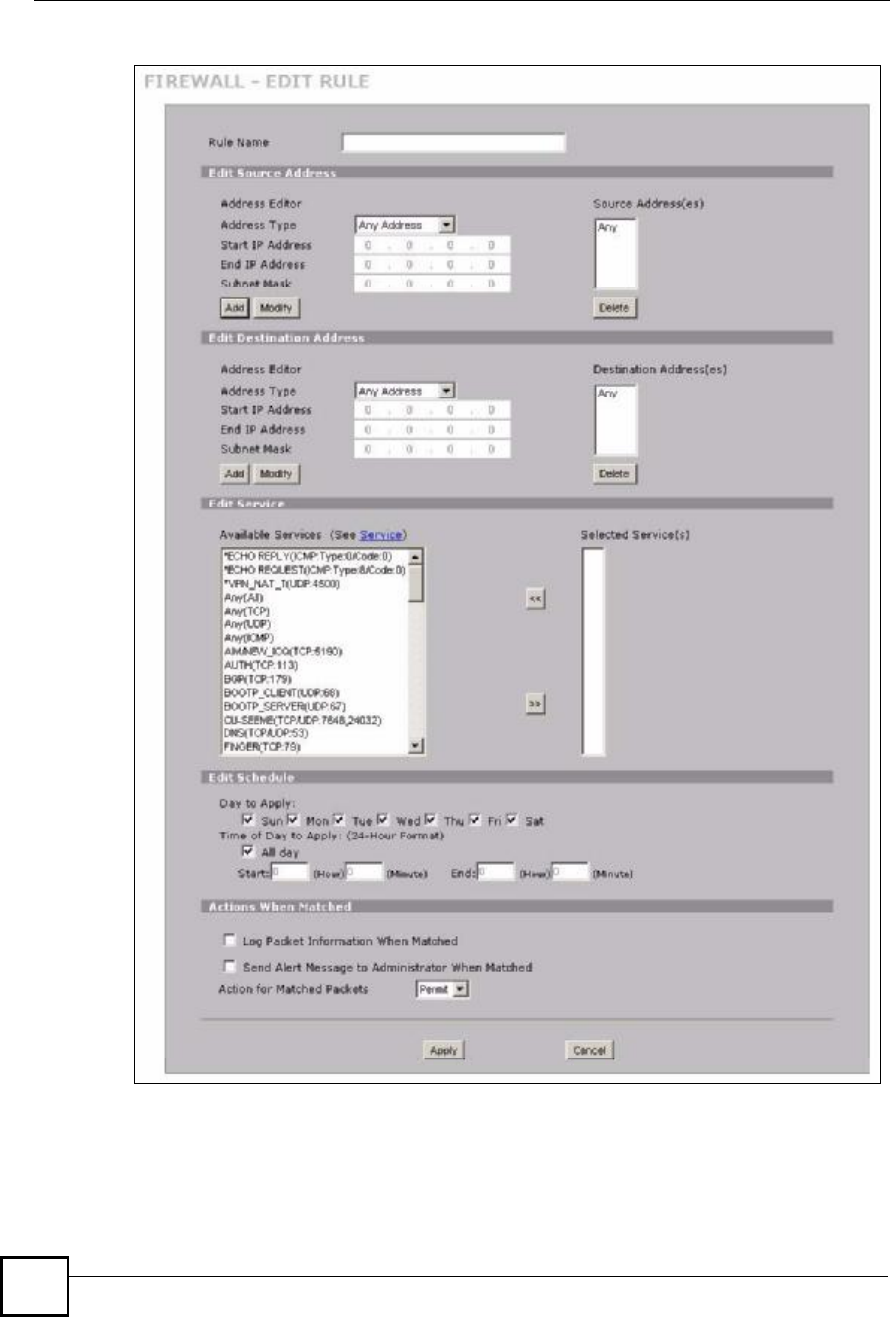
Chapter 9Firewall
NBG410W3G Series User s Guide
178
Figure 104 SECURITY > FIREWALL > Rule Summary > Edit

Chapter 9Firewall
NBG410W3G Series User s Guide 179
The following table describes the labels in this screen.
Table 44 SECURITY > FIREWALL > Rule Summary > Edit
LABEL DESCRIPTION
Rule NameEnter a descriptive name of up to 31 printable ASCII characters (except Extended
ASCII characters) for the firewall rule. Spaces are allowed.
Edit Source/
Destination
Address
Address TypeDo you want your rule to apply to packets with a particular (single) IP, a range of IP
addresses (for example 192.168.1.10 to 192.169.1.50), a subnet or any IP
address? Select an option from the drop-down list box that includes: Single
Address, Range Address, Subnet Address and Any Address.
Start IP AddressEnter the single IP address or the starting IP address in a range here.
End IP AddressEnter the ending IP address in a range here.
Subnet MaskEnter the subnet mask here, if applicable.
AddClick Add to add a new address to the Source or Destination Address(es) box.
You can add multiple addresses, ranges of addresses, and/or subnets.
ModifyTo edit an existing source or destination address, select it from the box and click
Modify.
DeleteHighlight an existing source or destination address from the Source or
Destination Address(es) box above and click Delete to remove it.
Edit Service
Available/
Selected
Services
Highlight a service from the Available Services box on the left, then click >> to
add it to the Selected Service(s) box on the right. To remove a service, highlight it
in the Selected Service(s) box on the right, then click <<.
Next to the name of a service, two fields appear in brackets. The first field indicates
the IP protocol type (TCP, UDP, or ICMP). The second field indicates the IP port
number that defines the service. (Note that there may be more than one IP
protocol type). For example, look at the DNS entry, (UDP/TCP:53) means UDP
port 53 and TCP port 53. Click the Service link to go to the Service screen where
you can configure custom service ports. See Appendix D on page 385 for a list of
commonly used services and port numbers.
You can use the [CTRL] key and select multiple services at once.
Edit Schedule
Day to ApplySelect everyday or the day(s) of the week to apply the rule.
Time of Day to
Apply (24-Hour
Format)
Select All Day or enter the start and end times in the hour-minute format to apply
the rule.
Actions When
Matched
Log Packet
Information When
Matched
This field determines if a log for packets that match the rule is created (Yes) or not
(No). Go to the Log Settings page and select the Access Control logs category
to have the ZyXEL Device record these logs.
Send Alert
Message to
Administrator
When Matched
Select the check box to have the ZyXEL Device generate an alert when the rule is
matched.
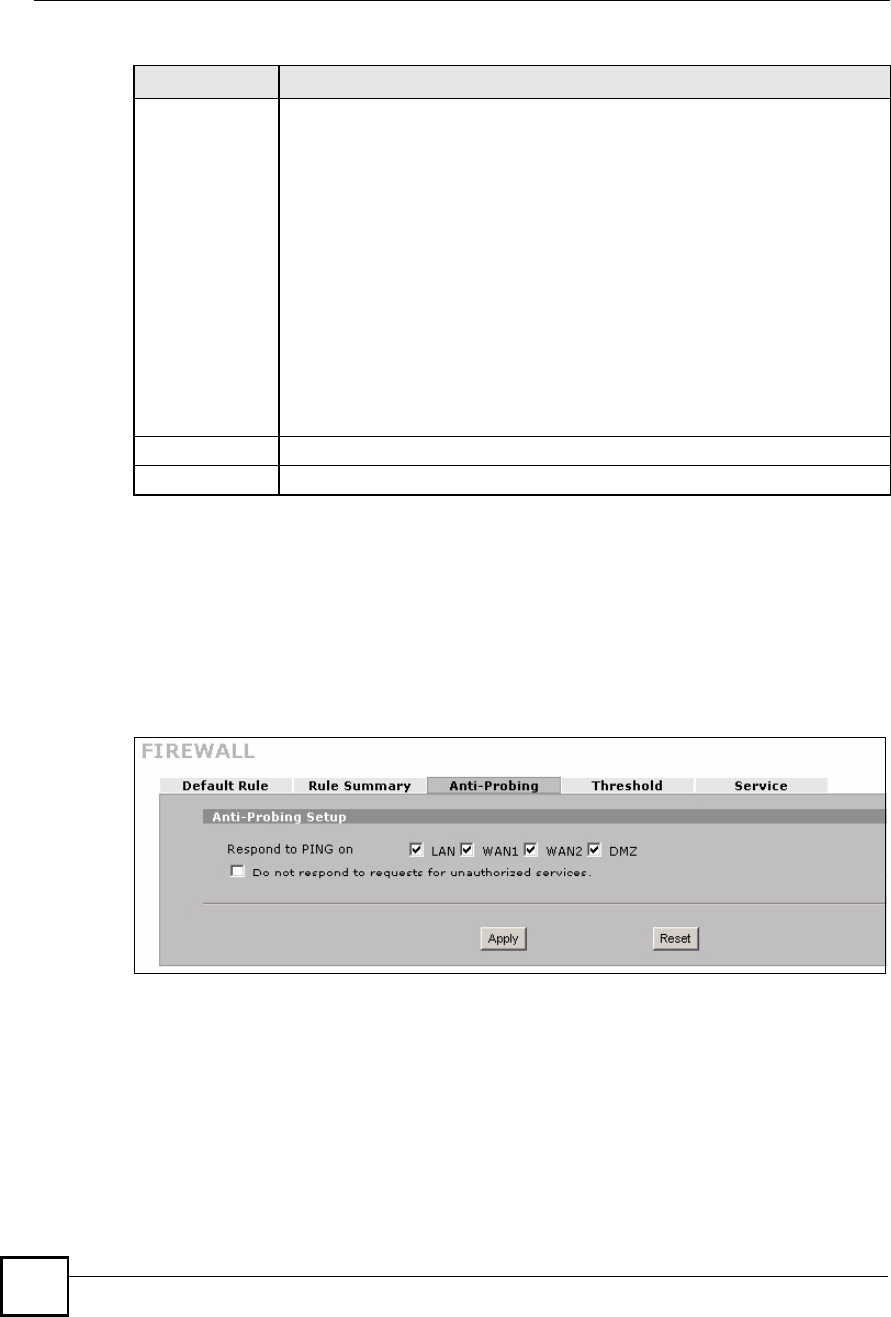
Chapter 9Firewall
NBG410W3G Series User s Guide
180
9.9 Anti-Probing
Click SECURITY > FIREWALL > Anti-Probing to open the following screen. Configure
this screen to help keep the ZyXEL Device hidden from probing attempts. You can specify
which of the ZyXEL Device!s interfaces will respond to Ping requests and whether or not the
ZyXEL Device is to respond to probing for unused ports.
Figure 105 SECURITY > FIREWALL > Anti-Probing
Action for
Matched Packets
Use the drop-down list box to select what the firewall is to do with packets that
match this rule.
Select Drop to silently discard the packets without sending a TCP reset packet or
an ICMP destination-unreachable message to the sender.
Select Reject to deny the packets and send a TCP reset packet (for a TCP packet)
or an ICMP destination-unreachable message (for a UDP packet) to the sender.
Select Permit to allow the passage of the packets.
Note: You also need to configure NAT port forwarding (or full
featured NAT address mapping rules) if you want to allow
computers on the WAN to access devices on the LAN.
Note: You may also need to configure the remote management
settings if you want to allow a WAN computer to manage the
ZyXEL Device or restrict management from the LAN.
ApplyClick Apply to save your customized settings and exit this screen.
CancelClick Cancel to exit this screen without saving.
Table 44 SECURITY > FIREWALL > Rule Summary > Edit
LABEL DESCRIPTION

Chapter 9Firewall
NBG410W3G Series User s Guide 181
The following table describes the labels in this screen.
9.10 Firewall Thresholds
For DoS attacks, the ZyXEL Device uses thresholds to determine when to start dropping
sessions that do not become fully established (half-open sessions). These thresholds apply
globally to all sessions.
For TCP, half-open means that the session has not reached the established state-the TCP three-
way handshake has not yet been completed. Under normal circumstances, the application that
initiates a session sends a SYN (synchronize) packet to the receiving server. The receiver
sends back an ACK (acknowledgment) packet and its own SYN, and then the initiator
responds with an ACK (acknowledgment). After this handshake, a connection is established.
Figure 106 Three-Way Handshake
For UDP, half-open means that the firewall has detected no return traffic. An unusually high
number (or arrival rate) of half-open sessions could indicate a DOS attack.
Table 45 SECURITY > FIREWALL > Anti-Probing
LABEL DESCRIPTION
Respond to PING
on
Select the check boxes of the interfaces that you want to reply to incoming Ping
requests.
Clear an interface s check box to have the ZyXEL Device not respond to any Ping
requests that come into that interface.
Do not respond to
requests for
unauthorized
services.
Select this option to prevent hackers from finding the ZyXEL Device by probing for
unused ports. If you select this option, the ZyXEL Device will not respond to port
request(s) for unused ports, thus leaving the unused ports and the ZyXEL Device
unseen. If this option is not selected, the ZyXEL Device will reply with an ICMP
port unreachable packet for a port probe on its unused UDP ports and a TCP reset
packet for a port probe on its unused TCP ports.
Note that the probing packets must first traverse the ZyXEL Device's firewall rule
checks before reaching this anti-probing mechanism. Therefore if a firewall rule
stops a probing packet, the ZyXEL Device reacts based on the firewall rule to
either send a TCP reset packet for a blocked TCP packet (or an ICMP port-
unreachable packet for a blocked UDP packets) or just drop the packets without
sending a response packet.
ApplyClick Apply to save your changes.
ResetClick Reset to begin configuring this screen afresh.
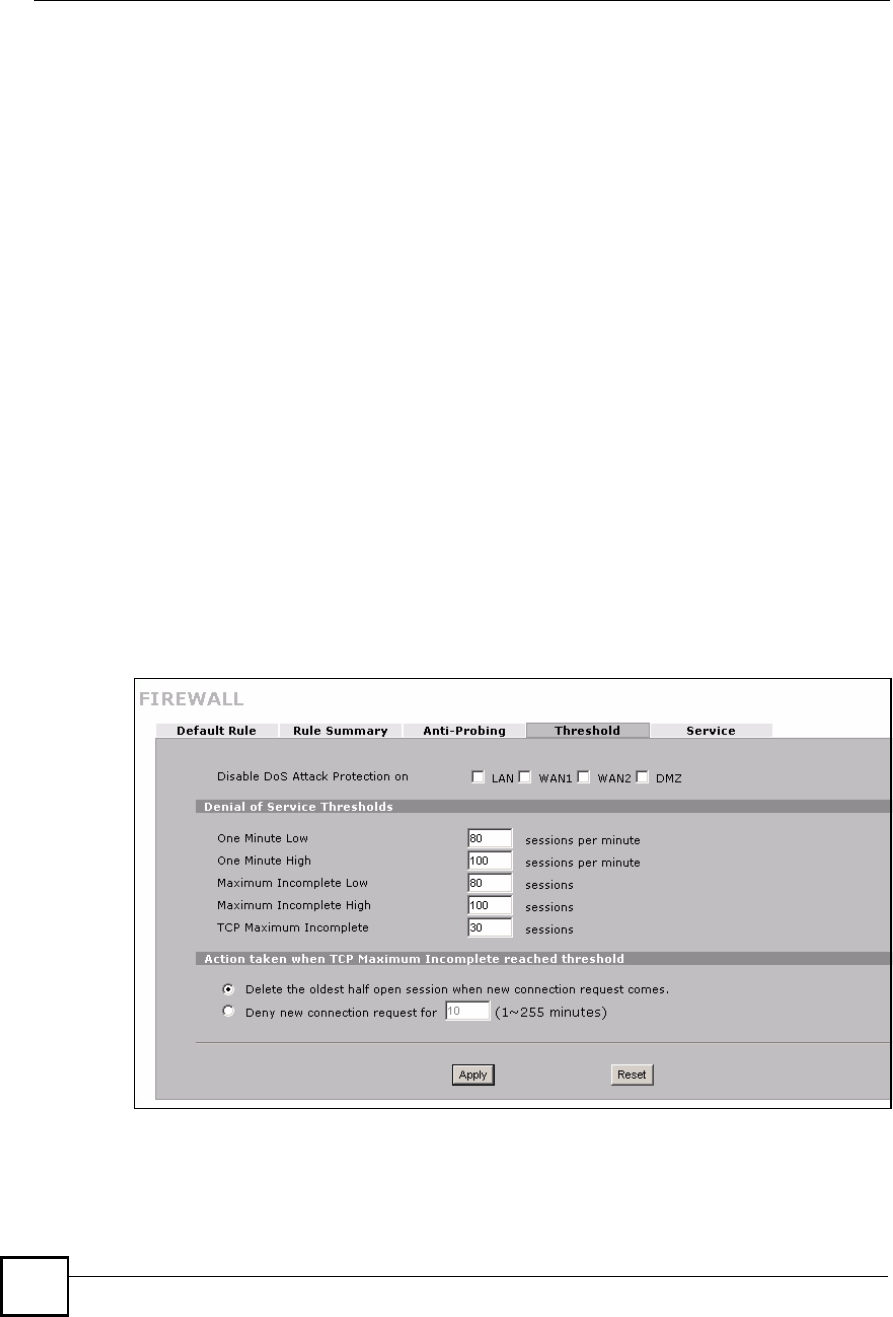
Chapter 9Firewall
NBG410W3G Series User s Guide
182
9.10.1 Threshold Values
If everything is working properly, you probably do not need to change the threshold settings as
the default threshold values should work for most small offices. Tune these parameters when
you believe the ZyXEL Device has been receiving DoS attacks that are not recorded in the
logs or the logs show that the ZyXEL Device is classifying normal traffic as DoS attacks.
Factors influencing choices for threshold values are:
1The maximum number of opened sessions.
2The minimum capacity of server backlog in your LAN network.
3The CPU power of servers in your LAN network.
4Network bandwidth.
5Type of traffic for certain servers.
Reduce the threshold values if your network is slower than average for any of these factors
(especially if you have servers that are slow or handle many tasks and are often busy).
If you often use P2P applications such as file sharing with eMule or eDonkey, it!s
recommended that you increase the threshold values since lots of sessions will be established
during a small period of time and the ZyXEL Device may classify them as DoS attacks.
9.11 Threshold Screen
Click SECURITY > FIREWALL > Threshold to bring up the next screen. The global values
specified for the threshold and timeout apply to all TCP connections.
Figure 107 SECURITY > FIREWALL > Threshold

Chapter 9Firewall
NBG410W3G Series User s Guide 183
The following table describes the labels in this screen.
Table 46 SECURITY > FIREWALL > Threshold
LABEL DESCRIPTION
Disable DoS Attack
Protection on
Select the check boxes of any interfaces for which you want the ZyXEL Device to
not use the Denial of Service protection thresholds. This disables DoS protection
on the selected interface.
You may want to disable DoS protection for an interface if the ZyXEL Device is
treating valid traffic as DoS attacks. Another option would be to raise the
thresholds.
Denial of Service
Thresholds
The ZyXEL Device measures both the total number of existing half-open
sessions and the rate of session establishment attempts. Both TCP and UDP
half-open sessions are counted in the total number and rate measurements.
Measurements are made once a minute.
One Minute Low This is the rate of new half-open sessions per minute that causes the firewall to
stop deleting half-open sessions. The ZyXEL Device continues to delete half-
open sessions as necessary, until the rate of new connection attempts drops
below this number.
One Minute High This is the rate of new half-open sessions per minute that causes the firewall to
start deleting half-open sessions. When the rate of new connection attempts rises
above this number, the ZyXEL Device deletes half-open sessions as required to
accommodate new connection attempts.
For example, if you set the one minute high to 100, the ZyXEL Device starts
deleting half-open sessions when more than 100 session establishment attempts
have been detected in the last minute. It stops deleting half-open sessions when
the number of session establishment attempts detected in a minute goes below
the number set as the one minute low.
Maximum
Incomplete Low
This is the number of existing half-open sessions that causes the firewall to stop
deleting half-open sessions. The ZyXEL Device continues to delete half-open
requests as necessary, until the number of existing half-open sessions drops
below this number.
Maximum
Incomplete High
This is the number of existing half-open sessions that causes the firewall to start
deleting half-open sessions. When the number of existing half-open sessions
rises above this number, the ZyXEL Device deletes half-open sessions as
required to accommodate new connection requests. Do not set Maximum
Incomplete High to lower than the current Maximum Incomplete Low number.
For example, if you set the maximum incomplete high to 100, the ZyXEL Device
starts deleting half-open sessions when the number of existing half-open
sessions rises above 100. It stops deleting half-open sessions when the number
of existing half-open sessions drops below the number set as the maximum
incomplete low.
TCP Maximum
Incomplete
An unusually high number of half-open sessions with the same destination host
address could indicate that a DoS attack is being launched against the host.
Specify the number of existing half-open TCP sessions with the same destination
host IP address that causes the firewall to start dropping half-open sessions to
that same destination host IP address. Enter a number between 1 and 256. As a
general rule, you should choose a smaller number for a smaller network, a slower
system or limited bandwidth. The ZyXEL Device sends alerts whenever the TCP
Maximum Incomplete is exceeded.
Action taken when
TCP Maximum
Incomplete
reached threshold
Select the action that ZyXEL Device should take when the TCP maximum
incomplete threshold is reached. You can have the ZyXEL Device either:
Delete the oldest half open session when a new connection request comes.
or
Deny new connection requests for the number of minutes that you specify
(between 1 and 256).
ApplyClick Apply to save your changes.
Reset Click Reset to begin configuring this screen afresh.
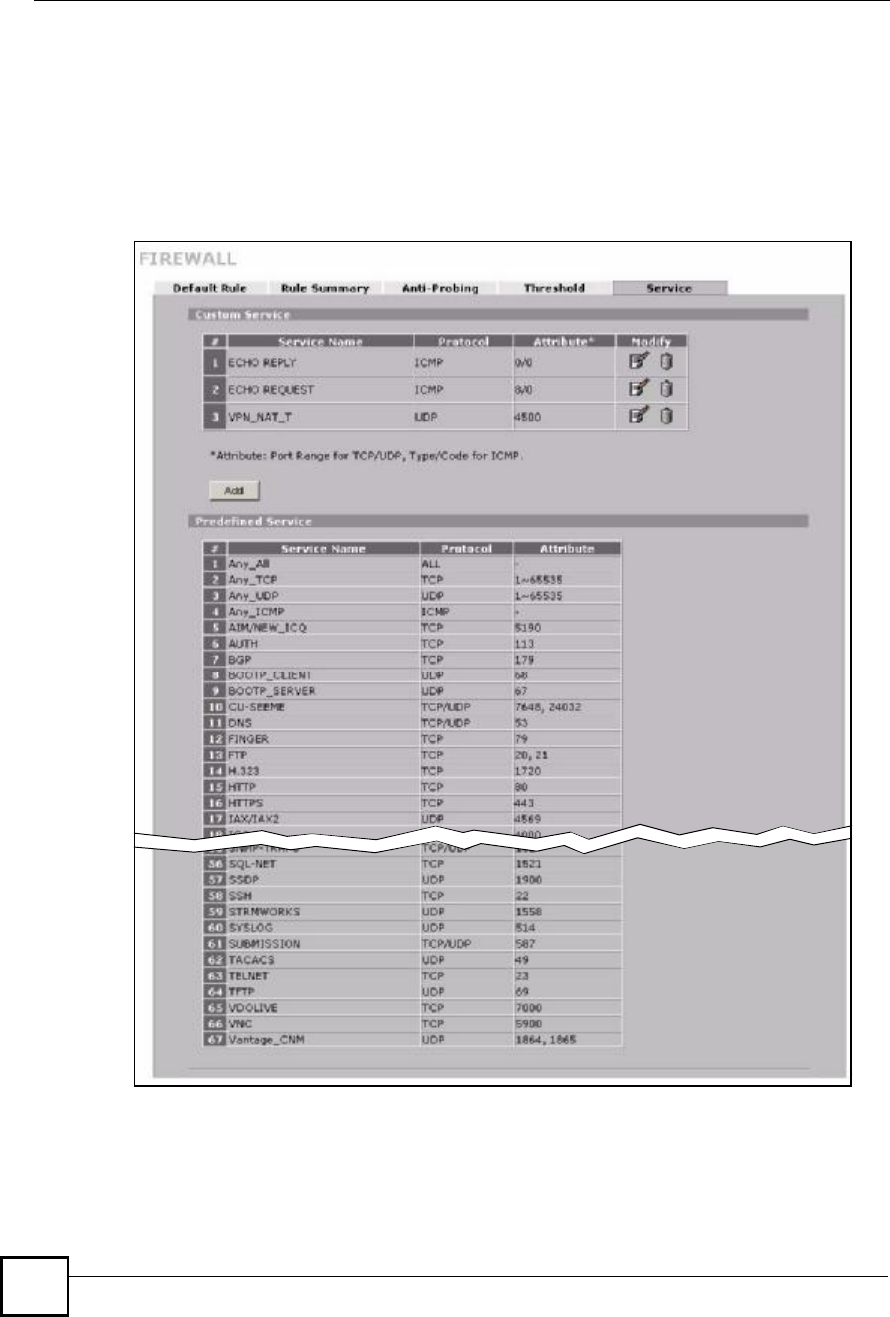
Chapter 9Firewall
NBG410W3G Series User s Guide
184
9.12 Service
Click SECURITY > FIREWALL > Service to open the screen as shown next. Use this
screen to configure custom services for use in firewall rules or view the services that are
predefined in the ZyXEL Device.
See Section 9.1 on page 167 for more information about the firewall.
Figure 108 SECURITY > FIREWALL > Service
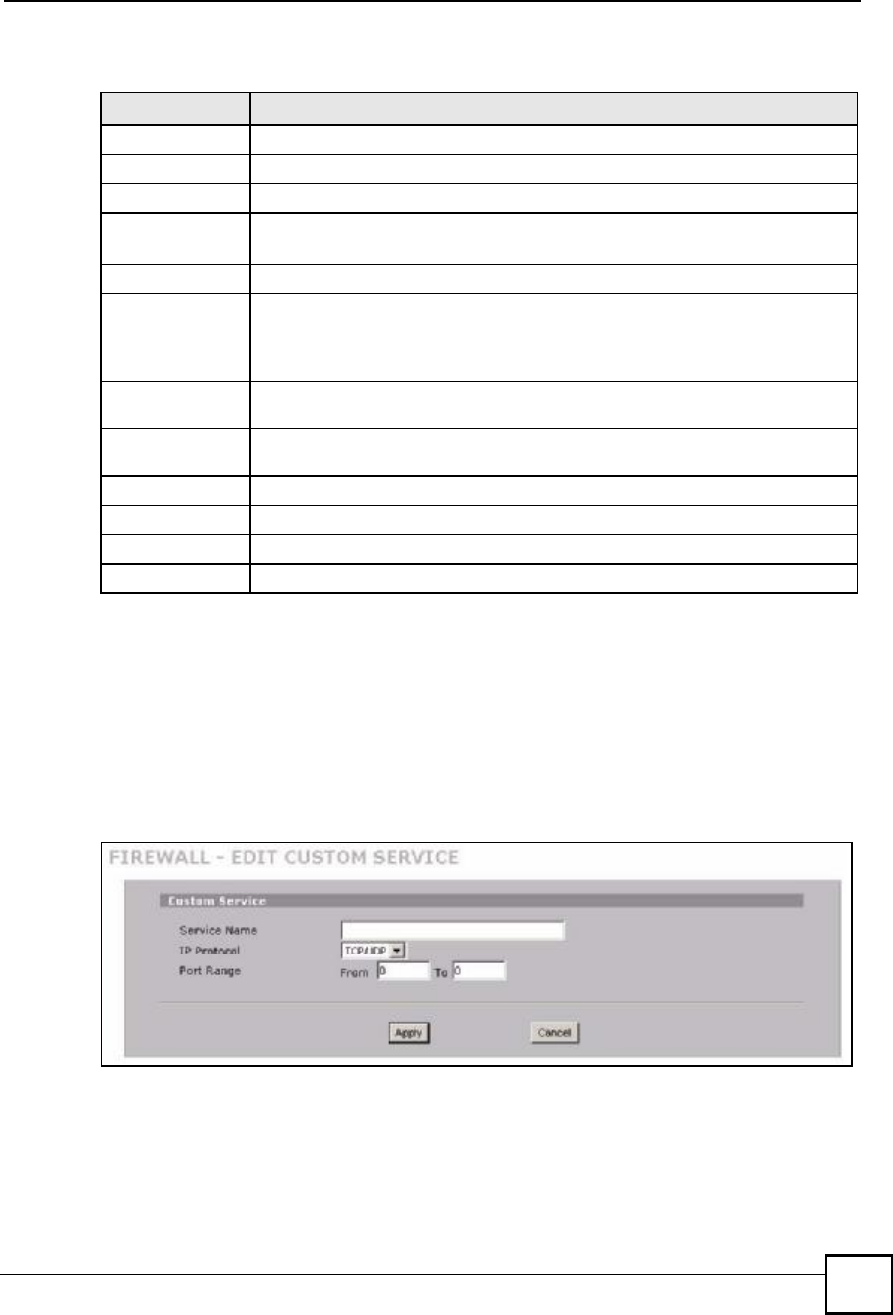
Chapter 9Firewall
NBG410W3G Series User s Guide 185
The following table describes the labels in this screen.
9.12.1 Firewall Edit Custom Service
Click SECURITY > FIREWALL > Service > Add to display the following screen. Use this
screen to configure a custom service entry not is not predefined in the ZyXEL Device. See
Appendix D on page 385 the user!s guide appendices for a list of commonly used services and
port numbers.
See Section 9.1 on page 167 for more information about the firewall.
Figure 109 Firewall Edit Custom Service
Table 47 SECURITY > FIREWALL > Service
LABEL DESCRIPTION
Custom ServiceThis table shows all configured custom services.
#This is the index number of the custom service.
Service NameThis is the name of the service.
ProtocolThis is the IP protocol type.
If you selected Custom, this is the IP protocol value you entered.
AttributeThis is the IP port number or ICMP type and code that defines the service.
ModifyClick the edit icon to go to the screen where you can edit the service.
Click the delete icon to remove an existing service. A window displays asking you
to confirm that you want to delete the service. Note that subsequent services
move up by one when you take this action.
AddClick this button to bring up the screen that you use to configure a new custom
service that is not in the predefined list of services.
Predefined
Service
This table shows all the services that are already configured for use in firewall
rules. See Appendix D on page 385 for a list of common services.
#This is the index number of the predefined service.
Service NameThis is the name of the service.
ProtocolThis is the IP protocol type. There may be more than one IP protocol type.
AttributeThis is the IP port number or ICMP type and code that defines the service.
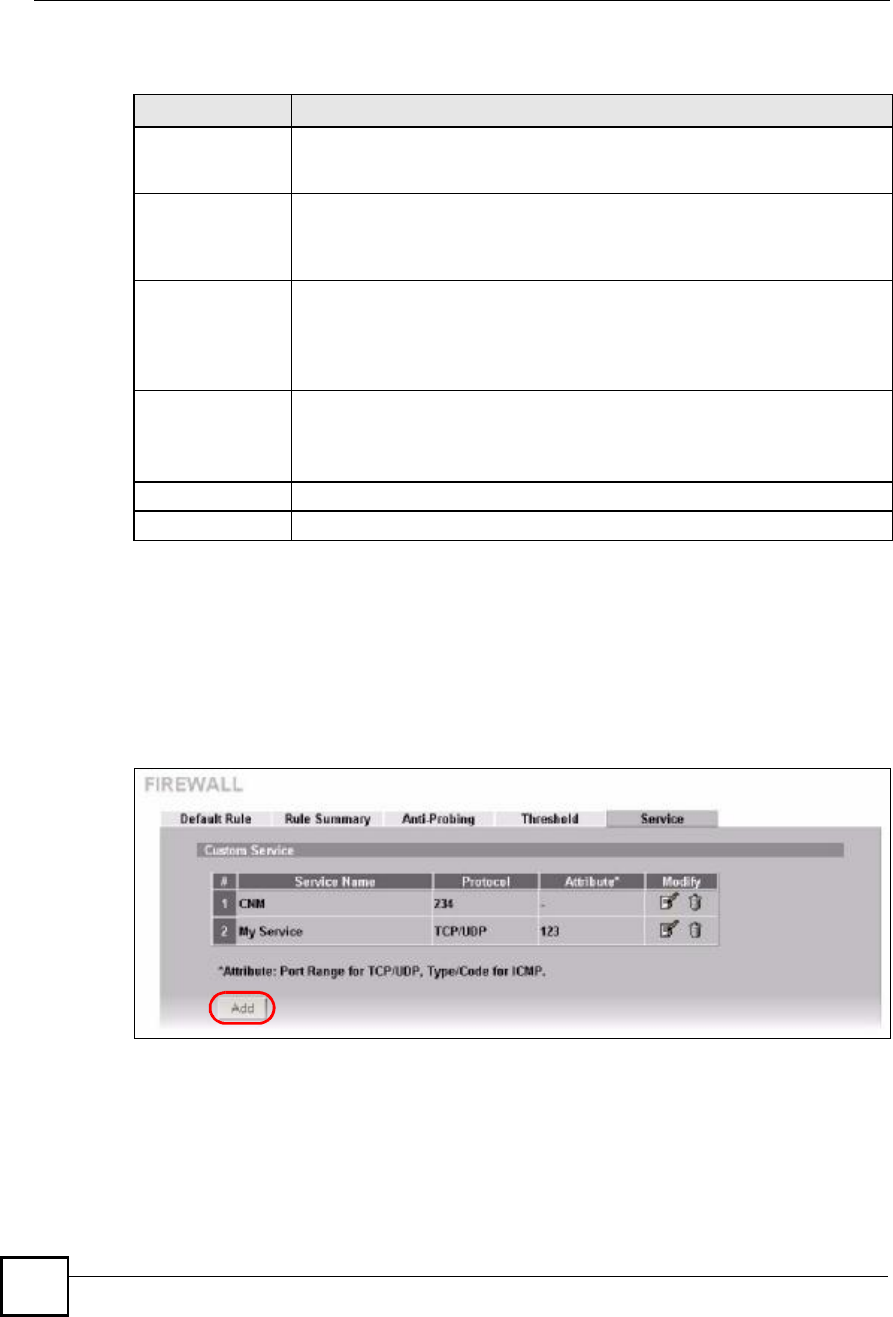
Chapter 9Firewall
NBG410W3G Series User s Guide
186
The following table describes the labels in this screen.
9.13 My Service Firewall Rule Example
The following Internet firewall rule example allows a hypothetical My Service connection
from the Internet.
1In the Service screen, click Add to open the Edit Custom Service screen.
Figure 110 My Service Firewall Rule Example: Service
2Configure it as follows and click Apply.
Table 48 SECURITY > FIREWALL > Service > Add
LABEL DESCRIPTION
Service NameEnter a descriptive name of up to 31 printable ASCII characters (except
Extended ASCII characters) for the custom service. You cannot use the
"("character. Spaces are allowed.
IP ProtocolChoose the IP protocol (TCP, UDP, TCP/UDP, ICMP or Custom) that defines
your customized service from the drop down list box.
If you select Custom, specify the protocol s number. For example, ICMP is 1,
TCP is 6, UDP is 17 and so on.
Port RangeEnter the port number (from 1 to 255) that defines the customized service
To specify one port only, enter the port number in the From field and enter it
again in the To field.
To specify a span of ports, enter the first port in the From field and enter the last
port in the To field.
Type/CodeThis field is available only when you select ICMP in the IP Protocol field.
The ICMP messages are identified by their types and in some cases codes.
Enter the type number in the Type field and select the Code radio button and
enter the code number if any.
ApplyClick Apply to save your customized settings and exit this screen.
CancelClick Cancel to exit this screen without saving.
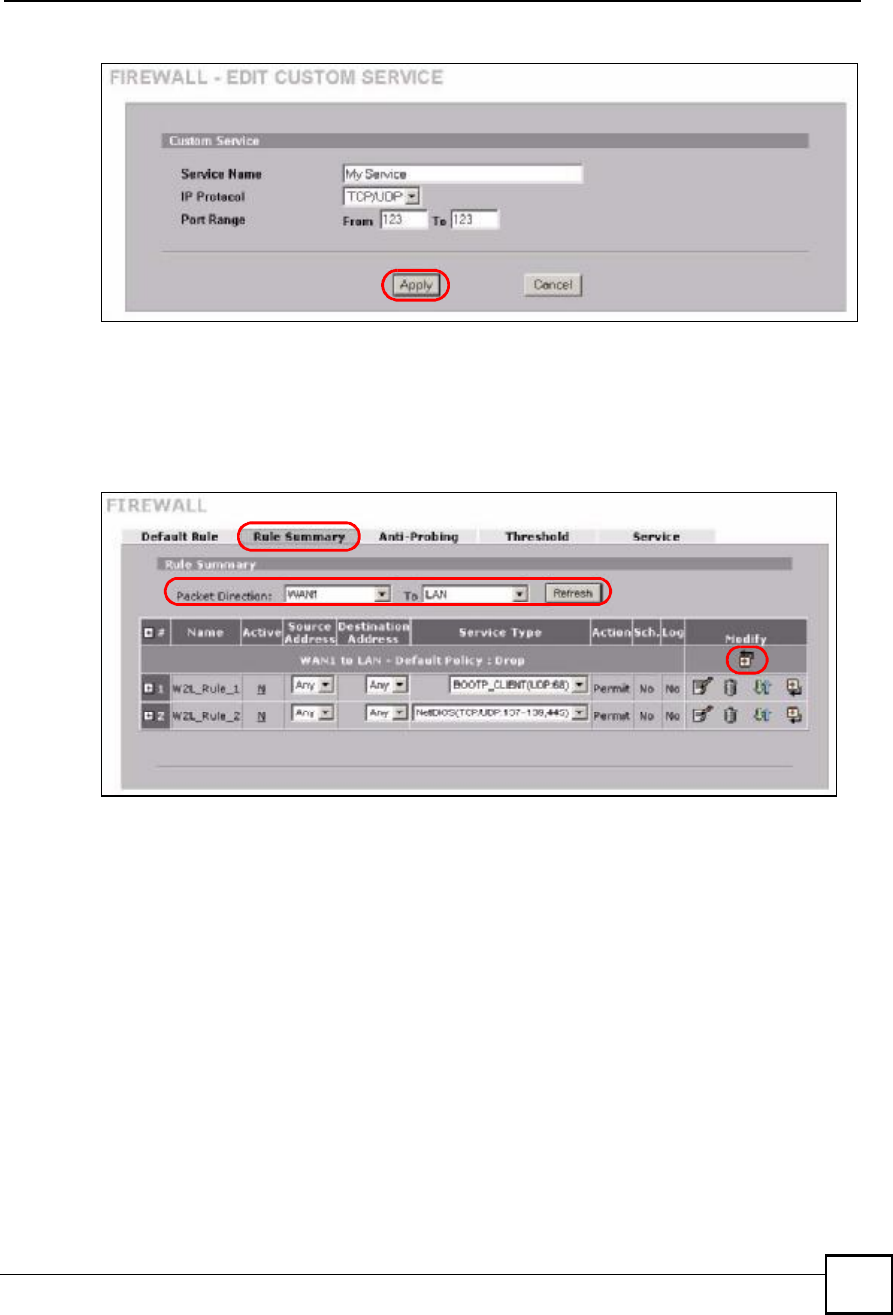
Chapter 9Firewall
NBG410W3G Series User s Guide 187
Figure 111 My Service Firewall Rule Example: Edit Custom Service
3Click Rule Summary. Select WAN1 and LAN from the Packet Direction drop-down
list boxes and click Refresh to display existing firewall rules for the selected direction of
travel of packets.
4Click the insert icon at the top of the row to create the new firewall rule before the
others.
Figure 112 My Service Firewall Rule Example: Rule Summary
5The Edit Rule screen displays. Enter the name of the firewall rule.
6Select Any in the Destination Address(es) box and then click Delete.
7Configure the destination address fields as follows and click Add.
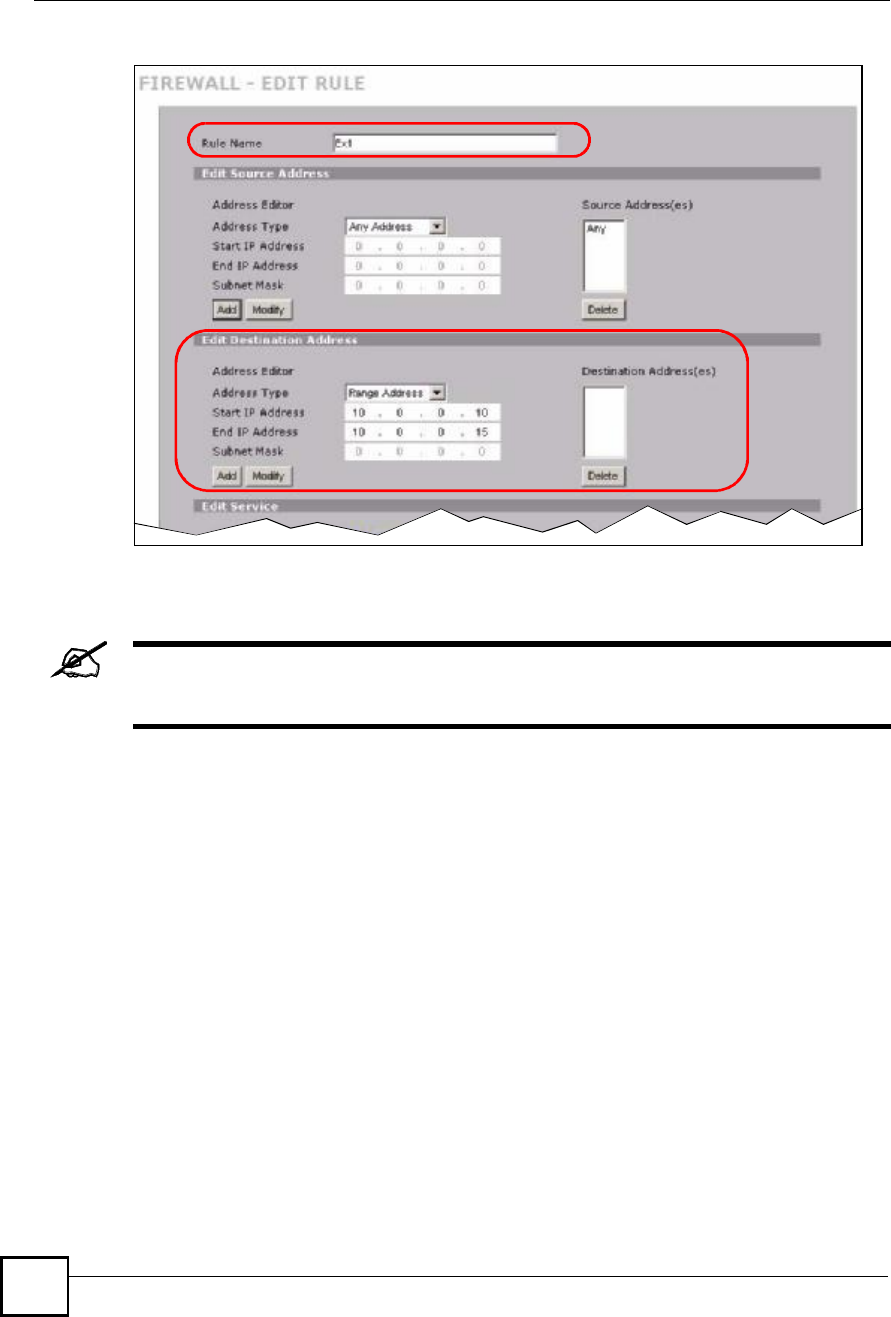
Chapter 9Firewall
NBG410W3G Series User s Guide
188
Figure 113 My Service Firewall Rule Example: Rule Edit: Source and Destination Addresses
8In the Edit Service section, use the arrows between Available Services and Selected
Service(s) to configure it as follows. Click Apply when you are done.
Custom services show up with an * before their names in the Services list
boxes and the Rule Summary screen s Service Type list box.
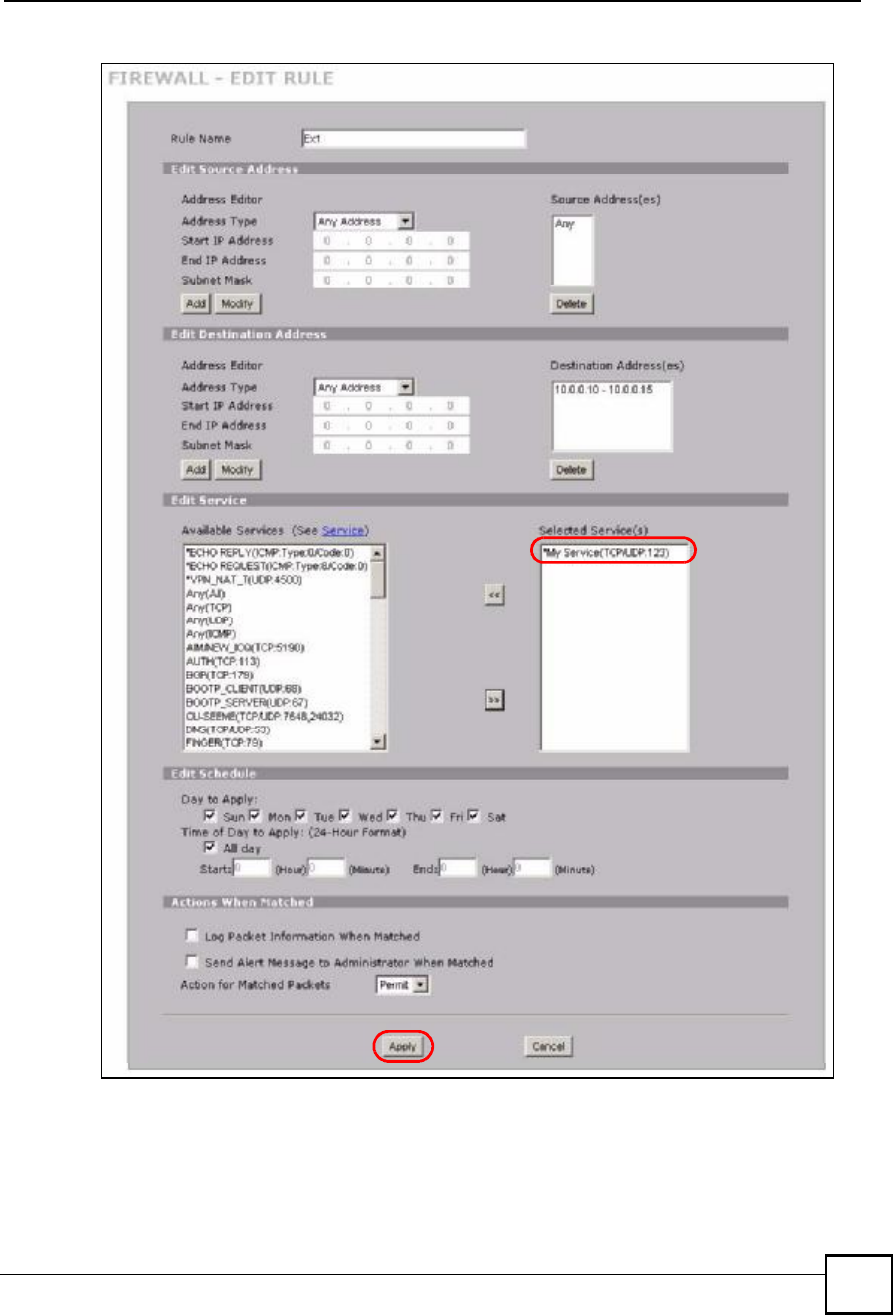
Chapter 9Firewall
NBG410W3G Series User s Guide 189
Figure 114 My Service Firewall Rule Example: Edit Rule: Service Configuration
Rule 1 allows a My Service connection from WAN 1 to IP addresses 10.0.0.10 through
10.0.0.15 on the LAN.
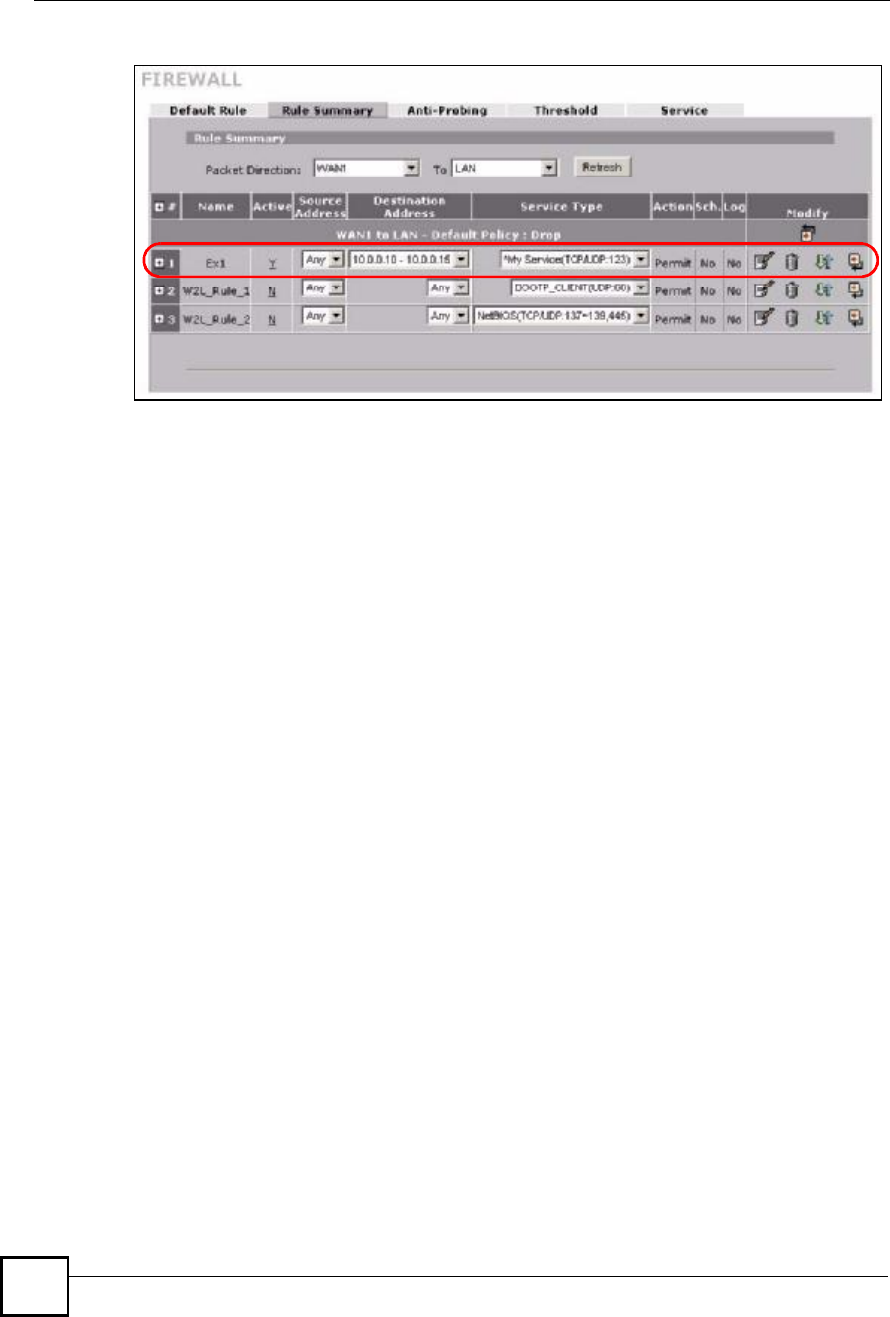
Chapter 9Firewall
NBG410W3G Series User s Guide
190
Figure 115 My Service Firewall Rule Example: Rule Summary: Completed

NBG410W3G Series User s Guide 191
CHAPTER 10
Authentication Server
This chapter discusses how to configure the ZyXEL Device!s authentication server feature.
10.1 Authentication Server Overview
A ZyXEL Device can use either the local user database internal to the ZyXEL Device or an
external RADIUS server to authenticate wireless clients. See Appendix E on page 389 for
more information about RADIUS.
10.2 Local User Database
Click SECURITY > AUTH SERVER to open the Local User Database screen. The local
user database is a list of user profiles stored on the ZyXEL Device. The ZyXEL Device can
use this list of user profiles to authenticate users. Use this screen to change your ZyXEL
Device!s list of user profiles.
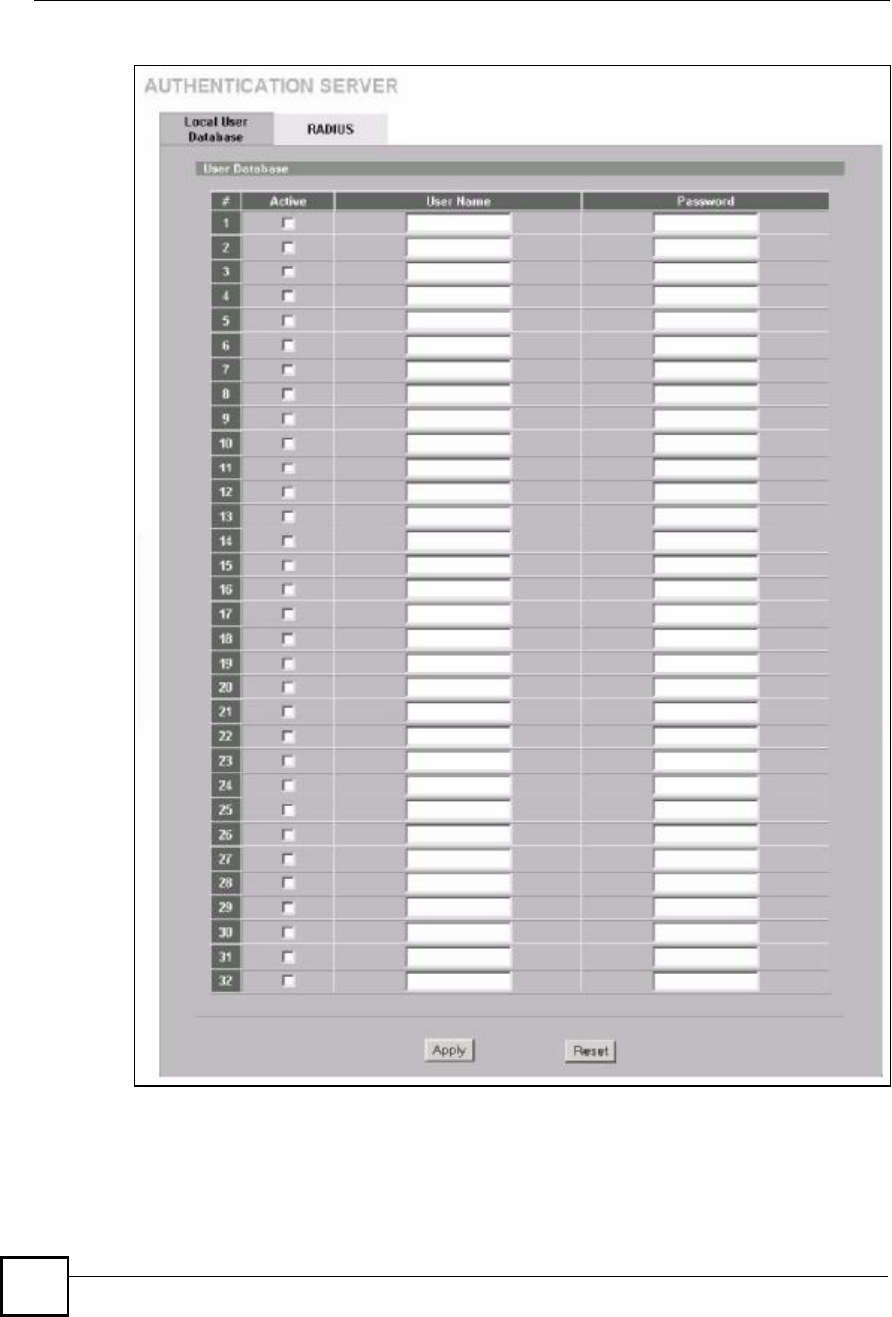
Chapter 10Authentication Server
NBG410W3G Series User s Guide
192
Figure 116 SECURITY > AUTH SERVER > Local User Database
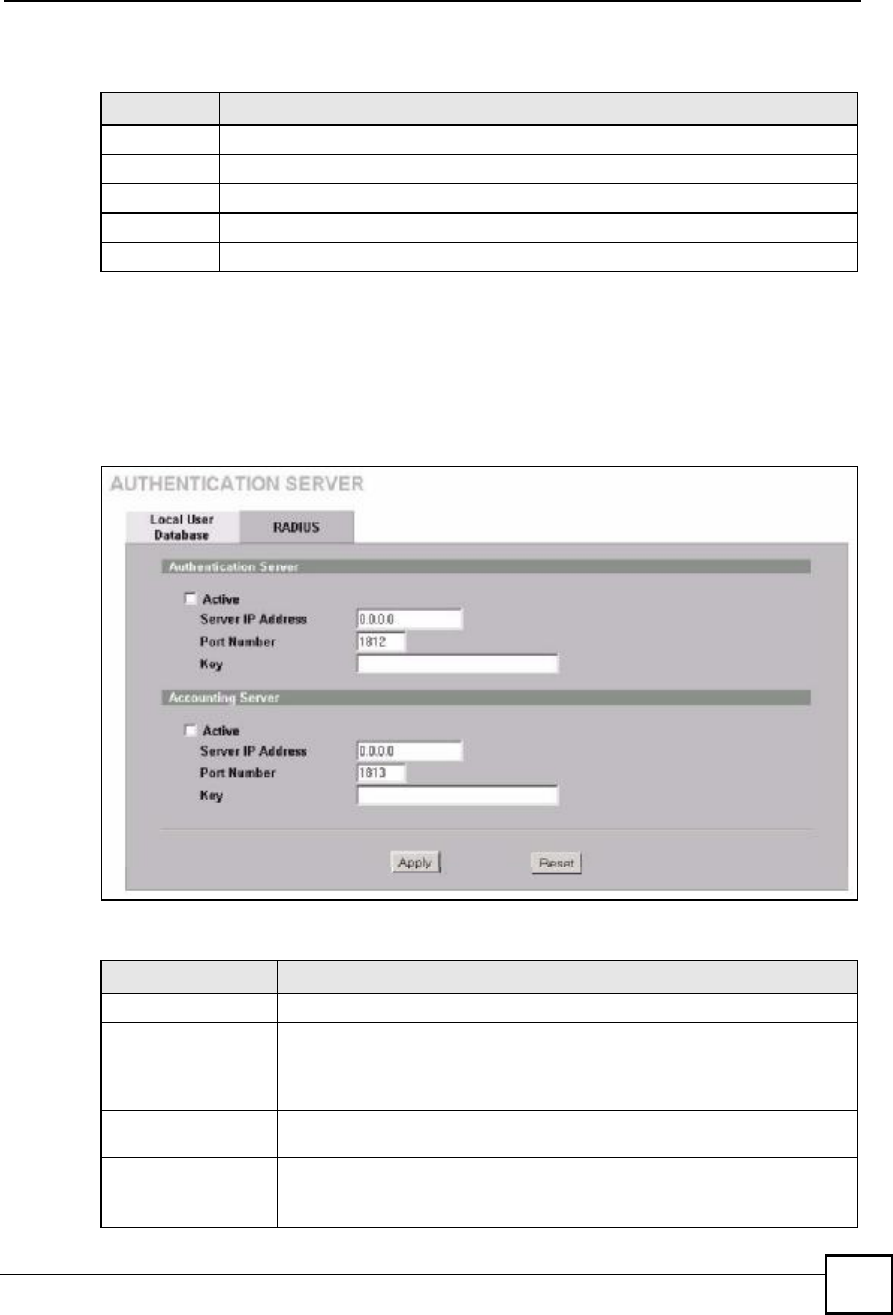
Chapter 10Authentication Server
NBG410W3G Series User s Guide 193
The following table describes the labels in this screen.
10.3 RADIUS
Click SECURITY > AUTH SERVER > RADIUS to open the RADIUS screen. Configure
this screen to use an external RADIUS server to authenticate users.
Figure 117 SECURITY > AUTH SERVER > RADIUS
The following table describes the labels in this screen.
Table 49 SECURITY > AUTH SERVER > Local User Database
LABEL DESCRIPTION
Active Select this check box to enable the user profile.
User NameEnter the user name of the user profile.
PasswordEnter a password up to 31 characters long for this user profile.
ApplyClick Apply to save your changes.
ResetClick Reset to begin configuring this screen afresh.
Table 50 SECURITY > AUTH SERVER > RADIUS
LABEL DESCRIPTION
Authentication Server
ActiveSelect the check box to enable user authentication through an external
authentication server.
Clear the check box to enable user authentication using the local user profile
on the ZyXEL Device.
Server IP AddressEnter the IP address of the external authentication server in dotted decimal
notation.
Port NumberThe default port of the RADIUS server for authentication is 1812.
You need not change this value unless your network administrator instructs
you to do so with additional information.

Chapter 10Authentication Server
NBG410W3G Series User s Guide
194
KeyEnter a password (up to 31 alphanumeric characters) as the key to be shared
between the external authentication server and the ZyXEL Device.
The key is not sent over the network. This key must be the same on the
external authentication server and ZyXEL Device.
Accounting Server
ActiveSelect the check box to enable user accounting through an external
authentication server.
Server IP AddressEnter the IP address of the external accounting server in dotted decimal
notation.
Port NumberThe default port of the RADIUS server for accounting is 1813.
You need not change this value unless your network administrator instructs
you to do so with additional information.
KeyEnter a password (up to 31 alphanumeric characters) as the key to be shared
between the external accounting server and the ZyXEL Device.
The key is not sent over the network. This key must be the same on the
external accounting server and ZyXEL Device.
ApplyClick Apply to save your changes.
ResetClick Reset to begin configuring this screen afresh.
Table 50 SECURITY > AUTH SERVER > RADIUS
LABEL DESCRIPTION

NBG410W3G Series User s Guide 195
CHAPTER 11
Certificates
This chapter gives background information about public-key certificates and explains how to
use them.
11.1 Certificates Overview
The ZyXEL Device can use certificates (also called digital IDs) to authenticate users.
Certificates are based on public-private key pairs. A certificate contains the certificate owner!s
identity and public key. Certificates provide a way to exchange public keys for use in
authentication.
A Certification Authority (CA) issues certificates and guarantees the identity of each
certificate owner. There are commercial certification authorities like CyberTrust or VeriSign
and government certification authorities. You can use the ZyXEL Device to generate
certification requests that contain identifying information and public keys and then send the
certification requests to a certification authority.
When using public-key cryptology for authentication, each host has two keys. One key is
public and can be made openly available; the other key is private and must be kept secure.
Public-key encryption in general works as follows.
1Tim wants to send a private message to Jenny. Tim generates a public-private key pair.
What is encrypted with one key can only be decrypted using the other.
2Tim keeps the private key and makes the public key openly available.
3Tim uses his private key to encrypt the message and sends it to Jenny.
4Jenny receives the message and uses Tim!s public key to decrypt it.
5Additionally, Jenny uses her own private key to encrypt a message and Tim uses Jenny!s
public key to decrypt the message.
The ZyXEL Device uses certificates based on public-key cryptology to authenticate users
attempting to establish a connection. The method used to secure the data that you send through
an established connection depends on the type of connection.
The certification authority uses its private key to sign certificates. Anyone can then use the
certification authority!s public key to verify the certificates.
A certification path is the hierarchy of certification authority certificates that validate a
certificate. The ZyXEL Device does not trust a certificate if any certificate on its path has
expired or been revoked.
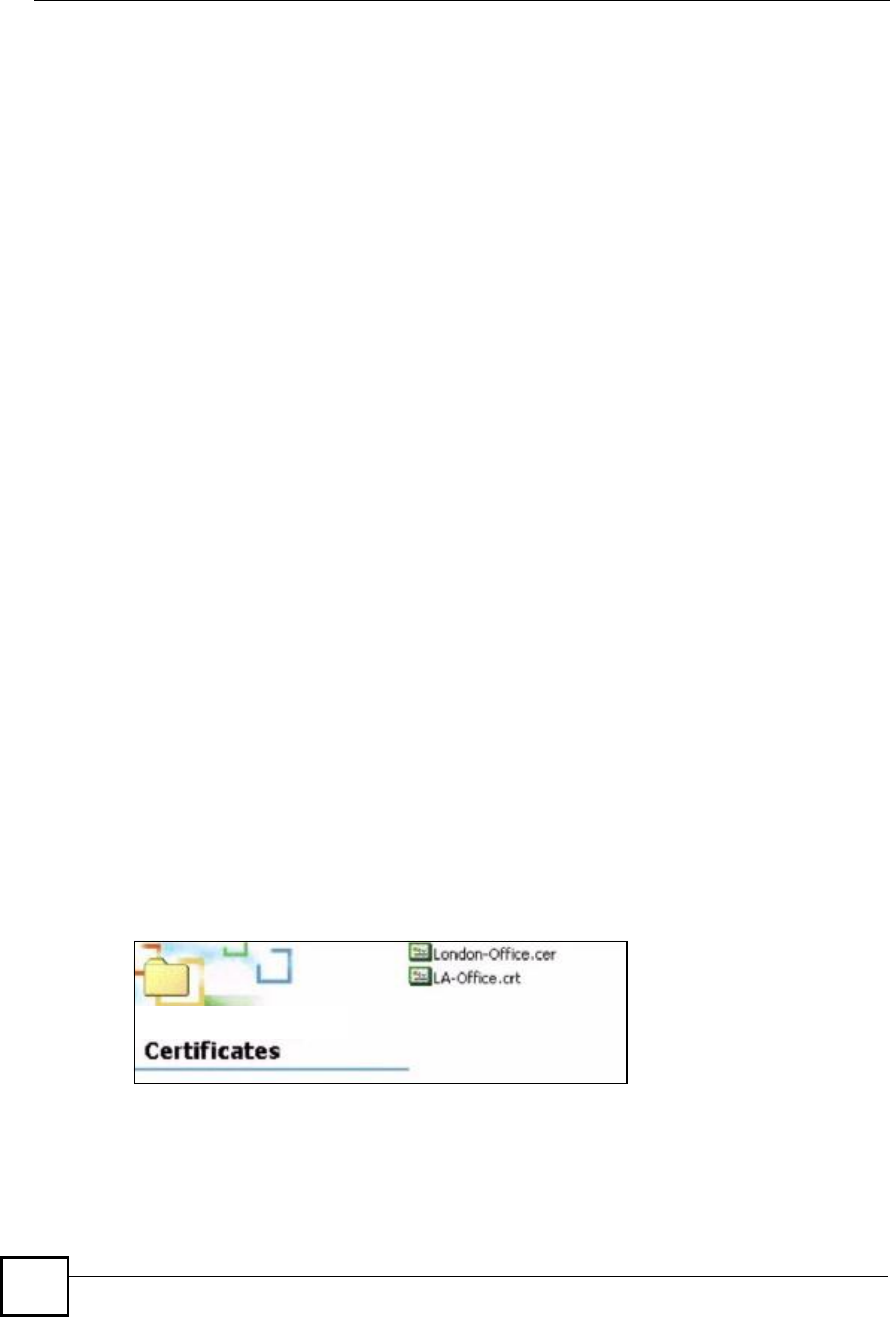
Chapter 11Certificates
NBG410W3G Series User s Guide
196
Certification authorities maintain directory servers with databases of valid and revoked
certificates. A directory of certificates that have been revoked before the scheduled expiration
is called a CRL (Certificate Revocation List). The ZyXEL Device can check a peer!s
certificate against a directory server!s list of revoked certificates. The framework of servers,
software, procedures and policies that handles keys is called PKI (public-key infrastructure).
11.1.1 Advantages of Certificates
Certificates offer the following benefits.
The ZyXEL Device only has to store the certificates of the certification authorities that
you decide to trust, no matter how many devices you need to authenticate.
Key distribution is simple and very secure since you can freely distribute public keys and
you never need to transmit private keys.
11.2 Self-signed Certificates
You can have the ZyXEL Device act as a certification authority and sign its own certificates.
11.3 Verifying a Certificate
Before you import a trusted CA or trusted remote host certificate into the ZyXEL Device, you
should verify that you have the actual certificate. This is especially true of trusted CA
certificates since the ZyXEL Device also trusts any valid certificate signed by any of the
imported trusted CA certificates.
11.3.1 Checking the Fingerprint of a Certificate on Your Computer
A certificate!s fingerprints are message digests calculated using the MD5 or SHA1 algorithms.
The following procedure describes how to check a certificate!s fingerprint to verify that you
have the actual certificate.
1Browse to where you have the certificate saved on your computer.
2Make sure that the certificate has a ".cer# or ".crt# file name extension.
Figure 118 Certificates on Your Computer
3Double-click the certificate!s icon to open the Certificate window. Click the Details tab
and scroll down to the Thumbprint Algorithm and Thumbprint fields.
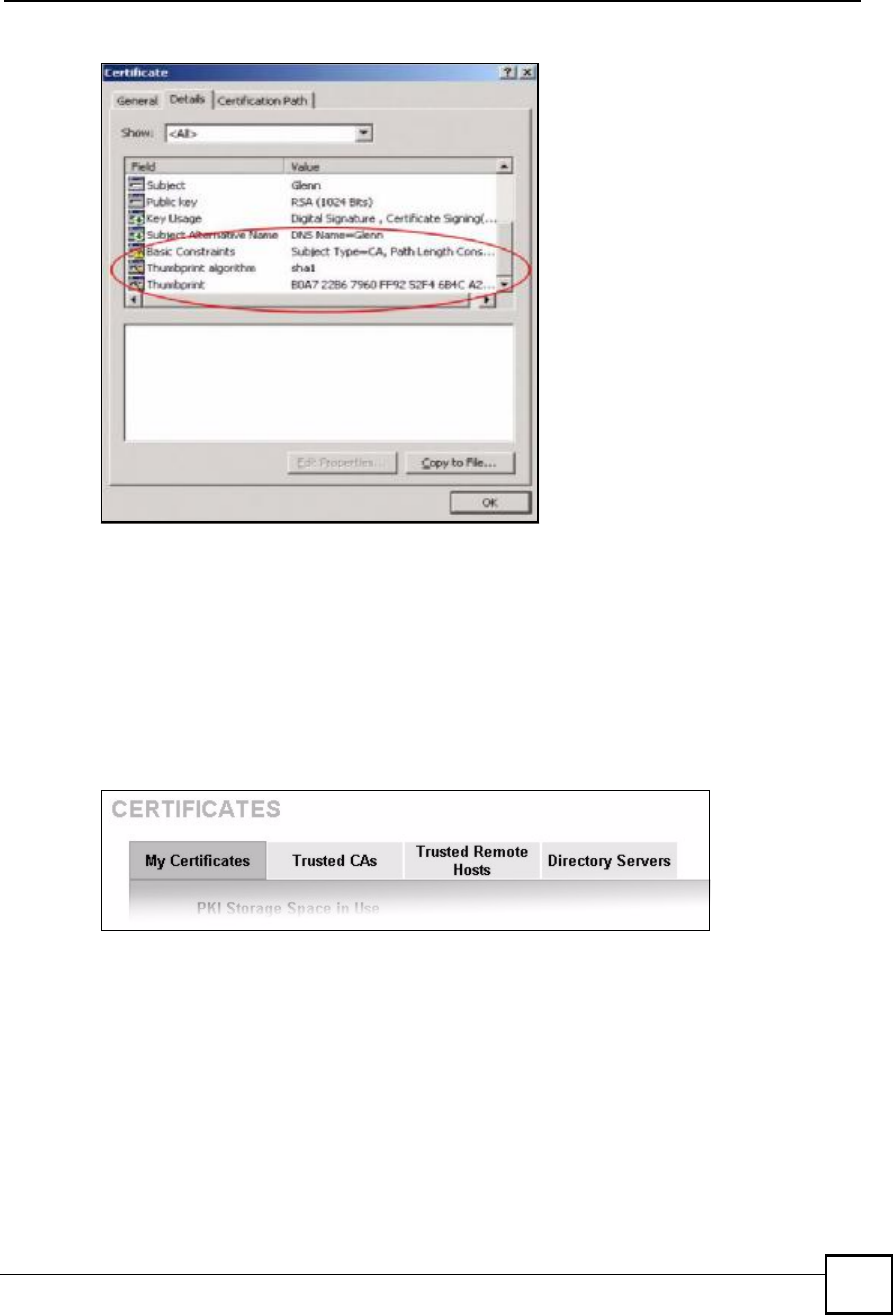
Chapter 11Certificates
NBG410W3G Series User s Guide 197
Figure 119 Certificate Details
4Use a secure method to verify that the certificate owner has the same information in the
Thumbprint Algorithm and Thumbprint fields. The secure method may very based
on your situation. Possible examples would be over the telephone or through an HTTPS
connection.
11.4 Configuration Summary
This section summarizes how to manage certificates on the ZyXEL Device.
Figure 120 Certificate Configuration Overview
Use the My Certificate screens to generate and export self-signed certificates or certification
requests and import the ZyXEL Device!s CA-signed certificates.
Use the Trusted CA screens to save the certificates of trusted CAs to the ZyXEL Device. You
can also export the certificates to a computer.
Use the Trusted Remote Hosts screens to import self-signed certificates from trusted remote
hosts.
Use the Directory Servers screen to configure a list of addresses of directory servers (that
contain lists of valid and revoked certificates).
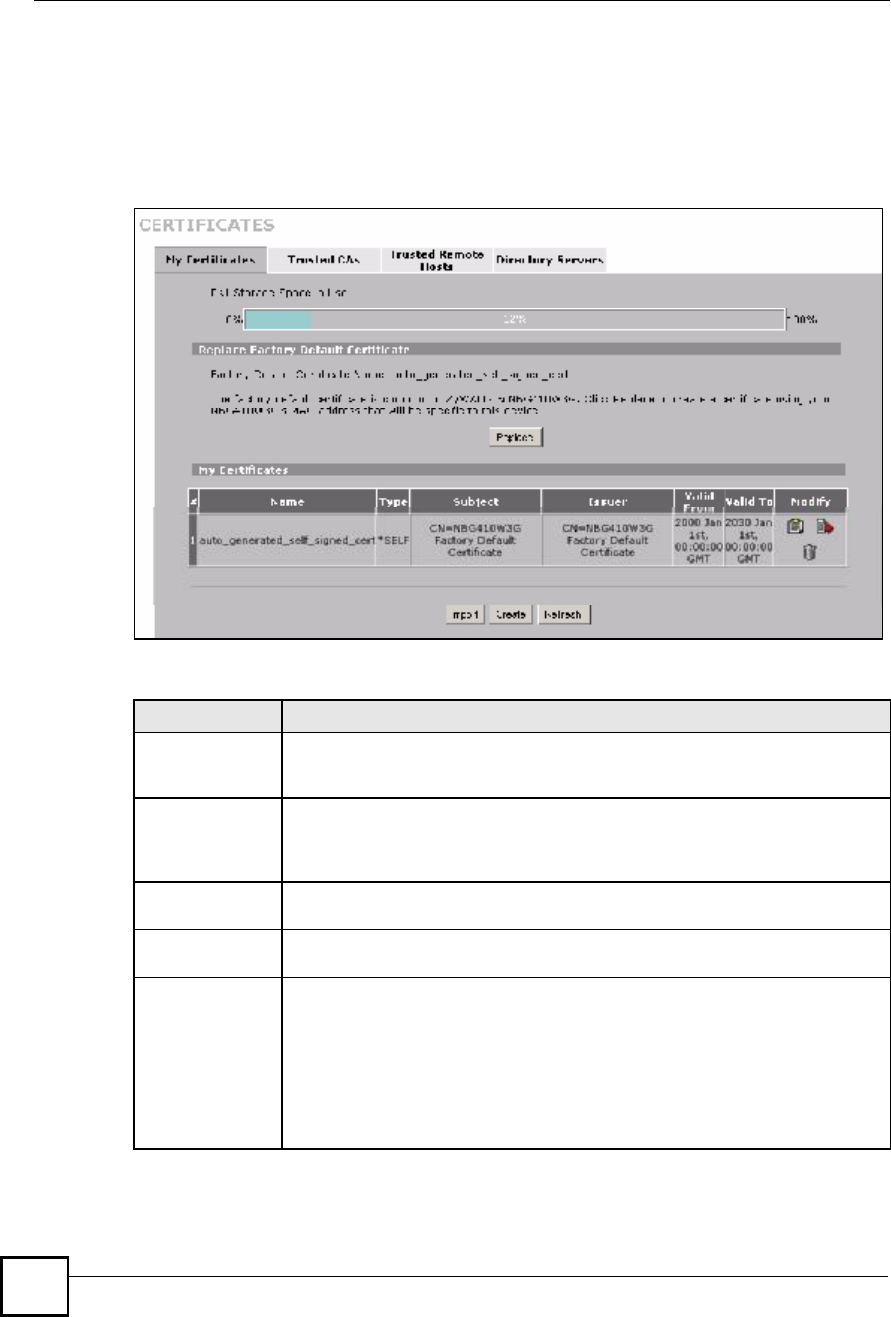
Chapter 11Certificates
NBG410W3G Series User s Guide
198
11.5 My Certificates
Click SECURITY > CERTIFICATES > My Certificates to open the My Certificates
screen. This is the ZyXEL Device!s summary list of certificates and certification requests.
Certificates display in black and certification requests display in gray.
Figure 121 SECURITY > CERTIFICATES > My Certificates
The following table describes the labels in this screen.
Table 51 SECURITY > CERTIFICATES > My Certificates
LABEL DESCRIPTION
PKI Storage
Space in Use
This bar displays the percentage of the ZyXEL Device s PKI storage space that is
currently in use. When the storage space is almost full, you should consider
deleting expired or unnecessary certificates before adding more certificates.
ReplaceThis button displays when the ZyXEL Device has the factory default certificate.
The factory default certificate is common to all ZyXEL Devices that use
certificates. ZyXEL recommends that you use this button to replace the factory
default certificate with one that uses your ZyXEL Device's MAC address.
#This field displays the certificate index number. The certificates are listed in
alphabetical order.
NameThis field displays the name used to identify this certificate. It is recommended that
you give each certificate a unique name.
TypeThis field displays what kind of certificate this is.
REQ represents a certification request and is not yet a valid certificate. Send a
certification request to a certification authority, which then issues a certificate. Use
the My Certificate Import screen to import the certificate and replace the request.
SELF represents a self-signed certificate.
*SELF represents the default self-signed certificate, which the ZyXEL Device uses
to sign imported trusted remote host certificates.
CERT represents a certificate issued by a certification authority.

Chapter 11Certificates
NBG410W3G Series User s Guide 199
SubjectThis field displays identifying information about the certificate s owner, such as CN
(Common Name), OU (Organizational Unit or department), O (Organization or
company) and C (Country). It is recommended that each certificate have unique
subject information.
IssuerThis field displays identifying information about the certificate s issuing certification
authority, such as a common name, organizational unit or department,
organization or company and country. With self-signed certificates, this is the
same information as in the Subject field.
Valid FromThis field displays the date that the certificate becomes applicable. The text
displays in red and includes a Not Yet Valid! message if the certificate has not yet
become applicable.
Valid ToThis field displays the date that the certificate expires. The text displays in red and
includes an Expiring! or Expired! message if the certificate is about to expire or
has already expired.
Modify Click the details icon to open a screen with an in-depth list of information about the
certificate (or certification request).
Click the export icon to save the certificate to a computer. For a certification
request, click the export icon and then Save in the File Download screen. The
Save As screen opens, browse to the location that you want to use and click
Save.
Click the delete icon to remove the certificate (or certification request). A window
displays asking you to confirm that you want to delete the certificate.
You cannot delete a certificate that one or more features is configured to use.
Do the following to delete a certificate that shows *SELF in the Type field.
1. Make sure that no other features, such as HTTPS, SSH are configured to use
the *SELF certificate.
2. Click the details icon next to another self-signed certificate (see the description
on the Create button if you need to create a self-signed certificate).
3. Select the Default self-signed certificate which signs the imported remote
host certificates check box.
4. Click Apply to save the changes and return to the My Certificates screen.
5. The certificate that originally showed *SELF displays SELF and you can delete
it now.
Note that subsequent certificates move up by one when you take this action.
The poll now icon displays when the ZyXEL Device generates a certification
request successfully but the CA does not issue a certificate and sends a pending
notification to the ZyXEL Device. If the icon displays, you can manually click the
icon to have the ZyXEL Device query the CA (or RA (Registration Authority))
server for a certificate immediately. Otherwise, the ZyXEL Device checks with the
server and updates the status periodically. The poll now icon disappears after the
ZyWALL gets a certificate or the request has failed permanently due to being
rejected by the CA server.
ImportClick Import to open a screen where you can save the certificate that you have
enrolled from a certification authority from your computer to the ZyXEL Device.
CreateClick Create to go to the screen where you can have the ZyXEL Device generate
a certificate or a certification request.
RefreshClick Refresh to display the current validity status of the certificates.
Table 51 SECURITY > CERTIFICATES > My Certificates (continued)
LABEL DESCRIPTION
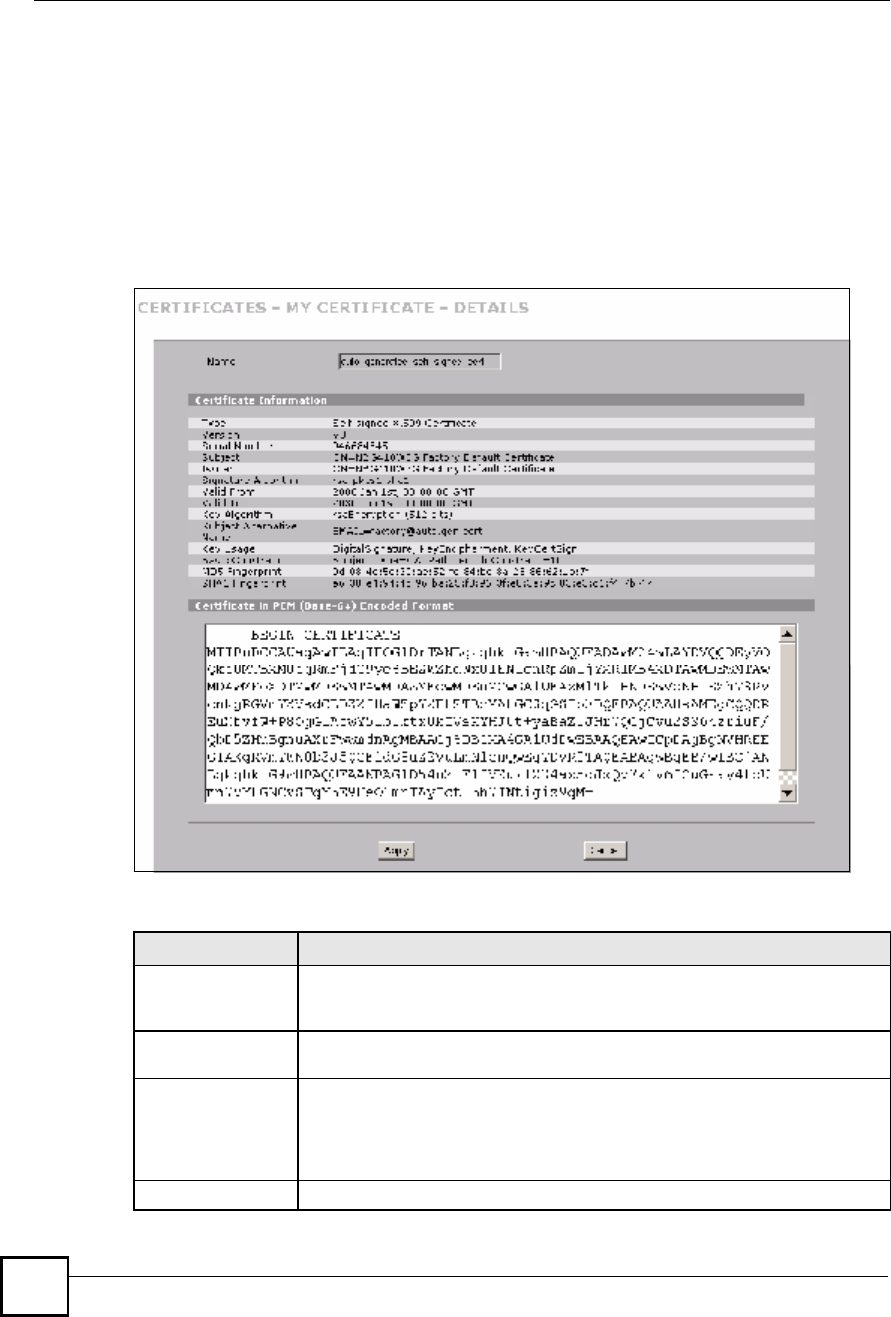
Chapter 11Certificates
NBG410W3G Series User s Guide
200
11.6 My Certificate Details
Click SECURITY > CERTIFICATES > My Certificates to open the My Certificates
screen (see Figure 121 on page 198). Click the details icon to open the My Certificate Details
screen. You can use this screen to view in-depth certificate information and change the
certificate!s name.
If it is a self-signed certificate, you can also set the ZyXEL Device to use the certificate to sign
the imported trusted remote host certificates.
Figure 122 SECURITY > CERTIFICATES > My Certificates > Details
The following table describes the labels in this screen.
Table 52 SECURITY > CERTIFICATES > My Certificates > Details
LABEL DESCRIPTION
NameThis field displays the identifying name of this certificate. If you want to change
the name, type up to 31 characters to identify this certificate. You may use any
character (not including spaces).
Certificate
Information
These read-only fields display detailed information about the certificate.
TypeThis field displays general information about the certificate. CA-signed means
that a Certification Authority signed the certificate. Self-signed means that the
certificate s owner signed the certificate (not a certification authority). "X.509#
means that this certificate was created and signed according to the ITU-T X.509
recommendation that defines the formats for public-key certificates.
VersionThis field displays the X.509 version number.
